Complete text - 2015-16 Estimates
ERRATA
Foreign Affairs, Trade and Development
The Highlights section in the French version has been updated for consistency with the English version.
Transport
The Expenditures by Strategic Outcome and Program table has been updated to correct the distribution of funding through the program alignment architecture.
Table of Contents
- Introduction
- Summary of Estimates
- Major Transfer Payments
- Estimates by Organization
- Structure of these Estimates
- Changes to these Estimates
- Main Estimates
- Administrative Tribunals Support Service of Canada
- Agriculture and Agri-Food
- Atlantic Canada Opportunities Agency
- Atomic Energy of Canada Limited
- Auditor General
- Canada Border Services Agency
- Canada Council for the Arts
- Canada Industrial Relations Board
- Canada Mortgage and Housing Corporation
- Canada Post Corporation
- Canada Revenue Agency
- Canada School of Public Service
- Canadian Air Transport Security Authority
- Canadian Broadcasting Corporation
- Canadian Centre for Occupational Health and Safety
- Canadian Commercial Corporation
- Canadian Dairy Commission
- Canadian Environmental Assessment Agency
- Canadian Food Inspection Agency
- Canadian Grain Commission
- Canadian Heritage
- Canadian Human Rights Commission
- Canadian Human Rights Tribunal
- Canadian Institutes of Health Research
- Canadian Intergovernmental Conference Secretariat
- Canadian International Development Agency
- Canadian International Trade Tribunal
- Canadian Museum for Human Rights
- Canadian Museum of History
- Canadian Museum of Immigration at Pier 21
- Canadian Museum of Nature
- Canadian Northern Economic Development Agency
- Canadian Nuclear Safety Commission
- Canadian Polar Commission
- Canadian Radio-television and Telecommunications Commission
- Canadian Security Intelligence Service
- Canadian Space Agency
- Canadian Tourism Commission
- Canadian Transportation Accident Investigation and Safety Board
- Canadian Transportation Agency
- Chief Electoral Officer
- Citizenship and Immigration
- Civilian Review and Complaints Commission for the Royal Canadian Mounted Police
- Commissioner for Federal Judicial Affairs
- Communications Security Establishment
- Copyright Board
- Correctional Service of Canada
- Courts Administration Service
- Economic Development Agency of Canada for the Regions of Quebec
- Employment and Social Development
- Enterprise Cape Breton Corporation
- Environment
- Federal Economic Development Agency for Southern Ontario
- Finance
- Financial Transactions and Reports Analysis Centre of Canada
- Fisheries and Oceans
- Foreign Affairs, Trade and Development
- Governor General
- Health
- House of Commons
- Immigration and Refugee Board
- Indian Affairs and Northern Development
- Indian Residential Schools Truth and Reconciliation Commission
- Industry
- International Development Research Centre
- International Joint Commission (Canadian Section)
- Justice
- Library and Archives of Canada
- Library of Parliament
- Marine Atlantic Inc.
- Military Grievances External Review Committee
- Military Police Complaints Commission
- National Arts Centre Corporation
- National Battlefields Commission
- National Capital Commission
- National Defence
- National Energy Board
- National Film Board
- National Gallery of Canada
- National Museum of Science and Technology
- National Research Council of Canada
- Natural Resources
- Natural Sciences and Engineering Research Council
- Northern Pipeline Agency
- Office of Infrastructure of Canada
- Office of the Commissioner of Lobbying
- Office of the Commissioner of Official Languages
- Office of the Communications Security Establishment Commissioner
- Office of the Conflict of Interest and Ethics Commissioner
- Office of the Co-ordinator, Status of Women
- Office of the Correctional Investigator
- Office of the Director of Public Prosecutions
- Office of the Public Sector Integrity Commissioner
- Office of the Superintendent of Financial Institutions
- Offices of the Information and Privacy Commissioners of Canada
- Old Port of Montreal Corporation Inc.
- Parks Canada Agency
- Parole Board of Canada
- Patented Medicine Prices Review Board
- PPP Canada Inc.
- Privy Council
- Public Health Agency of Canada
- Public Safety and Emergency Preparedness
- Public Service Commission
- Public Service Labour Relations Board
- Public Service Staffing Tribunal
- Public Works and Government Services
- Registry of the Competition Tribunal
- Registry of the Public Servants Disclosure Protection Tribunal
- Registry of the Specific Claims Tribunal
- Royal Canadian Mounted Police
- Royal Canadian Mounted Police External Review Committee
- Security Intelligence Review Committee
- Senate Ethics Officer
- Shared Services Canada
- Social Sciences and Humanities Research Council
- Standards Council of Canada
- Statistics Canada
- Supreme Court of Canada
- Telefilm Canada
- The Federal Bridge Corporation Limited
- The Jacques-Cartier and Champlain Bridges Inc.
- The Senate
- Transport
- Transportation Appeal Tribunal of Canada
- Treasury Board Secretariat
- Veterans Affairs
- Veterans Review and Appeal Board
- VIA Rail Canada Inc.
- Western Economic Diversification
- Windsor-Detroit Bridge Authority
- Items for inclusion in the Proposed Schedules to the Appropriation Bill
Introduction
Purpose
Expenditures made by government require the authority of Parliament. That authority is provided in two ways: annual Appropriation Acts, or Supply Bills, that specify the amounts and broad purposes for which funds can be spent; and other specific statutes that authorize payments and set out the amounts and time periods for those payments. The amounts approved in Appropriation Acts are referred to as voted amounts, and the expenditure authorities provided through other statutes are called statutory authorities.
Estimates documents are prepared to support Appropriation Acts. As such, the Estimates provide additional information on voted amounts included in the Appropriation Act. Forecasts of statutory amounts are also presented to provide a broader context.
Links with the Budget
The Budget Plan is a key policy document of the Government, announcing tax changes, new or enhanced programs and anticipated revenues. It also provides an economic forecast. While the Budget, like a Supply Bill, is also a confidence measure, the Budget does not provide parliamentary expenditure authority.
Given the differences in timing of the preparation of the Main Estimates and the Budget, it is not always possible to include emerging priorities and items announced in the Government's Budget in the Main Estimates. Therefore, to clarify the links between these Estimates and recent funding decisions, this document identifies items announced in a recent federal budget and which appear for the first time in the Estimates. Planned expenditures announced in Budget 2015 will be included in future Estimates documents.
For 2015-16, these Main Estimates present a total of $241.6 billion in planned budgetary expenditures, compared with $264billion in program expenses presented in the 2014 Update of Economic and Fiscal Projections.
The variance of $22.4 billion between these totals is attributed primarily to the treatment of the Employment Insurance Operating Account and the difference in accounting methodology.
The Employment Insurance Operating Account was established in 2009 to record all amounts received or paid out under the Employment Insurance Act. Employment and Social Development Canada is responsible for its stewardship. However, all benefit payments and administration costs are recorded as expenditures of the Account rather than the department's, and are therefore excluded from the departmental planned expenditures presented in Parts I and II of the Main Estimates. Additional information is available in the department's Report on Plans and Priorities on this Account. The forecast of Employment Insurance benefits and revenues is also presented in the 2014 Update of Economic and Fiscal Projections.
The Estimates and Budget use different accounting methodologies. Estimates, with the focus on authority for payments in a fiscal year, are prepared on a near cash basis. The economic forecasts prepared in the Budget and the Update of Economic and Fiscal Projections are prepared on a full accrual basis. The Notes to the Financial Statements of the Government of Canada, which are included in the Public Accounts, provide a more complete explanation of the differences in methodology as well as a reconciliation between the annual results and amounts included in Estimates. Volume II of the Public Accounts presents government expenditures on the same basis as the Estimates, while Volume I provides financial information corresponding to the Budget.
The Estimates Documents
The Estimates are comprised of three parts:
Part I – Government Expenditure Plan – provides an overview of the Government's requirements and changes in estimated expenditures from previous fiscal years.
Part II – Main Estimates – supports the appropriation acts with detailed information on the estimated spending and authorities being sought by each federal organization requesting appropriations.
Parts I and II are included in this volume and, in accordance with Standing Orders of the House of Commons, must be tabled on or before March 1.
Part III – Departmental Expenditure Plans – consists of two components:
Reports on Plans and Priorities (RPP) are individual expenditure plans for each department and agency which provide increased levels of detail over a three-year period on an organization's main priorities by strategic outcomes, program and planned/expected results, including links to related resource requirements presented in the Main Estimates. The RPPs are typically tabled soon after the Main Estimates by the President of the Treasury Board.
Departmental Performance Reports (DPR) are individual department and agency accounts of results achieved against planned performance expectations as set out in respective RPPs. The DPRs for the most recently completed fiscal year are tabled in the fall by the President of the Treasury Board.
Supplementary Estimates support appropriation acts presented later in the fiscal year. Supplementary Estimates present information on spending requirements that were either not sufficiently developed in time for inclusion in the Main Estimates or have subsequently been refined to account for developments in particular programs and services.
Summary of Estimates
These Estimates support the government's request to Parliament for authority to expend through annual appropriations:
- $88.2 billion for budgetary expenditures – operating and capital expenditures; transfer payments to other levels of government, organizations or individuals; and payments to Crown corporations; and
- $71.1 million for non-budgetary expenditures – net outlays and receipts related to loans, investments and advances, which change the composition of the financial assets of the Government of Canada.
These voted expenditures require annual approval from Parliament which is sought through an appropriation bill. The bill provides the specific wording that governs the purpose and conditions under which expenditures can be made and the funds subject to these terms and conditions.
Statutory forecasts represent payments to be made under legislation previously approved by Parliament. Statutory forecasts are included in these Estimates to provide a more complete picture of total estimated expenditures. Of these forecasts, $153.4 billion is for budgetary expenditures including the cost of servicing the public debt. Forecast cash outlays for loans, investments and advances are expected to exceed recoveries by $933.4 million.
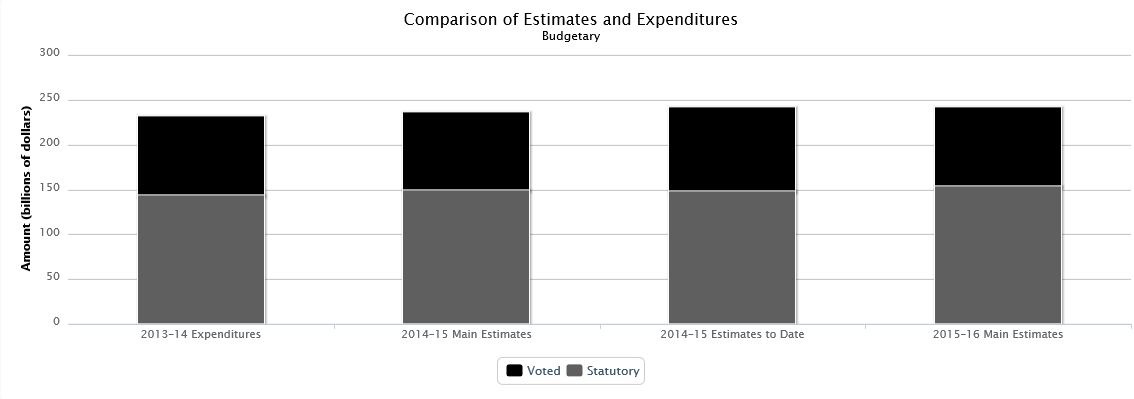
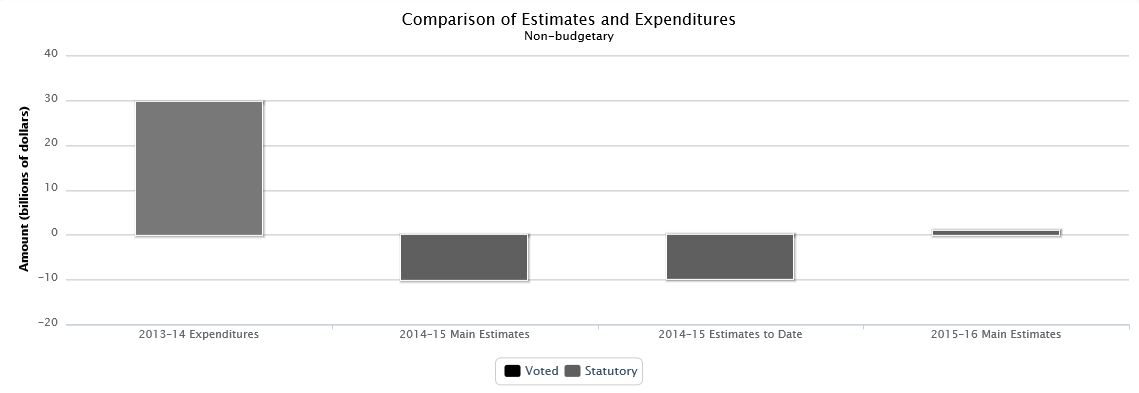
| 2013–14 Expenditures | 2014–15 Main Estimates | 2014–15 Estimates To Date | 2015–16 Main Estimates | |
|---|---|---|---|---|
| Budgetary | ||||
| Voted | 88.69 | 86.28 | 93.35 | 88.18 |
| Statutory | 142.94 | 149.05 | 148.06 | 153.39 |
| Total Budgetary | 231.63 | 235.33 | 241.41 | 241.57 |
| Non-budgetary | ||||
| Voted | 0.05 | 0.03 | 0.07 | 0.07 |
| Statutory | 29.66 | (10.05) | (9.80) | 0.93 |
| Total Non-budgetary | 29.71 | (10.02) | (9.73) | 1.00 |
The following graphs present the voted and statutory components of Main Estimates and a comparison of Main Estimates over the last ten years of Main Estimates.
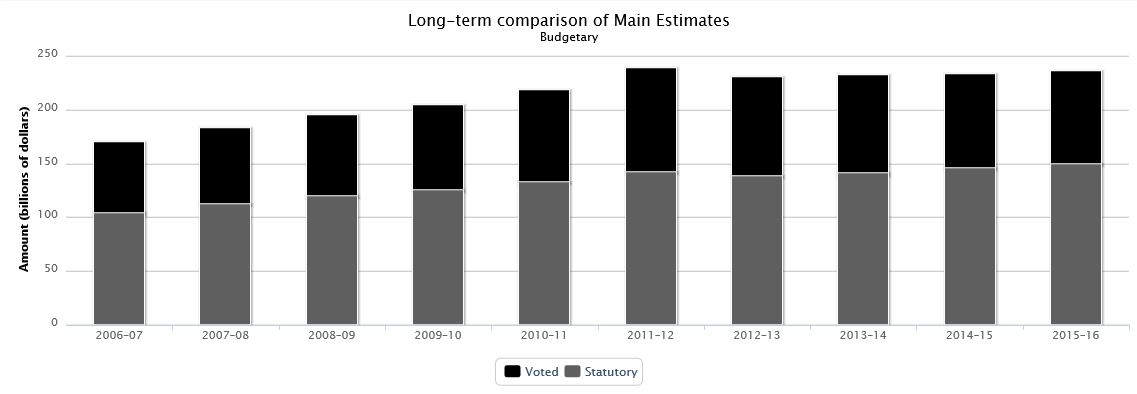
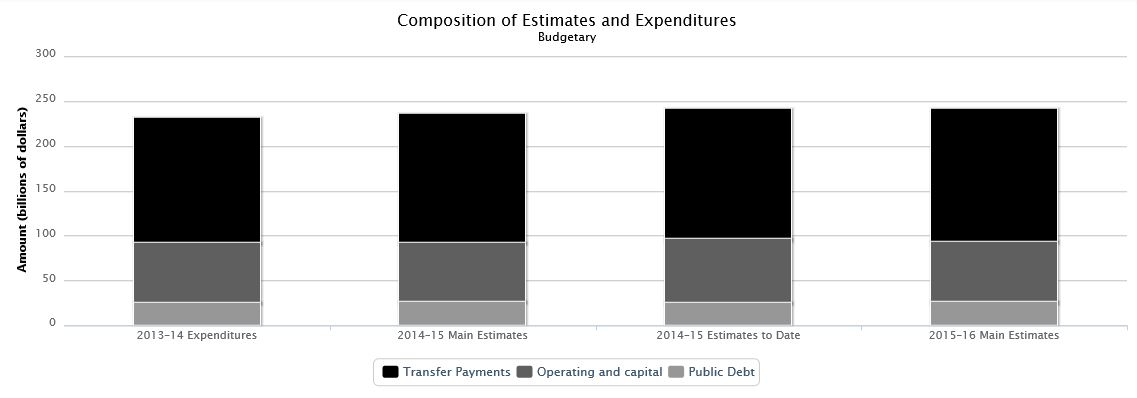
| 2013–14 Expenditures | 2014–15 Main Estimates | 2014–15 Estimates To Date | 2015–16 Main Estimates | |
|---|---|---|---|---|
| Budgetary | ||||
| Transfer Payments | 139.58 | 143.17 | 145.51 | 148.80 |
| Operating and capital | 67.04 | 65.87 | 71.01 | 67.16 |
| Public Debt | 25.01 | 26.30 | 24.89 | 25.62 |
| Total Budgetary | 231.63 | 235.33 | 241.41 | 241.57 |
| Non-budgetary | ||||
| Loans, Investments and Advances | 29.71 | (10.02) | (9.73) | 1.00 |
| Total Non-budgetary | 29.71 | (10.02) | (9.73) | 1.00 |
To provide a consistent basis of comparison, statutory amounts for 2013–14 and prior years have been restated to exclude Employment Insurance.
Composition of Estimates
The majority of expenditures in 2015–16 will be transfer payments – payments made to other levels of government, individuals and other organizations. Transfer payments make up approximately 61.60% of expenditures or $148.80 billion, operating and capital expenditures account for approximately 27.80% of expenditures or $67.16 billion, while public debt charges are approximately 10.60% of expenditures or $25.62 billion.
Public Debt Charges
Total interest costs are approximately 10.60% of expenditures or $25.6 billion, a projected decrease of $0.7 billion or 2.6% from previous Main Estimates and $0.6 billion more than actual expenditures for 2013–14. The decrease in total interest costs relative to the previous Main Estimates is largely due to an accounting change in 2013–14 relating to bond buybacks, as explained in the Annual Financial Report of the Government of Canada for 2013–14, as well as a decrease in the average Government of Canada long-term bond rate that is used to calculate interest on the public sector pension obligations pertaining to service pre . Total interest costs are comprised of interest on unmatured debt of $18.0 billion and other interest costs of $7.6 billion. Interest on unmatured debt represents the interest resulting from certificates of indebtedness issued by the Government of Canada that have not yet become due. Other interest costs include interest on liabilities for federal public service pension plans, deposit and trust accounts and other specified purpose accounts.
Major Transfer Payments
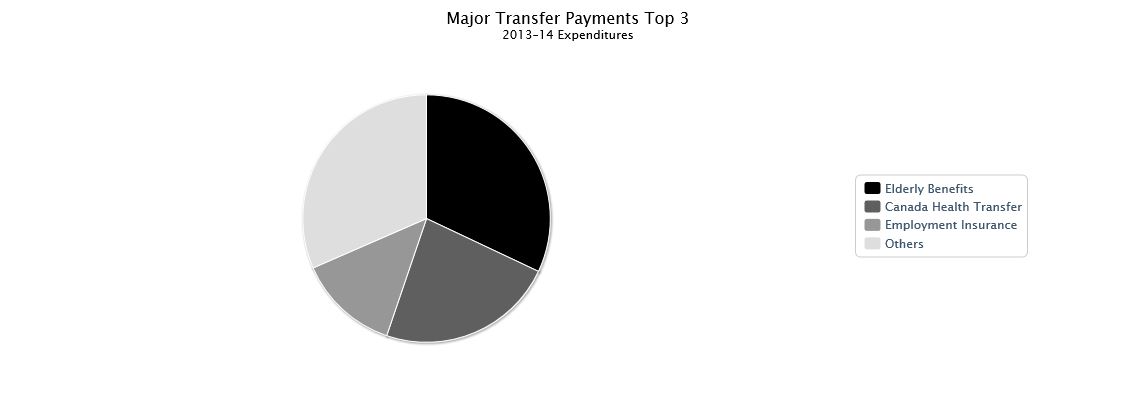


| 2013–14 Expenditures | 2014–15 Projection for April 1 | 2014–15 Projection to Date | 2015–16 Projection for April 1 | |
|---|---|---|---|---|
| Transfers to other levels of government | ||||
| Canada Health Transfer | 30.28 | 32.11 | 32.11 | 34.03 |
| Fiscal Equalization | 16.16 | 16.67 | 16.67 | 17.34 |
| Canada Social Transfer | 12.22 | 12.58 | 12.58 | 12.96 |
| Territorial Financing | 3.29 | 3.47 | 3.47 | 3.56 |
| Gas Tax Fund | 0 | 1.97 | 1.97 | 1.97 |
| Additional Fiscal Equalization to Nova Scotia | 0.26 | 0.14 | 0.13 | 0.08 |
| Additional Fiscal Equalization Offset Payment to Nova Scotia | 0.09 | 0.06 | 0.06 | 0.04 |
| Wait Times Reduction Transfer | 0.25 | 0 | 0 | 0 |
| Payment to Ontario related to the Canada Health Transfer | 0.01 | 0 | 0 | 0 |
| Youth Allowances Recovery | (0.76) | (0.82) | (0.81) | (0.85) |
| Alternative Payments for Standing Programs | (3.46) | (3.70) | (3.66) | (3.87) |
| Total transfers to other levels of government | 58.33 | 62.49 | 62.54 | 65.25 |
| Transfers to persons | ||||
| Elderly Benefits | 41.81 | 44.22 | 43.80 | 46.07 |
| Employment Insurance | 17.30 | 17.90 | 17.60 | 18.20 |
| Other Children's Benefits | 10.36 | 10.38 | 11.68 | 15.45 |
| Universal Child Care Benefits | 2.74 | 2.82 | 2.82 | 2.85 |
| Total transfers to persons | 72.21 | 75.32 | 75.90 | 82.57 |
| Total Major Transfer Payments | 130.55 | 137.81 | 138.43 | 147.83 |
Major Transfer Payments
Major transfer payments – significant transfers to other levels of government and transfers to persons – account for a large proportion of the government's total expenditure framework. As forecast in the 2014 Update of Economic and Fiscal Projections, major transfer payments are expected to total $148 billion in 2015–16, an increase of $9 billion over the current forecast for 2014–15.
Forecast expenditures for major transfer payments are included in the total budgetary Main Estimates of the responsible organization, with two exceptions. One is Employment Insurance, which is reported through the Employment Insurance Operating Account and is separate from any of the appropriated organizations listed in these Main Estimates. Another exception is "Other Children's Benefits", which are transferred through tax credits (rather than grants or contributions) and are excluded from the cash-based expenditures presented in the Estimates.
As presented in the table, major statutory transfers to other levels of government are projected to total $65.3 billion in 2015–16, an increase of $2.8 billion over the previous year's Main Estimates.
The Canada Health Transfer (CHT) is a federal transfer provided to provinces and territories in support of health care. As of 2014–15, the CHT is distributed on an equal per capita cash basis. In 2015–16, the CHT will increase by $1.9 billion, or 6%, from the 2014–15 amount to a total of $34.0 billion. As legislated in the Jobs, Growth and Long-term Prosperity Act, 2012, the CHT will continue to increase by 6% per year until 2016–17, after which it will grow based on a 3-year moving average of nominal gross domestic product, with funding guaranteed to increase by at least 3% per year. CHT support is subject to the five conditions of the Canada Health Act: universality; comprehensiveness; portability; accessibility; and public administration, and the prohibitions against extra-billing and user fees.
Fiscal Equalization refers to unconditional transfer payments to enable less prosperous provincial governments to provide their residents with public services that are reasonably comparable to those in other provinces, at reasonably comparable levels of taxation. The formula was recently reviewed; changes to the Act were included in the Economic Action Plan 2013 Act, No. 1, and changes to the regulations governing this program came into force in . These payments will be $17.3 billion in 2015–16, an increase of $0.7 billion from the Main Estimates 2014–15, and $1.2 billion more than 2013–14 actual expenditures. The Total Transfer Protection (TTP) payments of $55.8 million are included in the 2013–14 expenditures. TTP was a time-limited measure, provided in fiscal years 2010–11 to 2013–14, in recognition of the challenges faced by provinces during the worst of the global economic downturn. TTP protected individual provinces against year-over-year declines in their total major cash transfers, including prior year TTP amounts.
The Canada Social Transfer (CST) is a federal transfer to provinces and territories in support of social assistance and social services, post-secondary education, and programs for children. For 2015–16, the 3% increase of $377.5 million to $13.0 billion is a result of the 3% annual growth rate legislated in the Jobs, Growth and Long-term Prosperity Act, 2012 for 2014–15 and subsequent years.
Territorial Financing payments, provided through the Territorial Formula Financing (TFF) Program, are unconditional federal transfers that allow territorial governments to provide their residents with public services comparable to those offered by provincial governments, at comparable levels of taxation. The transfers are based on a formula that fills the gap between a proxy of territorial expenditure requirements and a territory's revenue-raising capacity. The formula was recently reviewed; changes to the Territorial Financing section of the Act were included in the Economic Action Plan 2013 Act, No. 1 and changes to the regulations governing this program came into force in . These payments will be $3.6 billion in 2015–16, $92 million higher than the 2014–15 Main Estimates.
The Gas Tax Fund provides predictable, long-term, stable funding for Canadian municipalities to help them build and revitalize their local public infrastructure while creating jobs and long term prosperity. Beginning in 2014–15, the Gas Tax Fund became a statutory payment. Prior to the 2014–15 fiscal year, payments were approved through Appropriation Acts (Voted). In 2013–14, payments of $2.1 billion were made from the fund.
Additional Fiscal Equalization Payments to Nova Scotia are payments related to its 2005 Offshore Accord. Following the introduction of a new formula for Equalization in 2007, Nova Scotia was guaranteed that, on a cumulative basis beginning in 2008–09 over the lifetime of the Accord, the new formula would not reduce its Equalization payments and 2005 Offshore Accord payments when compared with what the province would have received under the formula that was in place when it signed its 2005 Offshore Accord. Based on the first calculation of 2015–16, Nova Scotia is entitled to an advance payment of $79.3 million in 2015–16, a decrease of $58.9 million when compared to Main Estimates 2014–15. However, the official determination of 2014–15 (upon which payments will be made), is $131.2 million, which is reflected in the Supplementary Estimates (C), 2014–15.
The Additional Fiscal Equalization Offset Payment to Nova Scotia is a payment related to its 2005 Offshore Accord. This Accord guaranteed the province that its Equalization payments would not be reduced due to offshore oil and gas revenues that entered the Equalization formula. This is derived by applying the Equalization formula with and without offshore oil and gas revenues and comparing the resulting Equalization payments. For the 2004-05 to 2011–12 period, an upfront payment of $830 million was provided to Nova Scotia in . This ensured that the province would receive at least that much in Accord compensation over the period. Offset amounts are calculated each year, providing 100% protection from the inclusion of offshore revenues. Beginning in 2011–12, the cumulative draw down exceeded the advance payment. The province is expected to receive $36.8 million for 2015–16, a decrease of $27.2 million compared with the amount for 2014–15.
Wait Times Reduction Funding was part of the 2004 10-Year Plan to Strengthen Health Care, in which First Ministers committed to achieving reductions in wait times in priority areas such as cancer, heart, diagnostic imaging, joint replacements and sight restoration. Budget 2005 committed to a transfer of $5.5 billion for wait times reduction. Of this amount, $4.25 billion was provided to provinces and territories by way of third-party trusts. The remaining $1.25 billion was paid in bi-monthly installments totaling $250 million per year between 2009–10 and 2013–14.
The Payment to Ontario Related to the Canada Health Transfer provided for separate payments to Ontario outside of the Canada Health Transfer (CHT) cash envelope for 2009–10 and 2010–11 to ensure its per capita cash entitlements in relation to the CHT are the same as for other Equalization-receiving provinces. The payment for 2009–10 of $489 million was a legislated fixed amount, whereas the payment for 2010–11 was formula-based, and payments were re-calculated along with each new CHT estimate. In all there were five calculations. Each recalculation was based on updated personal income tax data received from the Fiscal Policy Division of Finance Canada and the Canada Revenue Agency. The final calculation for this program was made in . The payment for 2010–11, including all adjustments, was $246.2 million. The amount shown in 2013–14 represents the impacts of the final official recalculation.
The Youth Allowance Recovery relates to tax points transferred to the province of Quebec for the Youth Allowance program, which has since expired. The equivalent value of the tax point reduction is recovered each year from the province of Quebec. The change in recoveries for the Youth Allowances Recovery Program is entirely due to year-over-year changes to the value of federal personal income taxes, the recovery being a percentage of these taxes. For 2015–16, the forecast recovery of $853 million is $37.1 million higher than the initial 2014–15 forecast in Main Estimates and $46.6 million higher than the forecast in the 2014–15 Supplementary Estimates (C) due to higher forecast levels of federal personal income taxes.
Alternative Payments for Standing Programs represent recoveries from Quebec of an additional tax point transfer above and beyond the tax point transfer traditionally computed under the Canada Health Transfer, the Canada Social Transfer and the Youth Allowances Recovery. The change in recoveries for the Alternative Payments for Standing Programs is entirely due to year-over-year changes to the value of federal personal income taxes, the recovery being a percentage of these taxes. For 2015–16, the forecast recovery of $3.9 billion is $169.7million higher than the forecast in the 2014–15 Main Estimates and $210.8 million higher than that in 2014–15 Supplementary Estimates (C) due to higher forecast levels of federal personal income taxes.
Transfers to Persons
Elderly benefits include Old Age Security, Guaranteed Income Supplement, and Allowance payments. Elderly benefit payments are expected to be $46.1billion in 2015–16, an increase of $1.9billion over the 2014–15 Main Estimates and $4.3billion more than actual expenditures in 2013–14.
Universal Child Care benefits provide families with resources to support childcare choices, and are paid to families in monthly instalments of $100 per child under the age of six. Universal child care benefit payments are forecast by Employment and Social Development Canada to be $2.9billion in 2015–16, an increase of $32.4million over the 2014–15 Main Estimates and $111.3million more than actual expenditures in 2013–14.
"Other Children's Benefits" include the Canada child tax benefit – a tax-free monthly payment made to eligible families to help them with the cost of raising children under age 18–and are transferred through tax credits, as well as enhancements to the Universal Child Care Benefit which are subject to parliamentary approval.
Employment Insurance provides temporary financial assistance to unemployed Canadians who have lost their job through no fault of their own, while they look for work or upgrade their skills. Employment Insurance is reported through the Employment Insurance Operating Account and is separate from any of the appropriated organizations listed in these Main Estimates.
Estimates by Organization
One hundred thirty-one organizations are represented in the 2015–16 Estimates. More information about each organization can be found in Part II – Main Estimates.
| 2013–14 Expenditures | 2014–15 Main Estimates | 2014–15 Estimates To Date | 2015–16 Main Estimates | |
|---|---|---|---|---|
| Budgetary | ||||
| Administrative Tribunals Support Service of Canada | 0 | 0 | 1 | 60,896,030 |
| Agriculture and Agri-Food | 2,386,898,330 | 2,253,196,812 | 2,303,068,265 | 2,257,088,060 |
| Atlantic Canada Opportunities Agency | 314,158,108 | 288,486,384 | 299,885,801 | 298,584,989 |
| Atomic Energy of Canada Limited | 385,462,900 | 102,143,000 | 332,428,000 | 119,143,000 |
| Auditor General | 84,265,019 | 77,741,830 | 77,741,830 | 78,295,020 |
| Canada Border Services Agency | 1,850,111,502 | 1,736,391,109 | 1,747,310,264 | 1,774,214,921 |
| Canada Council for the Arts | 181,974,388 | 182,092,916 | 182,219,917 | 182,097,387 |
| Canada Industrial Relations Board | 13,257,206 | 13,363,956 | 13,363,956 | 0 |
| Canada Mortgage and Housing Corporation | 2,084,849,627 | 2,097,353,000 | 2,097,353,000 | 2,025,629,000 |
| Canada Post Corporation | 22,210,000 | 22,210,000 | 22,210,000 | 22,210,000 |
| Canada Revenue Agency | 4,062,859,356 | 3,861,256,109 | 3,848,374,916 | 3,804,844,388 |
| Canada School of Public Service | 84,761,581 | 85,490,028 | 86,289,735 | 70,879,683 |
| Canadian Air Transport Security Authority | 559,065,861 | 591,626,313 | 676,185,743 | 678,420,347 |
| Canadian Broadcasting Corporation | 1,083,473,798 | 1,038,018,212 | 1,038,018,212 | 1,038,023,798 |
| Canadian Centre for Occupational Health and Safety | 5,247,191 | 5,059,041 | 5,059,041 | 5,070,269 |
| Canadian Commercial Corporation | 15,656,400 | 15,654,204 | 15,654,204 | 8,880,000 |
| Canadian Dairy Commission | 4,456,273 | 3,610,936 | 3,610,936 | 3,605,377 |
| Canadian Environmental Assessment Agency | 32,628,480 | 30,964,106 | 31,103,159 | 17,351,870 |
| Canadian Food Inspection Agency | 805,751,653 | 619,327,735 | 691,866,912 | 698,151,888 |
| Canadian Grain Commission | 25,353,978 | 16,383,894 | 16,383,894 | 5,475,177 |
| Canadian Heritage | 1,331,571,130 | 1,390,049,987 | 1,482,199,385 | 1,254,696,561 |
| Canadian Human Rights Commission | 23,673,650 | 22,099,726 | 22,099,726 | 22,162,418 |
| Canadian Human Rights Tribunal | 4,430,426 | 4,532,525 | 4,532,525 | 0 |
| Canadian Institutes of Health Research | 997,971,988 | 984,951,962 | 1,013,009,499 | 1,008,583,999 |
| Canadian Intergovernmental Conference Secretariat | 5,864,881 | 5,957,163 | 5,957,163 | 5,967,541 |
| Canadian International Development Agency | 692,465,904 | 0 | 0 | 0 |
| Canadian International Trade Tribunal | 10,896,125 | 9,476,739 | 9,476,739 | 0 |
| Canadian Museum for Human Rights | 32,016,180 | 21,700,000 | 21,700,000 | 21,700,000 |
| Canadian Museum of History | 62,850,567 | 63,430,033 | 63,600,033 | 83,369,477 |
| Canadian Museum of Immigration at Pier 21 | 18,450,000 | 9,900,000 | 9,900,000 | 7,700,000 |
| Canadian Museum of Nature | 26,770,876 | 26,127,096 | 26,127,096 | 26,129,112 |
| Canadian Northern Economic Development Agency | 50,779,478 | 30,945,766 | 51,873,037 | 50,668,666 |
| Canadian Nuclear Safety Commission | 145,617,021 | 131,637,295 | 131,804,560 | 133,179,745 |
| Canadian Polar Commission | 2,590,009 | 2,576,360 | 2,576,360 | 2,574,085 |
| Canadian Radio-television and Telecommunications Commission | 10,379,861 | 10,586,699 | 12,068,646 | 12,256,890 |
| Canadian Security Intelligence Service | 516,305,729 | 516,236,757 | 520,727,831 | 537,037,245 |
| Canadian Space Agency | 408,715,240 | 462,447,174 | 466,456,818 | 483,428,281 |
| Canadian Tourism Commission | 57,975,770 | 57,972,388 | 57,972,388 | 57,975,770 |
| Canadian Transportation Accident Investigation and Safety Board | 33,303,194 | 29,042,391 | 29,382,391 | 29,729,799 |
| Canadian Transportation Agency | 28,976,938 | 27,650,622 | 27,650,622 | 27,733,404 |
| Chief Electoral Officer | 120,227,749 | 97,110,432 | 97,110,432 | 395,959,817 |
| Citizenship and Immigration | 1,378,694,695 | 1,385,441,063 | 1,425,035,591 | 1,464,667,008 |
| Civilian Review and Complaints Commission for the Royal Canadian Mounted Police | 8,789,834 | 10,010,382 | 10,010,382 | 10,011,723 |
| Commissioner for Federal Judicial Affairs | 501,342,281 | 511,708,846 | 513,375,265 | 524,851,120 |
| Communications Security Establishment | 443,673,045 | 829,131,918 | 839,840,739 | 538,201,730 |
| Copyright Board | 2,779,672 | 3,116,312 | 3,116,312 | 3,110,713 |
| Correctional Service of Canada | 2,750,291,475 | 2,334,682,392 | 2,331,034,284 | 2,350,488,926 |
| Courts Administration Service | 67,342,559 | 68,044,743 | 68,044,743 | 63,952,587 |
| Economic Development Agency of Canada for the Regions of Quebec | 269,305,817 | 247,840,617 | 255,111,243 | 261,082,194 |
| Employment and Social Development | 49,646,912,521 | 51,670,772,727 | 52,194,265,600 | 54,265,536,116 |
| Enterprise Cape Breton Corporation | 50,844,000 | 49,536,000 | 49,536,000 | 0 |
| Environment | 978,949,548 | 932,167,330 | 992,881,581 | 961,051,076 |
| Federal Economic Development Agency for Southern Ontario | 234,280,405 | 206,764,115 | 206,764,115 | 215,251,719 |
| Finance | 85,578,872,179 | 87,615,730,739 | 86,979,013,906 | 89,646,397,112 |
| Financial Transactions and Reports Analysis Centre of Canada | 51,704,183 | 49,189,312 | 50,843,127 | 50,450,180 |
| Fisheries and Oceans | 1,806,403,186 | 1,605,310,848 | 1,806,803,467 | 1,889,240,348 |
| Foreign Affairs, Trade and Development | 5,065,277,810 | 5,349,525,157 | 5,817,604,810 | 5,526,817,200 |
| Governor General | 20,306,504 | 19,987,719 | 19,987,719 | 20,131,117 |
| Health | 3,828,179,497 | 3,657,312,088 | 3,717,804,149 | 3,658,770,349 |
| House of Commons | 414,611,038 | 413,725,137 | 447,487,761 | 443,449,092 |
| Immigration and Refugee Board | 121,920,320 | 121,060,649 | 120,015,607 | 112,709,491 |
| Indian Affairs and Northern Development | 8,039,491,675 | 8,053,975,405 | 8,640,026,870 | 8,187,417,868 |
| Indian Residential Schools Truth and Reconciliation Commission | 6,861,396 | 2,069,718 | 6,444,363 | 3,660,158 |
| Industry | 1,115,475,464 | 1,077,743,513 | 1,151,077,986 | 1,170,502,156 |
| International Development Research Centre | 202,416,279 | 188,019,646 | 190,019,647 | 183,478,242 |
| International Joint Commission (Canadian Section) | 6,669,895 | 6,746,957 | 6,746,957 | 6,761,044 |
| Justice | 737,040,864 | 630,587,874 | 682,154,685 | 673,866,874 |
| Library and Archives of Canada | 100,803,692 | 95,864,788 | 96,864,789 | 93,011,489 |
| Library of Parliament | 42,330,541 | 41,970,007 | 42,170,007 | 42,739,595 |
| Marine Atlantic Inc. | 154,430,000 | 127,484,000 | 127,484,000 | 19,384,000 |
| Military Grievances External Review Committee | 5,981,005 | 6,730,577 | 6,730,577 | 6,741,810 |
| Military Police Complaints Commission | 5,520,205 | 5,618,520 | 8,000,006 | 5,614,814 |
| National Arts Centre Corporation | 34,647,720 | 34,219,186 | 34,969,188 | 34,222,719 |
| National Battlefields Commission | 10,154,844 | 14,151,109 | 14,151,109 | 12,976,836 |
| National Capital Commission | 106,161,174 | 88,366,659 | 91,442,659 | 92,721,330 |
| National Defence | 18,764,374,206 | 18,661,554,387 | 19,679,828,728 | 18,942,053,629 |
| National Energy Board | 81,682,681 | 71,316,050 | 77,820,846 | 76,820,510 |
| National Film Board | 66,866,065 | 59,912,241 | 59,912,241 | 59,652,377 |
| National Gallery of Canada | 44,193,242 | 43,770,723 | 43,770,723 | 43,773,542 |
| National Museum of Science and Technology | 27,003,126 | 26,862,194 | 33,141,274 | 29,754,746 |
| National Research Council of Canada | 894,418,206 | 896,432,878 | 893,760,823 | 853,254,782 |
| Natural Resources | 2,091,044,593 | 2,534,650,611 | 2,764,617,925 | 2,214,476,711 |
| Natural Sciences and Engineering Research Council | 1,066,679,030 | 1,063,174,249 | 1,087,078,427 | 1,086,570,325 |
| Northern Pipeline Agency | 1,172,624 | 750,000 | 750,000 | 750,775 |
| Office of Infrastructure of Canada | 3,513,825,491 | 3,321,597,771 | 3,712,825,721 | 3,633,262,748 |
| Office of the Commissioner of Lobbying | 4,463,523 | 4,432,300 | 4,432,300 | 4,452,540 |
| Office of the Commissioner of Official Languages | 24,187,763 | 20,776,952 | 20,776,952 | 20,833,525 |
| Office of the Communications Security Establishment Commissioner | 1,943,120 | 2,024,288 | 2,024,288 | 2,031,067 |
| Office of the Conflict of Interest and Ethics Commissioner | 6,035,050 | 6,938,405 | 6,938,405 | 6,952,226 |
| Office of the Co-ordinator, Status of Women | 31,422,283 | 29,607,730 | 29,757,730 | 29,543,077 |
| Office of the Correctional Investigator | 4,726,181 | 4,659,652 | 4,659,652 | 4,655,541 |
| Office of the Director of Public Prosecutions | 185,293,541 | 167,815,874 | 167,815,874 | 170,718,195 |
| Office of the Public Sector Integrity Commissioner | 5,543,041 | 5,426,234 | 5,426,234 | 5,448,442 |
| Office of the Superintendent of Financial Institutions | 17,037,449 | 142,763,529 | 142,763,529 | 147,934,112 |
| Offices of the Information and Privacy Commissioners of Canada | 43,424,217 | 35,521,413 | 35,455,313 | 35,586,666 |
| Old Port of Montreal Corporation Inc. | 17,196,000 | 0 | 0 | 0 |
| Parks Canada Agency | 690,941,356 | 612,465,134 | 671,387,496 | 737,273,003 |
| Parole Board of Canada | 50,410,477 | 47,128,994 | 47,128,994 | 45,915,750 |
| Patented Medicine Prices Review Board | 10,540,567 | 10,927,030 | 10,927,030 | 10,945,181 |
| PPP Canada Inc. | 265,200,000 | 9,500,000 | 209,500,000 | 231,200,000 |
| Privy Council | 126,385,127 | 118,806,989 | 121,409,968 | 118,833,279 |
| Public Health Agency of Canada | 621,497,636 | 614,696,685 | 638,062,053 | 567,152,421 |
| Public Safety and Emergency Preparedness | 1,341,250,243 | 1,122,768,356 | 1,179,660,869 | 1,150,436,251 |
| Public Service Commission | 85,567,265 | 83,693,487 | 84,197,488 | 83,601,016 |
| Public Service Labour Relations Board | 12,705,948 | 13,745,412 | 13,745,412 | 0 |
| Public Service Staffing Tribunal | 4,768,690 | 5,481,116 | 5,481,116 | 0 |
| Public Works and Government Services | 2,847,124,134 | 2,664,123,913 | 2,840,928,437 | 2,871,525,596 |
| Registry of the Competition Tribunal | 1,155,423 | 2,345,306 | 2,345,306 | 0 |
| Registry of the Public Servants Disclosure Protection Tribunal | 1,229,362 | 1,845,622 | 1,845,622 | 0 |
| Registry of the Specific Claims Tribunal | 2,141,436 | 2,897,525 | 2,897,525 | 0 |
| Royal Canadian Mounted Police | 2,892,380,696 | 2,625,976,343 | 2,652,009,818 | 2,630,057,696 |
| Royal Canadian Mounted Police External Review Committee | 1,605,928 | 961,418 | 1,671,419 | 952,848 |
| Security Intelligence Review Committee | 2,782,521 | 2,786,799 | 2,786,799 | 2,796,368 |
| Senate Ethics Officer | 765,918 | 1,166,750 | 1,166,750 | 1,168,700 |
| Shared Services Canada | 1,653,237,805 | 1,473,323,577 | 1,571,839,644 | 1,444,044,025 |
| Social Sciences and Humanities Research Council | 695,719,438 | 691,750,165 | 715,358,641 | 717,089,852 |
| Standards Council of Canada | 8,081,241 | 11,729,000 | 11,829,000 | 9,829,000 |
| Statistics Canada | 471,511,775 | 379,555,524 | 426,601,019 | 525,090,820 |
| Supreme Court of Canada | 31,430,939 | 31,389,794 | 31,508,094 | 31,763,943 |
| Telefilm Canada | 99,975,111 | 95,363,072 | 95,363,072 | 95,453,551 |
| The Federal Bridge Corporation Limited | 13,190,982 | 21,040,000 | 21,040,000 | 35,281,996 |
| The Jacques-Cartier and Champlain Bridges Inc. | 189,218,871 | 146,168,159 | 432,832,159 | 368,737,000 |
| The Senate | 84,694,050 | 91,485,177 | 92,385,177 | 88,747,958 |
| Transport | 1,340,632,835 | 1,655,682,494 | 1,817,414,797 | 1,615,012,278 |
| Transportation Appeal Tribunal of Canada | 1,471,037 | 1,416,074 | 1,416,074 | 0 |
| Treasury Board Secretariat | 2,892,520,949 | 7,364,924,114 | 8,236,577,961 | 6,892,444,333 |
| Veterans Affairs | 3,513,572,889 | 3,576,978,766 | 3,587,828,846 | 3,522,078,175 |
| Veterans Review and Appeal Board | 11,458,088 | 10,887,938 | 10,887,938 | 10,896,563 |
| VIA Rail Canada Inc. | 405,661,000 | 183,061,756 | 433,261,756 | 330,077,000 |
| Western Economic Diversification | 188,328,291 | 158,907,952 | 163,276,978 | 159,913,914 |
| Windsor-Detroit Bridge Authority | 0 | 0 | 8,064,384 | 58,469,905 |
| Total Budgetary | 229,824,429,150 | 235,334,374,675 | 241,409,406,908 | 241,574,296,708 |
| Non-budgetary | ||||
| Canada Mortgage and Housing Corporation | (41,950,460,603) | (10,880,408,000) | (10,880,408,000) | (139,123,000) |
| Canadian Dairy Commission | (54,968,445) | 0 | 0 | 0 |
| Canadian International Development Agency | 29,291,205 | 0 | 0 | 0 |
| Citizenship and Immigration | 802,804 | 0 | 0 | 0 |
| Correctional Service of Canada | 405 | 0 | 0 | 0 |
| Employment and Social Development | 1,099,875,159 | 779,981,475 | 826,283,289 | 1,027,422,531 |
| Finance | 70,481,709,512 | 1 | 200,000,002 | 0 |
| Foreign Affairs, Trade and Development | 53,377,672 | 50,082,306 | 50,082,307 | 45,146,541 |
| Indian Affairs and Northern Development | 40,943,752 | 25,903,000 | 70,303,000 | 70,303,000 |
| Industry | 0 | 800,000 | 800,000 | 800,000 |
| National Defence | 6,094,057 | 0 | 0 | 0 |
| Public Works and Government Services | (63,675) | 0 | 0 | 0 |
| Veterans Affairs | 208 | 0 | 0 | 0 |
| Total Non-budgetary | 29,706,602,051 | (10,023,641,218) | (9,732,939,402) | 1,004,549,072 |
Structure of these Estimates
Votes
The basic structural units of the Estimates are the Votes. The following kinds of Votes appear in the Estimates:
A program expenditures vote is used when there is no requirement for either a separate "capital expenditures" vote or a "grants and contributions" vote because neither equals or exceeds $5 million. In this case, all expenditures are charged to the one vote.
An operating expenditures vote is used when there is also a requirement for either a "capital expenditures" vote or a "grants and contributions" vote or both; that is, when expenditures of either type equal or exceed $5 million. Where they do not, the appropriate expenditures are included in the "program expenditures" vote.
A capital expenditures vote is used when the aggregate of capital expenditures equal or exceed $5 million. Capital expenditures are those made for the acquisition or development of items that are classified as tangible capital assets as defined by Government accounting policies. For example, the acquisition of real property, infrastructure, machinery or equipment, or for purposes of constructing or developing assets, where an organization expects to draw upon its own labour and materials, or employs professional services or other services or goods. Expenditure items in a Capital Expenditures Vote are for items that generally exceed $10,000; although an organization may select a reduced threshold to be applied to different capital classes.
A grants and contributions vote is used when grants and/or contributions expenditures equal or exceed $5 million. It should be noted that the inclusion of a grant, contribution or other transfer payment item in the Estimates imposes no requirement to make a payment, nor does it give a prospective recipient any right to the funds. It should also be noted that in the vote wording, the meaning of the word "contributions" is considered to include "other transfer payments" because of the similar characteristics of each.
A non-budgetary vote, identified by the letter "L", provides authority for spending in the form of loans or advances to, and investments in, Crown corporations; and loans or advances for specific purposes to other governments, international organizations or persons or corporations in the private sector.
Where it is necessary to appropriate funds for a payment to a Crown corporation or for the expenditures of a legal entity that is part of a larger program, a separate vote is established. Where this is the case, a separate vote structure is established for each. A legal entity for these purposes is defined as a unit of government operating under an Act of Parliament and responsible directly to a Minister.
To support the Treasury Board in performing its statutory responsibilities for managing the government's financial, human and materiel resources, a number of special authorities are required. These authorities are described in the vote wording found in the Proposed Schedules to the Appropriation Bill.
Information Presented in the 2015–16 Main Estimates
Departments and agencies are presented alphabetically according to the legal name of the department or agency. For some organizations, the legal name differs from the name in common usage. In such cases, their commonly-used name is noted in their raison d'être.
Forecast statutory expenditures are summarized in this document. Details are available in the 2015–16 Statutory Forecasts online table.
Abbreviated vote wordings are used in organization summaries. Complete vote wording is shown in the Proposed Schedules to the Appropriation Bill following Part II.
Information on 2013–14 actual expenditures and 2014–15 Estimates to Date are included to provide context for the 2015–16 amounts. The 2013–14 actual expenditures are taken from the 2013–14 Public Accounts of Canada. 2014–15 Estimates to Date is the sum of the amounts presented in the 2014–15 Main Estimates and increases sought through the 2014–15 Supplementary Estimates A, B and C. Estimates to date excludes any funding deemed to have been appropriated to a department following the transfer of a portion of the federal administration. Allocations from Treasury Board Central Votes are made throughout the year and the expenditure authority provided by these allocations is also not included in Estimates to Date.
The 2015–16 Program Alignment Architecture is used for the tables presenting information by Strategic Outcome and Program. If there has been a change in the Architecture, amounts for previous years have not been reclassified to the new structure and are reported as "Funds not allocated to the 2015–16 Program Alignment Architecture".
If applicable, a table provides a listing of transfer payments planned for the 2015–16 fiscal year, with comparative amounts from previous fiscal years for programs with funding in 2015–16. A transfer payment is a grant, contribution or other payment made for the purpose of furthering program objectives but for which no goods or services are received. Details on transfer payments made in a previous year can be found in Volumes 2 and 3 of the Public Accounts of Canada.
Supplementary online tables for the 2015–16 Main Estimates show forecast expenditures by:
- Standard Object: the table shows the types of goods or services to be acquired, or the transfer payments to be made and the revenues to be credited to the vote; and,
- Strategic Outcome and Program: planned expenditures are classified under the 2015–16 Program Alignment Architecture. If there has been a change in the Architecture, amounts for previous years have not been reclassified to the new structure.
In-year information on expenditure authorities is available in departmental Quarterly Financial Reports, and final expenditure authority and actual expenditures for a fiscal year are reported in the Public Accounts of Canada. The Treasury Board Secretariat (TBS) InfoBase also provides financial and people management data for all organizations that receive government appropriations.
Changes to these Estimates
The purpose of this section is to provide the reconciliation of these Estimates with the previous year's Main Estimates in the following areas:
- Changes to government organization and structure; and
- Changes in authorities (Votes).
Changes to Government Organization and Structure
Following the tabling of the 2014–15 Main Estimates on and pursuant to the Public Service Rearrangement and Transfer of Duties Act, these changes were made.
Supplementary Estimates (A), 2014–15:
- Orders in Council P.C. 2012-1350 and P.C. 2012-1352 impact the Windsor-Detroit Bridge Authority.
- Orders in Council P.C. 2014-142 and P.C. 2014-146 impact The Jacques-Cartier and Champlain Bridges Inc.
- Order in Council P.C. 2014-144 impacts the Office of Infrastructure of Canada.
Supplementary Estimates (B), 2014–15:
- The Economic Action Plan 2014 Act, No. 1 and Order in Council P.C. 2014-1106 create the Administrative Tribunals Support Service of Canada.
Supplementary Estimates (C), 2014–15:
- The Economic Action Plan 2014 Act, No. 1 dissolves Enterprise Cape Breton Corporation and transfers their duties to Atlantic Canada Opportunities Agency and Public Works and Government Services Canada.
These Main Estimates:
- Order in Council P.C. 2014-911 impacts Canadian Heritage and Canadian Museum of History.
- Order in Council P.C. 2014-922 transfers the Commissioner of Canada Elections from the Chief Electoral Officer to the Office of the Director of Public Prosecutions.
- The Economic Action Plan 2014 Act, No. 1 and Order in Council P.C. 2014-1106 also impact the Canada Industrial Relations Board, Canadian Human Rights Tribunal, Canadian International Trade Tribunal, Registry of the Competition Tribunal, Registry of the Public Servants Disclosure Protection Tribunal, Registry of the Specific Claims Tribunal, Transportation Appeal Tribunal of Canada and Public Service Labour Relations and Employment Board.
- The Economic Action Plan 2013 Act, No. 2 and Order in Council P.C. 2014-1107 create the Public Service Labour Relations and Employment Board by combining the Public Service Staffing Tribunal and Public Service Labour Relation Board.
- Order in Council P.C. 2014-1295 changes the name of Royal Canadian Mounted Police Complaint Commission to the Civilian Review and Complaints Commission for the Royal Canadian Mounted Police.
Changes in Voted Authorities
This sub-section lists Votes which contain specific authorities that differ from those included in the previous year's Main Estimates as well as new expenditure authorities appearing for the first time. In light of the House of Commons Speaker's rulings in 1981, the government has made a commitment that the only legislation that will be enacted through the Estimates process, other than cases specifically authorized by Statute, will be previous Appropriation Acts.
- Correctional Services of Canada
- Vote 1 wording was modified by replacing "…aux détenus élargis…" by "…aux détenus libérés…" in paragraph ( c) in the French version only and by removing paragraph ( e).
- Foreign Affairs, Trade and Development
- Vote 1 wording was modified by replacing "…to the staff of such officials…" by "…to the staff of those officials…" in the English version only.
- Natural Sciences and Engineering Research Council
- Vote 1 wording was modified by removing "and, pursuant to paragraph 29.1(2)( a) of the Financial Administration Act, authority to expend revenues received during the fiscal year, to offset expenditures incurred in the fiscal year, arising from the provision of internal support services to other organizations".
- Social Sciences and Humanities Research Council
- Vote 1 wording was modified by removing "and, pursuant to paragraph 29.1(2)( a) of the Financial Administration Act, authority to expend revenues received during the fiscal year, to offset expenditures incurred in the fiscal year, arising from the provision of internal support services to other organizations".
- Transport
- Vote 5 wording was modified by removing "including contributions to provinces or municipalities or local or private authorities towards construction done by those bodies".
Main Estimates
Administrative Tribunals Support Service of Canada
Raison d'être
The Minister of Justice is responsible for this organization. The Administrative Tribunals Support Service of Canada (ATSSC) is responsible for the provision of the support services and the facilities that are needed by each of the administrative tribunals to exercise its powers and perform its duties and functions in accordance with the rules that apply to its work.
Organizational Estimates
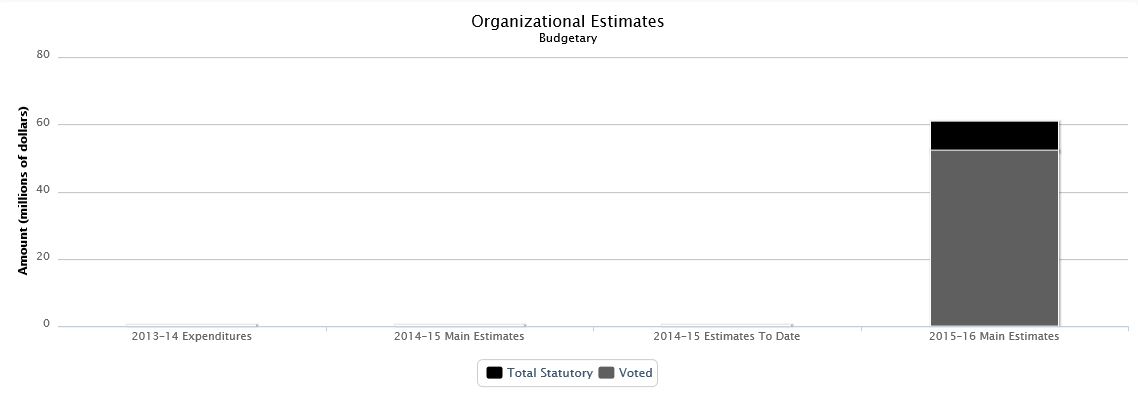
| 2013–14 Expenditures | 2014–15 Main Estimates | 2014–15 Estimates To Date | 2015–16 Main Estimates | ||
|---|---|---|---|---|---|
| Budgetary | |||||
| Voted | |||||
| 1 | Program expenditures | 0 | 0 | 1 | 52,297,037 |
| Total voted | 0 | 0 | 1 | 52,297,037 | |
| Total Statutory | 0 | 0 | 0 | 8,598,993 | |
| Total budgetary | 0 | 0 | 1 | 60,896,030 | |
Highlights
Established on , the ATSSC is consistent with the government's ongoing commitment to improve the effectiveness and efficiency of its administration and operations. By consolidating the provision of support services for eleven administrative tribunals, the government is strengthening overall capacity and modernizing operations to better meet the administrative needs of federal tribunals and to improve access to justice for Canadians.
Expenditures by Strategic Outcome and Program
| 2013–14 Expenditures | 2014–15 Main Estimates | 2015–16 Main Estimates | |
|---|---|---|---|
| Efficient and effective services which support tribunal chairs and members in exercising their statutory responsibilities and ensure that their independence is protected in a manner which promotes Canadians' confidence in the federal tribunal system. | |||
| Tribunal Specialized and Expert Support Services | 0 | 0 | 23,749,452 |
| Payments to tribunal chairs and members | 0 | 0 | 17,050,888 |
| Registry Services | 0 | 0 | 8,525,444 |
| The following program supports all strategic outcomes within this organization. | |||
| Internal Services | 0 | 0 | 11,570,246 |
| Total | 0 | 0 | 60,896,030 |
Agriculture and Agri-Food
Raison d'être
The Department of Agriculture and Agri-Food (AAFC) was created in 1868 — one year after Confederation — because of the importance of agriculture to the economic, social and cultural development of Canada. Today, the Department helps create the conditions for the long-term profitability, sustainability and adaptability of the Canadian agricultural sector. AAFC supports the sector through initiatives that promote innovation and competitiveness, and that proactively manage risk. The Department's goal is to position agriculture, agri-food and agri-based product industries to realize their full potential by seizing new opportunities in the growing domestic and global marketplace.
The Minister of Agriculture and Agri-Food is responsible for this organization.
Organizational Estimates
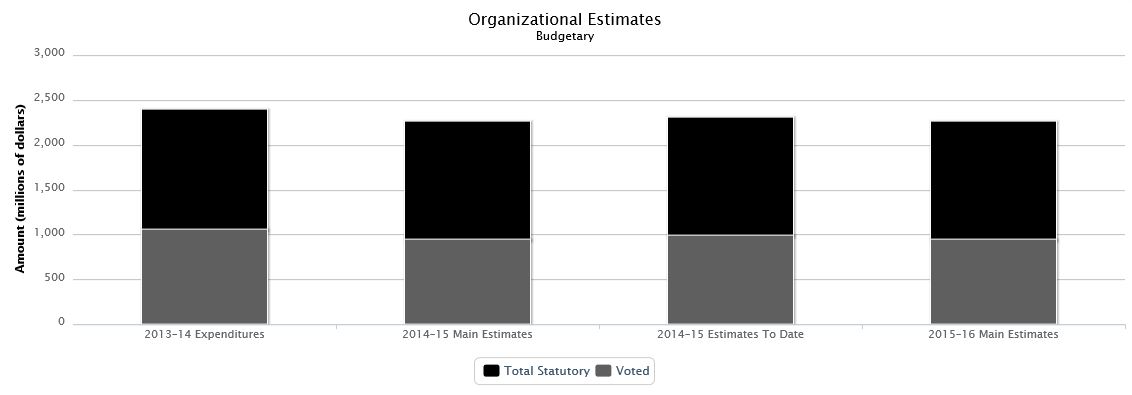
| 2013–14 Expenditures | 2014–15 Main Estimates | 2014–15 Estimates To Date | 2015–16 Main Estimates | ||
|---|---|---|---|---|---|
| Budgetary | |||||
| Voted | |||||
| 1 | Operating expenditures | 703,004,588 | 544,949,432 | 550,538,163 | 548,177,880 |
| 5 | Capital expenditures | 30,768,006 | 27,872,294 | 29,152,994 | 27,872,294 |
| 10 | Grants and contributions | 324,354,015 | 365,352,000 | 408,014,022 | 367,238,619 |
| Total voted | 1,058,126,609 | 938,173,726 | 987,705,179 | 943,288,793 | |
| Total Statutory | 1,328,771,721 | 1,315,023,086 | 1,315,363,086 | 1,313,799,267 | |
| Total budgetary | 2,386,898,330 | 2,253,196,812 | 2,303,068,265 | 2,257,088,060 | |
Highlights
AAFC is estimating budgetary expenditures of $2.3 billion in 2015–16. Of this amount, $943.3 million is voted funding which requires approval by Parliament. The remaining $1.3 billion represents statutory forecasts that do not require additional approval and are provided for information only.
Compared to 2014–15, the Main Estimates have increased by $3.9 million. The major changes include:
- An increase of $5.7 million for the Growing Forward 2 AgriInnovation Program;
- An increase of $5.0 million for AgriRisk Initiatives;
- An increase of $4.4 million for the renewal of the Genomics Research and Development Initiative, which was still being finalized and therefore not included in the 2014–15 Main Estimates, but rather added through Supplementary Estimates in 2014–15;
- An increase of $2.9 million as a result of recently ratified collective agreements;
- A decrease of $5.9 million related to the Canadian Wheat Board Transition Costs Program;
- A planned decrease of $4.9 million related to sunsetting programs ($2.0 million for the Control of Diseases in the Hog Industry phase 2, and $2.9 million for the Canadian Cattlemen's Association Legacy Fund); and
- A $1.0 million transfer to Western Economic Diversification in support of the establishment of the Canadian Beef Centre of Excellence.
2015–16 marks the third year of Growing Forward 2, a five-year (2013-2018) policy framework for Canadaʼs agricultural and agri-food sector. Growing Forward 2 is a $3 billion dollar investment by federal, provincial and territorial governments and the foundation for government agricultural programs and services. This framework supports a shift in focus towards strategic investments that promote innovation, competitiveness and market development initiatives to help producers meet rising demand, both in Canada and internationally, while continuing to proactively manage risk.
The Department will continue to focus on advancing the following:
- Implement Government of Canada and Ministerial priorities;
- Support and improve the competitiveness and adaptability of the agriculture, agri-food and agri-based product sector;
- Maintain and improve access to key international markets;
- Generate new knowledge, foster innovation and increase adoption and commercialization of agricultural, agri-food and agri-based products, processes or practices;
- Continue to improve program and service delivery; and
- Support and engage our workforce to meet current and future work objectives and opportunities in a manner that supports diversity and inclusiveness.
Please refer to the Department's 2015–16 Report on Plans and Priorities for further information.
Expenditures by Strategic Outcome and Program
| 2013–14 Expenditures | 2014–15 Main Estimates | 2015–16 Main Estimates | |
|---|---|---|---|
| A competitive and market-oriented agriculture, agri-food and agri-based products sector that proactively manages risk. | |||
| Business Risk Management | 1,280,762,636 | 1,297,306,348 | 1,301,429,496 |
| Market Access, Negotiations, Sector Competitiveness, and Assurance Systems | 0 | 211,533,122 | 194,586,263 |
| Farm Products Council of Canada | 2,869,840 | 2,483,404 | 3,028,779 |
| An innovative and sustainable agriculture, agri-food and agri-based products sector. | |||
| Science, Innovation, Adoption and Sustainability | 0 | 519,175,818 | 537,550,506 |
| Industry Capacity | 0 | 72,190,745 | 70,990,651 |
| Canadian Pari-Mutuel Agency | (2,158,401) | 34,000 | 0 |
| The following program supports all strategic outcomes within this organization. | |||
| Internal Services | 232,577,216 | 150,473,375 | 149,502,365 |
| Funds not allocated to the 2015–16 Program Alignment Architecture | 872,847,039 | 0 | 0 |
| Total | 2,386,898,330 | 2,253,196,812 | 2,257,088,060 |
Listing of the 2015–16 Transfer Payments
| 2013–14 Expenditures | 2014–15 Main Estimates | 2015–16 Main Estimates | |
|---|---|---|---|
| Grants | |||
| Grant payments for the Canadian Wheat Board Transition Costs program | 29,779,845 | 28,500,000 | 22,600,000 |
| Grant payments for the Churchill Port Utilisation program | 4,553,244 | 4,600,000 | 4,600,000 |
| Grants to foreign recipients for participation in international organizations supporting agriculture | 714,160 | 883,000 | 883,000 |
| Grant payments for the AgriRisk Initiatives program | 100,000 | 100,000 | 100,000 |
| Total Statutory | 238,979,770 | 170,159,547 | 167,300,000 |
| Contributions | |||
| Contributions for Cost-Shared Strategic Initiatives programming in Innovation under Growing Forward 2 | 76,396,764 | 100,179,252 | 100,179,252 |
| Contribution payments for the AgriInnovation program under Growing Forward 2 | 38,703,245 | 60,455,000 | 66,141,619 |
| Contributions for Cost-Shared Strategic Initiatives programming in Competitiveness and Market Development under Growing Forward 2 | 64,535,129 | 60,869,892 | 60,869,892 |
| Contributions for Cost-Shared Strategic Initiatives programming in Adaptability and Industry Capacity under Growing Forward 2 | 23,286,085 | 44,830,856 | 44,830,856 |
| Contribution payments for the AgriMarketing program under Growing Forward 2 | 20,464,938 | 35,500,000 | 34,500,000 |
| Contributions for the AgriRisk Initiatives program | 2,246,393 | 6,400,000 | 11,400,000 |
| Contributions to support the Canadian Agricultural Adaptation program | 15,512,708 | 10,061,000 | 10,061,000 |
| Contributions in support of the Agricultural Greenhouse Gases program | 4,808,261 | 5,382,000 | 5,382,000 |
| Contribution payments for the AgriCompetitiveness program under Growing Forward 2 | 2,504,064 | 3,127,000 | 3,127,000 |
| Contribution payments for the Canadian Wheat Board Transition Costs program | 1,436,882 | 1,600,000 | 1,700,000 |
| Contributions under the Career Focus program – Youth Employment Strategy | 657,372 | 864,000 | 864,000 |
| Total Statutory | 1,009,977,779 | 1,075,124,348 | 1,075,124,348 |
Atlantic Canada Opportunities Agency
Raison d'être
Established in 1987 (Part I of the Government Organization Act, Atlantic Canada 1987, R.S.C., 1985, c.41 (4th Supp.), also known as the Atlantic Canada Opportunities Agency Act), the Atlantic Canada Opportunities Agency (ACOA) is the federal department responsible for the Government of Canada's economic development efforts in the provinces of New Brunswick, Prince Edward Island, Nova Scotia, and Newfoundland and Labrador.
The Minister of State (Atlantic Canada Opportunities Agency) is responsible for this organization.
ACOA works to create opportunities for economic growth in Atlantic Canada by helping businesses become more competitive, innovative and productive, by working with diverse communities to develop and diversify local economies, and by championing the strengths of Atlantic Canada. Together, with Atlantic Canadians, we are building a stronger economy.
Organizational Estimates

| 2013–14 Expenditures | 2014–15 Main Estimates | 2014–15 Estimates To Date | 2015–16 Main Estimates | ||
|---|---|---|---|---|---|
| Budgetary | |||||
| Voted | |||||
| 1 | Operating expenditures | 69,058,793 | 63,873,388 | 63,909,350 | 64,399,896 |
| 5 | Grants and contributions | 236,733,461 | 216,270,293 | 227,633,748 | 225,573,493 |
| Total voted | 305,792,254 | 280,143,681 | 291,543,098 | 289,973,389 | |
| Total Statutory | 8,365,854 | 8,342,703 | 8,342,703 | 8,611,600 | |
| Total budgetary | 314,158,108 | 288,486,384 | 299,885,801 | 298,584,989 | |
Highlights
ACOA is estimating budgetary expenditures of $298.6 million for 2015–16. Of this amount, $290.0 million requires approval by Parliament. The remaining $8.6 million represents statutory forecasts that do not require additional approval and are provided for information purposes only.
ACOA's decrease in spending of $1.3 million compared to the 2014–15 Estimates to date is due to a decrease in contributions and other transfer payments of $2.1 million, an increase in operating costs of $0.5 million, and an increase of $0.3 million in statutory costs. Factors contributing to the net decrease include:
Impact of annual in-year authorities:
- decrease of $11.6 million related to the collection of repayable contributions. An adjustment is required yearly to account for collections in excess of the base amount included in the Main Estimates.
Impact of temporary initiatives:
- $3.2 million increase to support specific projects in innovation, commercialization and community development in New Brunswick; and
- $0.4 million increase in funding to support the spruce budworm outbreak intervention as announced in Budget 2014.
Impacts of other adjustments:
- $7.3 million increase in funding resulting from the dissolution of the Enterprise Cape Breton Corporation;
- $0.2 million increase resulting from collective bargaining;
- $0.1 million increase resulting from other minor adjustments; and
- $0.9 million decrease resulting from the reorganization of the regional federal council.
In 2015–16, the Agency will remain committed to our Government's priorities of job creation and economic growth. The Agency will continue to foster economic development by delivering strategic support that addresses the specific issues facing small- and medium-sized enterprises and urban and rural communities throughout the region. The Agency will work with communities to help them find ways to offset demographic vulnerabilities and develop their capacity to create jobs and economic stability. ACOA will also work with important sectors such as tourism and primary resource industries to develop innovative responses to challenges and remove barriers to growth. ACOA will continue to advocate for Atlantic Canada among partners, stakeholders and decision-makers, with special focus on the region's strengths and opportunities.
For further details on ACOA's planned spending, refer to the 2015–16 Report on Plans and Priorities.
Expenditures by Strategic Outcome and Program
| 2013–14 Expenditures | 2014–15 Main Estimates | 2015–16 Main Estimates | |
|---|---|---|---|
| A competitive Atlantic Canadian economy. | |||
| Enterprise Development | 180,674,018 | 164,581,549 | 171,221,612 |
| Community Development | 94,103,327 | 87,408,010 | 89,727,582 |
| Policy, Advocacy and Coordination | 10,634,165 | 11,351,591 | 11,774,749 |
| The following program supports all strategic outcomes within this organization. | |||
| Internal Services | 28,746,598 | 25,145,234 | 25,861,046 |
| Total | 314,158,108 | 288,486,384 | 298,584,989 |
Listing of the 2015–16 Transfer Payments
| 2013–14 Expenditures | 2014–15 Main Estimates | 2015–16 Main Estimates | |
|---|---|---|---|
| Grants | |||
| Grants to organizations to promote economic cooperation and development | 484,275 | 2,000,000 | 2,000,000 |
| Contributions | |||
| Contributions under the Business Development Program | 128,584,359 | 112,028,293 | 119,894,990 |
| Contributions for the Atlantic Innovation Fund | 47,766,112 | 50,000,000 | 51,500,000 |
| Contributions for the Innovative Communities Fund | 34,508,394 | 39,000,000 | 36,208,465 |
| Contributions under the Community Futures Program | 12,614,168 | 12,642,000 | 12,642,000 |
| Contributions to promote and coordinate economic development throughout Cape Breton Island | 0 | 0 | 2,728,038 |
| Contributions under the Atlantic Policy Research Initiatives | 456,848 | 600,000 | 600,000 |
Atomic Energy of Canada Limited
Raison d'être
Atomic Energy Canada Limited (AECL) uses its unique scientific expertise and facilities to ensure that:
- The Canadian nuclear sector is innovative and productive;
- Canadaʼs security and prosperity are supported by nuclear science and innovation;
- Canadians have a reliable supply of isotopes; and
- Canadaʼs federal nuclear sites are clean and healthy environments.
The current mandate for the AECL Nuclear Laboratories flows from the powers given to the Minister of Natural Resources under the Nuclear Energy Act:
- To undertake research with respect to nuclear energy;
- To cause nuclear energy to be utilized; and
- To license, sell or otherwise dispose of discoveries and inventions relating to nuclear energy and collect payments for them.
Organizational Estimates
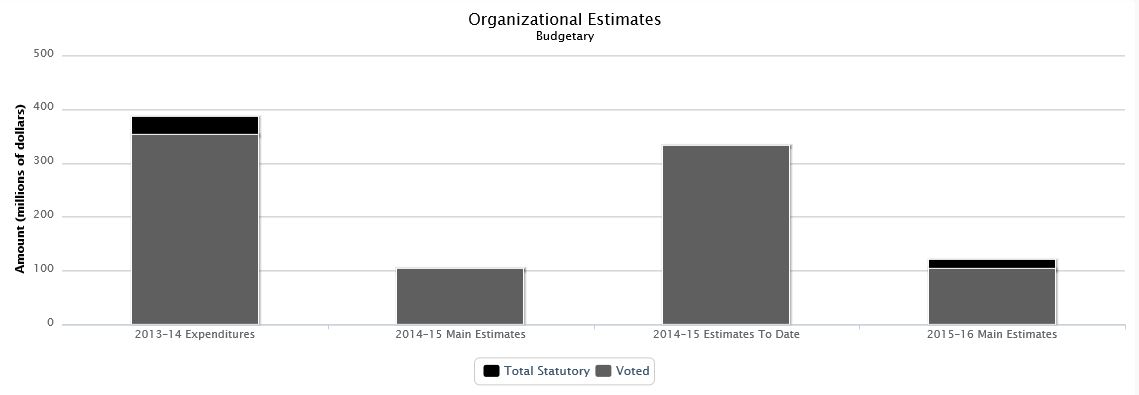
| 2013–14 Expenditures | 2014–15 Main Estimates | 2014–15 Estimates To Date | 2015–16 Main Estimates | ||
|---|---|---|---|---|---|
| Budgetary | |||||
| Voted | |||||
| 1 | Payments to Atomic Energy of Canada Limited for operating and capital expenditures | 351,762,900 | 102,143,000 | 332,428,000 | 102,143,000 |
| Total voted | 351,762,900 | 102,143,000 | 332,428,000 | 102,143,000 | |
| Total Statutory | 33,700,000 | 0 | 0 | 17,000,000 | |
| Total budgetary | 385,462,900 | 102,143,000 | 332,428,000 | 119,143,000 | |
Highlights
AECL's Main Estimates funding of $102.1 million will be used to fund laboratory operations and research and development at Chalk River and to ensure the safe and reliable operation of its nuclear facilities and supporting infrastructure.
Laboratory operations consist of:
- Laboratory Facilities: The specialized facilities operated under a license issued by the Canadian Nuclear Safety Commission;
- Site Support Services: facilities and teams, including engineering, procurement; and maintenance that enable the industrial and scientific activities of the site.
- Municipal Services: the basic services required for the campus to operate, including landlord functions and water, heat and electricity.
Consistent with the Jobs and Economic Growth Act, the statutory funding of $17.0 million included in these Main Estimates will be used to address commercial commitments associated with the divestiture of AECL's CANDU Reactor Division to Candu Energy Inc.
Expenditures by Strategic Outcome and Program
| 2013–14 Expenditures | 2014–15 Main Estimates | 2015–16 Main Estimates | |
|---|---|---|---|
| Be the top worldwide nuclear products and services company. Protect the health and safety of the public, our employees and the environment. Minimize nuclear legacy obligations for future generations. | |||
| Facilities and Nuclear Operations | 0 | 67,006,000 | 67,006,000 |
| Research and Development | 0 | 35,137,000 | 35,137,000 |
| Commercial Business | 0 | 0 | 17,000,000 |
| Waste Management and Decommissioning | 0 | 0 | 0 |
| Funds not allocated to the 2015–16 Program Alignment Architecture | 385,462,900 | 0 | 0 |
| Total | 385,462,900 | 102,143,000 | 119,143,000 |
Auditor General
Raison d'être
The Auditor General is an Officer of Parliament, who is independent from the government and reports directly to Parliament. The Office of the Auditor General is the legislative audit office of the federal government and of the three northern territories. The main legislative auditing duties are financial audits, performance audits, special examinations, and sustainable development monitoring activities and environmental petitions. Our audits and studies provide objective information, advice and assurance to Parliament, territorial legislatures, governments and Canadians. With our reports and testimony, we assist parliamentarians and territorial legislators in their work on the authorization and oversight of government spending and operations. The Minister of Finance is responsible for tabling the Auditor General's administrative reports in Parliament, including the Report on Plans and Priorities and Departmental Performance Report.
Organizational Estimates
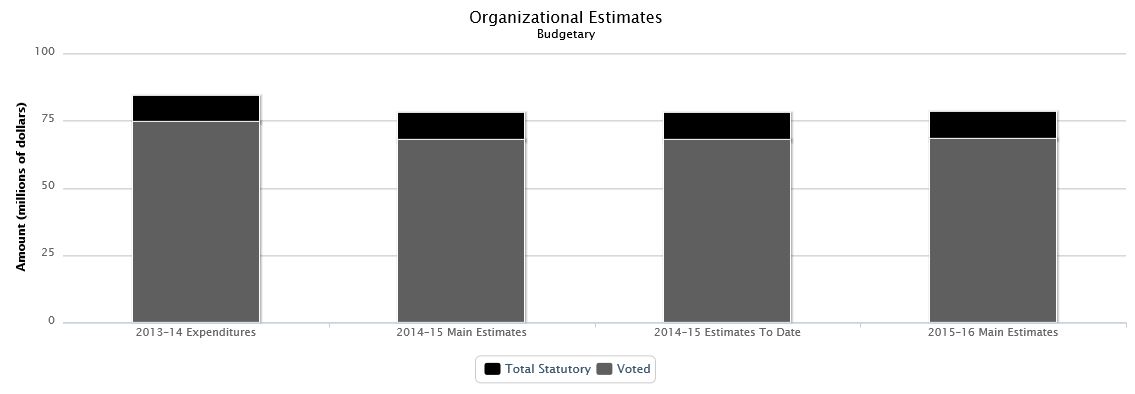
| 2013–14 Expenditures | 2014–15 Main Estimates | 2014–15 Estimates To Date | 2015–16 Main Estimates | ||
|---|---|---|---|---|---|
| Budgetary | |||||
| Voted | |||||
| 1 | Program expenditures | 74,427,946 | 67,947,936 | 67,947,936 | 68,269,099 |
| Total voted | 74,427,946 | 67,947,936 | 67,947,936 | 68,269,099 | |
| Total Statutory | 9,837,073 | 9,793,894 | 9,793,894 | 10,025,921 | |
| Total budgetary | 84,265,019 | 77,741,830 | 77,741,830 | 78,295,020 | |
Highlights
The Office of the Auditor General is estimating budgetary expenditures of $78.3 million in 2015–2016. Of this amount, $68.3 million requires approval by Parliament. The remaining $10.0 million represents statutory forecasts that do not require additional approval and are provided for information purposes.
In total, the Office is estimating an increase of $0.6 million or 0.7% from the previous Main Estimates. Additional information can be found in the Office of the Auditor General's 2015–16 Report on Plans and Priorities.
Expenditures by Strategic Outcome and Program
| 2013–14 Expenditures | 2014–15 Main Estimates | 2015–16 Main Estimates | |
|---|---|---|---|
| Through legislative auditing, we contribute to a well-managed and accountable government for Canadians. | |||
| Legislative Auditing | 84,265,019 | 77,741,830 | 78,295,020 |
| Total | 84,265,019 | 77,741,830 | 78,295,020 |
Canada Border Services Agency
Raison d'être
The Minister of Public Safety and Emergency Preparedness is responsible for the Canada Border Services Agency (CBSA).
The CBSA provides integrated border services that support national security priorities and facilitate the flow of people and goods across the border. Responsibilities include:
- administering legislation that governs the admissibility of people and goods into and out of Canada;
- identifying, detaining, and removing people who are inadmissible to Canada;
- interdicting illegal goods at Canadaʼs border;
- protecting food safety, plant and animal health, and Canada's resource base;
- administering trade legislation and agreements, including the enforcement of trade remedies that protect Canadian industry;
- administering a fair and impartial redress mechanism; and
- collecting duties and taxes on imported goods.
Organizational Estimates
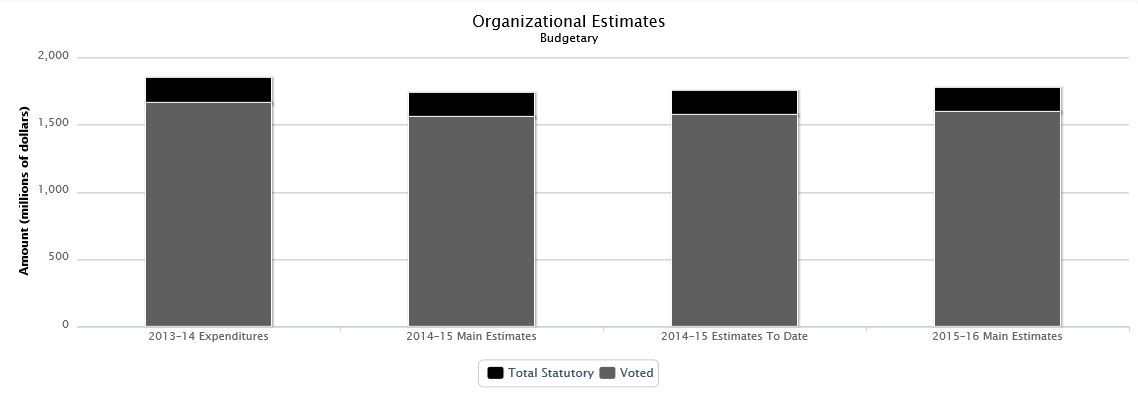
| 2013–14 Expenditures | 2014–15 Main Estimates | 2014–15 Estimates To Date | 2015–16 Main Estimates | ||
|---|---|---|---|---|---|
| Budgetary | |||||
| Voted | |||||
| 1 | Operating expenditures | 1,540,450,182 | 1,397,915,271 | 1,342,483,261 | 1,411,403,312 |
| 5 | Capital expenditures | 121,932,181 | 161,905,641 | 227,334,990 | 180,203,476 |
| Total voted | 1,662,382,363 | 1,559,820,912 | 1,569,818,251 | 1,591,606,788 | |
| Total Statutory | 187,729,139 | 176,570,197 | 177,492,013 | 182,608,133 | |
| Total budgetary | 1,850,111,502 | 1,736,391,109 | 1,747,310,264 | 1,774,214,921 | |
Highlights
The CBSA is estimating budgetary expenditures of $1,774.2 million in 2015–16. Of this amount, $1,591.6million requires approval by Parliament. The remaining $182.6 million represents statutory forecasts related to Employee Benefit Plans (EBP) that do not require additional approval and are provided for information purposes.
The CBSA's increase in net spending of $37.8 million or 2.2% is due to an increase in Operating expenditures of $13.5 million, an increase in Capital expenditures of $18.3 million and an increase of $6.0 million in Statutory expenditures (i.e.: EBP).
Increases totaling $123.2 million in the 2015–16 Main Estimates are mainly due to:
- $30.9 million for new collective bargaining agreements;
- $30.5 million for the Border Infrastructure initiative as part of the Beyond the Border Action Plan;
- $22.6 million for the Arming Initiative due to the reprofile of funding from 2014–15 to 2015–16;
- $16.6 million for the CBSA Assessment and Revenue Management Project to initiate an outsourcing arrangement for the information technology and the delivery of the Account Receivable Ledger;
- $12.7 million increase of project funding requirements for the Entry/Exit initiative as part of the Beyond the Border Action Plan;
- $3.9 million increase of project funding requirements for Trusted Travellers and Traders initiative as part of the Beyond the Border Action Plan; and
- $6.0 million adjustment of the EBP rate from 16.5% to 16.8%.
The increases in the 2015–16 Main Estimates are offset by the decreases totaling $85.4 million which are mainly due to:
- $31.2 million decrease of the project funding requirements in 2015–16 for the eManifest project;
- $20.3 million due to the sunsetting of funding for Front-line Operations;
- $18.9 million reduction of funding for the replacement of the Field Operations Support System with the Global Case Management System; and
- $15.0 million decrease of the project funding requirements in 2015–16 for the Integrated Cargo Security Initiative as part of the Beyond the Border Action Plan.
Expenditures by Strategic Outcome and Program
| 2013–14 Expenditures | 2014–15 Main Estimates | 2015–16 Main Estimates | |
|---|---|---|---|
| International trade and travel is facilitated across Canada's border and Canada's population is protected from border-related risks. | |||
| Admissibility Determination | 816,408,042 | 681,725,979 | 949,587,807 |
| Risk Assessment Program | 167,659,404 | 155,301,134 | 162,698,196 |
| Immigration Enforcement | 173,297,292 | 164,911,279 | 146,023,258 |
| Revenue and Trade Management | 90,169,773 | 73,918,165 | 102,179,578 |
| Secure and Trusted Partnerships | 40,998,175 | 42,062,245 | 39,094,941 |
| Criminal Investigations | 31,415,641 | 23,391,775 | 26,079,013 |
| Recourse | 11,919,916 | 9,832,518 | 11,473,302 |
| The following program supports all strategic outcomes within this organization. | |||
| Internal Services | 518,243,259 | 585,248,014 | 337,078,826 |
| Total | 1,850,111,502 | 1,736,391,109 | 1,774,214,921 |
Canada Council for the Arts
Raison d'être
The Canada Council for the Arts (CCA) is a Crown corporation created in 1957 "to foster and promote the study and enjoyment of, and the production of works in, the arts." Its grants to artists and arts organizations contribute to a vibrant arts scene in Canada. Its awards celebrate creativity by recognizing exceptional Canadians in the arts, humanities and sciences. The Canada Council Art Bank is a national collection of over 17,000 Canadian contemporary artworks, accessible to the public through rental, loan and outreach programs. The Canadian Commission for UNESCO operates under the general authority of the Canada Council.
The CCA reports to Parliament through the Minister of Canadian Heritage and Official Languages.
Organizational Estimates
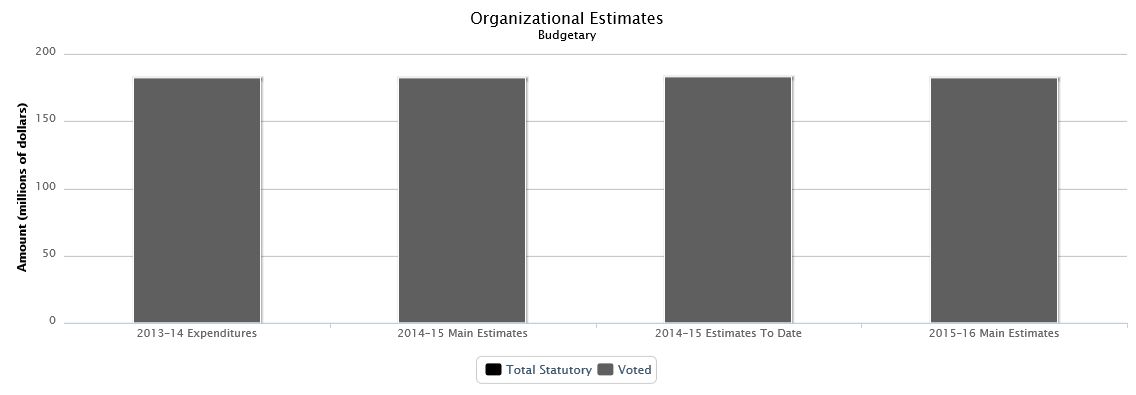
| 2013–14 Expenditures | 2014–15 Main Estimates | 2014–15 Estimates To Date | 2015–16 Main Estimates | ||
|---|---|---|---|---|---|
| Budgetary | |||||
| Voted | |||||
| 1 | Payments to the Canada Council for the Arts | 181,974,388 | 182,092,916 | 182,219,917 | 182,097,387 |
| Total voted | 181,974,388 | 182,092,916 | 182,219,917 | 182,097,387 | |
| Total budgetary | 181,974,388 | 182,092,916 | 182,219,917 | 182,097,387 | |
Highlights
The CCAʼs planned expenditures will show a reallocation of funds to Grants and Services from savings in Internal Services related to efficiencies. The CCA is in the final year of its 2011-2016 Corporate Plan Strengthening Connections which has five directions (individual artists, arts organizations, equity, partnership and internal capacity) as well as three cross-cutting themes (public engagement in the arts, synergy and new technologies). Main areas of activity include:
- Simplification of its granting programs and processes to better serve artists and arts organizations and to scale up its impact for Canadians, through the development of a new funding model based on a forward-looking vision.
- Continuing work on corporate-wide priorities, including public engagement in the arts, national and international market access, Aboriginal Arts and Deaf and Disability Arts.
- Improving the Council's internal capacity, including the development and implementation of a new user-focused client relationship system and improved performance measurement based on results and impact.
- Undertaking the work on the next strategic and corporate planning cycle.
Expenditures by Strategic Outcome and Program
| 2013–14 Expenditures | 2014–15 Main Estimates | 2015–16 Main Estimates | |
|---|---|---|---|
| A vibrant and dynamic arts sector in Canada. | |||
| Grants and services to support creation, production and dissemination of arts for individuals and organizations | 0 | 161,403,170 | 162,352,141 |
| Arts promotion to foster public knowledge and appreciation of the Canadian arts and culture | 0 | 8,322,657 | 8,666,048 |
| The following program supports all strategic outcomes within this organization. | |||
| Internal Services | 0 | 12,367,089 | 11,079,198 |
| Funds not allocated to the 2015–16 Program Alignment Architecture | 181,974,388 | 0 | 0 |
| Total | 181,974,388 | 182,092,916 | 182,097,387 |
Canada Industrial Relations Board
Raison d'être
Pursuant to the Administrative Tribunals Support Service of Canada Act, the Canada Industrial Relations Board was amalgamated to the Administrative Tribunals Support Service of Canada, effective .
Organizational Estimates
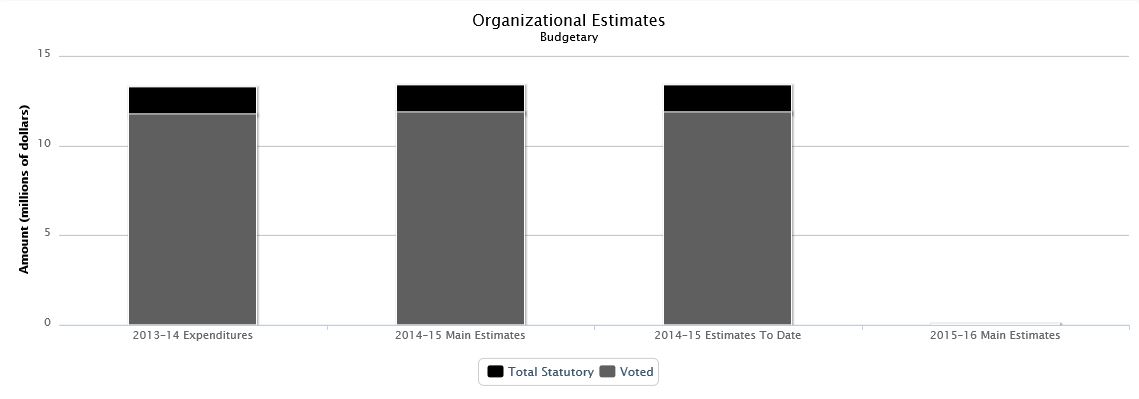
| 2013–14 Expenditures | 2014–15 Main Estimates | 2014–15 Estimates To Date | 2015–16 Main Estimates | ||
|---|---|---|---|---|---|
| Budgetary | |||||
| Voted | |||||
| - | Program expenditures | 11,752,579 | 11,823,711 | 11,823,711 | 0 |
| Total voted | 11,752,579 | 11,823,711 | 11,823,711 | 0 | |
| Total Statutory | 1,504,627 | 1,540,245 | 1,540,245 | 0 | |
| Total budgetary | 13,257,206 | 13,363,956 | 13,363,956 | 0 | |
Highlights
Not applicable
Expenditures by Strategic Outcome and Program
| 2013–14 Expenditures | 2014–15 Main Estimates | 2015–16 Main Estimates | |
|---|---|---|---|
| Effective dispute resolution services that support constructive labour management relations in sectors regulated by the Canada Labour Code and professional relations in sectors regulated by the Status of the Artist Act. | |||
| Adjudication and Dispute Resolution Program | 9,243,095 | 9,678,448 | 0 |
| The following program supports all strategic outcomes within this organization. | |||
| Internal Services | 4,014,111 | 3,685,508 | 0 |
| Total | 13,257,206 | 13,363,956 | 0 |
Canada Mortgage and Housing Corporation
Raison d'être
Canada Mortgage and Housing Corporation (CMHC) is Canada's national housing agency. Established as a federal Crown corporation in 1946 to help address post-war housing shortages, its role has evolved as Canadians' needs have changed. Today, CMHC works closely with provinces, territories and the private and not-for-profit sectors to help lower-income Canadians access affordable, better quality housing. CMHC also helps Aboriginal Canadians meet their distinct housing needs.
CMHC's role in housing finance (providing mortgage loan insurance and securitization guarantee products) contributes to the health and stability of Canada's housing finance system and facilitates access to financing for housing across the country. This includes loans for housing in small and rural communities, rental housing and for nursing and retirement homes.
CMHC also promotes the efficiency of the Canadian housing system through market analysis and research.
CMHC is accountable to Parliament through the Minister of Employment and Social Development.
Organizational Estimates
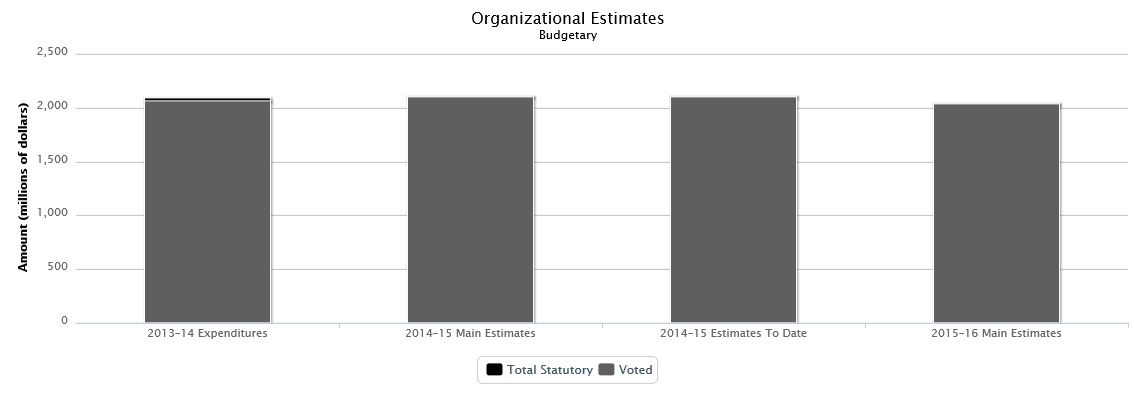
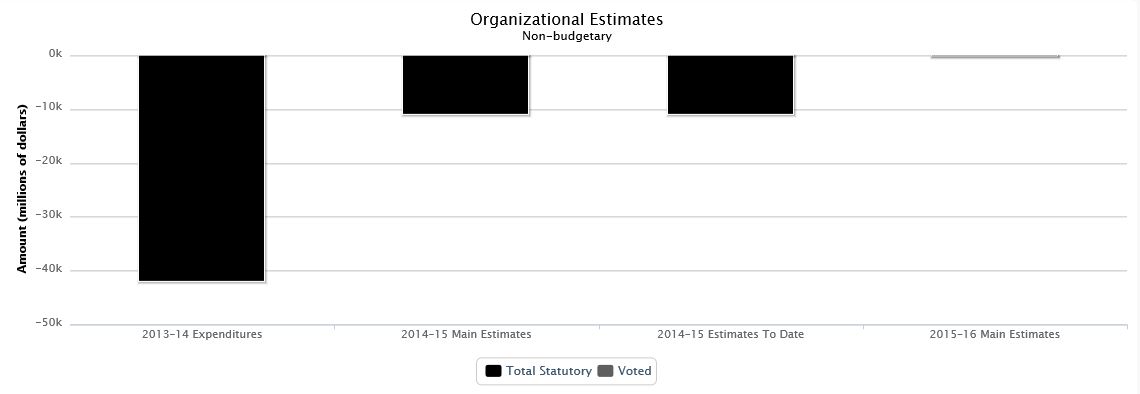
| 2013–14 Expenditures | 2014–15 Main Estimates | 2014–15 Estimates To Date | 2015–16 Main Estimates | ||
|---|---|---|---|---|---|
| Budgetary | |||||
| Voted | |||||
| 1 | Reimbursement under the provisions of the National Housing Act and the Canada Mortgage and Housing Corporation Act | 2,054,849,627 | 2,097,353,000 | 2,097,353,000 | 2,025,629,000 |
| Total voted | 2,054,849,627 | 2,097,353,000 | 2,097,353,000 | 2,025,629,000 | |
| Total Statutory | 30,000,000 | 0 | 0 | 0 | |
| Total budgetary | 2,084,849,627 | 2,097,353,000 | 2,097,353,000 | 2,025,629,000 | |
| Non-budgetary | |||||
| Total Statutory | (41,950,460,603) | (10,880,408,000) | (10,880,408,000) | (139,123,000) | |
| Total non-budgetary | (41,950,460,603) | (10,880,408,000) | (10,880,408,000) | (139,123,000) | |
Highlights
CMHC is estimating budgetary expenditures of $2 billion in 2015–16. Included in the budgetary expenditures is $253.1 million related to the second year of the five-year extension of funding under the Investment in Affordable Housing. Major changes are summarized below.
A net budgetary decrease of $71.7 million from the 2014–15 Main Estimates is due primarily to the following:
- A decrease of $70 million in funding for housing in Nunavut as the two-year commitment expires in 2014–15;
- A decrease of $5 million due to updated pace of spending for renovation programs on-reserve; and
- An increase of $4 million for additional housing construction and rehabilitation on-reserve. This funding allows for new commitment activity to assist First Nations in the construction, purchase and rehabilitation of suitable, adequate and affordable rental housing, as well as providing financial assistance to repair substandard homes to a minimum level of health and safety.
CMHC is estimating non-budgetary net repayments of $139 million in 2015–16 compared to $10.9 billion in net repayments in the 2014–15 Main Estimates. Repayments have decreased due to lower net repayments under the Crown Borrowing Program resulting from lower loan repayments under the Insured Mortgage Purchase Program (IMPP). The 2014–15 repayments represented the final obligations under this program.
As Canada's national housing agency, CMHC plays a significant role in administering federal investments in social housing through agreements with provinces and territories and First Nation communities. CMHC also provides federal funding towards renovation programs so that needed repairs or rehabilitation can be undertaken for seniors, persons with disabilities, victims of family violence and others who otherwise could not afford adequate and suitable housing.
CMHC is the only source of comprehensive market analysis information serving both industry and consumers. Its market analysis and research activities on key housing issues have been instrumental in helping Canadians make more informed housing choices. These activities also support industry in the planning, designing, construction, operation and maintenance of housing, and assist the public policy decision-making process. Better information contributes to the stability, effectiveness and efficiency of housing markets.
Once tabled in the House of Commons, additional information will be available in CMHC's Summary of the Corporate Plan, available on its website.
Expenditures by Strategic Outcome and Program
| 2013–14 Expenditures | 2014–15 Main Estimates | 2015–16 Main Estimates | |
|---|---|---|---|
| Canadians in need have access to affordable housing. | |||
| Funding Under Long-Term Commitments for Existing Social Housing | 1,716,335,548 | 1,681,525,000 | 1,689,932,000 |
| Funding for New Commitments of Affordable Housing | 316,270,485 | 361,820,000 | 284,352,000 |
| Housing Support | 6,889,835 | 7,474,000 | 7,962,000 |
| Canada has a stable, competitive and innovative housing system. | |||
| Market Analysis Information | 23,010,395 | 25,078,000 | 24,673,000 |
| Housing Policy, Research and Information Transfer | 22,343,364 | 21,456,000 | 18,710,000 |
| Total | 2,084,849,627 | 2,097,353,000 | 2,025,629,000 |
| 2013–14 Expenditures | 2014–15 Main Estimates | 2015–16 Main Estimates | |
|---|---|---|---|
| Canadians in need have access to affordable housing. | |||
| Funding Under Long-Term Commitments for Existing Social Housing | 5,720,117 | (313,739,000) | (3,690,000) |
| Funding for New Commitments of Affordable Housing | 0 | 500,000 | 500,000 |
| Housing Support | (161,231,773) | (133,125,000) | (135,933,000) |
| Canada has a stable, competitive and innovative housing system. | |||
| Insured Mortgage Purchase Program | (41,794,948,947) | (10,434,044,000) | 0 |
| Total | (41,950,460,603) | (10,880,408,000) | (139,123,000) |
Canada Post Corporation
Raison d'être
Canada Post Corporation has a mandate to provide an efficient, effective and quality-driven postal service to Canadians, to be profitable, and to maintain and increase the value of the Corporation for Canadians.
The Minister of Transport is responsible for this organization.
Under the terms of the Canada Post Corporation Act, the Corporation is mandated to operate the postal service on a financially self-sustaining basis. In addition to core postal service, Canada Post also delivers certain public policy programs for the Government.
Organizational Estimates
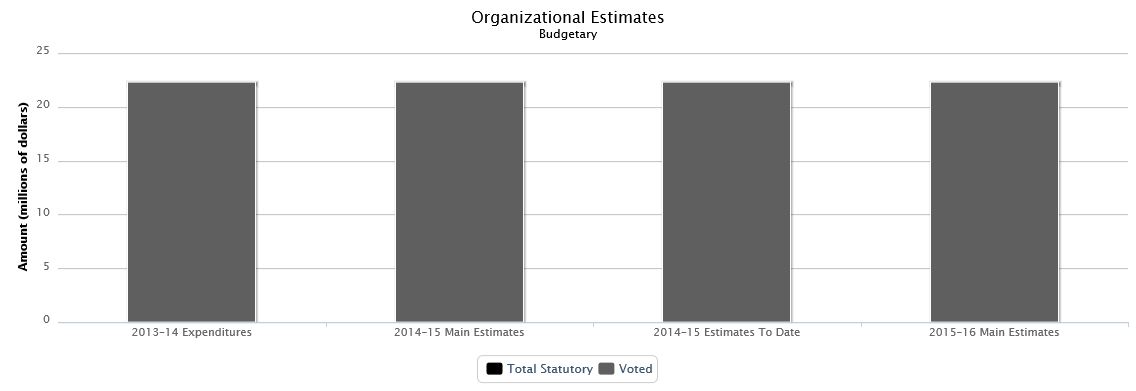
| 2013–14 Expenditures | 2014–15 Main Estimates | 2014–15 Estimates To Date | 2015–16 Main Estimates | ||
|---|---|---|---|---|---|
| Budgetary | |||||
| Voted | |||||
| 1 | Payments to the Canada Post Corporation for special purposes | 22,210,000 | 22,210,000 | 22,210,000 | 22,210,000 |
| Total voted | 22,210,000 | 22,210,000 | 22,210,000 | 22,210,000 | |
| Total budgetary | 22,210,000 | 22,210,000 | 22,210,000 | 22,210,000 | |
Highlights
Canada Post Corporation receives an annual appropriation of $22.2 million from the Government for the delivery of Parliamentary mail and materials for the use of the blind, which are sent free of postage under the Act. This appropriation helps to offset the financial impact of these programs on the Corporation.
Parliamentary Mail
The Canada Post Corporation Act allows for the free mailing of letters between Canadians and the Governor General, the Speaker or Clerk of the Senate or the House of Commons, a member of the Senate or House of Commons, the Parliamentary Librarian or the Associate Librarian, the Conflict of Interest and Ethics Commissioner or Senate Ethics Officer. Under the Act, members of the House of Commons are also allowed up to four free householder (Unaddressed Admail) mailings to their constituents in any calendar year.
Materials for the Use of the Blind
The Canada Post Corporation Act provides for free mailing of materials for the blind. Today, thousands of visually impaired Canadians and many libraries across the country, including that of the Canadian National Institute for the Blind, send talking books and other materials free of charge.
Expenditures by Strategic Outcome and Program
| 2013–14 Expenditures | 2014–15 Main Estimates | 2015–16 Main Estimates | |
|---|---|---|---|
| Compensation for the provision of Parliamentary mail and Materials for the use of the blind services, which are sent free of postage under the Canada Post Corporation Act. | |||
| Concessionary Governmental Services | 0 | 22,210,000 | 22,210,000 |
| Funds not allocated to the 2015–16 Program Alignment Architecture | 22,210,000 | 0 | 0 |
| Total | 22,210,000 | 22,210,000 | 22,210,000 |
Canada Revenue Agency
Raison d'être
The Canada Revenue Agency (CRA) administers tax, benefits and related programs, and ensures compliance on behalf of governments across Canada. The CRA's activities provide these governments the revenue needed to deliver essential services to Canadians that lay the foundation for continued economic prosperity and future growth. The CRA processes hundreds of billions of dollars in taxes annually and issue billions of dollars in benefit and credit payments.
The CRA's mandate is to ensure that Canadians:
- Pay their required share of taxes;
- Receive their rightful share of entitlements; and
- Are provided with an impartial and responsive review of decisions they choose to contest.
Organizational Estimates
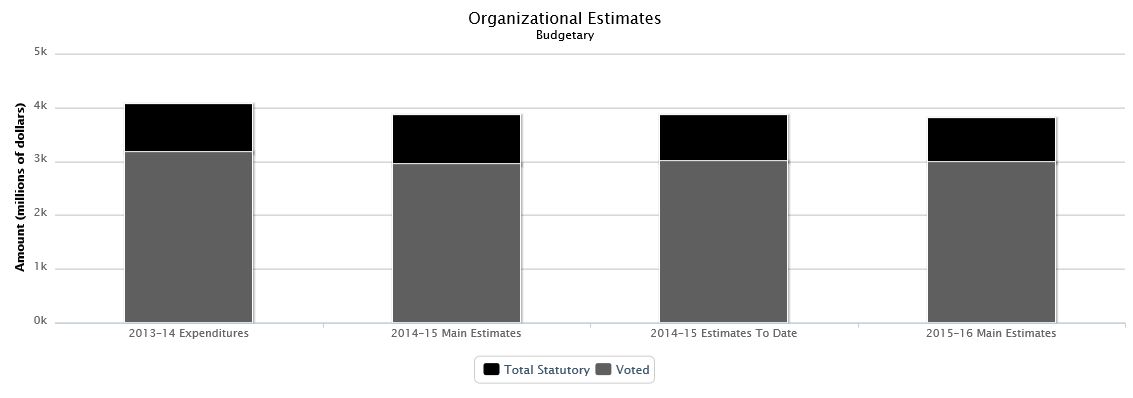
| 2013–14 Expenditures | 2014–15 Main Estimates | 2014–15 Estimates To Date | 2015–16 Main Estimates | ||
|---|---|---|---|---|---|
| Budgetary | |||||
| Voted | |||||
| 1 | Operating expenditures, contributions and recoverable expenditures on behalf of the Canada Pension Plan and the Employment Insurance Act | 3,097,500,944 | 2,877,504,675 | 2,933,087,831 | 2,898,927,871 |
| 5 | Capital expenditures and recoverable expenditures on behalf of the Canada Pension Plan and the Employment Insurance Act | 63,301,048 | 72,447,985 | 76,703,047 | 80,496,902 |
| Total voted | 3,160,801,992 | 2,949,952,660 | 3,009,790,878 | 2,979,424,773 | |
| Total Statutory | 902,057,364 | 911,303,449 | 838,584,038 | 825,419,615 | |
| Total budgetary | 4,062,859,356 | 3,861,256,109 | 3,848,374,916 | 3,804,844,388 | |
Highlights
The CRA is estimating budgetary expenditures of $3.8 billion in 2015–16. Of this amount, $3.0 billion requires approval by Parliament. The remaining $0.8 billion represents statutory forecasts that do not require additional approval and are provided for information purposes.
In total, the Agency is displaying a decrease of $56.4 million or 1.5% from previous Main Estimates, which is the net result of various increases offset by certain planned decreases.
The CRA budgets will be decreasing by $120.6 million due to the following:
- $80.0 million presented under the Taxpayer and Business Assistance Program Activity related to the disbursements to provinces under the Softwood Lumber Products Export Charge Act;
- $14.0 million in savings identified as part of the Budget 2012 spending review;
- $9.0 million in payments under the Children's Special Allowance Act for eligible children in the care of agencies and foster parents;
- $8.2 million in the spending of revenues received through the conduct of its operations primarily attributable to reductions in initiatives administered on behalf of the Canada Border Services Agency and the province of Ontario;
- $3.0 million in savings identified as part of the Budget 2013 targeted review;
- $2.7 million for various initiatives announced in the 2011 and 2012 Federal Budgets;
- $2.7 million related to adjustments to accommodation and real property services provided by Public Works and Government Services Canada; and
- $1.0 million for government advertising programs.
The above mentioned decreases are offset by increases totalling $64.2 million due to the following:
- $29.3 million for enhancements to non-audit compliance programs;
- $14.1 million for the administration of various tax measures announced in the 2013 Federal Budget and the administration of the Harmonized Sales Tax and Harmonized Sales Tax Credit in Prince Edward Island;
- $6.3 million related to contributions to employee benefit plans;
- $5.0 million for the upgrade of the individual income tax processing system;
- $4.6 million for the implementation and administration of various tax measures announced in the 2014 Federal Budget;
- $2.3 million for collective bargaining increases;
- $1.6 million for information reporting of tax avoidance transactions to ensure the fairness of the Canadian tax system;
- $0.7 million for the implementation of the intergovernmental agreement between Canada and the United States on the enhanced exchange of information; and
- $0.3 million for various other transfers.
Expenditures by Strategic Outcome and Program
| 2013–14 Expenditures | 2014–15 Main Estimates | 2015–16 Main Estimates | |
|---|---|---|---|
| Taxpayers meet their obligations and Canadaʼs revenue base is protected. | |||
| Reporting Compliance | 1,084,562,230 | 1,054,502,522 | 1,045,193,249 |
| Assessment of Returns and Payment Processing | 649,108,155 | 597,018,261 | 614,590,330 |
| Collections and Returns Compliance | 496,787,602 | 440,164,211 | 469,453,195 |
| Taxpayer and Business Assistance | 350,801,699 | 350,017,682 | 280,181,661 |
| Appeals | 190,219,456 | 194,334,428 | 179,658,662 |
| Eligible families and individuals receive timely and accurate benefit payments. | |||
| Benefit Programs | 374,414,324 | 390,354,003 | 375,217,640 |
| Taxpayers and benefit recipients receive an independent and impartial review of their service-related complaints. | |||
| Taxpayersʼ Ombudsman | 2,524,101 | 3,167,366 | 3,198,657 |
| The following program supports all strategic outcomes within this organization. | |||
| Internal Services | 914,441,789 | 831,697,636 | 837,350,994 |
| Total | 4,062,859,356 | 3,861,256,109 | 3,804,844,388 |
Canada School of Public Service
Raison d'être
The Canada School of Public Service (the School) is the common learning service provider for the Public Service of Canada. The School has a legislative mandate to provide a range of learning activities to build individual and organizational capacity and management excellence within the public service. The School has one strategic outcome: Federal public service employees have the common knowledge, skills and competencies to fulfill their responsibilities in serving Canadians.
The President of the Treasury Board is responsible for this organization.
Organizational Estimates
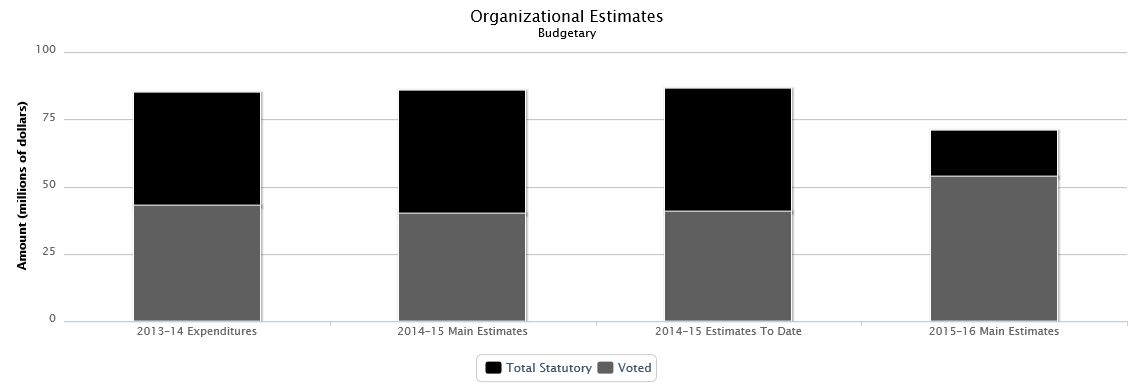
| 2013–14 Expenditures | 2014–15 Main Estimates | 2014–15 Estimates To Date | 2015–16 Main Estimates | ||
|---|---|---|---|---|---|
| Budgetary | |||||
| Voted | |||||
| 1 | Program expenditures | 42,820,558 | 39,921,868 | 40,721,575 | 53,794,403 |
| Total voted | 42,820,558 | 39,921,868 | 40,721,575 | 53,794,403 | |
| Total Statutory | 41,941,023 | 45,568,160 | 45,568,160 | 17,085,280 | |
| Total budgetary | 84,761,581 | 85,490,028 | 86,289,735 | 70,879,683 | |
Highlights
The School is estimating budgetary expenditures of $70.9 million in 2015–16. Of this amount, $53.8 million requires approval by Parliament. The remaining amount of $17.1 million represents statutory authority that does not require additional approval and is provided for information purposes.
In comparison with 2014–15, the 2015–16 Main Estimates have declined by $14.6 million. The main areas impacted are salaries and professional and special services.
Once tabled in the House of Commons, additional information will be available in the departmental Report on Plans and Priorities available at: http://www.csps-efpc.gc.ca/about_us/currentreport/index-eng.aspx.
Expenditures by Strategic Outcome and Program
| 2013–14 Expenditures | 2014–15 Main Estimates | 2015–16 Main Estimates | |
|---|---|---|---|
| Federal public service employees have the common knowledge, skills and competencies to fulfill their responsibilities in serving Canadians. | |||
| Learning Services | 0 | 0 | 51,113,769 |
| The following program supports all strategic outcomes within this organization. | |||
| Internal Services | 21,110,927 | 23,918,090 | 19,765,914 |
| Funds not allocated to the 2015–16 Program Alignment Architecture | 63,650,654 | 61,571,938 | 0 |
| Total | 84,761,581 | 85,490,028 | 70,879,683 |
Canadian Air Transport Security Authority
Raison d'être
The Canadian Air Transport Security Authority (CATSA) is a Crown corporation with the mandate to protect the public by securing critical elements of the air transportation system as assigned by the Government of Canada. CATSA's goal is to provide a professional, effective, efficient and consistent level of security screening services, at or above the standards set by Transport Canada, its regulator. Fully funded by parliamentary appropriations, CATSA is accountable to Parliament through the Minister of Transport. CATSA's vision is to excel in air transportation security through its service to passengers, its people and its partnerships.
Organizational Estimates
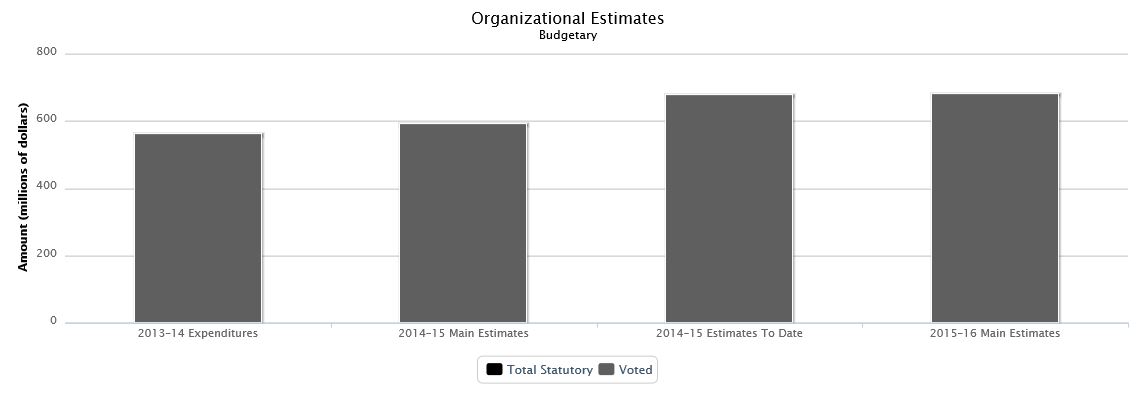
| 2013–14 Expenditures | 2014–15 Main Estimates | 2014–15 Estimates To Date | 2015–16 Main Estimates | ||
|---|---|---|---|---|---|
| Budgetary | |||||
| Voted | |||||
| 1 | Payments to the Canadian Air Transport Security Authority for operating and capital expenditures | 559,065,861 | 591,626,313 | 676,185,743 | 678,420,347 |
| Total voted | 559,065,861 | 591,626,313 | 676,185,743 | 678,420,347 | |
| Total budgetary | 559,065,861 | 591,626,313 | 676,185,743 | 678,420,347 | |
Highlights
CATSA's 2015–16 Main Estimates of $678.4 million, which require approval from Parliament, consist of $543.6 million for operating expenditures and $134.8 million for capital expenditures. CATSA's 2015–16 Main Estimates are $86.8 million, or approximately 15% higher compared to its 2014–15 Main Estimates of $591.6 million.
CATSA's 2015–16 Main Estimates for operating expenditures of $543.6 million are $70.1 million or approximately 15% higher compared to its 2014–15 Main Estimates of $473.5 million. The variance is mainly attributable to an increase in budget to deliver Enhanced Non-Passenger Screening activity in support of the strengthened International Civil Aviation Organization standard.
CATSA's 2015–16 Main Estimates for capital expenditures of $134.8 million are $16.6 million or approximately 14% higher compared to its 2014–15 Main Estimates of $118.2 million. The year-over-year variance is mainly attributable to an increase in the capital budget to deliver the Enhanced Non-Passenger Screening program, combined with higher capital spending associated with the deployment of CATSA's new Hold Baggage Screening system which is based on a 10-year deployment schedule.
As set out in its 2014–15 to 2018–19 Corporate Plan Summary, CATSA's funding priorities for 2015–16 will continue to focus on the delivery of its core mandated activities. This will include the continued implementation of the Enhanced Non-Passenger Screening program, and the ongoing deployment of CATSA's new Hold Baggage Screening system in support of the Canada-U.S. Beyond the Border Declaration for a Shared Vision for Perimeter Security and Economic Competitiveness.
Expenditures by Strategic Outcome and Program
| 2013–14 Expenditures | 2014–15 Main Estimates | 2015–16 Main Estimates | |
|---|---|---|---|
| Screening programs at designated Canadian airports protect the travelling public. | |||
| Pre-Board Screening | 0 | 319,300,039 | 292,610,000 |
| Hold Baggage Screening | 0 | 199,229,096 | 224,647,347 |
| Non-Passenger Screening | 0 | 17,043,000 | 110,320,000 |
| Restricted Area Identity Card | 0 | 4,126,000 | 1,646,000 |
| The following program supports all strategic outcomes within this organization. | |||
| Internal Services | 0 | 51,928,178 | 49,197,000 |
| Funds not allocated to the 2015–16 Program Alignment Architecture | 559,065,861 | 0 | 0 |
| Total | 559,065,861 | 591,626,313 | 678,420,347 |
Canadian Broadcasting Corporation
Raison d'être
As defined by the 1991 Broadcasting Act, the Canadian Broadcasting Corporation (the Corporation), as the national public broadcaster, should provide radio and television services incorporating a wide range of programming that informs, enlightens and entertains. The programming provided by the Corporation should:
- be predominantly and distinctively Canadian;
- reflect Canada and its regions to national and regional audiences, while serving the special needs of those regions;
- actively contribute to the flow and exchange of cultural expression;
- be in English and in French, reflecting the different needs and circumstances of each official language community, including the particular needs and circumstances of English and French linguistic minorities;
- strive to be of equivalent quality in English and French;
- contribute to shared national consciousness and identity;
- be made available throughout Canada by the most appropriate and efficient means and as resources become available for the purpose; and
- reflect the multicultural and multiracial nature of Canada.
The Corporation reports to Parliament through the Minister of Canadian Heritage and Official Languages.
Organizational Estimates
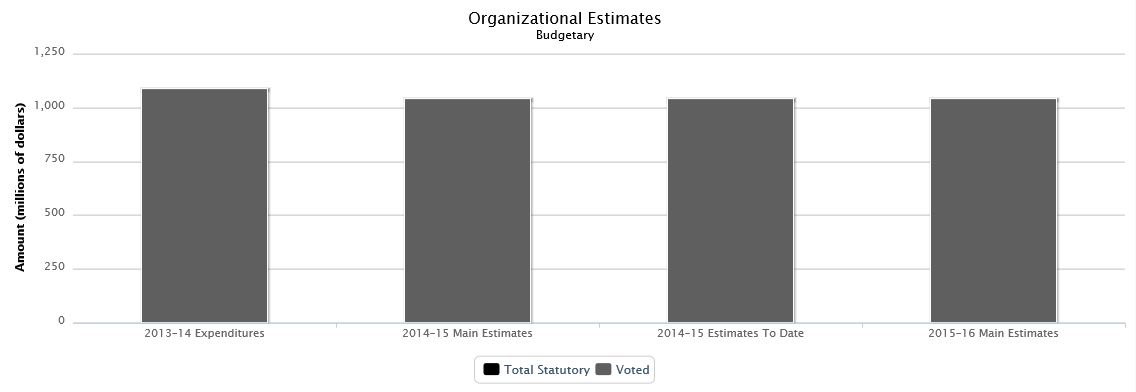
| 2013–14 Expenditures | 2014–15 Main Estimates | 2014–15 Estimates To Date | 2015–16 Main Estimates | ||
|---|---|---|---|---|---|
| Budgetary | |||||
| Voted | |||||
| 1 | Payments to the Canadian Broadcasting Corporation for operating expenditures | 975,617,798 | 929,278,212 | 929,278,212 | 928,331,798 |
| 5 | Payments to the Canadian Broadcasting Corporation for working capital | 4,000,000 | 4,000,000 | 4,000,000 | 4,000,000 |
| 10 | Payments to the Canadian Broadcasting Corporation for capital expenditures | 103,856,000 | 104,740,000 | 104,740,000 | 105,692,000 |
| Total voted | 1,083,473,798 | 1,038,018,212 | 1,038,018,212 | 1,038,023,798 | |
| Total budgetary | 1,083,473,798 | 1,038,018,212 | 1,038,018,212 | 1,038,023,798 | |
Highlights
2015–16 will be the first year of the Corporation's new 5-year strategy, A Space for us all. The strategy aims to better position the broadcaster to meet the fundamental shifts that are transforming the media universe, and consequently how it connects with Canadians. A Space for us all is a promise by CBC/Radio-Canada to intensify and deepen its one-on-one relationship with individual Canadians; work in partnership with the creative community to communicate the breadth and depth of Canada's reality; and set the Corporation on a clear course to long-term financial sustainability. The vision is that by 2020, CBC/Radio-Canada will be the public space at the heart of our conversations and experiences as Canadians.
Expenditures by Strategic Outcome and Program
| 2013–14 Expenditures | 2014–15 Main Estimates | 2015–16 Main Estimates | |
|---|---|---|---|
| A national public broadcasting service exists that is primarily Canadian in content and connects citizens to the Canadian experience. | |||
| Television, Radio and Digital Services | 0 | 991,634,833 | 989,603,427 |
| Transmission and Distribution of Programs | 0 | 40,238,810 | 43,015,695 |
| Specialty Channels for Specific Audiences | 0 | 0 | 0 |
| The following program supports all strategic outcomes within this organization. | |||
| Internal Services | 0 | 6,144,569 | 5,404,676 |
| Funds not allocated to the 2015–16 Program Alignment Architecture | 1,083,473,798 | 0 | 0 |
| Total | 1,083,473,798 | 1,038,018,212 | 1,038,023,798 |
Canadian Centre for Occupational Health and Safety
Raison d'être
The Canadian Centre for Occupational Health and Safety (CCOHS) was founded by an Act of Parliament in 1978 with a mandate to promote health and safety in the workplace and to enhance the physical and mental health of working Canadians. CCOHS operates under the legislative authority of the Canadian Centre for Occupational Health and Safety Act (S.C., 1977–78, c. 29) which was passed by unanimous vote in the Canadian Parliament. The purpose of this Act is to promote the fundamental right of Canadians to a healthy and safe working environment by creating a national institute (CCOHS) concerned with the study, encouragement and co-operative advancement of occupational health and safety. CCOHS functions as an independent departmental corporation under Schedule II of the Financial Administration Act and is accountable to Parliament through the Minister of Labour. Its funding is derived from a combination of appropriations, cost recoveries and collaboration with the provinces. It is expected that a portion of the budget will be funded through cost recoveries from the creation, production, and worldwide sales of fee-for-service and revenue generating occupational health and safety products and services.
Organizational Estimates
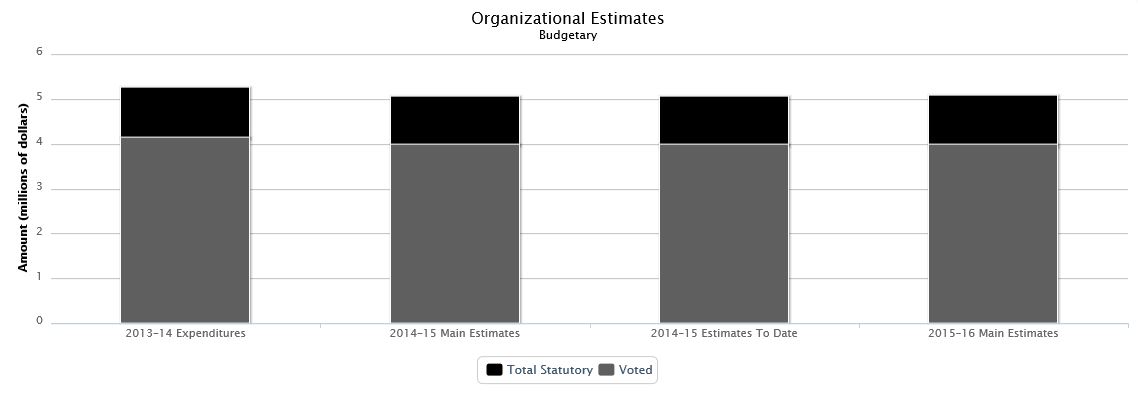
| 2013–14 Expenditures | 2014–15 Main Estimates | 2014–15 Estimates To Date | 2015–16 Main Estimates | ||
|---|---|---|---|---|---|
| Budgetary | |||||
| Voted | |||||
| 1 | Program expenditures | 4,129,766 | 3,978,250 | 3,978,250 | 3,969,600 |
| Total voted | 4,129,766 | 3,978,250 | 3,978,250 | 3,969,600 | |
| Total Statutory | 1,117,425 | 1,080,791 | 1,080,791 | 1,100,669 | |
| Total budgetary | 5,247,191 | 5,059,041 | 5,059,041 | 5,070,269 | |
Highlights
The CCOHS' planned expenditures remain the same as last year. CCOHS will focus its efforts on providing a wide range of needed, relevant and practical information, resources and training that assist Canadians to improve health and safety. We will work with Canadian and global partners to develop the resources and tools that will improve health and safety and contribute to making Canada's workplaces safe and more productive.
Expenditures by Strategic Outcome and Program
| 2013–14 Expenditures | 2014–15 Main Estimates | 2015–16 Main Estimates | |
|---|---|---|---|
| Improved workplace conditions and practices that enhance the health, safety, and well being of working Canadians. | |||
| Occupational health and safety information development, delivery services and tripartite collaboration | 2,607,398 | 2,251,329 | 2,259,188 |
| The following program supports all strategic outcomes within this organization. | |||
| Internal Services | 2,639,793 | 2,807,712 | 2,811,081 |
| Total | 5,247,191 | 5,059,041 | 5,070,269 |
Canadian Commercial Corporation
Raison d'être
The Canadian Commercial Corporation (CCC) is governed by its enacting legislation, the 1946 Canadian Commercial Corporation Act. The Act outlines CCC's broad mandate, which is to assist in the development of trade by helping Canadian exporters access markets abroad and by helping foreign buyers obtain goods from Canada. The legislation also provides CCC with a range of powers, including the ability to export goods from Canada either as principal or as agent in such a manner and to such an extent as it deems appropriate. As a result, CCC negotiates and executes bilateral government-to-government procurement arrangements, facilitating export transactions on behalf of Canadian exporters.
CCC reports to Parliament through the Minister of International Trade.
Organizational Estimates
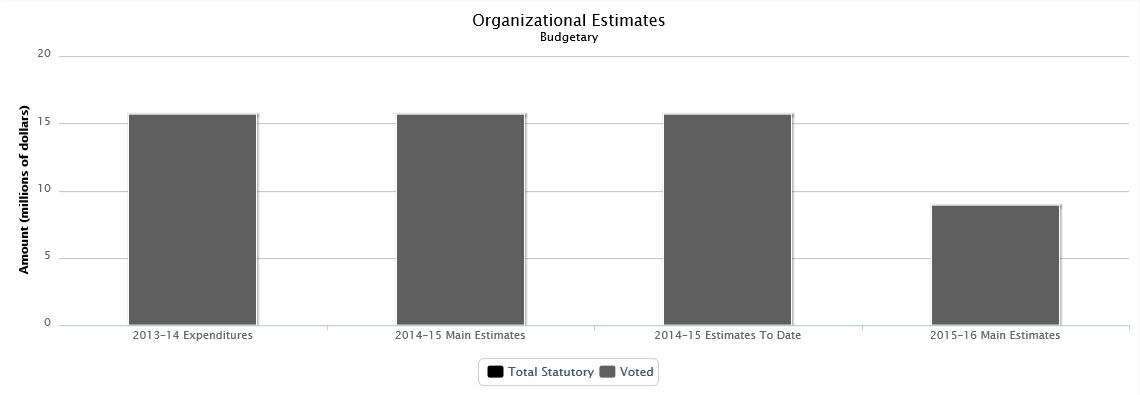
| 2013–14 Expenditures | 2014–15 Main Estimates | 2014–15 Estimates To Date | 2015–16 Main Estimates | ||
|---|---|---|---|---|---|
| Budgetary | |||||
| Voted | |||||
| 1 | Payments to the Canadian Commercial Corporation | 15,656,400 | 15,654,204 | 15,654,204 | 8,880,000 |
| Total voted | 15,656,400 | 15,654,204 | 15,654,204 | 8,880,000 | |
| Total budgetary | 15,656,400 | 15,654,204 | 15,654,204 | 8,880,000 | |
Highlights
The CCC is estimating vote budgetary expenditures of $8.9 million in 2015–16 which require approval by Parliament. The funding will be used to facilitate sales of goods and services from Canadian exporters to the U.S. Department of Defence in support of the North American Defence Industrial Base and to facilitate the Corporation's corporate services in support of the governmentʼs overarching public policy priorities, broad strategic goals and expectations.
On all other export transactions, CCC charges fees for service. These fees support CCC's other expenditures.
Expenditures by Strategic Outcome and Program
| 2013–14 Expenditures | 2014–15 Main Estimates | 2015–16 Main Estimates | |
|---|---|---|---|
| Enhanced market access for Canadian exporters to complex international public sector markets. | |||
| Defence | 0 | 15,654,204 | 8,880,000 |
| Emerging and Developing Markets | 0 | 0 | 0 |
| Funds not allocated to the 2015–16 Program Alignment Architecture | 15,656,400 | 0 | 0 |
| Total | 15,656,400 | 15,654,204 | 8,880,000 |
Canadian Dairy Commission
Raison d'être
The Canadian Dairy Commission (CDC) is a federal Crown corporation created in 1966 through the Canadian Dairy Commission Act. It reports to Parliament through the Minister of Agriculture and Agri-Food. Its legislated objectives are twofold: to provide efficient producers of milk and cream with the opportunity of obtaining a fair return for their labour and investment; and to provide consumers of dairy products with a continuous and adequate supply of dairy products of high quality.
The CDC plays a central facilitating role for the multi-billion dollar Canadian dairy industry. Federal-provincial agreements now provide the authority for many of the programs and activities that the CDC employees administer and facilitate on a day-to-day basis. The CDC strives to balance and serve the interests of all dairy stakeholders — producers, processors, further processors, exporters, consumers and governments.
Organizational Estimates
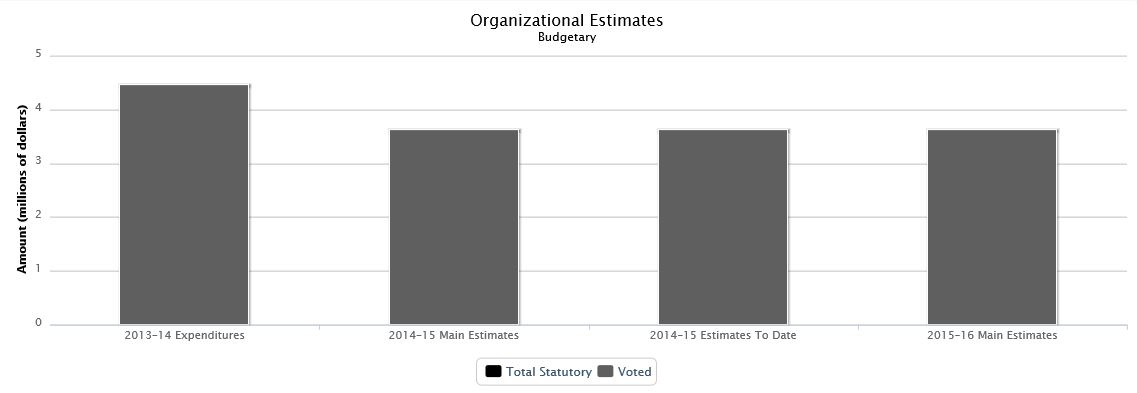
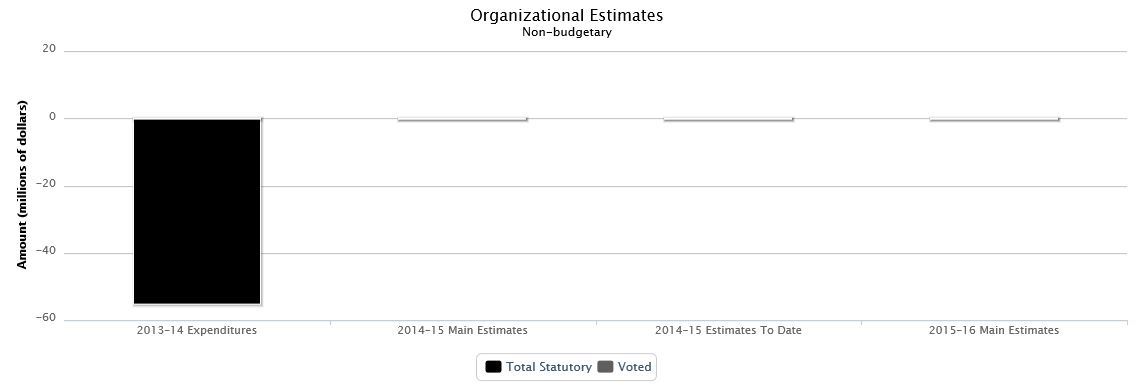
| 2013–14 Expenditures | 2014–15 Main Estimates | 2014–15 Estimates To Date | 2015–16 Main Estimates | ||
|---|---|---|---|---|---|
| Budgetary | |||||
| Voted | |||||
| 1 | Program expenditures | 4,456,273 | 3,610,936 | 3,610,936 | 3,605,377 |
| Total voted | 4,456,273 | 3,610,936 | 3,610,936 | 3,605,377 | |
| Total budgetary | 4,456,273 | 3,610,936 | 3,610,936 | 3,605,377 | |
| Non-budgetary | |||||
| Total Statutory | (54,968,445) | 0 | 0 | 0 | |
| Total non-budgetary | (54,968,445) | 0 | 0 | 0 | |
Highlights
The Canadian milk supply management system rests on three pillars: production management, price setting and import controls. The CDC is directly involved in the administration of two of the three pillars (production management and price setting) via the establishment of industrial milk quota and support price.
The CDC administers the three revenue pooling and market sharing pools that exist among milk producers. Monthly, the CDC receives data from provincial milk marketing boards and calculates the payment transfers between provinces to equalize returns and adjusts quota allocations to provinces to account for the sharing of markets.
To ensure a steady supply of dairy products on the Canadian market, the CDC operates the Domestic Seasonality Programs. To ensure that milk components for which there is no outlet on the domestic market are removed in a timely fashion, the CDC operates the Surplus Removal Program. The CDC operates two programs related to innovation: the Dairy Marketing Program and the Dairy Innovation Program.
In addition, the CDC, on the industry's behalf, administers the Special Milk Class Permit Program (SMCPP) and the Planned Export Program for Cheese. The parameters of these programs are decided by the industry.
The CDC imports the tariff rate quota of butter and sells this butter to participants in the SMCPP through butter manufacturers. Profits that the CDC generates by this activity are used to finance initiatives that provide benefits to the industry. Examples of these initiatives are graduate scholarships in Canadian establishments and the Dairy Research Cluster.
The CDC also controls the subsidized exports of Canadian dairy products through the issuance of export permits. This permit system has been put in place to ensure that Canadian exports of dairy products do not exceed the limits imposed on Canada by the World Trade Organization for subsidized exports.
No significant changes are expected in the programs that the CDC administers in fiscal year 2015–16. Further details can be found in the Canadian Dairy Commission's Corporate Plan.
Expenditures by Strategic Outcome and Program
| 2013–14 Expenditures | 2014–15 Main Estimates | 2015–16 Main Estimates | |
|---|---|---|---|
| To enhance the vitality of the Canadian dairy industry for the benefit of all stakeholders. | |||
| Administer milk supply management system | 4,456,273 | 3,610,936 | 3,605,377 |
| Total | 4,456,273 | 3,610,936 | 3,605,377 |
Canadian Environmental Assessment Agency
Raison d'être
The Minister of the Environment is responsible for this organization.
Environmental assessment contributes to informed decision making in support of sustainable development.
The Canadian Environmental Assessment Agency delivers high-quality environmental assessments in support of government decisions about major projects.
Additional information can be found in the Agency's Report on Plans and Priorities.
Organizational Estimates
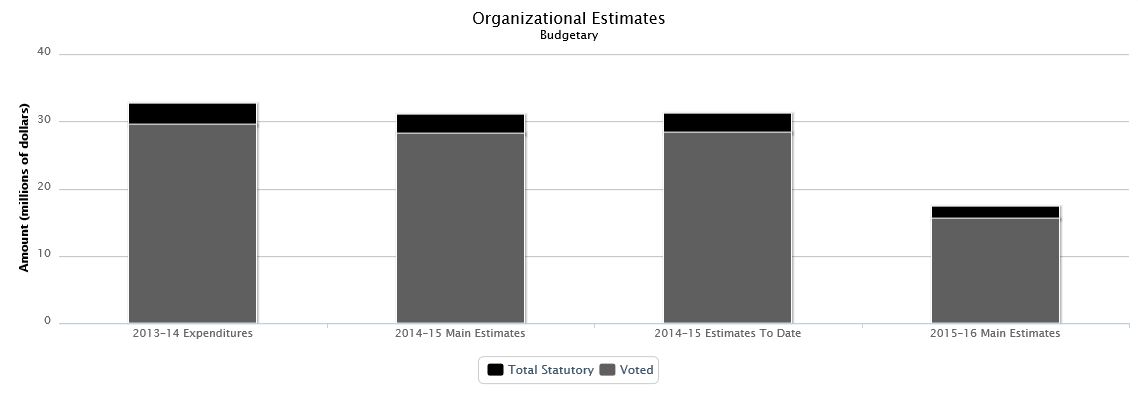
| 2013–14 Expenditures | 2014–15 Main Estimates | 2014–15 Estimates To Date | 2015–16 Main Estimates | ||
|---|---|---|---|---|---|
| Budgetary | |||||
| Voted | |||||
| 1 | Program expenditures | 29,571,920 | 28,227,786 | 28,349,997 | 15,591,619 |
| Total voted | 29,571,920 | 28,227,786 | 28,349,997 | 15,591,619 | |
| Total Statutory | 3,056,560 | 2,736,320 | 2,753,162 | 1,760,251 | |
| Total budgetary | 32,628,480 | 30,964,106 | 31,103,159 | 17,351,870 | |
Highlights
In support of its strategic outcome: high-quality and timely environmental assessments of major projects to protect the environment and support economic growth, the Canadian Environmental Assessment Agency works towards achieving the following organizational priorities:
- Delivering high-quality environmental assessments of major projects;
- Building effective relationships with Aboriginal peoples; and,
- Playing a lead role in shaping the future of federal environmental assessment.
The Canadian Environmental Assessment Agency's 2015–16 Main Estimates of $17.4 million are $13.6 million less than the 2014–15 Main Estimates. The difference is mainly attributable to the sunsetting of funds to improve Canadaʼs regulatory framework for major resource projects and Aboriginal consultation. These sunsetting programs are subject to government decisions as part of the budget process. Outcomes of such decisions will be reflected in the Agencyʼs future budget exercises and Estimates documents.
Expenditures by Strategic Outcome and Program
| 2013–14 Expenditures | 2014–15 Main Estimates | 2015–16 Main Estimates | |
|---|---|---|---|
| High quality and timely environmental assessments of major projects to protect the environment and support economic growth. | |||
| Environmental Assessment Delivery Program | 18,016,837 | 17,032,000 | 9,476,761 |
| Environmental Assessment Policy Program | 4,351,344 | 4,871,106 | 3,117,153 |
| The following program supports all strategic outcomes within this organization. | |||
| Internal Services | 10,260,299 | 9,061,000 | 4,757,956 |
| Total | 32,628,480 | 30,964,106 | 17,351,870 |
Listing of the 2015–16 Transfer Payments
| 2013–14 Expenditures | 2014–15 Main Estimates | 2015–16 Main Estimates | |
|---|---|---|---|
| Contributions | |||
| Contributions for the support of public participation in the environmental assessment review process – Participant Funding Program | 2,518,323 | 4,469,500 | 1,469,000 |
| Contribution to the Province of Quebec – James Bay and Northern Quebec Agreement | 245,500 | 245,500 | 246,000 |
Canadian Food Inspection Agency
Raison d'être
The Minister of Health is responsible for this organization.
The Canadian Food Inspection Agency (CFIA) is Canadaʼs largest science-based regulatory agency. It has approximately 7,120 employees working across Canada, in the National Capital Region (NCR) and in four operational areas (Atlantic, Quebec, Ontario and Western).
The CFIA is dedicated to safeguarding food, animal and plant health, which enhances the health and well-being of Canadaʼs people, environment, and economy.
CFIA develops and delivers inspection and other services to:
- prevent and manage food safety risks;
- protect plant resources from pests, diseases and invasive species;
- prevent and manage animal and zoonotic diseases;
- contribute to consumer protection; and,
- contribute to market access for Canadaʼs food, plants, and animals.
CFIA bases its activities on science, effective management of risk, commitment to service and efficiency, and collaboration with domestic and international organizations that share its objectives.
Organizational Estimates
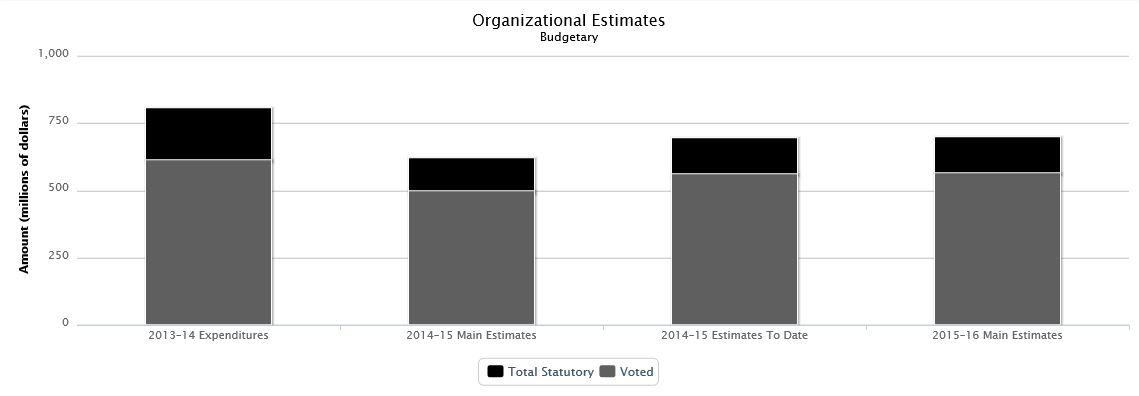
| 2013–14 Expenditures | 2014–15 Main Estimates | 2014–15 Estimates To Date | 2015–16 Main Estimates | ||
|---|---|---|---|---|---|
| Budgetary | |||||
| Voted | |||||
| 1 | Operating expenditures and contributions | 590,256,209 | 470,029,881 | 533,904,277 | 537,749,431 |
| 5 | Capital expenditures | 21,464,985 | 24,264,263 | 25,471,966 | 25,783,194 |
| Total voted | 611,721,194 | 494,294,144 | 559,376,243 | 563,532,625 | |
| Total Statutory | 194,030,459 | 125,033,591 | 132,490,669 | 134,619,263 | |
| Total budgetary | 805,751,653 | 619,327,735 | 691,866,912 | 698,151,888 | |
Highlights
Mitigating risks to food safety is the CFIA's highest priority. Safeguarding the health and well-being of Canada's people, environment, and economy is the driving force behind the design and development of the CFIA's programs. The CFIA, in collaboration and partnership with industry, consumers, universities, and federal, provincial and municipal organizations, continues to work towards protecting Canadians from preventable health risks related to food and zoonotic diseases.
The CFIA works with its partners to implement food safety measures; manage food, animal, and plant risks, incidents and emergencies; and promotes the development of food safety and disease control systems to maintain the safety of Canada's high-quality agriculture, agri-food, aquaculture and fishery products. The CFIA's activities include verifying the compliance of imported products; registering and inspecting establishments; testing food, animals, plants, and their related products; and approving the use of many agricultural inputs.
The 2015–16 Main Estimates for the CFIA total $698.2 million, an increase of $78.9 million from the 2014–15 Main Estimates of $619.3 million. The major items included in this increase are:
- An increase of $36.9 million related to the renewal of resources to continue a comprehensive strategy for managing Bovine Spongiform Encephalopathy (BSE) in Canada;
- An increase of $19.1 million in new resources to strengthen Canada's food safety oversight system;
- An increase of $12.4 million of renewed resources to support the increased frequency of food inspections in meat processing establishments;
- An increase of $11.1 million for collective bargaining;
- An increase of $3.8 million of new resources to assist in the establishment of a Food Safety Information Network that will strengthen Canada's ability to detect and respond to food hazards; and,
- An increase of $1.0 million in incremental funding to support the inspection verification teams to oversee the performance of the food safety system.
These increases are offset by:
- A decrease of $3.1 million for various initiatives including funding for the Food Safety Modernization, Single Window Initiative and Trusted Traders and Trusted Travellers program; and,
- A decrease of $2.3 million for the transfer of resources and responsibilities to other government departments and agencies, such as the consolidation of pay services in Public Works and Government Services Canada, centralization of the support of the Canada Agricultural Review Tribunal with the Administrative Tribunals Support Service of Canada, etc.
The 2014–15 Estimates to Date are approximately $72.5 million higher than the 2014–15 Main Estimates. This increase can be explained by resources received via Supplementary Estimates (B) and (C), which were approved by Parliament.
Expenditures by Strategic Outcome and Program
| 2013–14 Expenditures | 2014–15 Main Estimates | 2015–16 Main Estimates | |
|---|---|---|---|
| A safe and accessible food supply and plant and animal resource base. | |||
| Food Safety Program | 364,310,526 | 320,103,652 | 362,958,350 |
| Animal Health and Zoonotics Program | 187,939,265 | 89,781,512 | 113,659,211 |
| Plant Resources Program | 86,537,965 | 75,006,452 | 76,204,256 |
| International Collaboration and Technical Agreements | 35,004,557 | 25,382,494 | 30,000,919 |
| The following program supports all strategic outcomes within this organization. | |||
| Internal Services | 131,959,340 | 109,053,625 | 115,329,152 |
| Total | 805,751,653 | 619,327,735 | 698,151,888 |
Listing of the 2015–16 Transfer Payments
| 2013–14 Expenditures | 2014–15 Main Estimates | 2015–16 Main Estimates | |
|---|---|---|---|
| Contributions | |||
| Contributions in support of the Federal Assistance Program | 2,125,075 | 707,000 | 819,000 |
| Contributions to the provinces in accordance with the Rabies Indemnification Regulations of the Governor in Council of amounts not exceeding two-fifths of the amounts paid by the provinces to owners of animals dying as a result of rabies infection | 1,200 | 112,000 | 0 |
| Total Statutory | 58,292,634 | 3,500,000 | 3,500,000 |
Canadian Grain Commission
Raison d'être
The Canadian Grain Commission (CGC) is a federal government agency that administers the provisions of the Canada Grain Act (CGA). The CGCʼs mandate as set out in the CGA is to, in the interests of the grain producers, establish and maintain standards of quality for Canadian grain and regulate grain handling in Canada, to ensure a dependable commodity for domestic and export markets. CGCʼs vision is "To be a world class science-based quality assurance provider". The Minister of Agriculture and Agri-Food is responsible for the CGC.
Organizational Estimates
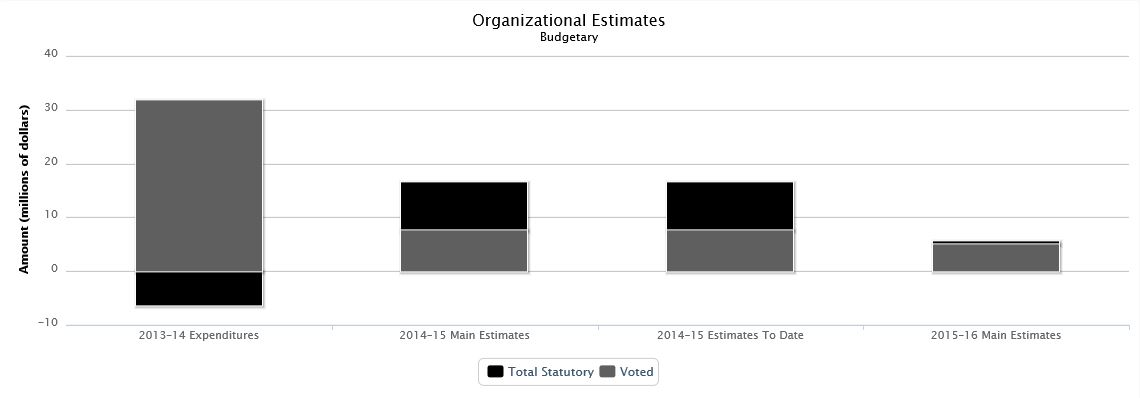
| 2013–14 Expenditures | 2014–15 Main Estimates | 2014–15 Estimates To Date | 2015–16 Main Estimates | ||
|---|---|---|---|---|---|
| Budgetary | |||||
| Voted | |||||
| 1 | Program expenditures | 31,813,439 | 7,537,076 | 7,537,076 | 4,883,698 |
| Total voted | 31,813,439 | 7,537,076 | 7,537,076 | 4,883,698 | |
| Total Statutory | (6,459,461) | 8,846,818 | 8,846,818 | 591,479 | |
| Total budgetary | 25,353,978 | 16,383,894 | 16,383,894 | 5,475,177 | |
Highlights
The CGC is estimating budgetary expenditures of $5.5 million in 2015–16. Of this amount, $4.9 million requires approval by Parliament. The remaining $0.6 million is to support employee benefit plan obligations.
The decrease in net authority of $19.9 million from 2013–14 Public Accounts is primarily due to:
- the decrease of $12.6 million to support employee termination benefits
- the decrease of $16.8 million to transition the CGC to a sustainable funding model as identified in Budget 2012, and
- the increase of $10 million of revolving fund surplus which is primarily due to the handling of increased grain volumes and updated user fees came into force on .
The decrease in net authority of $10.9 million from 2014–15 Main Estimates is due to:
- the decrease of $3.0 million to support employee termination benefits, and
- the decrease in access to the CGC revolving fund surplus of $7.9 million for severance obligations.
The current CGC funding structure is based on budgetary authorities that are comprised of both statutory and voted authorities. The statutory authorities include employee benefit plan authority for appropriation funded positions and the CGC revolving fund authority which allows the CGC to re-spend fees that it has collected. The voted authority is Vote 1 – Program Expenditures which includes annual appropriation authority and any ad hoc appropriation authority for the fiscal year.
A revolving fund was set up for the CGC in 1995 with the expectation that the CGC would be largely self-funded through fees for service. The CGC transitioned to a new fee structure in 2013–14. Updated user fees came into effect on . The new fee structure is expected to eliminate the requirement for annual ad hoc funding going forward. Revenues are expected to be $55.0 million in 2015–16.
Additional information can be found in the CGC's Reports on Plans and Priorities.
Expenditures by Strategic Outcome and Program
| 2013–14 Expenditures | 2014–15 Main Estimates | 2015–16 Main Estimates | |
|---|---|---|---|
| Canada's grain is safe, reliable and marketable and Canadian grain producers are properly compensated for grain deliveries to licensed grain companies. | |||
| Grain Quality Research Program | 12,091,194 | 6,666,018 | 5,230,177 |
| Quality Assurance Program | (7,813,215) | 6,140,408 | 0 |
| Quantity Assurance Program | 2,844,418 | 1,529,609 | 0 |
| Producer Protection Program | 2,501,985 | 278,359 | 0 |
| The following program supports all strategic outcomes within this organization. | |||
| Internal Services | 15,729,596 | 1,769,500 | 245,000 |
| Total | 25,353,978 | 16,383,894 | 5,475,177 |
Canadian Heritage
Raison d'être
The Minister of Canadian Heritage and Official Languages is responsible for this organization.
The Department of Canadian Heritage and Canadaʼs major national cultural institutions play a vital role in the cultural, civic and economic life of Canadians. We work together to support culture, arts, heritage, official languages, citizenship and participation, in addition to Aboriginal, youth, and sport initiatives.
Organizational Estimates
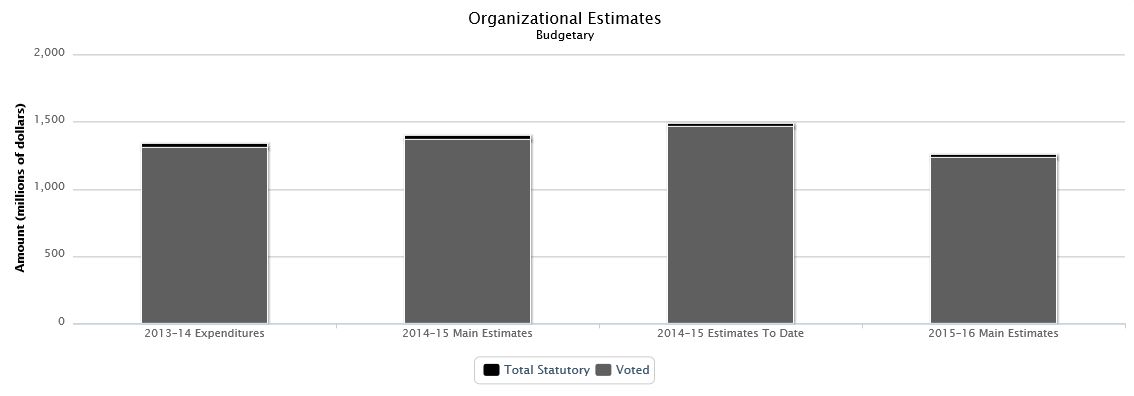
| 2013–14 Expenditures | 2014–15 Main Estimates | 2014–15 Estimates To Date | 2015–16 Main Estimates | ||
|---|---|---|---|---|---|
| Budgetary | |||||
| Voted | |||||
| 1 | Operating expenditures | 174,774,392 | 178,337,991 | 183,512,711 | 173,741,400 |
| 5 | Grants and contributions | 1,130,800,471 | 1,187,709,835 | 1,274,673,254 | 1,056,279,039 |
| Total voted | 1,305,574,863 | 1,366,047,826 | 1,458,185,965 | 1,230,020,439 | |
| Total Statutory | 25,996,267 | 24,002,161 | 24,013,420 | 24,676,122 | |
| Total budgetary | 1,331,571,130 | 1,390,049,987 | 1,482,199,385 | 1,254,696,561 | |
Highlights
The Department of Canadian Heritage is estimating budgetary expenditures of $1.25 billion in 2015–16. Of this amount, $1.23 billion requires approval by Parliament. The remaining $24.7 million represents statutory forecasts that do not require additional approval and are provided for information purposes. This is a decrease of $135.4 million when compared to the 2014–15 Main Estimates.
The net decrease is a combination of a decrease of $4.6 million in Vote 1 (Operating expenditures), a decrease of $131.4 million in Vote 5 (Grants and contributions) and an increase of $0.7 million in statutory forecasts.
The decrease of $4.6 million in Vote 1 is mainly due to:
- An increase of $7.2 million for the government advertising programs – Canada 150 Campaign;
- A decrease of $1.5 million for the transfer between Votes for the continued support of the Language Rights Support Program;
- A decrease of $2.1 million for the Capital Experience Program related to a reprofile of funds for the Sound and light show;
- A decrease of $1.6 million for the transfer of funding and responsibilities for the Canadian Cultural Property Expert Review Board to the Administrative Tribunals Support Service of Canada; and,
- A decrease of $6.1 million for the transfer of funding and responsibilities for the Virtual Museum of Canada to the Canadian Museum of History.
The decrease of $131.4 million in Vote 5 is mainly due to:
- An increase of $16.0 million for the celebration of Canada's 150th anniversary of Confederation – Road to 2017;
- An increase of $4.9 million for the Aboriginal Peoples' Program – Aboriginal Languages Initiative;
- An increase of $2.8 million for the Sport Support Program – Special Olympics Canada;
- An increase of $2.0 million for the Cultural Strategy for the Toronto 2015 Pan and Parapan American Games due to a reprofile of funds;
- An increase of $1.5 million for the transfer between Votes for the continued support of the Language Rights Support Program;
- A decrease of $2.1 million for the transfer of the funding and responsibilities for the Online Works of Reference to the Canadian Museum of History; and,
- A decrease of $156.4 million for the Toronto 2015 Pan American and Parapan American Games.
For further details regarding Canadian Heritage, its operations and its use of funds, please refer to the 2015–16 Reports on Plans and Priorities.
Expenditures by Strategic Outcome and Program
| 2013–14 Expenditures | 2014–15 Main Estimates | 2015–16 Main Estimates | |
|---|---|---|---|
| Canadians share, express and appreciate their Canadian identity. | |||
| Official Languages | 352,514,946 | 353,135,274 | 353,365,541 |
| Attachment to Canada | 67,495,358 | 64,436,036 | 86,572,642 |
| Engagement and Community Participation | 45,116,329 | 44,583,276 | 48,361,058 |
| Canadian artistic expressions and cultural content are created and accessible at home and abroad. | |||
| Cultural Industries | 303,493,423 | 302,346,433 | 302,493,050 |
| Arts | 113,350,742 | 116,604,709 | 116,713,634 |
| Heritage | 38,187,915 | 39,577,341 | 29,785,074 |
| Canadians participate and excel in sport. | |||
| Sport | 334,086,513 | 398,057,989 | 243,877,515 |
| The following program supports all strategic outcomes within this organization. | |||
| Internal Services | 77,325,904 | 71,308,929 | 73,528,047 |
| Total | 1,331,571,130 | 1,390,049,987 | 1,254,696,561 |
Listing of the 2015–16 Transfer Payments
| 2013–14 Expenditures | 2014–15 Main Estimates | 2015–16 Main Estimates | |
|---|---|---|---|
| Grants | |||
| Grants to the Canada Periodical Fund | 67,847,089 | 72,775,054 | 72,775,054 |
| Grants in support of the Development of Official-Language Communities Program | 7,130,253 | 33,322,973 | 33,322,973 |
| Grants to the Athlete Assistance Program | 26,345,000 | 28,000,000 | 28,000,000 |
| Grants to the Canada Cultural Investment Fund | 19,038,432 | 19,038,432 | 20,000,000 |
| Grants in support of the Building Communities through Arts and Heritage Program | 9,406,063 | 14,355,000 | 14,355,000 |
| Grants to the Canada Arts Presentation Fund | 9,193,250 | 10,500,000 | 13,500,000 |
| Grants to the Canada Book Fund | 1,708,238 | 8,300,000 | 8,300,000 |
| Grants in support of the Celebration and Commemoration Program | 5,560,248 | 8,000,000 | 8,300,000 |
| Grant to TV5 Monde | 7,519,570 | 8,000,000 | 8,000,000 |
| Grants in support of the Enhancement of Official Languages Program | 529,654 | 5,599,842 | 5,599,842 |
| Grants to the Canada Cultural Spaces Fund | 1,471,027 | 3,000,000 | 5,000,000 |
| Grants under the Museums Assistance Program | 2,530,453 | 4,663,680 | 4,663,680 |
| Grants to the Canada Music Fund | 0 | 2,000,000 | 2,000,000 |
| Grants to support the Aboriginal Peoplesʼ Program | 100,310 | 1,340,000 | 1,340,000 |
| Grants in support of the Canada History Fund | 0 | 1,150,060 | 1,150,060 |
| Grants to the Lieutenant-Governors of the provinces of Canada toward defraying the costs incurred in the exercise of their duties: | |||
| Quebec | 147,372 | 147,372 | 147,372 |
| Ontario | 105,627 | 105,627 | 105,627 |
| British Columbia | 97,814 | 97,814 | 97,814 |
| Newfoundland and Labrador | 77,590 | 77,590 | 77,590 |
| Alberta | 75,940 | 75,940 | 75,940 |
| Manitoba | 73,762 | 73,762 | 73,762 |
| Saskatchewan | 73,758 | 73,758 | 73,758 |
| Nova Scotia | 64,199 | 64,199 | 64,199 |
| New Brunswick | 62,947 | 62,947 | 62,947 |
| Prince Edward Island | 57,071 | 57,071 | 57,071 |
| Grants in support of Innovative Youth Exchange Projects | 20,000 | 100,000 | 100,000 |
| Total Statutory | 1,058,800 | 819,000 | 819,000 |
| Contributions | |||
| Contributions in support of the Development of Official-Language Communities Program | 210,862,596 | 191,099,017 | 192,599,017 |
| Contributions for the Sport Support Program | 150,448,635 | 142,815,064 | 143,315,064 |
| Contributions to support the Canada Media Fund | 134,146,077 | 134,146,077 | 134,146,077 |
| Contributions in support of the Enhancement of Official Languages Program | 117,582,551 | 105,923,289 | 105,923,289 |
| Contributions for the Hosting Program | 142,844,052 | 213,752,765 | 59,625,790 |
| Contributions to the Canada Book Fund | 34,943,918 | 28,366,301 | 28,366,301 |
| Contributions to the Canada Arts Training Fund | 22,620,000 | 22,779,440 | 22,779,440 |
| Contributions to the Canada Music Fund | 23,547,884 | 21,939,231 | 22,299,231 |
| Contributions to the Canada Cultural Spaces Fund | 23,608,376 | 22,508,613 | 20,358,613 |
| Contributions in support of the Celebration and Commemoration Program | 10,961,419 | 2,494,367 | 20,194,367 |
| Contributions to the Canada Arts Presentation Fund | 19,550,438 | 18,472,742 | 18,477,742 |
| Contributions in support of the Exchanges Canada Initiative | 17,825,216 | 17,686,359 | 17,686,359 |
| Contributions to support the Aboriginal Peoplesʼ Program | 15,680,383 | 11,514,078 | 16,209,757 |
| Contributions under the Museums Assistance Program | 12,578,276 | 11,076,284 | 11,076,284 |
| Contributions in support of the Building Communities through Arts and Heritage Program | 8,387,727 | 3,300,000 | 3,300,000 |
| Contributions to TV5 | 5,159,974 | 2,960,900 | 2,960,900 |
| Contributions in support of the Canada History Fund | 5,115,737 | 5,037,330 | 2,887,330 |
| Contributions to the Canada Periodical Fund | 5,277,290 | 1,999,544 | 1,999,544 |
| Contributions to the Canada Cultural Investment Fund | 2,929,002 | 2,993,273 | 1,972,205 |
| Contributions to support the Youth Take Charge Program | 3,636,180 | 1,453,023 | 1,453,023 |
| Contributions in support of the Court Challenges Program | 204,678 | 1,406,017 | 1,406,017 |
Canadian Human Rights Commission
Raison d'être
The Minister of Justice and Attorney General of Canada is responsible for this organization.
The Canadian Human Rights Commission (the Commission) was established in 1977 under Schedule I.1 of the Financial Administration Act in accordance with the Canadian Human Rights Act (CHRA). The Commission leads the administration of the CHRA and ensures compliance with the Employment Equity Act (EEA). The CHRA prohibits discrimination and the EEA promotes equality in the workplace. Both laws apply the principles of equal opportunity and non-discrimination to federal government departments and agencies, Crown corporations, and federally regulated private sector organizations.
Organizational Estimates
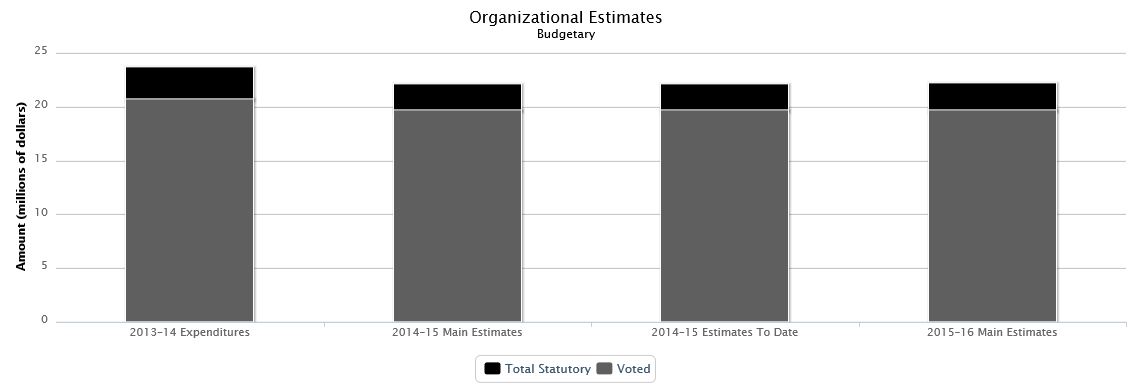
| 2013–14 Expenditures | 2014–15 Main Estimates | 2014–15 Estimates To Date | 2015–16 Main Estimates | ||
|---|---|---|---|---|---|
| Budgetary | |||||
| Voted | |||||
| 1 | Program expenditures | 20,700,058 | 19,639,234 | 19,639,234 | 19,650,241 |
| Total voted | 20,700,058 | 19,639,234 | 19,639,234 | 19,650,241 | |
| Total Statutory | 2,973,592 | 2,460,492 | 2,460,492 | 2,512,177 | |
| Total budgetary | 23,673,650 | 22,099,726 | 22,099,726 | 22,162,418 | |
Highlights
The Commission is estimating budgetary expenditures of $22.2 million in 2015–16. Of this amount, $19.7 million requires approval by Parliament. The remaining $2.5 million represents statutory forecasts that do not require additional approval and are provided for information purposes.
The variance between 2013–14 expenditures and 2014–15 Main Estimates is mainly due to the fact that since 2009–10, the Commission has received and spent additional funding for the repeal of Section 67 of the CHRA. This funding ended in . The Commissionʼs planned spending will remain stable in 2014–15 and 2015–16.
Over the next year, the Commission will focus on:
- Developing and implementing initiatives to foster reconciliation in collaboration with Indigenous peoples and other human rights commissions in Canada;
- Working with stakeholders to identify strategies to remove barriers to access to justice for the most vulnerable, and exploring options to facilitate access to its complaints process; and
- Continuing to transform its operations by implementing a digital strategy and by contributing to the government-wide business initiatives.
Further details can be found in the Commission's Report on Plans and Priorities.
Expenditures by Strategic Outcome and Program
| 2013–14 Expenditures | 2014–15 Main Estimates | 2015–16 Main Estimates | |
|---|---|---|---|
| Equality of opportunity and respect for human rights. | |||
| Human Rights Program | 0 | 0 | 14,645,923 |
| The following program supports all strategic outcomes within this organization. | |||
| Internal Services | 6,448,023 | 5,942,226 | 7,516,495 |
| Funds not allocated to the 2015–16 Program Alignment Architecture | 17,225,627 | 16,157,500 | 0 |
| Total | 23,673,650 | 22,099,726 | 22,162,418 |
Canadian Human Rights Tribunal
Raison d'être
Pursuant to the Administrative Tribunals Support Service of Canada Act, the Canadian Human Rights Tribunal was amalgamated to the Administrative Tribunals Support Service of Canada, effective .
Organizational Estimates
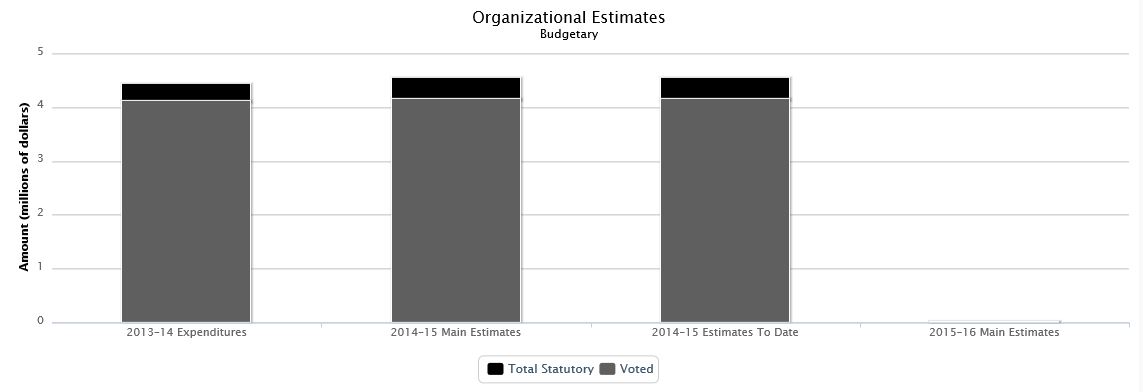
| 2013–14 Expenditures | 2014–15 Main Estimates | 2014–15 Estimates To Date | 2015–16 Main Estimates | ||
|---|---|---|---|---|---|
| Budgetary | |||||
| Voted | |||||
| - | Program expenditures | 4,114,662 | 4,145,232 | 4,145,232 | 0 |
| Total voted | 4,114,662 | 4,145,232 | 4,145,232 | 0 | |
| Total Statutory | 315,764 | 387,293 | 387,293 | 0 | |
| Total budgetary | 4,430,426 | 4,532,525 | 4,532,525 | 0 | |
Highlights
Not applicable
Expenditures by Strategic Outcome and Program
| 2013–14 Expenditures | 2014–15 Main Estimates | 2015–16 Main Estimates | |
|---|---|---|---|
| Individuals have access, as determined by the Canadian Human Rights Act and the Employment Equity Act, to fair and equitable adjudication of human rights and employment equity cases that are brought before the Canadian Human Rights Tribunal. | |||
| Hearings of complaints before the Tribunal | 2,098,767 | 2,589,784 | 0 |
| The following program supports all strategic outcomes within this organization. | |||
| Internal Services | 2,331,659 | 1,942,741 | 0 |
| Total | 4,430,426 | 4,532,525 | 0 |
Canadian Institutes of Health Research
Raison d'être
Canadian Institutes of Health Research (CIHR) is the Government of Canada's health research funding agency. The Minister of Health is responsible for this organization. It was created in by the Canadian Institutes of Health Research Act (Bill C-13) with a mandate "to excel, according to internationally accepted standards of scientific excellence, in the creation of new knowledge and its translation into improved health for Canadians, more effective health services and products and a strengthened Canadian health care system."
CIHR was designed to respond to evolving needs for health research and seeks to transform health research in Canada in an ethically sound manner by:
- Funding both investigator-initiated research, and research on targeted priority areas;
- Building research capacity in under-developed areas and training the next generation of health researchers; and
- Focusing on knowledge translation that facilitates the application of the results of research and their transformation into new policies, practices, procedures, products and services.
Organizational Estimates
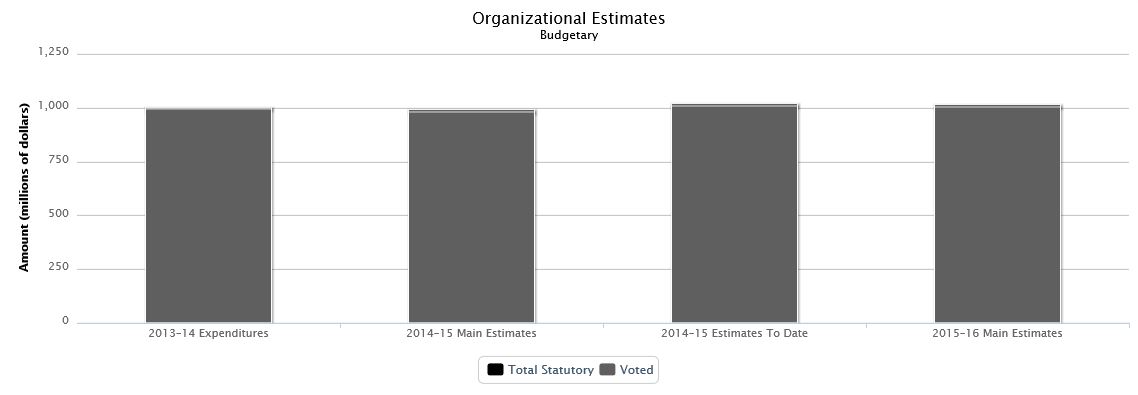
| 2013–14 Expenditures | 2014–15 Main Estimates | 2014–15 Estimates To Date | 2015–16 Main Estimates | ||
|---|---|---|---|---|---|
| Budgetary | |||||
| Voted | |||||
| 1 | Operating expenditures | 48,129,248 | 47,112,396 | 47,112,396 | 47,463,563 |
| 5 | Grants | 943,955,266 | 932,143,424 | 960,200,961 | 955,287,128 |
| Total voted | 992,084,514 | 979,255,820 | 1,007,313,357 | 1,002,750,691 | |
| Total Statutory | 5,887,474 | 5,696,142 | 5,696,142 | 5,833,308 | |
| Total budgetary | 997,971,988 | 984,951,962 | 1,013,009,499 | 1,008,583,999 | |
Highlights
CIHR is estimating planned expenditures of $1,008.6 million in 2015–16. Of this amount, $1,002.8 million requires approval by Parliament. The remaining $5.8 million represents statutory forecasts that do not require additional approval and are provided for information purposes.
The planned expenditures of $1,008.6 million in 2015–16 represent an increase of $23.6 million, or 2.4%, from the 2014–15 Main Estimates of $985 million.
The $23.6 million increase is mainly due to the following:
- A $15 million permanent increase as a result of Budget 2014 for the expansion of Strategy for Patient-Oriented Research, the creation of the Canadian Consortium on Neurodegeneration in Aging and to support other health research priorities;
- A $8.9 million increase to the Tri-Agency Centres of Excellence for Commercialization and Research program resulting from the 2015 competition in order for CIHR to partially fund 5 Centres in collaboration with the Natural Sciences and Engineering Research Council and the Social Sciences and Humanities Research Council;
- A $1.4 million increase to the Tri-Agency Canada Excellence Research Chairs program in order for CIHR to fund one (of the six Chairs) from the recent competition; and,
- A $1 million increase to address prescription drug abuse under the federal government's National Anti-Drug Strategy.
The remaining variance of $2.7 million results from funds received from other departments for partnerships activities ending in 2014–15 and various other program funding adjustments.
Further details on CIHR's 2015–16 planned spending is available in CIHR's 2015–16 Report on Plans and Priorities.
Expenditures by Strategic Outcome and Program
| 2013–14 Expenditures | 2014–15 Main Estimates | 2015–16 Main Estimates | |
|---|---|---|---|
| Canada is a world leader in the creation, dissemination and application of health research knowledge. | |||
| Investigator-Initiated Health Research | 0 | 729,381,763 | 702,437,354 |
| Priority-Driven Health Research | 0 | 252,550,887 | 294,098,401 |
| The following program supports all strategic outcomes within this organization. | |||
| Internal Services | 26,527,955 | 3,019,312 | 12,048,244 |
| Funds not allocated to the 2015–16 Program Alignment Architecture | 971,444,033 | 0 | 0 |
| Total | 997,971,988 | 984,951,962 | 1,008,583,999 |
Listing of the 2015–16 Transfer Payments
| 2013–14 Expenditures | 2014–15 Main Estimates | 2015–16 Main Estimates | |
|---|---|---|---|
| Grants | |||
| Grants for research projects and personnel support | 854,080,958 | 853,303,075 | 866,509,031 |
| Networks of Centres of Excellence | 22,589,000 | 22,589,400 | 22,589,400 |
| Canada Graduate Scholarships | 21,089,368 | 21,250,000 | 21,250,000 |
| Institute support grants | 13,000,000 | 13,000,000 | 13,000,000 |
| Centres of Excellence for Commercialization and Research | 12,054,160 | 1,880,000 | 10,829,947 |
| Canada Excellence Research Chairs | 8,249,999 | 8,400,000 | 9,800,000 |
| Vanier Canada Graduate Scholarships | 8,245,833 | 8,350,000 | 8,350,000 |
| Business–Led Networks of Centres of Excellence | 4,340,132 | 3,106,027 | 2,798,750 |
| Industrial Research Chairs for Colleges | 160,000 | 160,000 | 160,000 |
Canadian Intergovernmental Conference Secretariat
Raison d'être
The President of the Queen's Privy Council for Canada is responsible for this organization. The Canadian Intergovernmental Conference Secretariat (CICS), established pursuant to an agreement reached at the First Ministers' Conference, is an agency of the federal, provincial and territorial governments. Its mandate is to provide administrative support and planning services for intergovernmental conferences of First Ministers, Ministers and Deputy Ministers.
These intergovernmental conferences are a key instrument for consultation and negotiation among the different orders of governments and assist in the development of national and/or provincial/territorial policies. They are a critical component of the workings of the Canadian federation and represent a core principle of our democratic society.
By skilfully executing the logistical planning and delivery of these meetings, CICS not only relieves governments of the administrative process burden but also allows them to greatly benefit from significant cost efficiencies and economies of scale.
Organizational Estimates
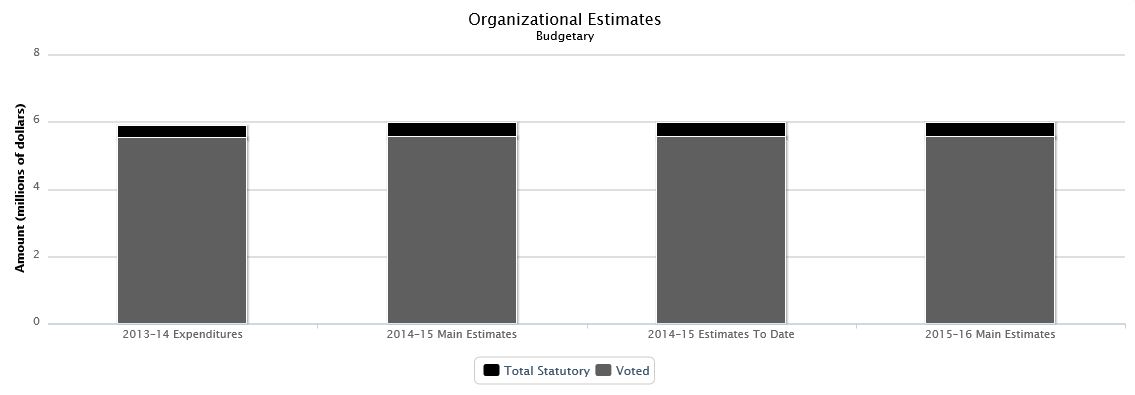
| 2013–14 Expenditures | 2014–15 Main Estimates | 2014–15 Estimates To Date | 2015–16 Main Estimates | ||
|---|---|---|---|---|---|
| Budgetary | |||||
| Voted | |||||
| 1 | Program expenditures | 5,515,380 | 5,548,958 | 5,548,958 | 5,549,653 |
| Total voted | 5,515,380 | 5,548,958 | 5,548,958 | 5,549,653 | |
| Total Statutory | 349,501 | 408,205 | 408,205 | 417,888 | |
| Total budgetary | 5,864,881 | 5,957,163 | 5,957,163 | 5,967,541 | |
Highlights
CICS's 2015–16 expenditures remain approximately the same as the previous year. The 2015–16 funding will be utilized to address the following priorities:
- Implement the necessary initiatives to enhance and expand strategic partnerships;
- Adopt the appropriate tools to transform the service delivery model;
- Review and adapt management practices to increase efficiencies; and,
- Continue to build a capable, confident and high performing workforce.
Our 2015–16 Report on Plans and Priorities will contain more details regarding priorities.
Expenditures by Strategic Outcome and Program
| 2013–14 Expenditures | 2014–15 Main Estimates | 2015–16 Main Estimates | |
|---|---|---|---|
| Senior-level intergovernmental conference services are professionally and successfully delivered. | |||
| Conference Services | 3,800,944 | 4,026,878 | 4,141,822 |
| The following program supports all strategic outcomes within this organization. | |||
| Internal Services | 2,063,937 | 1,930,285 | 1,825,719 |
| Total | 5,864,881 | 5,957,163 | 5,967,541 |
Canadian International Development Agency
Raison d'être
Division 12 of Part 3 of the Economic Action Plan 2013 Act, No. 1 states that the Canadian International Development Agency is amalgamated with Foreign Affairs, Trade and Development, effective .
Organizational Estimates
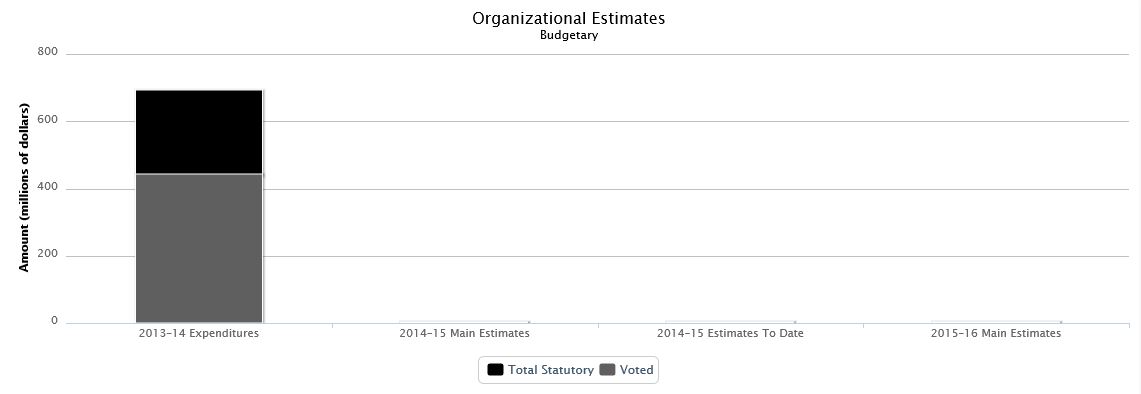
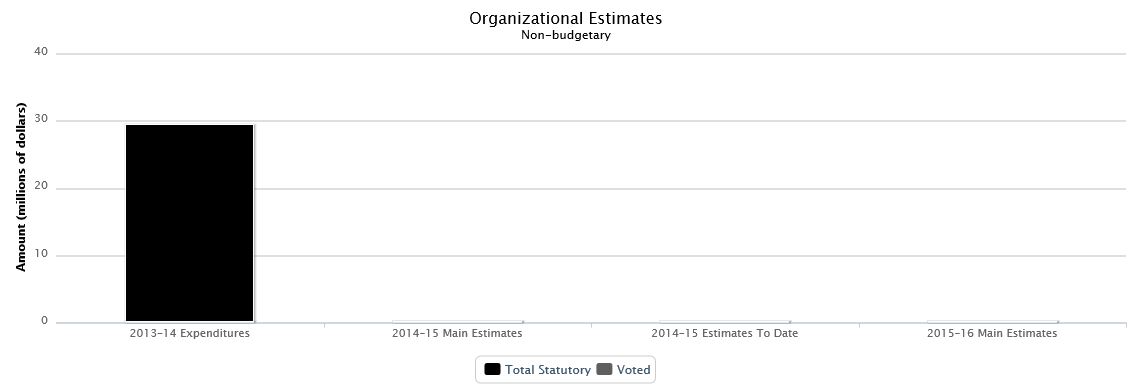
| 2013–14 Expenditures | 2014–15 Main Estimates | 2014–15 Estimates To Date | 2015–16 Main Estimates | ||
|---|---|---|---|---|---|
| Budgetary | |||||
| Voted | |||||
| - | Operating expenditures | 38,221,887 | 0 | 0 | 0 |
| - | Grants and contributions | 404,044,171 | 0 | 0 | 0 |
| Total voted | 442,266,058 | 0 | 0 | 0 | |
| Total Statutory | 250,199,846 | 0 | 0 | 0 | |
| Total budgetary | 692,465,904 | 0 | 0 | 0 | |
| Non-budgetary | |||||
| Total Statutory | 29,291,205 | 0 | 0 | 0 | |
| Total non-budgetary | 29,291,205 | 0 | 0 | 0 | |
Highlights
Not applicable
Expenditures by Strategic Outcome and Program
| 2013–14 Expenditures | 2014–15 Main Estimates | 2015–16 Main Estimates | |
|---|---|---|---|
| Funds not allocated to the 2015–16 Program Alignment Architecture | 692,465,904 | 0 | 0 |
| Total | 692,465,904 | 0 | 0 |
| 2013–14 Expenditures | 2014–15 Main Estimates | 2015–16 Main Estimates | |
|---|---|---|---|
| Funds not allocated to the 2015–16 Program Alignment Architecture | 29,291,205 | 0 | 0 |
| Total | 29,291,205 | 0 | 0 |
Canadian International Trade Tribunal
Raison d'être
Pursuant to the Administrative Tribunals Support of Canada Act, the Canadian International Trade Tribunal was amalgamated to the Administrative Tribunals Support Service of Canada, effective .
Organizational Estimates
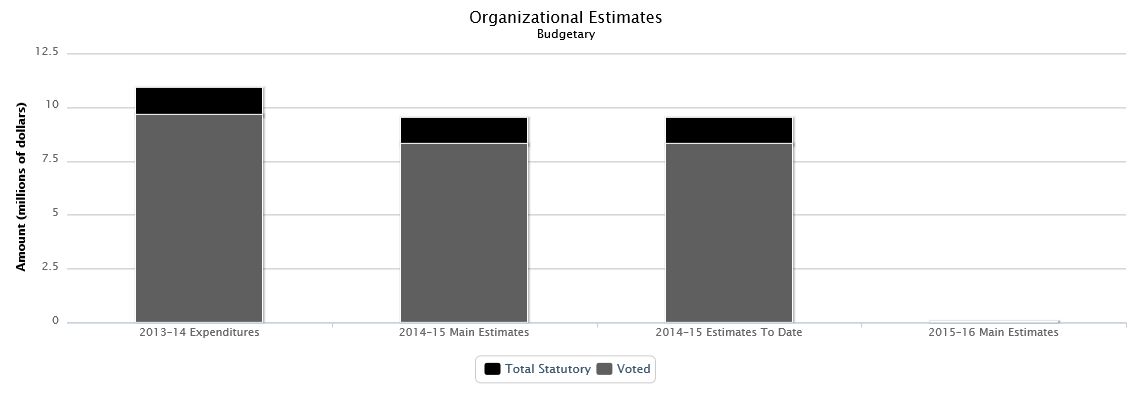
| 2013–14 Expenditures | 2014–15 Main Estimates | 2014–15 Estimates To Date | 2015–16 Main Estimates | ||
|---|---|---|---|---|---|
| Budgetary | |||||
| Voted | |||||
| - | Program expenditures | 9,622,575 | 8,305,445 | 8,305,445 | 0 |
| Total voted | 9,622,575 | 8,305,445 | 8,305,445 | 0 | |
| Total Statutory | 1,273,550 | 1,171,294 | 1,171,294 | 0 | |
| Total budgetary | 10,896,125 | 9,476,739 | 9,476,739 | 0 | |
Highlights
Not applicable
Expenditures by Strategic Outcome and Program
| 2013–14 Expenditures | 2014–15 Main Estimates | 2015–16 Main Estimates | |
|---|---|---|---|
| Fair, timely and transparent disposition of international trade cases, procurement cases and government-mandated inquiries within the Tribunalʼs jurisdiction. | |||
| Adjudication of Trade Cases (quasi-judicial role) | 8,063,133 | 7,012,787 | 0 |
| General Economic Inquiries and References (advisory role) | 108,961 | 94,767 | 0 |
| The following program supports all strategic outcomes within this organization. | |||
| Internal Services | 2,724,031 | 2,369,185 | 0 |
| Total | 10,896,125 | 9,476,739 | 0 |
Canadian Museum for Human Rights
Raison d'être
The Canadian Museum for Human Rights (CMHR) was created in 2008 through an amendment to the Museums Act, which established the Museum as the first national museum to be created since 1967 and the first to be located outside of the National Capital Region. The Museum's mandate is "to explore the subject of human rights, with special but not exclusive reference to Canada, in order to enhance the public's understanding of human rights, to promote respect for others and to encourage reflection and dialogue."
The Minister of Canadian Heritage and Official Languages is responsible for this organization.
Organizational Estimates
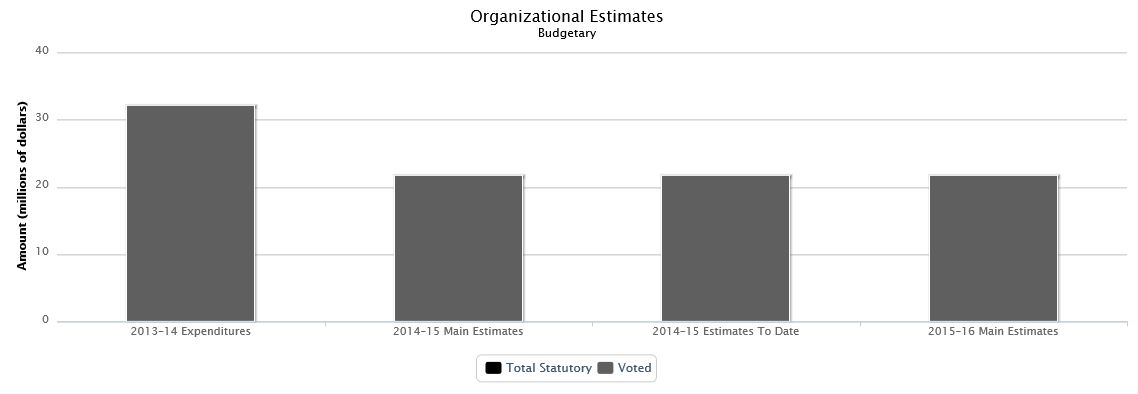
| 2013–14 Expenditures | 2014–15 Main Estimates | 2014–15 Estimates To Date | 2015–16 Main Estimates | ||
|---|---|---|---|---|---|
| Budgetary | |||||
| Voted | |||||
| 1 | Payments to the Canadian Museum for Human Rights for operating and capital expenditures | 32,016,180 | 21,700,000 | 21,700,000 | 21,700,000 |
| Total voted | 32,016,180 | 21,700,000 | 21,700,000 | 21,700,000 | |
| Total budgetary | 32,016,180 | 21,700,000 | 21,700,000 | 21,700,000 | |
Highlights
The Museum's operating appropriations for 2015–16 are $21.7 million, the same amount that was received in 2014–15.
With the official opening and commencement of full-time operations in , the 2015–16 fiscal year is a period of significant change and opportunity for the CMHR. With the transition from planning to operations now fully complete, the Museum's priority areas of focus include maximizing visitation and revenues, delivering a world-class museum experience that consistently meets or exceeds visitor expectations and building toward long-term financial sustainability.
The Board of Trustees adopted five core goals to guide Museum operations and activities through the CMHR's first five years of full-time operations. These goals serve as a roadmap in five strategic areas – visitor experience, infrastructure, stakeholder relations, financial sustainability and its people.
To support the realization of the long-term corporate goals, operational staffing numbers were increased in 2014–15 in the areas of Earned Revenue, Visitor Services, Security and Learning and Programming. The staffing level for 2015–16 will be comparable to 2014–15 as the Museum works through its first full year of operations. It is a variable staffing plan incorporating a significant number of part-time positions which provides the flexibility to increase or decrease the number of visitor-facing staff as required.
Staffing costs are projected to make up 43% of the budget in 2015–16. This is similar to the other national museums where the staffing costs range from 43% to 55%.
Expenditures by Strategic Outcome and Program
| 2013–14 Expenditures | 2014–15 Main Estimates | 2015–16 Main Estimates | |
|---|---|---|---|
| Enhanced knowledge of human rights, with special but not exclusive reference to Canada, in order to enhance the publicʼs understanding of human rights, to promote respect for others and to encourage reflection and dialogue. | |||
| Museum Content and Program | 0 | 9,462,000 | 11,510,000 |
| Accommodation | 0 | 6,305,000 | 5,540,000 |
| Stewardship and Corporate Management | 0 | 5,933,000 | 4,650,000 |
| Funds not allocated to the 2015–16 Program Alignment Architecture | 32,016,180 | 0 | 0 |
| Total | 32,016,180 | 21,700,000 | 21,700,000 |
Canadian Museum of History
Raison d'être
The Canadian Museum of History is a Crown corporation established by the Museums Act (Statutes of Canada 2013, Chapter 38) which came into force on . The Act states that the role of the corporation is "to enhance Canadians' knowledge, understanding and appreciation of events, experiences, people and objects that reflect and have shaped Canada's history and identity, and also to enhance their awareness of world history and cultures."
The Minister of Canadian Heritage and Official Languages is responsible for this organization.
Organizational Estimates
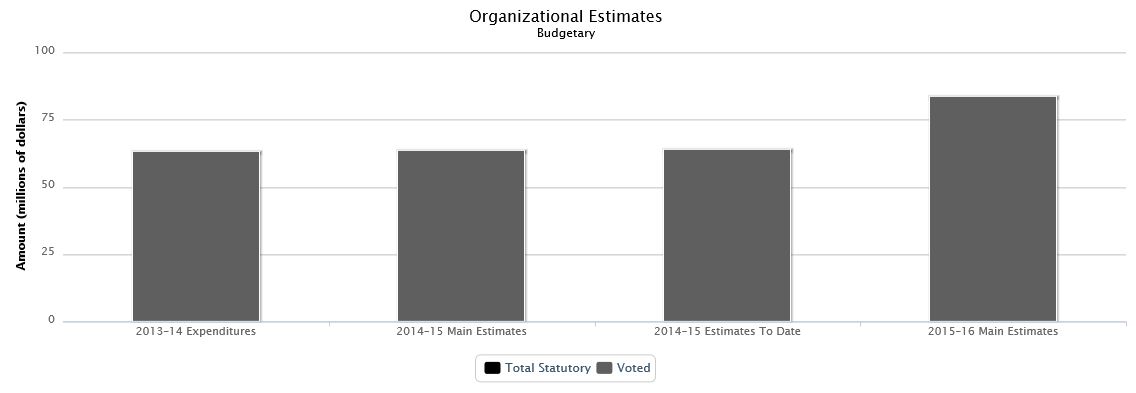
| 2013–14 Expenditures | 2014–15 Main Estimates | 2014–15 Estimates To Date | 2015–16 Main Estimates | ||
|---|---|---|---|---|---|
| Budgetary | |||||
| Voted | |||||
| 1 | Payments to the Canadian Museum of History for operating and capital expenditures | 62,850,567 | 63,430,033 | 63,600,033 | 83,369,477 |
| Total voted | 62,850,567 | 63,430,033 | 63,600,033 | 83,369,477 | |
| Total budgetary | 62,850,567 | 63,430,033 | 63,600,033 | 83,369,477 | |
Highlights
The Canadian Museum of History (CMH), formerly the Canadian Museum of Civilization, is a Crown corporation established by amendments to the Museums Act, which received Royal Assent on . With a new mandate and name, the corporation is now in the process of implementing this significant transformation, including the renovation of its signature gallery, the Canadian History Hall. To be completed in time for Canada's 150th Anniversary in 2017, the new Canadian History Hall will be the largest and most comprehensive exhibition on Canadian history.
During 2014–15, the CMH assumed responsibility for the Virtual Museum of Canada and the Online Works of Reference Programs from Canadian Heritage. The Virtual Museum of Canada Program is an interactive space that brings together Canadian museum collections and stories and encompasses close to 500 virtual exhibits. The Online Works of Reference Program provides access to The Canadian Encyclopedia and The Dictionary of Canadian Biography, two critically important reference sites that provide access to comprehensive Canadian historical content.
The appropriation request for 2015–16 is $83.4 million, an increase of $19.9 million from the previous year's approval. The increase is due to:
- An increase of $11.5 million for the renovation of the Canadian History Hall;
- An increase of $6.2 million for the transfer of the Virtual Museum of Canada from the Department of Canadian Heritage;
- An increase of $2.1 million for the transfer of the Online Works of Reference from the Department of Canadian Heritage; and,
- An increase of $170 thousand in funding for the BC treaty negotiations process.
Expenditures by Strategic Outcome and Program
| 2013–14 Expenditures | 2014–15 Main Estimates | 2015–16 Main Estimates | |
|---|---|---|---|
| Interest in, knowledge of and appreciation and respect for human cultural achievements and human behaviour through collections of historical and cultural objects, exhibitions, programs and research reflecting a Canadian perspective. | |||
| Exhibit, Educate and Communicate | 0 | 19,552,000 | 35,229,000 |
| Accommodation | 0 | 29,808,000 | 33,622,000 |
| Collect and Research | 0 | 12,370,000 | 13,140,000 |
| The following program supports all strategic outcomes within this organization. | |||
| Internal Services | 0 | 1,700,033 | 1,378,477 |
| Funds not allocated to the 2015–16 Program Alignment Architecture | 62,850,567 | 0 | 0 |
| Total | 62,850,567 | 63,430,033 | 83,369,477 |
Canadian Museum of Immigration at Pier 21
Raison d'être
The Canadian Museum of Immigration at Pier 21 was established in 2010 through an amendment to the Museums Act.
The mandate of the Canadian Museum of Immigration at Pier 21 is "to explore the theme of immigration to Canada in order to enhance public understanding of the experiences of immigrants as they arrived in Canada, of the vital role immigration has played in the building of Canada and of the contributions of immigrants to Canada's culture, economy and way of life."
The Minister of Canadian Heritage and Official Languages is responsible for this organization.
Organizational Estimates
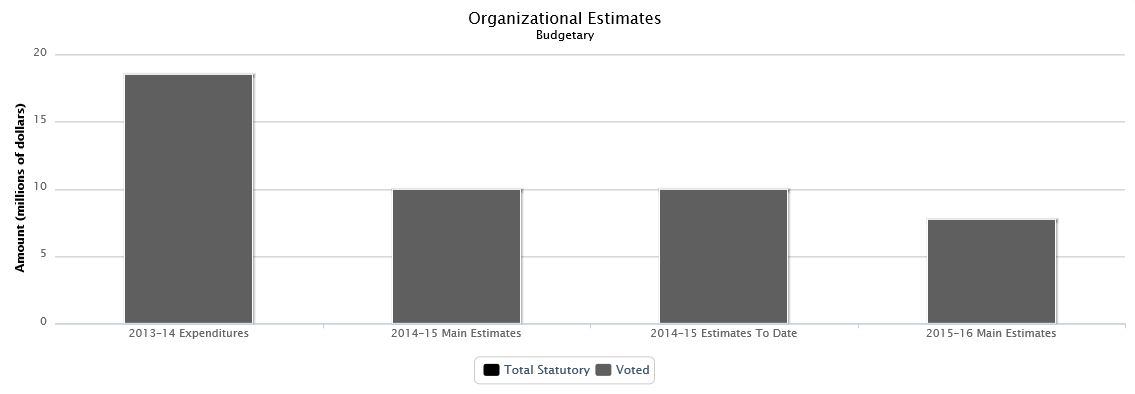
| 2013–14 Expenditures | 2014–15 Main Estimates | 2014–15 Estimates To Date | 2015–16 Main Estimates | ||
|---|---|---|---|---|---|
| Budgetary | |||||
| Voted | |||||
| 1 | Payments to the Canadian Museum of Immigration at Pier 21 for operating and capital expenditures | 18,450,000 | 9,900,000 | 9,900,000 | 7,700,000 |
| Total voted | 18,450,000 | 9,900,000 | 9,900,000 | 7,700,000 | |
| Total budgetary | 18,450,000 | 9,900,000 | 9,900,000 | 7,700,000 | |
Highlights
The Canadian Museum of Immigration at Pier 21 is estimating budgetary expenditures of $7.7 million in 2015–16 which require approval by Parliament.
This represents a decrease in capital expenditures of $2.2 million from the 2014–15 Main Estimates due to the completion of the expansion capital projects including the refit of current and new exhibition spaces and the fabrication and installation of new exhibits for the re-opening of the museum in which will tangibly showcase the national mandate of the Museum.
For further details on the Museum's plan and priorities, please refer to our Corporate Plan.
Expenditures by Strategic Outcome and Program
| 2013–14 Expenditures | 2014–15 Main Estimates | 2015–16 Main Estimates | |
|---|---|---|---|
| Canadians are engaged in building and exploring the stories, themes and history of Canadian immigration as it continues to unfold. | |||
| Accommodations | 0 | 4,958,420 | 2,622,700 |
| Visitor Experience and Connections | 0 | 2,360,090 | 2,583,350 |
| The following program supports all strategic outcomes within this organization. | |||
| Internal Services | 0 | 2,581,490 | 2,493,950 |
| Funds not allocated to the 2015–16 Program Alignment Architecture | 18,450,000 | 0 | 0 |
| Total | 18,450,000 | 9,900,000 | 7,700,000 |
Canadian Museum of Nature
Raison d'être
The Minister of Canadian Heritage and Official Languages is responsible for this organization.
The Canadian Museum of Nature (the Museum) became a Crown corporation on through the Museums Act with the mandate to increase, throughout Canada and internationally, interest in, knowledge of and appreciation and respect for the natural world by establishing, maintaining and developing for research and posterity, a collection of natural history objects, with special but not exclusive reference to Canada, and by demonstrating the natural world, the knowledge derived from it and the understanding it represents.
Organizational Estimates
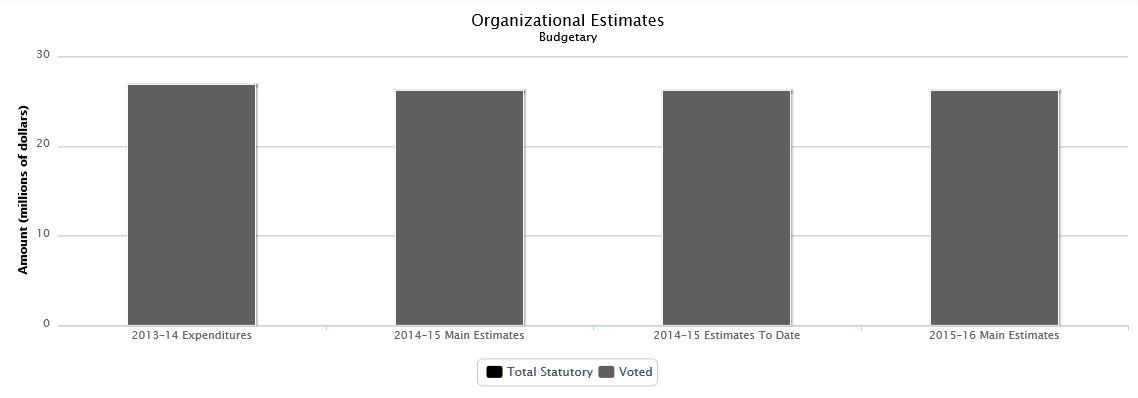
| 2013–14 Expenditures | 2014–15 Main Estimates | 2014–15 Estimates To Date | 2015–16 Main Estimates | ||
|---|---|---|---|---|---|
| Budgetary | |||||
| Voted | |||||
| 1 | Payments to the Canadian Museum of Nature for operating and capital expenditures | 26,770,876 | 26,127,096 | 26,127,096 | 26,129,112 |
| Total voted | 26,770,876 | 26,127,096 | 26,127,096 | 26,129,112 | |
| Total budgetary | 26,770,876 | 26,127,096 | 26,127,096 | 26,129,112 | |
Highlights
The Museum is estimating budgetary expenditures of $26.1 million in 2015–16 which is a small increase of $2,016 from the previous Main Estimates and is due to compensation adjustments.
In 2015–16, the Museum will continue to advance a new strategic plan that leverages its research and collections strengths in arctic knowledge and species discovery. New approaches to the design and delivery of visitor experiences will enable the Museum to attract and inspire new audiences. These new engaging experiences will lead to higher memberships renewal and will provide a foundation for enhanced fundraising. Overall higher levels of engagement will lead to a better understanding of and connection with Canada's natural world.
Strategic Objective 1:
Create a Centre for Arctic Knowledge and Exploration that transforms people's understanding of Canada's arctic and its relationship with Canada as a country in a 21st century global context.
Strategies: Advance a five year program to enhance and advance the research, collections, education and exhibition programs focussed on Canada's Arctic within a national and global context.
- Launch the newly formulated Centre for Arctic Knowledge and Exploration.
Strategic Objective 2:
Create a Centre for Species Discovery and Change that transforms peoples understanding of the relevance of species diversity to their lives now and in the future.
Strategies: Advance a five year program to advance and disseminate the research, collections, education and exhibition programs explaining Canada's species diversity aligned with the United Nations Convention on Biodiversity 2020 program.
- Launch the newly formulated Centre for Species Discovery and Change.
- Unveil the regions of Canada gardens at the Victoria Memorial Museum Building.
Strategic Objective 3:
Create a Centre for Nature Inspiration and Engagement that transforms people's expectations of the Museum as a destination for discussion, connection and exploration with nature's past, present and future that advances understanding and respect for Canada's natural world.
Strategies: Advance a five year program of inspiration and engagement activities on-site and off-site that deliver a different and compelling approach to connection and engagement with nature.
- Launch the Nature Inspiration Centre as a place for piloting new experiences with new and existing audiences.
- Launch a national salon series in collaboration with a major partner – giving nature a voice across Canada.
Strategic Objective 4:
Position the Natural Heritage Campus as a centre of excellence in collections management and knowledge creation, advancement and sharing by becoming a collections collaborator with institutions around the world seeking to collect, preserve, digitize and disseminate specimens that document the nature of Canada.
Strategies: Advance a five year program that positions the Campus as a globally excellent research, collections, administration and experience site that advances understanding and respect for nature.
- Launch the collections digitization and access project aligned with the Museum's role with the Global Biodiversity Information Facility thus leveraging its technology in providing greater online access to its collections and knowledge.
Operational Objective 5:
Create a sustainable business enterprise model of operation that leverages the Museum's strategic imperatives: knowledge & discovery, inspiration and engagement, presence, performance and advancement.
Strategies: Advance a five year program of continuous innovation in all aspects of the Museum operation in order to create a financial and operational model that sustains the Museum now and into the future.
- Launch a fundraising program in support of the arctic and species discovery initiatives.
- Launch a program to develop the skills/competencies and human capacity needed to advance and maintain a sustainable museum enterprise.
- Continue to leverage the Council of CEO's with collaborative procurement, profile raising and exhibit planning coordination.
These five strategic objectives will be managed through the five program activities of the Museum: Inspiration and Engagement, Collections Care and Access, Research and Discovery, Internal Services, and Buildings and Ground which includes the ongoing operations and maintenance of the Museum's two facilities.
Expenditures by Strategic Outcome and Program
| 2013–14 Expenditures | 2014–15 Main Estimates | 2015–16 Main Estimates | |
|---|---|---|---|
| Interest in, knowledge of and appreciation and respect for the natural world through collections of natural history objects, public education programmes and research reflecting a special but not exclusive perspective on Canada. | |||
| Buildings and grounds | 0 | 10,434,000 | 10,206,683 |
| Inspiration and engagement | 0 | 6,261,000 | 6,460,656 |
| Research and discovery | 0 | 3,259,000 | 3,458,090 |
| Collections care and access | 0 | 1,695,000 | 1,733,237 |
| The following program supports all strategic outcomes within this organization. | |||
| Internal Services | 0 | 4,478,096 | 4,270,446 |
| Funds not allocated to the 2015–16 Program Alignment Architecture | 26,770,876 | 0 | 0 |
| Total | 26,770,876 | 26,127,096 | 26,129,112 |
Canadian Northern Economic Development Agency
Raison d'être
Contributing to jobs and growth in Canada, the Canadian Northern Economic Development Agency (CanNor) works to develop a diversified, sustainable and dynamic economy across Canada's three territories. It does this by delivering funding programs to Northerners and Aboriginal people, guiding resource development and major projects across the North through the Northern Projects Management Office, undertaking research to support the development of evidence-based policies, advocating for Northern economic prosperity and diversification, and collaborating with and aligning the efforts of other federal departments, territorial governments, Aboriginal organizations, and industry.
The Minister of the Canadian Northern Economic Development Agency is responsible for this organization.
Organizational Estimates
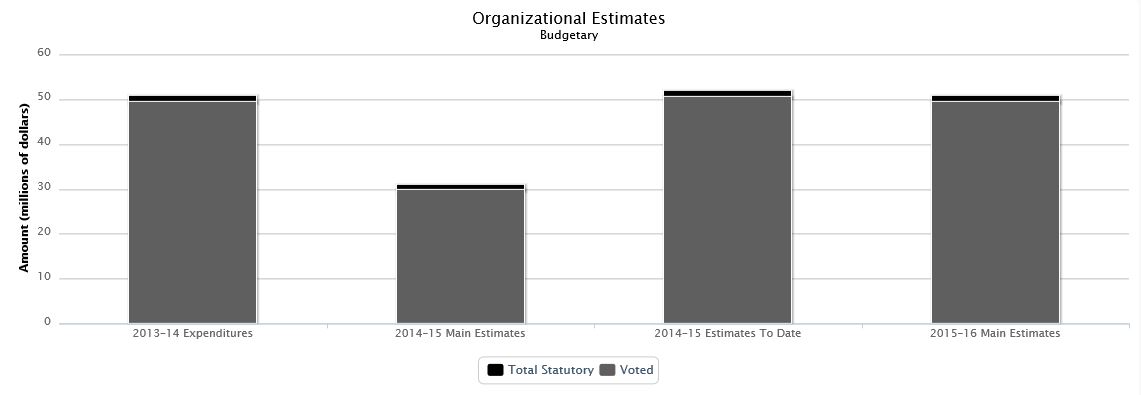
| 2013–14 Expenditures | 2014–15 Main Estimates | 2014–15 Estimates To Date | 2015–16 Main Estimates | ||
|---|---|---|---|---|---|
| Budgetary | |||||
| Voted | |||||
| 1 | Operating expenditures | 12,849,474 | 11,231,366 | 14,000,366 | 14,409,590 |
| 5 | Contributions | 36,499,299 | 18,641,803 | 36,617,328 | 35,001,622 |
| Total voted | 49,348,773 | 29,873,169 | 50,617,694 | 49,411,212 | |
| Total Statutory | 1,430,705 | 1,072,597 | 1,255,343 | 1,257,454 | |
| Total budgetary | 50,779,478 | 30,945,766 | 51,873,037 | 50,668,666 | |
Highlights
CanNor is estimating budgetary expenditures of $50.7 million in 2015–16. Of this amount, $49.4 million requires approval by Parliament. The remaining $1.3 million represents statutory forecasts that do not require additional approvals and are provided for information purposes.
Significant Funding Changes:
Budget 2013 identified $5.6 million over four years to support the capital element of the Centre for Northern Innovation in Mining project at Yukon College. For fiscal year 2015–16, the amount to be spent is $2.4 million ($975,000 in 2014–15).
Budget 2014 renewed the Strategic Investments in Northern Economic Development program for two years, until the end of the 2015–16 fiscal year ($20 million per year).
Funding is reduced by $3 million for the Northern Adult Basic Education Program as it enters its sunsetting year in 2015–16.
Expenditures by Strategic Outcome and Program
| 2013–14 Expenditures | 2014–15 Main Estimates | 2015–16 Main Estimates | |
|---|---|---|---|
| Developed and diversified territorial economies that support prosperity for all Northerners. | |||
| Economic Development | 0 | 22,256,695 | 40,496,412 |
| Policy and Alignment | 0 | 4,256,120 | 4,857,866 |
| The following program supports all strategic outcomes within this organization. | |||
| Internal Services | 6,674,942 | 4,432,951 | 5,314,388 |
| Funds not allocated to the 2015–16 Program Alignment Architecture | 44,104,536 | 0 | 0 |
| Total | 50,779,478 | 30,945,766 | 50,668,666 |
Listing of the 2015–16 Transfer Payments
| 2013–14 Expenditures | 2014–15 Main Estimates | 2015–16 Main Estimates | |
|---|---|---|---|
| Contributions | |||
| Contributions for promoting regional development in Canadaʼs three territories | 18,556,734 | 1,237,000 | 20,637,988 |
| Contributions to support Aboriginal participation in the northern economy | 0 | 10,800,000 | 10,800,000 |
| Contributions for advancing adult basic education in Canada's territories | 6,507,119 | 6,604,803 | 3,563,634 |
Canadian Nuclear Safety Commission
Raison d'être
The Minister of Natural Resources is responsible for this organization.
In 1946, Parliament passed the Atomic Energy Control Act and established the Atomic Energy Control Board, providing it with the power to regulate all nuclear activities related to the development and use of atomic energy in Canada.
More than half a century later, in , the Nuclear Safety and Control Act (NSCA) came into effect and established the Canadian Nuclear Safety Commission (CNSC) as the successor to the Atomic Energy Control Board, with responsibilities and authorities to regulate an industry that spans all segments of the nuclear fuel cycle and a wide range of industrial, medical and academic uses of nuclear substances.
Additional information can be found in the CNSC's Report on Plans and Priorities.
Organizational Estimates
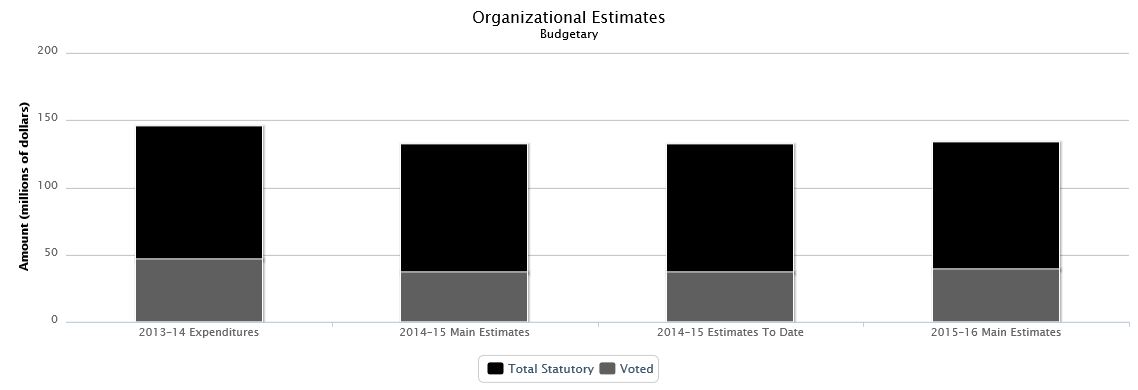
| 2013–14 Expenditures | 2014–15 Main Estimates | 2014–15 Estimates To Date | 2015–16 Main Estimates | ||
|---|---|---|---|---|---|
| Budgetary | |||||
| Voted | |||||
| 1 | Program expenditures | 46,130,800 | 36,578,266 | 36,745,531 | 38,921,080 |
| Total voted | 46,130,800 | 36,578,266 | 36,745,531 | 38,921,080 | |
| Total Statutory | 99,486,221 | 95,059,029 | 95,059,029 | 94,258,665 | |
| Total budgetary | 145,617,021 | 131,637,295 | 131,804,560 | 133,179,745 | |
Highlights
The CNSC is estimating budgetary expenditures of $133.2 million in 2015–16. Of this amount, $38.9 million requires approval by Parliament. The remaining $94.3 million represents statutory forecasts that do not require additional approval and are provided for information purposes.
The CNSC has statutory authority – pursuant to paragraph 21(3) of the NSCA – to spend during a fiscal year any revenues that it receives in the current or previous fiscal year through the conduct of its operations. The CNSC receives its revenues from regulatory fees for licences and applications charged in accordance with the CNSC Cost Recovery Fees Regulations.
In addition to the statutory authority, the CNSC is also funded through the voted budgetary authority from Parliament – Vote 1 – Program expenditures. Voted authority provides funding for activities exempt from paying fees under the CNSC Cost Recovery Fees Regulations (i.e., hospitals and universities), as these entities exist for the public good. Additionally, fees are not charged for activities that result from Canada's obligations that do not provide a direct benefit to identifiable licensees. These include activities with respect to Canada's international obligations (including non-proliferation activities), public responsibilities such as emergency management and public information programs, and the updating of the NSCA and its associated regulations.
Contributions to the employee benefit plans are statutory budgetary authorities.
In 2015–16, the CNSC's Main Estimates have increased by $1.5 million or 1.2% when compared to 2014–15 Main Estimates. The increase is due to an increase in Program expenditures of $2.3 million for collective agreement funding and the termination of a management reserve loan repayments to Treasury Board. The increase in Program expenditures is offset by a decrease in Statutory expenditures of
$0.8 million due to expected reductions in the nuclear industry regulatory requirements.
Additional information can be found in the CNSC's Report on Plans and Priorities.
Expenditures by Strategic Outcome and Program
| 2013–14 Expenditures | 2014–15 Main Estimates | 2015–16 Main Estimates | |
|---|---|---|---|
| Safe and secure nuclear installations and processes used solely for peaceful purposes and an informed public on the effectiveness of Canadaʼs nuclear regulatory regime. | |||
| Nuclear Reactors | 0 | 0 | 38,370,191 |
| Scientific, Technical, Regulatory and Public Information | 0 | 0 | 26,283,818 |
| Nuclear Substances and Prescribed Equipment | 0 | 0 | 11,891,601 |
| Nuclear Fuel Cycle | 0 | 0 | 11,523,104 |
| Nuclear Non-Proliferation | 0 | 0 | 6,299,582 |
| The following program supports all strategic outcomes within this organization. | |||
| Internal Services | 45,355,707 | 40,704,556 | 38,811,449 |
| Funds not allocated to the 2015–16 Program Alignment Architecture | 100,261,314 | 90,932,739 | 0 |
| Total | 145,617,021 | 131,637,295 | 133,179,745 |
Listing of the 2015–16 Transfer Payments
| 2013–14 Expenditures | 2014–15 Main Estimates | 2015–16 Main Estimates | |
|---|---|---|---|
| Grants | |||
| Grants to enable the research, development and management of activities that contribute to the objectives of the Research and Support Program | 75,000 | 75,000 | 75,000 |
| Contributions | |||
| Participant Funding Program | 282,878 | 925,000 | 925,000 |
| Contributions to enable the research, development and management of activities that contribute to the objectives of the Research and Support Program, and the Canadian Safeguards Support Program | 1,365,752 | 770,000 | 770,000 |
Canadian Polar Commission
Raison d'être
The Canadian Polar Commission (CPC) is responsible for monitoring, promoting and disseminating knowledge of the polar regions; contributing to public awareness of the importance of polar science to Canada; enhancing Canadaʼs international profile as a circumpolar nation; and recommending polar science policy direction to government. The Minister of Aboriginal Affairs and Northern Development is responsible for this organization.
Organizational Estimates
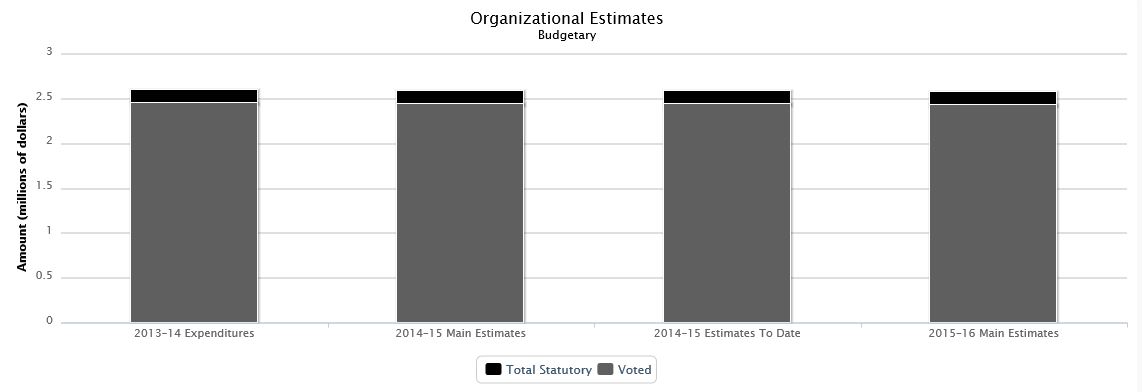
| 2013–14 Expenditures | 2014–15 Main Estimates | 2014–15 Estimates To Date | 2015–16 Main Estimates | ||
|---|---|---|---|---|---|
| Budgetary | |||||
| Voted | |||||
| 1 | Program expenditures | 2,445,699 | 2,439,807 | 2,439,807 | 2,434,137 |
| Total voted | 2,445,699 | 2,439,807 | 2,439,807 | 2,434,137 | |
| Total Statutory | 144,310 | 136,553 | 136,553 | 139,948 | |
| Total budgetary | 2,590,009 | 2,576,360 | 2,576,360 | 2,574,085 | |
Highlights
The CPC is estimating budgetary expenditures of $2.6 million in 2015–16. Of this amount, $2.4 million requires approval by Parliament. The remaining $140 thousand represents statutory forecasts that do not require additional approval and are provided for information purposes.
The CPC continues to manage its grant programs: the Northern Scientific Training Program including the funding to the Association of Canadian Universities for Northern Studies, the Centenary Medal Commemorating the International Polar year 1882–83 also known as the Northern Scientific Award and the Canadian Polar Commission Scholarship Award.
The CPC will continue to host conferences and workshops, to publish information on subjects of relevance to polar research, to build and maintain polar knowledge networks and to work closely with other governmental and non-governmental agencies to promote and support Canadian study of the polar regions.
Expenditures by Strategic Outcome and Program
| 2013–14 Expenditures | 2014–15 Main Estimates | 2015–16 Main Estimates | |
|---|---|---|---|
| Increased Canadian polar knowledge. | |||
| Research Facilitation and Communication | 2,259,236 | 2,095,000 | 2,087,258 |
| The following program supports all strategic outcomes within this organization. | |||
| Internal Services | 330,773 | 481,360 | 486,827 |
| Total | 2,590,009 | 2,576,360 | 2,574,085 |
Listing of the 2015–16 Transfer Payments
| 2013–14 Expenditures | 2014–15 Main Estimates | 2015–16 Main Estimates | |
|---|---|---|---|
| Grants | |||
| Grants to individuals, organizations, associations and institutions to support research and activities relating to the polar regions | 1,086,000 | 1,086,000 | 1,086,000 |
| Contributions | |||
| Contributions to individuals, organizations, associations and institutions to support research and activities relating to the polar regions | 10,000 | 10,000 | 10,000 |
Canadian Radio-television and Telecommunications Commission
Raison d'être
The Canadian Radio-television and Telecommunications Commission (CRTC) is an administrative tribunal that regulates and supervises Canadian broadcasting, and telecommunications in the public interest, as well as contributes to protecting Canadians from unsolicited communications.
The CRTC reports to Parliament through the Minister of Canadian Heritage and Official Languages.
Organizational Estimates
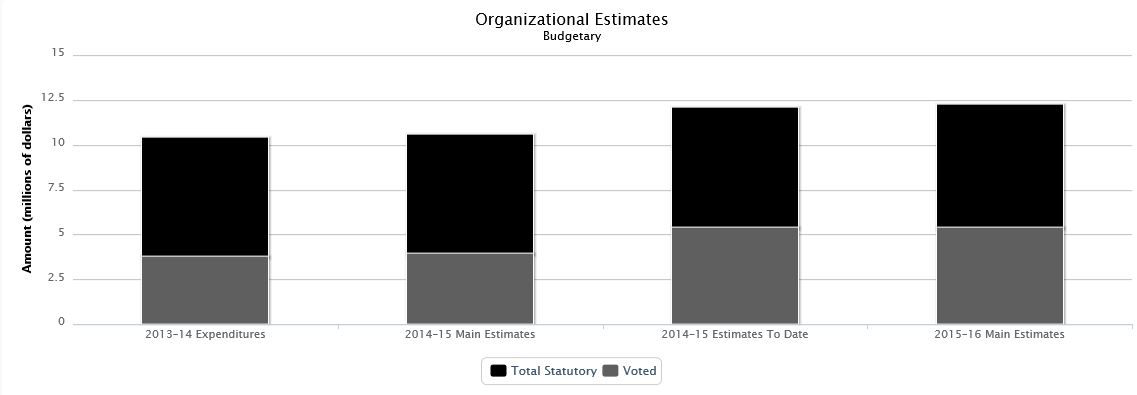
| 2013–14 Expenditures | 2014–15 Main Estimates | 2014–15 Estimates To Date | 2015–16 Main Estimates | ||
|---|---|---|---|---|---|
| Budgetary | |||||
| Voted | |||||
| 1 | Program expenditures | 3,755,004 | 3,945,670 | 5,394,244 | 5,379,872 |
| Total voted | 3,755,004 | 3,945,670 | 5,394,244 | 5,379,872 | |
| Total Statutory | 6,624,857 | 6,641,029 | 6,674,402 | 6,877,018 | |
| Total budgetary | 10,379,861 | 10,586,699 | 12,068,646 | 12,256,890 | |
Highlights
The CRTC is estimating net budgetary expenditures of $12.3 million in 2015–16. Of this amount, $5.4 million requires approval by Parliament. The remaining $6.9 million represents statutory forecasts that do not require additional approval and are provided for information purposes.
This is an increase of $1.7 million when compared to the 2014–15 Main Estimates. Factors contributing to this difference include increases of:
- $0.7 million to implement and maintain the Voter Contact Registry and conduct communications, compliance and enforcement activities;
- $0.7 million for the transfer of funds from Public Works and Government Services for a reduction in accommodation requirements;
- $0.2 million for statutory budget expenditures related to employee benefits plans; and
- $0.1 million for the transfer of funds from the Offices of the Information and Privacy Commissioners of Canada to assist with the establishment and lawful operation of the Spam Reporting Center.
Once tabled in the House of Commons, additional information will be available in the departmental Report on Plans and Priorities.
Expenditures by Strategic Outcome and Program
| 2013–14 Expenditures | 2014–15 Main Estimates | 2015–16 Main Estimates | |
|---|---|---|---|
| Canadians have access to a world-class communication system. | |||
| Protection within the Communication System | 0 | 4,170,720 | 5,276,902 |
| Connection to the Communication System | 6,046,836 | 2,220,989 | 2,424,184 |
| Canadian Content Creation | 782,518 | 1,892,757 | 2,074,812 |
| The following program supports all strategic outcomes within this organization. | |||
| Internal Services | 3,550,507 | 2,302,233 | 2,480,992 |
| Total | 10,379,861 | 10,586,699 | 12,256,890 |
Canadian Security Intelligence Service
Raison d'être
As per the Canadian Security Intelligence Service (CSIS) Act, the mandate of CSIS is to collect, analyze and retain information and intelligence on activities suspected of constituting threats to the security of Canada, and to report to and advise the government. CSIS is responsible for the collection of national security intelligence inside and outside Canada; the collection of foreign intelligence within Canada; and for security screening assessments for federal government employees, refugees, immigration and citizenship applicants, and some other sectors such as the Canadian nuclear industry.
The Minister of Public Safety and Emergency Preparedness is responsible for CSIS.
Organizational Estimates
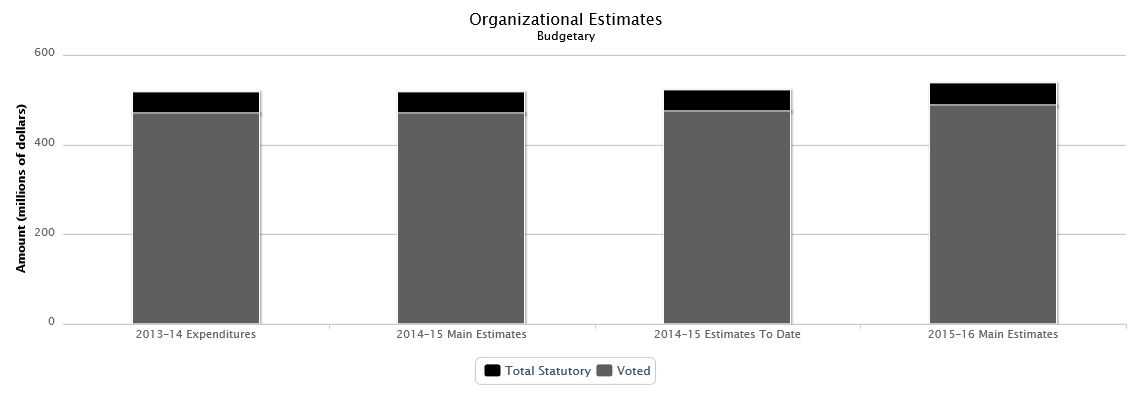
| 2013–14 Expenditures | 2014–15 Main Estimates | 2014–15 Estimates To Date | 2015–16 Main Estimates | ||
|---|---|---|---|---|---|
| Budgetary | |||||
| Voted | |||||
| 1 | Program expenditures | 468,801,655 | 468,824,514 | 473,315,588 | 488,215,677 |
| Total voted | 468,801,655 | 468,824,514 | 473,315,588 | 488,215,677 | |
| Total Statutory | 47,504,074 | 47,412,243 | 47,412,243 | 48,821,568 | |
| Total budgetary | 516,305,729 | 516,236,757 | 520,727,831 | 537,037,245 | |
Highlights
The Main Estimates for CSIS are $537.0 million, a net increase of $20.8 million from 2014–15. The major changes are as follows:
- An increase of $21.2 million in support of Canada's national security and the safety of Canadians; and,
- A decrease of $0.4 million due to various government-wide initiatives.
Expenditures by Strategic Outcome and Program
| 2013–14 Expenditures | 2014–15 Main Estimates | 2015–16 Main Estimates | |
|---|---|---|---|
| Intelligence is used to protect the security and safety of Canada and its citizens. | |||
| Intelligence Program | 474,197,376 | 447,649,011 | 492,461,267 |
| Security Screening Program | 42,108,353 | 68,587,746 | 44,575,978 |
| Funds not allocated to the 2015–16 Program Alignment Architecture | 0 | 0 | 0 |
| Total | 516,305,729 | 516,236,757 | 537,037,245 |
Canadian Space Agency
Raison d'être
The mandate of the Canadian Space Agency (CSA) is "to promote the peaceful use and development of space, to advance the knowledge of space through science and to ensure that space science and technology provide social and economic benefits for Canadians".
The CSA is carrying its mandate in collaboration with Canadian industry, academia, Government of Canada (GoC) organizations and other international space agencies or organizations.
The founding legislation that received Royal Assent in 1990 attributed four main functions to the CSA:
- Assisting the Minister in the coordination of the space policies and programs;
- Planning and implementing programs and projects related to scientific or industrial space research and development, and application of space technology;
- Promoting the transfer and diffusion of space technology to and throughout Canadian industry; and
- Encouraging commercial exploitation of space capabilities, technology, facilities and systems.
The Minister of Industry is responsible for this organization.
Organizational Estimates
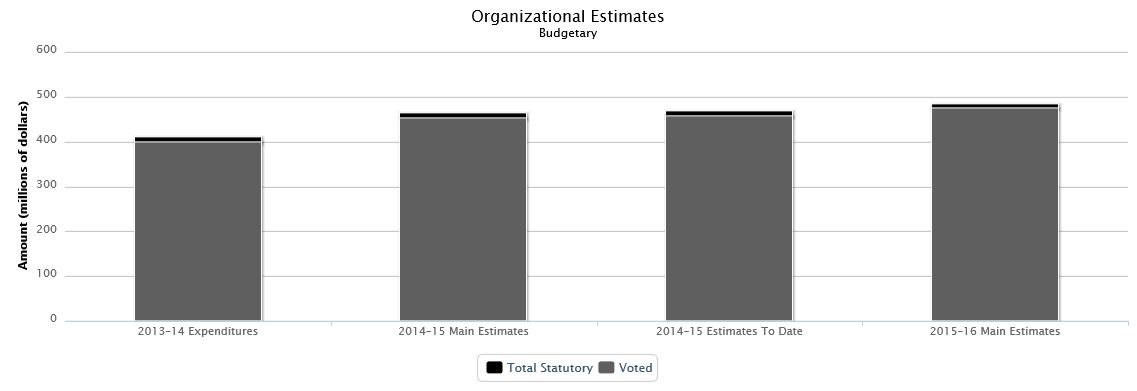
| 2013–14 Expenditures | 2014–15 Main Estimates | 2014–15 Estimates To Date | 2015–16 Main Estimates | ||
|---|---|---|---|---|---|
| Budgetary | |||||
| Voted | |||||
| 1 | Operating expenditures | 165,008,980 | 155,266,004 | 161,292,647 | 169,304,033 |
| 5 | Capital expenditures | 200,820,185 | 257,955,633 | 253,352,633 | 258,964,761 |
| 10 | Grants and contributions | 32,682,181 | 39,306,853 | 41,892,854 | 45,356,265 |
| Total voted | 398,511,346 | 452,528,490 | 456,538,134 | 473,625,059 | |
| Total Statutory | 10,203,894 | 9,918,684 | 9,918,684 | 9,803,222 | |
| Total budgetary | 408,715,240 | 462,447,174 | 466,456,818 | 483,428,281 | |
Highlights
The CSA is estimating budgetary expenditures of $483.4 million in 2015–16. Of this amount, $473.6 million requires approval by Parliament. The remaining $9.8 million represents statutory forecasts that do not require additional approval and are provided for information purposes.
The variation in voted appropriations represents a net increase of $21.0 million between fiscal years 2014–15 and 2015–16 and is due to an increase in Operating expenditures of $14.0 million, an increase in Capital expenditures of $1.0 million and an increase in Grants and Contributions of $6.0 million. These variations are largely attributable to the follow context:
- CSA's projects and missions funding profile vary from year to year and require funding from different Votes depending on their development phases. Thus, pre and post project expenditures are largely Operating expenditures whereas the design and build phases call for Capital expenditures. In addition, the science support associated with some projects may necessitate funds either in Operating expenditures or in Grants and Contributions; and
- CSA conducted a reallocation of resources to address government priorities such as the continuation of Canadaʼs participation in the International Space Station program to 2020 announced in the Budget 2012 as well as the Government's response to the Space Volume of the Aerospace and Space Review in to stabilize the annual funding for the Space Technology Development Program.
In addition to the context described above, variations between fiscal years 2014–15 and 2015–16 are mainly:
- An increase of $8.0 million due to additional funding received in order to provide enhanced space-based Automatic Identification System data services;
- An increase of $6.3 million related to the forecasted cash flow requirements for the Class Contribution Program to Support research, awareness and learning in space science and technology. Of this amount, $5.2 million is related to the Space Technology Development Program in response to the Space Volume of the Aerospace and Space Review in ;
- An increase of $3.1 million due to funding received for the Maritime Monitoring and Messaging Micro-Satellite project;
- An increase of $3.0 million related to the RADARSAT Constellation Mission. The current year-over-year increase reflects different cash flow requirements;
- An increase of $0.9 million related to the forecasted cash flow requirements for the Class Grant Program to Support research, awareness and learning in space science and technology; and
- A decrease of $1.2 million related to the forecasted cash flow requirements for the Contributions to the Canada/European Space Agency Cooperation Agreement.
Once tabled in the House of Commons, additional information will be available in the departmental Report on Plans and Priorities available at: http://www.asc-csa.gc.ca/eng/publications/rp.asp#rp.
Expenditures by Strategic Outcome and Program
| 2013–14 Expenditures | 2014–15 Main Estimates | 2015–16 Main Estimates | |
|---|---|---|---|
| Canada's exploration of space, provision of space services and development of its space capacity meet the nation's needs for scientific knowledge, innovation and information. | |||
| Space Data, Information and Services | 207,544,469 | 256,908,528 | 259,609,001 |
| Space Exploration | 96,501,810 | 96,586,363 | 112,407,879 |
| Future Canadian Space Capacity | 55,453,614 | 62,772,518 | 66,268,193 |
| The following program supports all strategic outcomes within this organization. | |||
| Internal Services | 49,215,347 | 46,179,765 | 45,143,208 |
| Total | 408,715,240 | 462,447,174 | 483,428,281 |
Listing of the 2015–16 Transfer Payments
| 2013–14 Expenditures | 2014–15 Main Estimates | 2015–16 Main Estimates | |
|---|---|---|---|
| Grants | |||
| Class Grant Program to Support Research, Awareness and Learning in Space Science and Technology | 6,292,445 | 6,535,000 | 7,456,000 |
| Contributions | |||
| Contributions to the Canada/European Space Agency Cooperation Agreement | 24,620,924 | 27,373,853 | 26,215,000 |
| Class Contribution Program to Support Research, Awareness and Learning in Space Science and Technology | 1,518,812 | 5,398,000 | 11,685,265 |
Canadian Tourism Commission
Raison d'être
The Canadian Tourism Commission (CTC) is Canada's national tourism marketing organization. A Crown corporation wholly owned by the Government of Canada, the CTC's purpose is to sustain a vibrant and profitable tourism industry by marketing Canada as an internationally competitive, premier four-season tourism destination where travelers can indulge in extraordinary experiences. Reporting to Parliament through the Minister of Industry, the CTC's legislative requirements are outlined in the Canadian Tourism Commission Act. Through collaboration and partnerships with the private sector, as well as with the governments of Canada, the provinces and territories, the CTC works with the tourism sector to maintain Canada's competitiveness and generate wealth for Canadians by stimulating demand for Canada's visitor economy. Additional information can be found in the CTC's 2015–2019 Corporate Plan.
Organizational Estimates
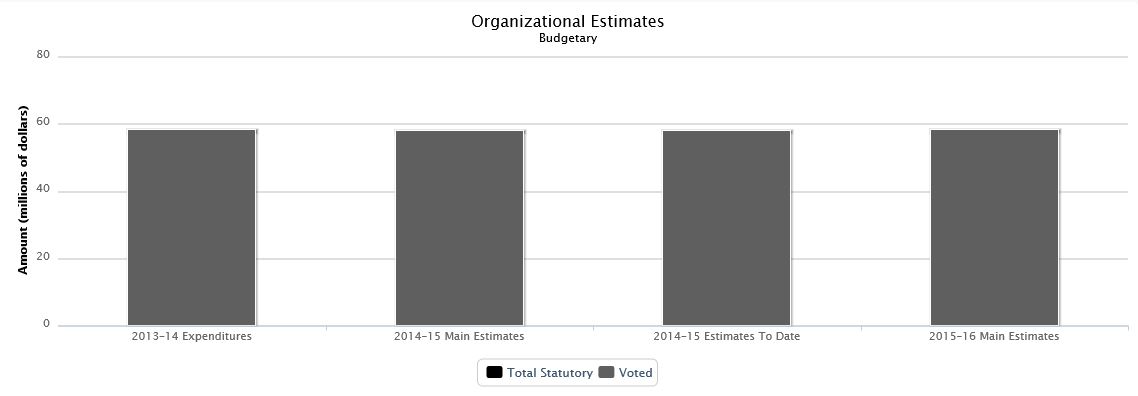
| 2013–14 Expenditures | 2014–15 Main Estimates | 2014–15 Estimates To Date | 2015–16 Main Estimates | ||
|---|---|---|---|---|---|
| Budgetary | |||||
| Voted | |||||
| 1 | Payments to the Canadian Tourism Commission | 57,975,770 | 57,972,388 | 57,972,388 | 57,975,770 |
| Total voted | 57,975,770 | 57,972,388 | 57,972,388 | 57,975,770 | |
| Total budgetary | 57,975,770 | 57,972,388 | 57,972,388 | 57,975,770 | |
Highlights
The CTC was created in 1995, as a Special Operating Agency within Industry Canada, and in 2001, became a Crown corporation pursuant to the Canadian Tourism Commission Act. The CTC is Canada's national tourism marketing organization mandated to sustain a vibrant and profitable Canadian tourism industry; market Canada as a desirable tourist destination; support a cooperative relationship between the private sector and the governments of Canada, the provinces and the territories with respect to Canadian tourism; and provide information about Canadian tourism to the private sector and to the governments of Canada, the provinces and the territories.
In 2012, the CTC took part in the comprehensive review by the Government of Canada as outlined in Budget 2012, to return to balanced budgets over the medium-term. Budget 2012 mandated a reduction on CTC's appropriations by $14.2 million starting in 2013–14. This adjustment will result in the CTC's core appropriations (i.e. excluding one-time funding for special programs) of $58.0 million starting in 2013–14. Since the CTC's budget is organized by calendar year, this appropriation will translate into an annual appropriation of
$58.0 million for 2015. Consistent with this decision, the CTC's activities are aligned to focus resources on markets of strategic importance to Canada's tourism industry.
The CTC's corporate strategy as outlined in the 2015-2019 Corporate Plan is:
Goal
To grow tourism export revenue for Canada in markets offering the highest return and where the Canada brand leads.
Objectives
Generate demand for Canada's visitor economy;
Support Canadian tourism businesses sell Canada in international markets; and
Advance corporate excellence and efficiency.
Expenditures by Strategic Outcome and Program
| 2013–14 Expenditures | 2014–15 Main Estimates | 2015–16 Main Estimates | |
|---|---|---|---|
| Canadian economy benefits from strong tourism demand from Canadian Tourism Commission's (CTC) markets. | |||
| Marketing and Sales | 0 | 46,045,252 | 44,851,770 |
| Tourism Research and Communications | 0 | 3,321,766 | 3,277,000 |
| Experiential Product Development | 0 | 0 | 1,042,000 |
| The following program supports all strategic outcomes within this organization. | |||
| Internal Services | 0 | 8,605,370 | 8,805,000 |
| Funds not allocated to the 2015–16 Program Alignment Architecture | 57,975,770 | 0 | 0 |
| Total | 57,975,770 | 57,972,388 | 57,975,770 |
Canadian Transportation Accident Investigation and Safety Board
Raison d'être
The Canadian Transportation Accident Investigation and Safety Board is referred to as the Transportation Safety Board of Canada (TSB) in its day-to-day activities. The TSB is an independent agency created in 1990 by an Act of Parliament. It operates at arm's length from other government departments and agencies to ensure that there are no real or perceived conflicts of interest. TSB's sole objective is to advance air, marine, rail and pipeline transportation safety. This mandate is fulfilled by conducting independent investigations into selected transportation occurrences to identify the causes and contributing factors and the safety deficiencies evidenced by an occurrence. TSB makes recommendations to reduce or eliminate any such safety deficiencies and reports publicly on its investigations. The TSB then follows-up with stakeholders to ensure that safety actions are taken to reduce risks and improve safety.
The TSB may also represent Canadian interests in foreign investigations of transportation accidents involving Canadian registered licensed or manufactured aircraft ships or railway rolling stock. In addition the TSB carries out some of Canada's obligations related to transportation safety at the International Civil Aviation Organization (ICAO) and the International Maritime Organization (IMO).
The Leader of the Government in the House of Commons is the designated minister for the purposes of tabling the TSB's administrative reports in Parliament, such as the Report on Plans and Priorities and Departmental Performance Report. The TSB forms part of the Privy Council portfolio of departments and agencies.
Organizational Estimates
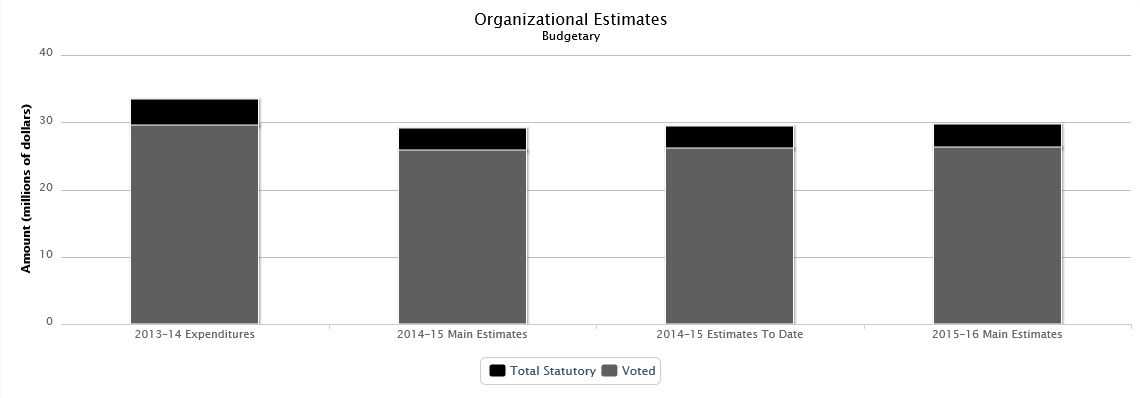
| 2013–14 Expenditures | 2014–15 Main Estimates | 2014–15 Estimates To Date | 2015–16 Main Estimates | ||
|---|---|---|---|---|---|
| Budgetary | |||||
| Voted | |||||
| 1 | Program expenditures | 29,455,776 | 25,757,380 | 26,058,380 | 26,290,301 |
| Total voted | 29,455,776 | 25,757,380 | 26,058,380 | 26,290,301 | |
| Total Statutory | 3,847,418 | 3,285,011 | 3,324,011 | 3,439,498 | |
| Total budgetary | 33,303,194 | 29,042,391 | 29,382,391 | 29,729,799 | |
Highlights
The TSB is estimating budgetary expenditures of $29.7 million in 2015–16. Of this amount, $26.3 million requires approval by Parliament. The remaining $3.4 million represents statutory forecasts that do not require additional approval and are provided for information purposes. The organization's funding through Main Estimates has increased from 2014–15 by $0.7 million due to an increase in funding for collective bargaining adjustments.
Significant variances between the TSB's funding in Main Estimates and actual year-end expenditures are explained by additional sources of funding. The department receives additional funding through transfers from Treasury Board votes for the carry-forward of unused funds from the previous year, for collective bargaining adjustments, and for severance and parental benefits paid during the year. The TSB may also receive additional funding from Parliament through Supplementary Estimates for funding pressures created by the investigation of a significant transportation occurrence (e.g. Lac-Mégantic, Quebec).
During 2014–15, the TSB completed a review of its performance measurement framework. The titles and descriptions of its programs have consequently been updated. Additionally, the allocation of funding for specialized activities in support of all four programs (e.g. engineering and technical, human factors) has been modified to align with the proportion of active investigations in each mode at the time of preparation of the Main Estimates. The new allocation process explains the relative differences in funding by program between the 2014–15 and 2015–16 Main Estimates.
In 2015–16, the TSB will continue to strive to be a world leader in influencing changes that advance transportation safety. This vision statement will be achieved by focusing on four strategic objectives: responding, managing, communicating and advocating. This four-pronged approach provides a clear framework to guide investments and activities for the planning horizon.
Details on the TSB's priorities will be available in its 2015–16 Report on Plans and Priorities.
Expenditures by Strategic Outcome and Program
| 2013–14 Expenditures | 2014–15 Main Estimates | 2015–16 Main Estimates | |
|---|---|---|---|
| Independent investigations into transportation occurrences contribute to making the transportation system safer. | |||
| Aviation occurrence investigations | 14,671,477 | 12,778,652 | 12,537,059 |
| Rail occurrence investigations | 6,883,816 | 4,646,783 | 5,332,576 |
| Marine occurrence investigations | 5,457,349 | 4,646,782 | 4,902,097 |
| Pipeline occurrence investigations | 353,442 | 580,848 | 600,535 |
| The following program supports all strategic outcomes within this organization. | |||
| Internal Services | 5,937,110 | 6,389,326 | 6,357,532 |
| Total | 33,303,194 | 29,042,391 | 29,729,799 |
Canadian Transportation Agency
Raison d'être
The Canadian Transportation Agency (CTA) is an independent, quasi-judicial tribunal and economic regulator. It makes decisions and determinations on a wide range of matters within the federal transportation system under the authority of Parliament, as set out in the Canada Transportation Act and other legislation.
CTAʼs mandate includes:
- economic regulation, to provide approvals, issue licences, permits and certificates of fitness, and make decisions on a wide range of matters involving federal air, rail and marine transportation;
- dispute resolution, to resolve complaints about federal transportation services, rates, fees and charges; and
- accessibility, to ensure Canadaʼs national transportation system is accessible to all persons, particularly those with disabilities.
Additional information can be found in CTA's Report on Plans and Priorities.
The Minister of Transport is responsible for this organization.
Organizational Estimates
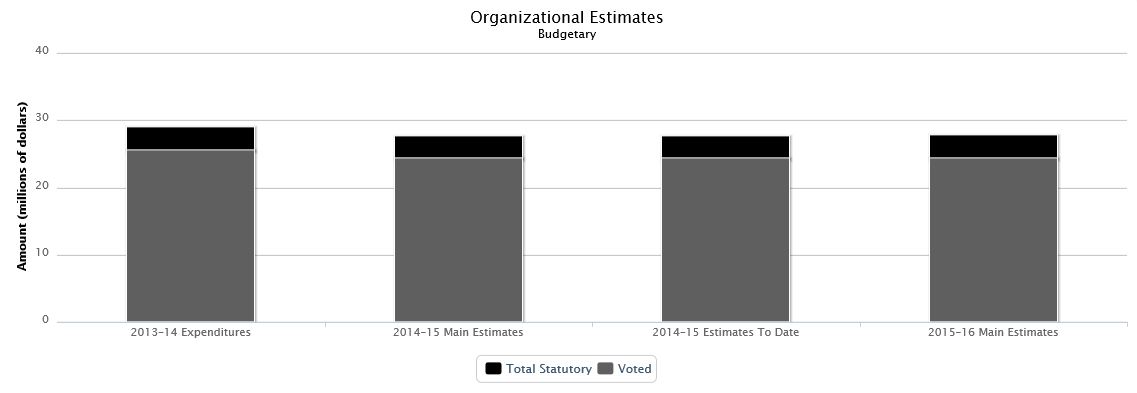
| 2013–14 Expenditures | 2014–15 Main Estimates | 2014–15 Estimates To Date | 2015–16 Main Estimates | ||
|---|---|---|---|---|---|
| Budgetary | |||||
| Voted | |||||
| 1 | Program expenditures | 25,561,336 | 24,299,370 | 24,299,370 | 24,313,366 |
| Total voted | 25,561,336 | 24,299,370 | 24,299,370 | 24,313,366 | |
| Total Statutory | 3,415,602 | 3,351,252 | 3,351,252 | 3,420,038 | |
| Total budgetary | 28,976,938 | 27,650,622 | 27,650,622 | 27,733,404 | |
Highlights
The CTA is estimating budgetary expenditures of $27.7 million in 2015–16. Of this amount, $24.3 million requires approval by Parliament. The remaining $3.4 million represents statutory forecasts that do not require additional approval and are provided for information purposes.
In 2015–16, CTAʼs planned expenditures will remain approximately the same as previous years, during which the CTA has absorbed a number of new mandates without additional funding. In addition to carrying out its ongoing activities, the CTA will carry out work related to its new responsibilities and continue the implementation of its 2014-2017 Strategic Plan and will continue to carry out the activities related to the priorities below:
- Service Excellence – CTA is recognized for its service innovation and excellence.
- Regulatory Effectiveness – The regulatory regime meets the needs of Canadians and enhances the competitiveness and accessibility of the national transportation system.
- High-Performing Organization – CTA has engaged, skilled and knowledgeable employees who are supported by effective and efficient systems and services.
Expenditures by Strategic Outcome and Program
| 2013–14 Expenditures | 2014–15 Main Estimates | 2015–16 Main Estimates | |
|---|---|---|---|
| Transparent, fair and timely dispute resolution and economic regulation of the national transportation system. | |||
| Economic Regulation | 12,027,105 | 11,760,314 | 11,814,081 |
| Adjudication and Alternative Dispute Resolution | 8,982,629 | 8,978,938 | 10,052,252 |
| The following program supports all strategic outcomes within this organization. | |||
| Internal Services | 7,967,204 | 6,911,370 | 5,867,071 |
| Total | 28,976,938 | 27,650,622 | 27,733,404 |
Chief Electoral Officer
Raison d'être
The Office of the Chief Electoral Officer, commonly known as Elections Canada, is an independent, non-partisan agency that reports directly to Parliament. Its mandate is to be prepared to conduct a federal general election, by-election or referendum; to administer the political financing provisions of the Canada Elections Act; to monitor compliance with electoral legislation; to conduct public information campaigns on voter registation, voting and becoming a candidate; to conduct education programs for students on the electoral process; to provide support to the independent commissions in charge of adjusting the boundaries of federal electoral districts following each decennial census; to carry out studies on alternative voting methods and, with the approval of parliamentarians, test alternative voting processes for future use during electoral events; to provide assistance and co-operation in electoral matters to electoral agencies in other countries or to international organizations.
The Leader of the Government in the House of Commons is the designated minister for the purpose of tabling the Chief Electoral Officer's administrative reports in Parliament, including the Report on Plans and Priorities and Departmental Performance Report.
Organizational Estimates
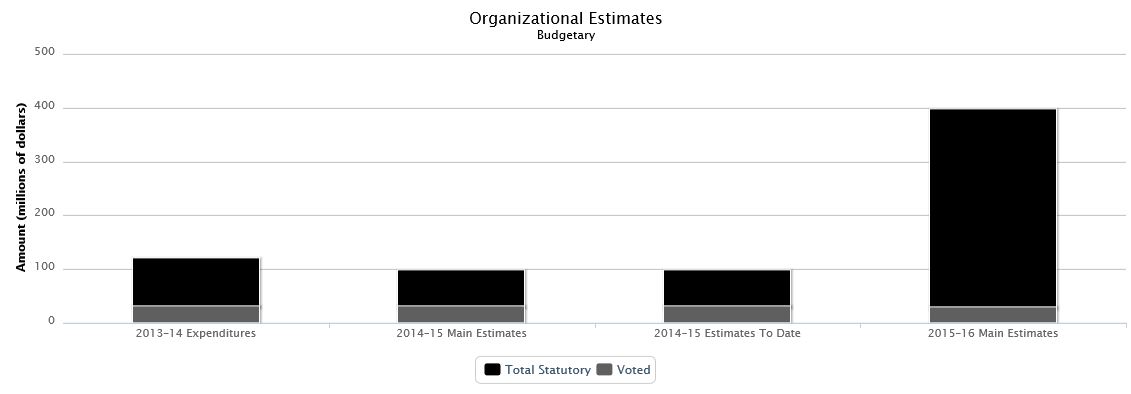
| 2013–14 Expenditures | 2014–15 Main Estimates | 2014–15 Estimates To Date | 2015–16 Main Estimates | ||
|---|---|---|---|---|---|
| Budgetary | |||||
| Voted | |||||
| 1 | Program expenditures | 30,177,120 | 30,538,285 | 30,538,285 | 29,204,976 |
| Total voted | 30,177,120 | 30,538,285 | 30,538,285 | 29,204,976 | |
| Total Statutory | 90,050,629 | 66,572,147 | 66,572,147 | 366,754,841 | |
| Total budgetary | 120,227,749 | 97,110,432 | 97,110,432 | 395,959,817 | |
Highlights
Elections Canada is estimating budgetary expenditures of $396.0 million in 2015–16. Of this amount, $29.2 million requires approval by Parliament. The remaining $366.8 million represents statutory forecasts and is provided for information purposes.
Overall for 2015–16, Elections Canada is estimating a net increase of $298.8 million from the 2014–15 Estimates to Date. This increase is explained as follows:
- A $300.2 million net increase in statutory authority, mainly for the conduct of the 2015 general election (part of the Electoral Operations and Regulation of Electoral Activities programs); and
- A $1.3 million net decrease in program expenditures (voted), mainly as a result of transferring the Commissioner of Canada Elections to the Office of the Director of Public Prosecutions for compliance and enforcement activities (part of the Regulation of Electoral Activities program).
Additional information can be found in Elections Canada's Report on Plans and Priorities.
The 2014–15 Main Estimates and Estimates to Date exclude funding for the following statutory items:
- The conduct of by-elections in Fort McMurray–Athabasca, Macleod, Scarborough–Agincourt and Trinity–Spadina on , and in Whitby–Oshawa and Yellowhead on (all part of the Electoral Operations and Regulation of Electoral Activities programs); and
- The achievement of operational readiness for the 2015 general election, through which Elections Canada prepares to conduct the election in 338 electoral districts (previously 308), implements provisions of the recently amended Canada Elections Act, and puts in place key administrative changes aimed at improving services to electors (part of the Electoral Operations program).
The disposition of all authorities will be available in Elections Canada's 2014–15 Departmental Performance Report and the Public Accounts.
Expenditures by Strategic Outcome and Program
| 2013–14 Expenditures | 2014–15 Main Estimates | 2015–16 Main Estimates | |
|---|---|---|---|
| An Accessible Electoral Framework that Canadians Trust and Use. | |||
| Electoral Operations | 45,326,885 | 34,938,217 | 277,113,580 |
| Regulation of Electoral Activities | 27,960,704 | 19,959,354 | 79,015,382 |
| Electoral Engagement | 7,974,120 | 8,441,546 | 8,060,043 |
| The following program supports all strategic outcomes within this organization. | |||
| Internal Services | 38,966,040 | 33,771,315 | 31,770,812 |
| Total | 120,227,749 | 97,110,432 | 395,959,817 |
Citizenship and Immigration
Raison d'être
In the first years after Confederation, Canada's leaders had a powerful vision: to connect Canada by rail and make the West the world's breadbasket as a foundation for the country's economic prosperity. This vision meant quickly populating the Prairies, leading the Government of Canada to establish its first national immigration policies. Immigrants have been a driving force in Canada's nationhood and its economic prosperity – as farmers settling lands, as workers in factories fuelling industrial growth, as entrepreneurs and as innovators helping Canada to compete in the global, knowledge-based economy.
Citizenship and Immigration Canada (CIC) selects foreign nationals as permanent and temporary residents and offers Canada's protection to refugees. CIC develops Canada's admissibility policy, which sets the conditions for entering and remaining in Canada; it also conducts, in collaboration with its partners, the screening of potential permanent and temporary residents to protect the health, safety and security of Canadians. Fundamentally, CIC builds a stronger Canada by helping immigrants and refugees settle and integrate into Canadian society and the economy, and by encouraging and facilitating Canadian citizenship.
The Minister of Citizenship and Immigration is responsible for this organization.
Organizational Estimates
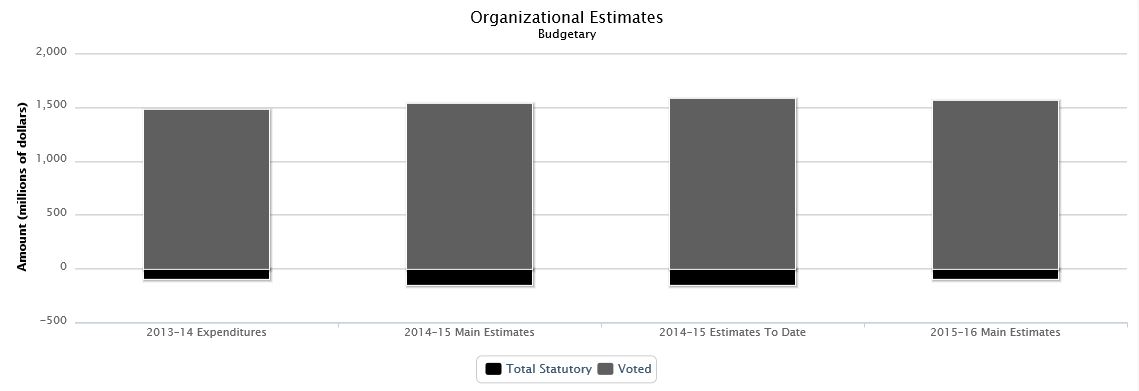
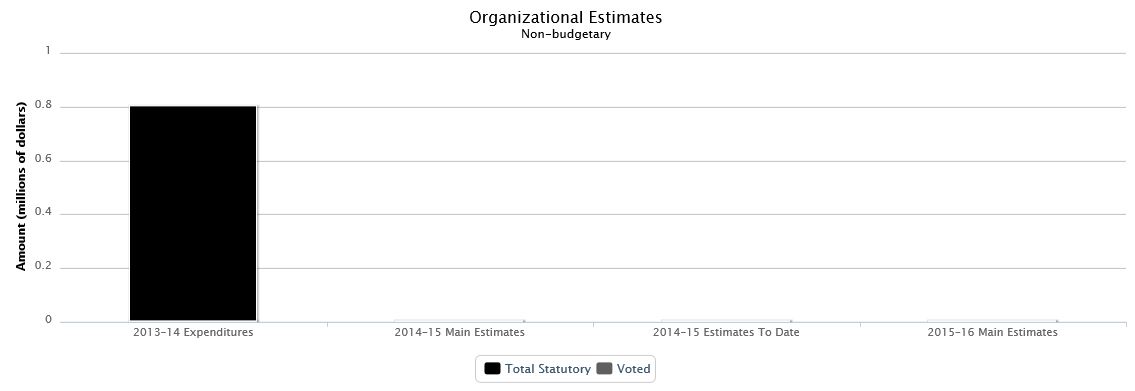
| 2013–14 Expenditures | 2014–15 Main Estimates | 2014–15 Estimates To Date | 2015–16 Main Estimates | ||
|---|---|---|---|---|---|
| Budgetary | |||||
| Voted | |||||
| 1 | Operating expenditures | 521,744,743 | 556,389,499 | 571,736,404 | 566,527,428 |
| 5 | Grants and contributions | 956,179,457 | 976,456,536 | 1,000,063,019 | 993,529,386 |
| - | Write-off outstanding immigration loans | 0 | 0 | 1,145,251 | 0 |
| - | Debt write-off – Immigration loans | 798,855 | 0 | 0 | 0 |
| Total voted | 1,478,723,055 | 1,532,846,035 | 1,572,944,674 | 1,560,056,814 | |
| Total Statutory | (100,028,360) | (147,404,972) | (147,909,083) | (95,389,806) | |
| Total budgetary | 1,378,694,695 | 1,385,441,063 | 1,425,035,591 | 1,464,667,008 | |
| Non-budgetary | |||||
| Total Statutory | 802,804 | 0 | 0 | 0 | |
| Total non-budgetary | 802,804 | 0 | 0 | 0 | |
Highlights
CIC's budgetary Main Estimates for 2015–16 of $1,464.7 million, represent a net increase of $79.2million from the previous year.
The following are the highlights of this change:
- An increase of $52.0 million due to statutory adjustments related to the Passport Canada revolving fund;
- An increase of $20.6 million to the Grant for the Canada-Quebec Accord on immigration;
- An increase of $16.5 million in statutory funding for the refund of fees for certain terminated applications for the Immigrant Investor Program and Entrepreneur Program;
- An increase of $15.0 million to implement and perform the Electronic Travel Authorization (ETA) program commitment under the Perimeter Security and Economic Competitiveness Action Plan;
- An increase of $5.7 million in new funding to implement the Express Entry solution for select economic classes of the permanent resident stream;
- An increase of $3.8 million due to employee benefit plan costs and other minor adjustments;
- A decrease of $17.8 million in statutory funding for the refund of fees for certain terminated applications for the Foreign Skilled Worker program;
- A decrease of $6.1 million in funding for the Citizenship and Temporary Resident programs;
- A decrease of $4.7 million in funding for the reform of Canada's Refugee system;
- A decrease of $3.0 million for contribution funding under the Global Assistance for Irregular Migrants Program to support Canada's Migrant Smuggling Prevention Strategy; and,
- A decrease of $2.7 million in funding to manage immigration cases involving classified information.
Further information can be found in the Report on Plans and Priorities at: http://www.cic.gc.ca/english/resources/publications/rpp/index.asp
Expenditures by Strategic Outcome and Program
| 2013–14 Expenditures | 2014–15 Main Estimates | 2015–16 Main Estimates | |
|---|---|---|---|
| Newcomers and citizens participate in fostering an integrated society. | |||
| Newcomer Settlement and Integration | 970,807,076 | 1,002,954,353 | 1,014,017,140 |
| Citizenship for Newcomers and All Canadians | 62,517,787 | 109,789,678 | 68,062,779 |
| Multiculturalism for Newcomers and All Canadians | 9,793,615 | 13,208,032 | 13,049,066 |
| Migration of permanent and temporary residents that strengthens Canada's economy. | |||
| Permanent Economic Residents | 79,311,817 | 80,799,944 | 99,145,934 |
| Temporary Economic Residents | 20,831,035 | 34,918,556 | 24,278,038 |
| Family and humanitarian migration that reunites families and offers protection to the displaced and persecuted. | |||
| Family and Discretionary Immigration | 44,096,198 | 46,863,229 | 37,572,058 |
| Refugee Protection | 28,698,237 | 35,205,049 | 30,059,852 |
| Managed migration and facilitated travel that promote Canadian interests and protect the health, safety and security of Canadians. | |||
| Migration Control and Security Management | 93,642,100 | 84,966,649 | 124,537,482 |
| Health Protection | 38,115,873 | 58,356,894 | 63,217,689 |
| Canadian Influence in International Migration and Integration Agenda | 5,616,646 | 8,156,032 | 5,177,541 |
| Passport | (206,332,014) | (254,192,238) | (202,153,477) |
| The following program supports all strategic outcomes within this organization. | |||
| Internal Services | 231,596,325 | 164,414,885 | 187,702,906 |
| Total | 1,378,694,695 | 1,385,441,063 | 1,464,667,008 |
| 2013–14 Expenditures | 2014–15 Main Estimates | 2015–16 Main Estimates | |
|---|---|---|---|
| Newcomers and citizens participate in fostering an integrated society. | |||
| Newcomer Settlement and Integration | 802,804 | 0 | 0 |
| Total | 802,804 | 0 | 0 |
Listing of the 2015–16 Transfer Payments
| 2013–14 Expenditures | 2014–15 Main Estimates | 2015–16 Main Estimates | |
|---|---|---|---|
| Grants | |||
| Grant for the Canada-Quebec Accord on Immigration | 319,967,000 | 319,967,000 | 340,568,000 |
| Grants in support of the Multiculturalism Program | 2,005,634 | 3,000,000 | 3,000,000 |
| Grant for Migration Policy Development | 348,707 | 350,000 | 350,000 |
| Contributions | |||
| Settlement Program | 572,212,198 | 588,197,002 | 588,597,002 |
| Resettlement Assistance | 51,163,272 | 54,922,768 | 54,922,768 |
| Contributions in support of the Multiculturalism Program | 4,576,187 | 5,521,316 | 4,593,166 |
| International Organization for Migration | 1,716,884 | 1,454,000 | 1,454,000 |
| Task Force for International Cooperation on Holocaust Education, Remembrance and Research | 45,114 | 44,450 | 44,450 |
Civilian Review and Complaints Commission for the Royal Canadian Mounted Police
Raison d'être
The Civilian Review and Complaints Commission for the Royal Canadian Mounted Police (the Commission) is an independent agency created by Parliament and is not part of the Royal Canadian Mounted Police (RCMP). The Commission's fundamental role is to provide civilian review of the conduct of the RCMP members in carrying out their policing duties, thereby holding the RCMP accountable to the public. The Commission ensures that complaints about the conduct of RCMP members are examined fairly and impartially. Its findings and recommendations help identify and remedy policing problems which stem from the conduct of individual RCMP members or from deficiencies in RCMP policies or practices. The Commission also conducts reviews of specified RCMP activities, reports to provinces which contract RCMP services, conducts research, program outreach and public education, and provides independent observers to investigations of serious incidents involving RCMP members.
The Minister of Public Safety and Emergency Preparedness is responsible for this organization.
Organizational Estimates
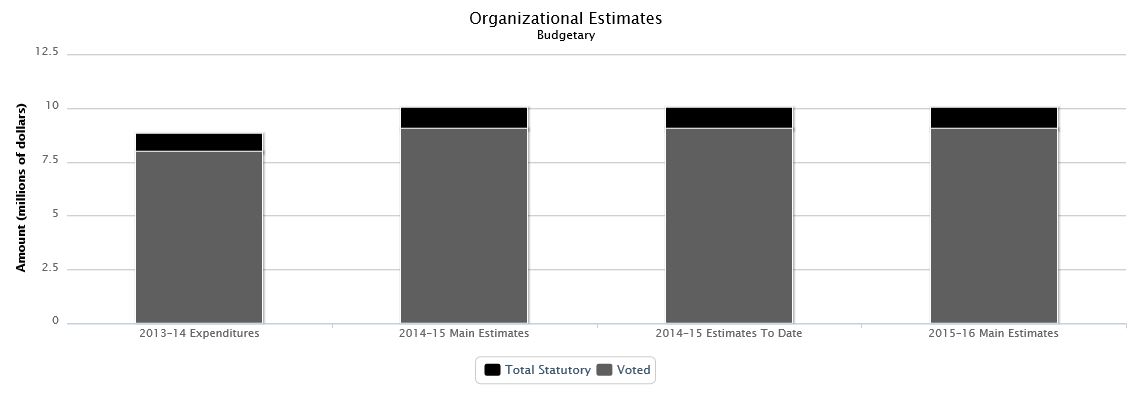
| 2013–14 Expenditures | 2014–15 Main Estimates | 2014–15 Estimates To Date | 2015–16 Main Estimates | ||
|---|---|---|---|---|---|
| Budgetary | |||||
| Voted | |||||
| 1 | Program expenditures | 7,958,517 | 9,049,115 | 9,049,115 | 9,032,529 |
| Total voted | 7,958,517 | 9,049,115 | 9,049,115 | 9,032,529 | |
| Total Statutory | 831,317 | 961,267 | 961,267 | 979,194 | |
| Total budgetary | 8,789,834 | 10,010,382 | 10,010,382 | 10,011,723 | |
Highlights
The Commission is estimating budgetary expenditures of $10.0 million in 2015–16. Of this amount, $9.0 million requires approval by Parliament. The remaining $979 thousand represents statutory authorities that do not require additional approval and are provided for information purposes.
The Commission's expenditures have remained the same from the previous year.
In 2015–16, the Commission will continue to identify and address the policing issues of daily concern to Canadians. The Commission will examine the conduct of RCMP members in relation to specific complaints and monitor wider trends and developments in RCMP policy and practices. The Commission will provide recommendations that enhance the accountability of the RCMP and contribute to the public's trust and confidence in the RCMP and its members. The Commission will assume new responsibilities outlined in the Enhancing Royal Canadian Mounted Police Accountability Act, which include conducting reviews of specified RCMP activities, providing enhanced reporting to provinces which contract for RCMP services and conducting research and outreach.
Details on our priorities will be made available in our 2015–16 Report on Plans and Priorities.
Expenditures by Strategic Outcome and Program
| 2013–14 Expenditures | 2014–15 Main Estimates | 2015–16 Main Estimates | |
|---|---|---|---|
| Public Confidence in the RCMP. | |||
| Civilian review of RCMP membersʼ conduct in the performance of their duties | 4,361,336 | 6,206,437 | 6,307,346 |
| The following program supports all strategic outcomes within this organization. | |||
| Internal Services | 4,428,498 | 3,803,945 | 3,704,377 |
| Total | 8,789,834 | 10,010,382 | 10,011,723 |
Commissioner for Federal Judicial Affairs
Raison d'être
The Office of the Commissioner for Federal Judicial Affairs (FJA) provides services to the Canadian judiciary and promotes judicial independence. The Minister of Justice is responsible for this organization.
Organizational Estimates
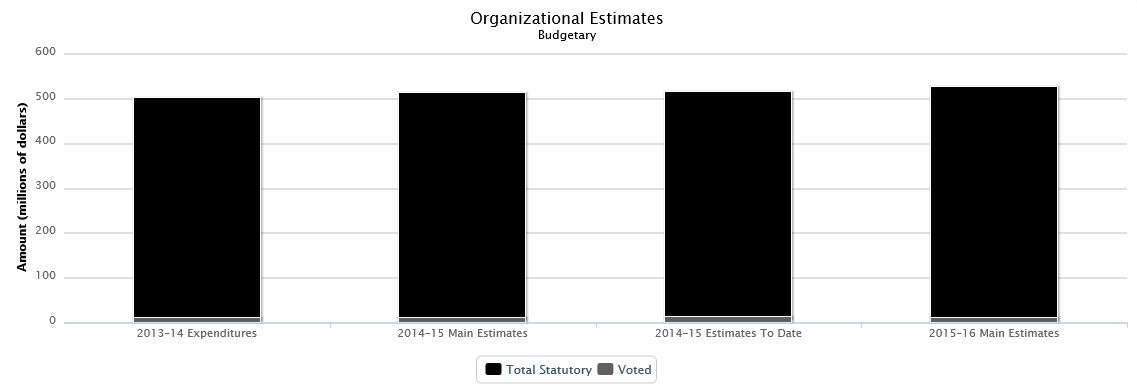
| 2013–14 Expenditures | 2014–15 Main Estimates | 2014–15 Estimates To Date | 2015–16 Main Estimates | ||
|---|---|---|---|---|---|
| Budgetary | |||||
| Voted | |||||
| 1 | Commissioner for Federal Judicial Affairs – Operating expenditures | 8,552,642 | 8,643,425 | 8,709,844 | 7,942,728 |
| 5 | Canadian Judicial Council – Operating expenditures | 1,526,534 | 1,513,611 | 3,113,611 | 1,513,611 |
| Total voted | 10,079,176 | 10,157,036 | 11,823,455 | 9,456,339 | |
| Total Statutory | 491,263,105 | 501,551,810 | 501,551,810 | 515,394,781 | |
| Total budgetary | 501,342,281 | 511,708,846 | 513,375,265 | 524,851,120 | |
Highlights
FJA is estimating budgetary expenditures of $524.9 million in 2015–16. Of this amount, $9.5 million requires approval by Parliament. The remaining $515.4 million represents statutory forecasts that do not require additional approval and are provided for information purposes.
The total spending for the department shows a continual increase over the planning period.
A net increase of $13.1 million in statutory forecast from the 2014–15 Main Estimates is due to an increase in the number of judicial appointments, an increase in the overall average in the amounts of pensions being paid to pensioners in accordance with the Judges Act, as well as a provision for a salary increase to federally appointed judges.
Please refer to the 2015–16 Report on Plans and Priorities for additional information.
Expenditures by Strategic Outcome and Program
| 2013–14 Expenditures | 2014–15 Main Estimates | 2015–16 Main Estimates | |
|---|---|---|---|
| An independent and efficient Federal Judiciary. | |||
| Payments Pursuant to the Judges Act | 490,350,437 | 500,885,033 | 514,430,443 |
| Federal Judicial Affairs | 8,455,757 | 8,454,448 | 7,994,262 |
| Canadian Judicial Council | 1,681,809 | 1,642,565 | 1,699,615 |
| The following program supports all strategic outcomes within this organization. | |||
| Internal Services | 854,278 | 726,800 | 726,800 |
| Total | 501,342,281 | 511,708,846 | 524,851,120 |
Communications Security Establishment
Raison d'être
As mandated by the National Defence Act, the Communications Security Establishment's (CSE) Signals Intelligence program provides foreign intelligence that addresses the Government of Canada's vital interests in defence, security, and international affairs through the collection, processing, analysis and reporting of intelligence. The Signals Intelligence program also helps protect the electronic information and information infrastructures of importance to the Government of Canada, and provides technical and operational assistance to federal law enforcement and security agencies.
CSE's Information Technology Security program provides advice, guidance, and services to help ensure the protection of electronic information and information systems of importance to the Government of Canada.
The Minister of National Defence is responsible for CSE.
Organizational Estimates
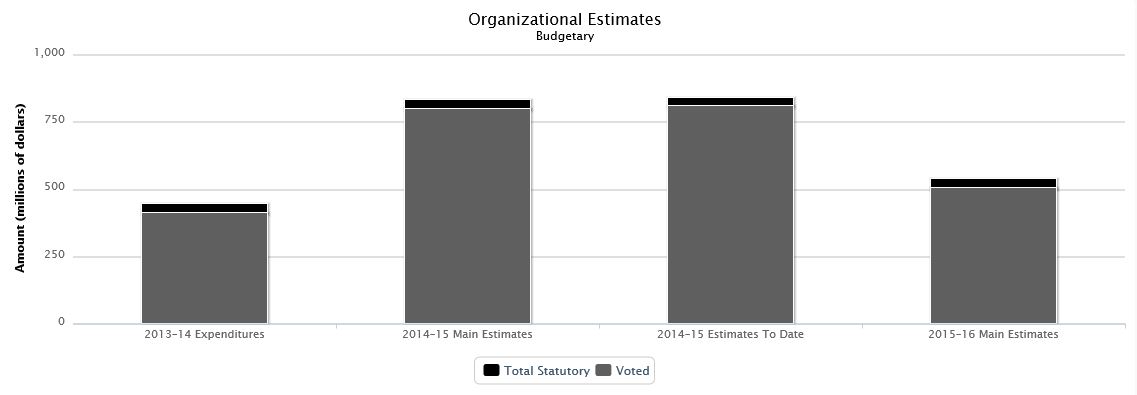
| 2013–14 Expenditures | 2014–15 Main Estimates | 2014–15 Estimates To Date | 2015–16 Main Estimates | ||
|---|---|---|---|---|---|
| Budgetary | |||||
| Voted | |||||
| 1 | Program expenditures | 409,487,182 | 796,802,239 | 807,326,873 | 503,831,701 |
| Total voted | 409,487,182 | 796,802,239 | 807,326,873 | 503,831,701 | |
| Total Statutory | 34,185,863 | 32,329,679 | 32,513,866 | 34,370,029 | |
| Total budgetary | 443,673,045 | 829,131,918 | 839,840,739 | 538,201,730 | |
Highlights
The CSE is estimating budgetary expenditures of $538.2 million in 2015–16. Of this amount, $503.8 million requires approval of Parliament. The remaining $34.4 million represents statutory forecasts that do not require additional approval and are provided for information purposes.
The Main Estimates for the department are $538.2 million, a net decrease of $290.9 million. The major changes are as follows:
- Following delivery of CSE's new facility in 2014–15 and its associated one-time contract costs, there is a combined reduction in funding of $306.7 million for operating and accommodations for 2015–16;
- A decrease of $0.3 million in compliance with government-wide transfers and reductions; and
- An increase of $16.1 million in support of CSE's mandate.
Expenditures by Strategic Outcome and Program
| 2013–14 Expenditures | 2014–15 Main Estimates | 2015–16 Main Estimates | |
|---|---|---|---|
| Foreign signals intelligence and technical security capabilities advance and protect Canada's vital interests. | |||
| Signals Intelligence | 302,063,349 | 598,535,605 | 388,225,246 |
| Information Technology (IT) Security | 141,609,696 | 230,596,313 | 149,976,484 |
| Total | 443,673,045 | 829,131,918 | 538,201,730 |
Copyright Board
Raison d'être
The Copyright Board is an economic regulatory body empowered to establish, either mandatorily or at the request of an interested party, the royalties to be paid for the use of copyrighted works, when the administration of such copyright is entrusted to a collective-administration society. The Board also has the right to supervise agreements between users and licensing bodies and issues licences when the copyright owner cannot be located.
The Minister of Industry is responsible for this organization.
Organizational Estimates
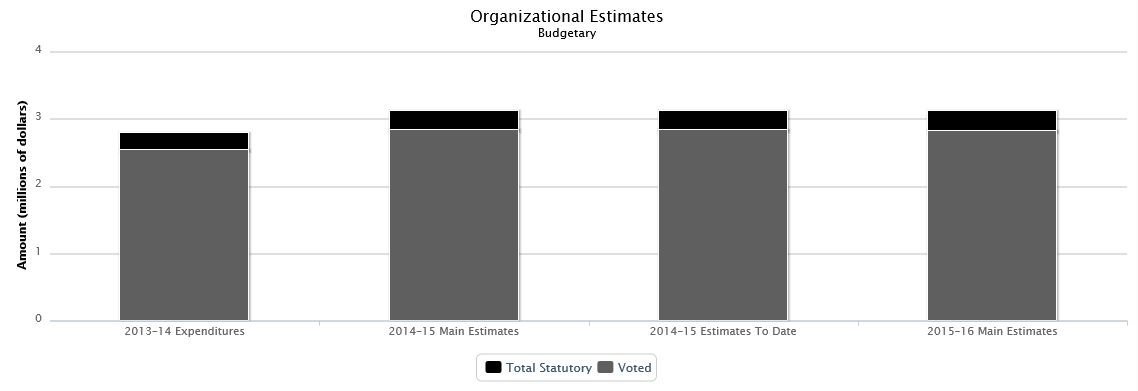
| 2013–14 Expenditures | 2014–15 Main Estimates | 2014–15 Estimates To Date | 2015–16 Main Estimates | ||
|---|---|---|---|---|---|
| Budgetary | |||||
| Voted | |||||
| 1 | Program expenditures | 2,531,986 | 2,829,969 | 2,829,969 | 2,818,917 |
| Total voted | 2,531,986 | 2,829,969 | 2,829,969 | 2,818,917 | |
| Total Statutory | 247,686 | 286,343 | 286,343 | 291,796 | |
| Total budgetary | 2,779,672 | 3,116,312 | 3,116,312 | 3,110,713 | |
Highlights
The Copyright Board of Canada is estimating budgetary expenditures of $3.1 million in 2015–16. Of this amount, $2.8 million require approval by Parliament and the remaining $291.8 thousand represents statutory forecasts that do not require additional approval and are provided for information purposes.
The Copyright Board of Canada will continue to ensure balanced decision-making and provide proper incentive for the creation and use of copyright works. The Board will also examine possible avenues to improve its practices and procedures, with the aim of streamlining them and reduce uncertainty, while safeguarding fairness of process.
Expenditures by Strategic Outcome and Program
| 2013–14 Expenditures | 2014–15 Main Estimates | 2015–16 Main Estimates | |
|---|---|---|---|
| Fair decision-making to provide proper incentives for the creation and use of copyrighted works. | |||
| Copyright Tariff Setting and Issuance of Licences | 2,251,535 | 2,524,213 | 2,519,678 |
| The following program supports all strategic outcomes within this organization. | |||
| Internal Services | 528,137 | 592,099 | 591,035 |
| Total | 2,779,672 | 3,116,312 | 3,110,713 |
Correctional Service of Canada
Raison d'être
The Minister of Public Safety and Emergency Preparedness is responsible for the Correctional Service of Canada.
The purpose of the federal correctional system, as defined in law, is to contribute to the maintenance of a just, peaceful and safe society by carrying out sentences imposed by courts through the safe and humane custody and supervision of offenders; and by assisting the rehabilitation of offenders and their reintegration into the community as law-abiding citizens through the provision of programs in penitentiaries and in the community (Corrections and Conditional Release Act, s. 3).
The Correctional Service of Canada, as part of the criminal justice system and respecting the rule of law, contributes to public safety by actively encouraging and assisting offenders to become law-abiding citizens, while exercising reasonable, safe, secure and humane control.
Additional information can be found in the organization's Report on Plans and Priorities.
Organizational Estimates
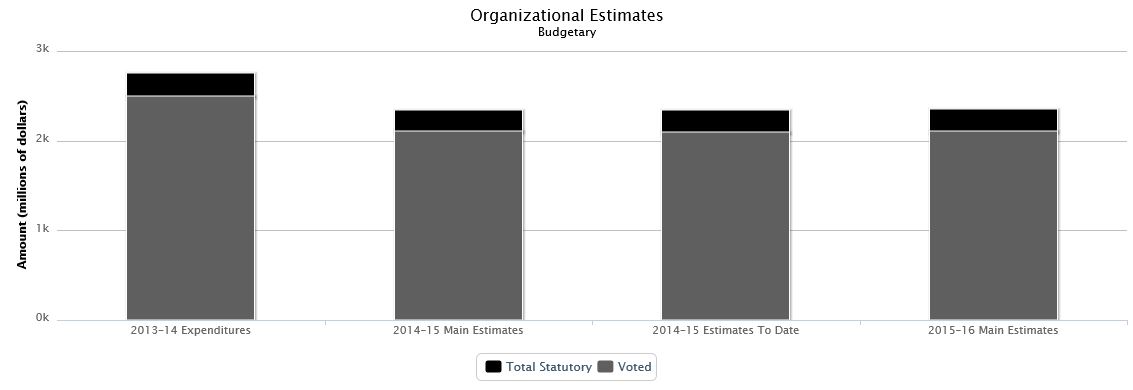
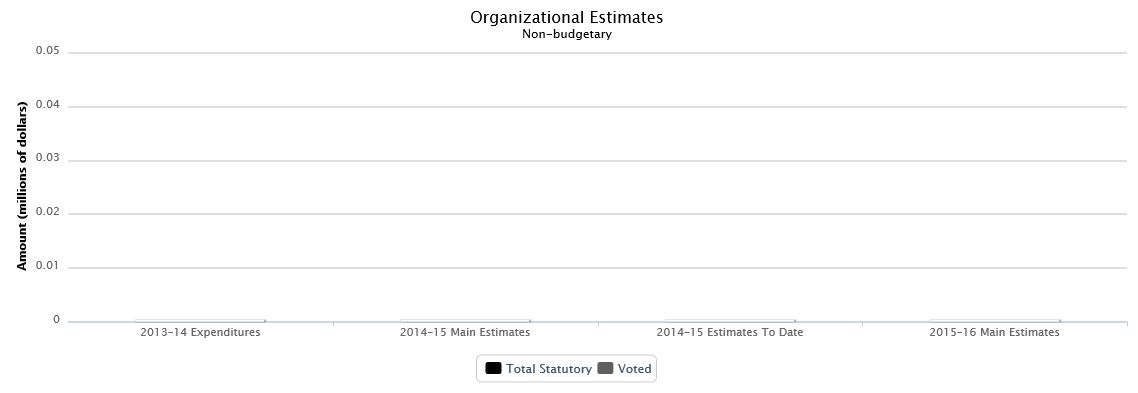
| 2013–14 Expenditures | 2014–15 Main Estimates | 2014–15 Estimates To Date | 2015–16 Main Estimates | ||
|---|---|---|---|---|---|
| Budgetary | |||||
| Voted | |||||
| 1 | Operating expenditures, grants and contributions | 2,116,015,356 | 1,913,020,536 | 1,914,586,608 | 1,928,746,713 |
| 5 | Capital expenditures | 378,371,594 | 184,244,519 | 179,030,339 | 176,944,519 |
| Total voted | 2,494,386,950 | 2,097,265,055 | 2,093,616,947 | 2,105,691,232 | |
| Total Statutory | 255,904,525 | 237,417,337 | 237,417,337 | 244,797,694 | |
| Total budgetary | 2,750,291,475 | 2,334,682,392 | 2,331,034,284 | 2,350,488,926 | |
| Non-budgetary | |||||
| Voted | |||||
| - | Loans to individuals under mandatory supervision and parolees through the Paroleesʼ Loan Account | 405 | 0 | 0 | 0 |
| Total voted | 405 | 0 | 0 | 0 | |
| Total non-budgetary | 405 | 0 | 0 | 0 | |
Highlights
The Correctional Service of Canada is estimating budgetary expenditures of $2,350.5 million in 2015–16. Of this amount, $2,105.7 million requires approval by Parliament. The remaining $244.8 million represents statutory forecasts that do not require additional approval and are provided for information purposes. This represents a net increase of $15.8 million from 2014–15 Main Estimates.
The major changes are as follows:
- A net increase of $20.8 million for signed collective agreements;
- A net increase of $7.4 million related to the allocation of the employer's share of the Employee Benefit Plan;
- An increase of $1.0 million related to additional funding from the Federal Contaminated Site Action Plan;
- An increase of $1.0 million for a reprofile of funds from 2014–15 to 2015–16 related to the National Infrastructure Contribution Program;
- A net decrease of $0.9 million for the transfer of consolidation of pay services to Public Works and Government Services;
- A decrease of $1.9 million related to the transfer to the Canada School of Public Service;
- A decrease of $3.9 million for the return of funds to the fiscal framework for the requirements related to the mandatory minimum penalties for serious drug offenders; and,
- A net decrease of $7.3 million in capital investments due to reduced requirements related to completion of the construction of new units and adjustments related to reprofiling of funds from previous years.
Expenditures by Strategic Outcome and Program
| 2013–14 Expenditures | 2014–15 Main Estimates | 2015–16 Main Estimates | |
|---|---|---|---|
| The custody, correctional interventions, and supervision of offenders in communities and in institutions, contribute to public safety. | |||
| Custody | 1,821,642,937 | 1,471,011,448 | 1,501,862,617 |
| Correctional Interventions | 463,803,680 | 465,029,970 | 410,155,772 |
| Community Supervision | 124,169,547 | 93,399,963 | 129,857,404 |
| The following program supports all strategic outcomes within this organization. | |||
| Internal Services | 340,675,311 | 305,241,011 | 308,613,133 |
| Total | 2,750,291,475 | 2,334,682,392 | 2,350,488,926 |
| 2013–14 Expenditures | 2014–15 Main Estimates | 2015–16 Main Estimates | |
|---|---|---|---|
| The custody, correctional interventions, and supervision of offenders in communities and in institutions, contribute to public safety. | |||
| Correctional Interventions | 405 | 0 | 0 |
| Total | 405 | 0 | 0 |
Listing of the 2015–16 Transfer Payments
| 2013–14 Expenditures | 2014–15 Main Estimates | 2015–16 Main Estimates | |
|---|---|---|---|
| Grants | |||
| Grant to the University of Saskatchewan College of Medicine for a psychiatric residency seat | 122,774 | 160,000 | 160,000 |
| Grant to the University of Saskatchewan for Forensic Research Centre | 120,000 | 122,000 | 122,000 |
| Contributions | |||
| Correctional Services of Canada's National Infrastructure Contribution Program | 0 | 4,700,000 | 5,680,000 |
Courts Administration Service
Raison d'être
The Courts Administration Service (CAS) was established in 2003 with the coming into force of the Courts Administration Service Act. The role of CAS is to provide effective and efficient judicial registry and corporate services to four superior courts of record – the Federal Court of Appeal, the Federal Court, the Court Martial Appeal Court of Canada and the Tax Court of Canada. The Act enhances judicial independence by placing administrative services at arm's length from the Government of Canada and enhances accountability for the use of public money.
The Minister of Justice is responsible for this organization.
Organizational Estimates
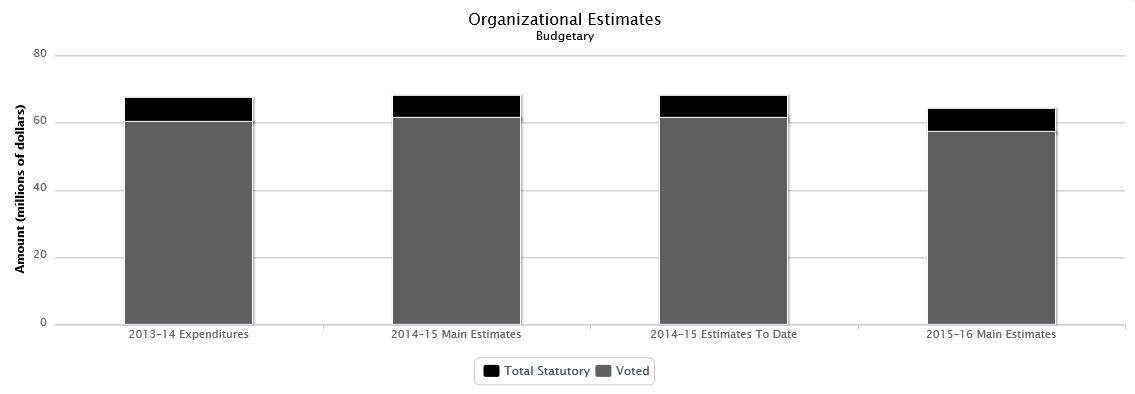
| 2013–14 Expenditures | 2014–15 Main Estimates | 2014–15 Estimates To Date | 2015–16 Main Estimates | ||
|---|---|---|---|---|---|
| Budgetary | |||||
| Voted | |||||
| 1 | Program expenditures | 60,297,478 | 61,260,445 | 61,260,445 | 57,320,466 |
| Total voted | 60,297,478 | 61,260,445 | 61,260,445 | 57,320,466 | |
| Total Statutory | 7,045,081 | 6,784,298 | 6,784,298 | 6,632,121 | |
| Total budgetary | 67,342,559 | 68,044,743 | 68,044,743 | 63,952,587 | |
Highlights
The CAS is estimating budgetary expenditures of $64.0 million in 2015–16. Of this amount, $57.3 million requires approval by Parliament. The remaining $6.6 million represents the statutory funding forecast that does not require additional approval and is provided for information purposes.
The core programs of the CAS have remained relatively constant over the years. Nevertheless, CAS' reference levels have been impacted by legislative changes affecting the workload of the federal courts as well as various government initiatives. The activities that have caused the majority of the variations in reference levels include:
- Division 9 proceedings of the IRPA aimed at addressing challenges in the management of security inadmissibility cases, protecting classified information in immigration proceedings, and obtaining diplomatic assurances of safety for inadmissible individuals facing a risk of torture;
- Introduction of changes to the refugee determination process established in Bill C-11 in 2010, An Act to amend the Immigration and Refugee Protection Act and the Federal Courts Act;
- A reprofile of funding from future fiscal years approved in 2011–12, to be repaid over five years, which enabled CAS to construct a new data centre and address information technology infrastructure rust-out; and,
- Savings identified as part of the Budget 2012 Spending Review.
The decrease in the 2015–16 Main Estimates compared to 2014–15 is mainly due to funding related to the Division 9 proceedings of the IRPA that sunsets in . Reallocations between programs have been made for 2015–16 based on the new Guide on Internal Services Expenditures.
In addition to the sunset funding mentioned above, the main variance from 2013–14 expenditures to 2015–16 Main Estimates is associated with funding for the implementation of Bill C-11, An Act to amend the Immigration and Refugee Protection Act and the Federal Courts Act. This funding is included within the Main Estimates, but related expenditures are contingent upon the appointment of judges. There have been two judicial appointments to date.
More details on important trends and variances can be found in the CAS 2015–16 Report on Plans and Priorities, as well as the Financial Statements Discussion and Analysis and the Quarterly Financial Reports.
Expenditures by Strategic Outcome and Program
| 2013–14 Expenditures | 2014–15 Main Estimates | 2015–16 Main Estimates | |
|---|---|---|---|
| The public has timely and fair access to the litigation processes of the Federal Court of Appeal, the Federal Court, the Court Martial Appeal Court of Canada and the Tax Court of Canada. | |||
| Registry Services | 25,014,862 | 26,673,348 | 23,937,466 |
| Judicial Services | 21,333,113 | 22,379,302 | 23,176,362 |
| The following program supports all strategic outcomes within this organization. | |||
| Internal Services | 20,994,584 | 18,992,093 | 16,838,759 |
| Total | 67,342,559 | 68,044,743 | 63,952,587 |
Economic Development Agency of Canada for the Regions of Quebec
Raison d'être
Under its Act, the Economic Development Agency of Canada for the Regions of Quebec's (the Agency) mission is to "promote the long-term economic development of the regions of Quebec by giving special attention to those where slow economic growth is prevalent or opportunities for productive employment are inadequate".
As part of its mission, the Agency promotes the start-up and performance of businesses. It helps them become more competitive, productive, innovative and active on domestic and foreign markets. It supports communities' engagement efforts in Quebec's regions and helps to attract investment that will increase the prosperity of the Quebec and Canadian economies.
The Agency works with businesses, primarily small and medium-sized enterprises, as well as non-profit organizations through its business offices. By providing financial assistance for projects, among other things, the Agency supports their development efforts.
The Minister of Infrastructure, Communities and Intergovernmental Affairs and the Minister of the Economic Development Agency of Canada for the Regions of Quebec is responsible for this organization.
Organizational Estimates
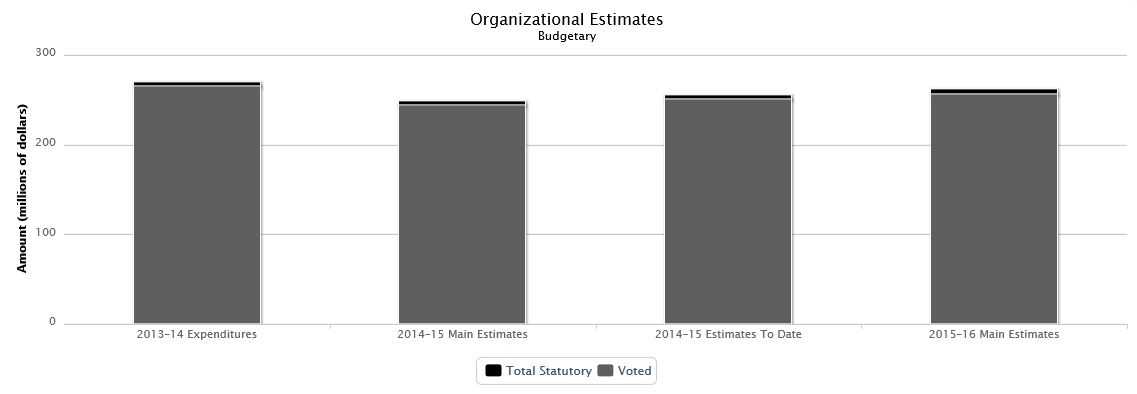
| 2013–14 Expenditures | 2014–15 Main Estimates | 2014–15 Estimates To Date | 2015–16 Main Estimates | ||
|---|---|---|---|---|---|
| Budgetary | |||||
| Voted | |||||
| 1 | Operating expenditures | 38,574,722 | 37,907,218 | 38,319,239 | 38,266,985 |
| 5 | Grants and contributions | 225,935,280 | 205,309,446 | 212,168,051 | 217,995,801 |
| Total voted | 264,510,002 | 243,216,664 | 250,487,290 | 256,262,786 | |
| Total Statutory | 4,795,815 | 4,623,953 | 4,623,953 | 4,819,408 | |
| Total budgetary | 269,305,817 | 247,840,617 | 255,111,243 | 261,082,194 | |
Highlights
The Agency's total budget for fiscal year 2015–16 amounts to $ 261.1 million. This budget will be used to for expenditures within its four program activities: business development, regional economic development, strengthening of community economies and internal services.
Compared to fiscal year 2014–15, the Agency's budget reflects an increase of $13.2 million (5.3%). Planned operating expenditures and statutory expenditures are stable between the two years. The main variation relates to grants and contributions planned expenditures, with an increase of $12.7 million dollars.
Overall, in 2015–16, the Lac-Mégantic Economic Recovery Initiative and the Initiative to Combat the Spruce Budworm account for $10.1million of the increase in spending on contributions.
Also, the amount reinvested in grants and contributions in 2015–16 from repayable contributions to Agency clients increased compared to the previous year by approximately $2.8 million.
Business Development: The Agency will continue to support business development by promoting entrepreneurship and business performance. To contribute to the economic growth of Quebec, one of the Agencyʼs priorities is to maintain and support business growth. More specifically, the Agency will support entrepreneurship by encouraging enterprise start-ups and pre-start-ups. It also works to enhance the competitiveness of enterprises by supporting their productivity and expansion, innovation and technology transfer, commercialization and export projects.
Regional economic development: The Agency will also continue to support regional economic development by encouraging the mobilization of regions with respect to their taking charge of their own economic development and by stimulating investments in all regions of Quebec. To do this, it will continue to support the regions in their efforts to acquire the facilities necessary to benefit from their assets in order to stimulate business and generate economic benefits. It will also add value to the promotion of regional assets in order to increase tourism spending and attract investment.
Strengthening of community economies: To strengthen the community economies, the Agency will continue to provide its support through the Community Futures Program. It will continue to act as Infrastructure Canadaʼs implementation partner for the management of programs dedicated to infrastructure for Quebec. Through specific initiatives, the Agency will continue to support economic activity in Quebec communities to stabilize or strengthen their economies. In addition, the Agency plans to continue in 2015–16, via one-time or targeted support, the delivery of two initiatives, the Economic Diversification Initiative for Quebec Communities dependent on the Chrysotile Industry and the Lac-Mégantic Economic Recovery Initiative.
Internal services: Internal Services are groups of related activities and resources managed to meet the needs of programs and other corporate obligations of the organization.
One of the Agency's priorities with regard to internal services, is to continue its modernization in order to improve its performance by:
- Improving the delivery of services to Canadians;
- Optimizing of internal processes and improving the tools available to its employees; and,
- Implementing concrete measures to build the Public Service of tomorrow.
Additional information regarding the authorities, mandate and programs of the Agency are available in the Report on Plans and Priorities.
Expenditures by Strategic Outcome and Program
| 2013–14 Expenditures | 2014–15 Main Estimates | 2015–16 Main Estimates | |
|---|---|---|---|
| Quebec's regions have a growing economy. | |||
| Business Development | 147,594,134 | 146,609,271 | 151,677,176 |
| Strengthening Community Economies | 64,286,545 | 38,816,648 | 53,720,902 |
| Regional Economic Development | 39,132,388 | 48,507,928 | 35,237,511 |
| The following program supports all strategic outcomes within this organization. | |||
| Internal Services | 18,292,750 | 13,906,770 | 20,446,605 |
| Total | 269,305,817 | 247,840,617 | 261,082,194 |
Listing of the 2015–16 Transfer Payments
| 2013–14 Expenditures | 2014–15 Main Estimates | 2015–16 Main Estimates | |
|---|---|---|---|
| Grants | |||
| Grants under the Quebec Economic Development Program | 16,504 | 1,650,000 | 1,650,000 |
| Contributions | |||
| Contributions under the Quebec Economic Development Program | 197,447,309 | 174,691,428 | 187,377,783 |
| Contributions under the Community Futures Program | 28,471,467 | 28,968,018 | 28,968,018 |
Employment and Social Development
Raison d'être
The mission of Employment and Social Development Canada (ESDC), including the Labour Program and Service Canada, is to build a stronger and more competitive Canada, to support Canadians in making choices that help them live productive and rewarding lives, and to improve Canadians' quality of life. ESDC delivers a range of programs and services that affect Canadians throughout their lives.
ESDC provides seniors with basic income security, supports unemployed workers, helps students finance their post-secondary education, and assists parents who are raising young children. The Labour Program is responsible for labour laws and policies in federally regulated workplaces. Service Canada helps citizens access ESDC 's programs, as well as other Government of Canada programs and services. Additional information can be found in the organization's Report on Plan and Priorities.
Organizational Estimates
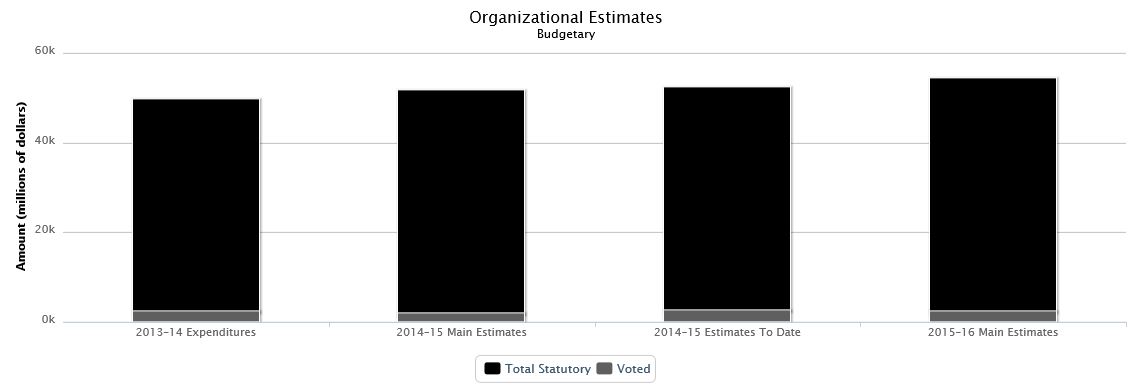
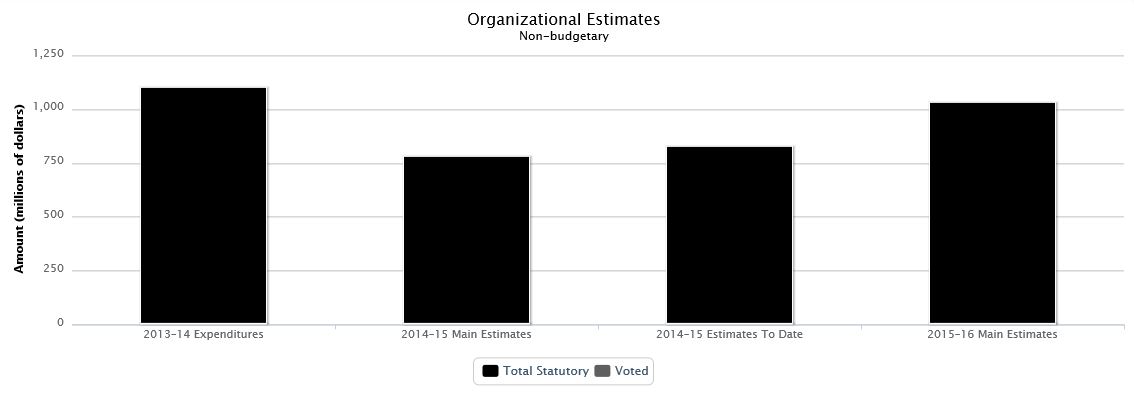
| 2013–14 Expenditures | 2014–15 Main Estimates | 2014–15 Estimates To Date | 2015–16 Main Estimates | ||
|---|---|---|---|---|---|
| Budgetary | |||||
| Voted | |||||
| 1 | Operating expenditures | 645,699,959 | 571,067,134 | 595,942,784 | 561,409,860 |
| 5 | Grants and contributions | 1,697,786,241 | 1,227,675,995 | 1,755,397,995 | 1,712,658,484 |
| - | Debt write-off – Canada Student Loans | 0 | 0 | 294,647,678 | 0 |
| Total voted | 2,343,486,200 | 1,798,743,129 | 2,645,988,457 | 2,274,068,344 | |
| Total Statutory | 47,303,426,321 | 49,872,029,598 | 49,548,277,143 | 51,991,467,772 | |
| Total budgetary | 49,646,912,521 | 51,670,772,727 | 52,194,265,600 | 54,265,536,116 | |
| Non-budgetary | |||||
| Total Statutory | 1,099,875,159 | 779,981,475 | 826,283,289 | 1,027,422,531 | |
| Total non-budgetary | 1,099,875,159 | 779,981,475 | 826,283,289 | 1,027,422,531 | |
Highlights
ESDC is planning budgetary expenditures on programs and services totaling $54.3 billion in 2015–16, of which $51.6 billion, or more than 95%, will directly benefit Canadians through the Old Age Security Program, the Universal Child Care Benefit and other statutory transfer payment programs.
Of the total amount of planned expenditures, $2.3 billion requires approval from Parliament. The remaining $52.0 billion represents statutory forecasts that do not require additional approval and are provided for information purposes.
The 2015–16 planned spending represents an increase of $4.6 billion, or approximately 9.3%, when compared to the 2013–14 actual budgetary expenditures of $49.6 billion. This increase is mostly explained by an increase to Old Age Security and Guaranteed Income Supplement payments resulting from the aging population and the planned increase in the average monthly benefit amount.
When compared to the 2014–15 budgetary Main Estimates of $51.7 billion, the 2015–16 planned expenditures represent a net increase of $2.6 billion.
This increase is primarily associated with statutory items. In particular, the forecasted Old Age Security and Guaranteed Income Supplement payments total $45.5 billion and represent an increase of $1.4 billion and $483 million respectively, explained by changes in the average rates of payment and in the number of beneficiaries. Other factors contributing to the increase include:
- A $83.9 million increase to the Canada Disability Savings Grants and Bonds which is due to a steady increase in total registered plans and participation in the program;
- An increase of $77.4 million in the payments related to the direct financing arrangement under the Canada Student Financial Assistance Act mainly due to an increase to repayment assistance costs that consider the latest Office of Chief Actuary projections for borrowers in repayment;
- An increase of $33.5 million in the Canada Student Grants to qualifying full and part-time students pursuant to the Canada Student Financial Assistance Act attributed to the growth rate assumption from the Office of Chief Actuary;
- An increase of $32.4 million to the Universal Child Care Benefit (UCCB) based on an increased number of children entitled to the benefit. The above amounts do not include the proposed enhancements to the UCCB that are subject to parliamentary approval; and
- An increase of $27.0 million in Canada Education Savings Grant payments due to more families saving for their children's post-secondary education.
Changes to Vote 1 and Vote 5 are as follows:
- In terms of Vote 1 – Operating expenditures, the department plans to spend $561.4 million in 2015–16. This represents a decrease of
$9.7 million from 2014–15 Main Estimates of $571.1 million. The net decrease is mainly attributable to planned sunsetting of programs and resources, and transfers to other Government Departments. - As for Vote 5 – Grants and Contributions, the 2015–16 Main Estimates is $1,712.7 million, an increase of $485.0 million from the 2014–15 Main Estimates. This increase is mainly attributable to the inclusion of funding for the Canada Job Fund (CJF) agreements. In 2014–15, this funding was included in Supplementary Estimates. The total annual amount of $500 million for the CJF agreements is included in the 2015–16 Main Estimates.
Expenditures by Strategic Outcome and Program
| 2013–14 Expenditures | 2014–15 Main Estimates | 2015–16 Main Estimates | |
|---|---|---|---|
| Income security, access to opportunities and well-being for individuals, families and communities. | |||
| Income Security | 42,094,313,717 | 44,557,391,657 | 46,624,099,750 |
| Social Development | 2,992,414,508 | 3,052,032,587 | 3,081,658,183 |
| A skilled, adaptable and inclusive labour force and an efficient labour market. | |||
| Learning | 2,194,548,765 | 2,235,678,253 | 2,391,384,094 |
| Skills and Employment | 1,614,076,687 | 1,159,480,484 | 1,706,013,120 |
| Safe, fair and productive workplaces and cooperative workplace relations. | |||
| Labour | 143,416,411 | 154,124,966 | 160,715,470 |
| Government-Wide Service Excellence. | |||
| Service Network Supporting Government Departments | 0 | 0 | 56,013,514 |
| Delivery of Services for Other Government of Canada Programs | 0 | 0 | 22,389,992 |
| The following program supports all strategic outcomes within this organization. | |||
| Internal Services | 321,838,603 | 224,942,258 | 223,261,993 |
| Funds not allocated to the 2015–16 Program Alignment Architecture | 286,303,830 | 287,122,522 | 0 |
| Total | 49,646,912,521 | 51,670,772,727 | 54,265,536,116 |
| 2013–14 Expenditures | 2014–15 Main Estimates | 2015–16 Main Estimates | |
|---|---|---|---|
| A skilled, adaptable and inclusive labour force and an efficient labour market. | |||
| Learning | 1,099,875,159 | 779,981,475 | 1,027,422,531 |
| Total | 1,099,875,159 | 779,981,475 | 1,027,422,531 |
Listing of the 2015–16 Transfer Payments
| 2013–14 Expenditures | 2014–15 Main Estimates | 2015–16 Main Estimates | |
|---|---|---|---|
| Grants | |||
| Apprenticeship Grants | 96,900,000 | 114,552,200 | 114,552,200 |
| New Horizons for Seniors Program | 34,011,689 | 36,340,000 | 41,340,000 |
| Grants to not-for-profit, for-profit, and aboriginal organizations, municipal, provincial and territorial governments for adult learning, literacy and essential skills | 175,881 | 18,300,000 | 18,300,000 |
| Grants to non-profit organizations for activities eligible for support through the Social Development Partnerships Program | 6,515,103 | 14,775,000 | 14,775,000 |
| Enabling Accessibility Fund Small Projects Grant | 8,703,012 | 13,650,000 | 13,650,000 |
| Federal Income Support for Parents of Murdered or Missing Children | 70,490 | 10,000,000 | 10,000,000 |
| Pathways to Education Canada Grant | 0 | 0 | 6,000,000 |
| Labour Funding Program | 1,167,982 | 1,703,000 | 1,703,000 |
| Grants to not-for-profit organizations, individuals, municipal governments, Band/tribal councils and other Aboriginal organizations, public health and educational institutions, Régies régionales, for-profit enterprises, research organizations and research institutes to carry out research on homelessness to help communities better understand and more effectively address homelessness issues | 304,677 | 250,000 | 250,000 |
| Named grants for the Organization for Economic Co-operation and Development | 79,944 | 100,000 | 100,000 |
| Total Statutory | 46,458,727,144 | 49,026,537,240 | 51,057,118,525 |
| Contributions | |||
| Payments to provinces, territories, municipalities, other public bodies, organizations, groups, communities, employers and individuals for the provision of training and/or work experience, the mobilization of community resources, and human resource planning and adjustment measures necessary for the efficient functioning of the Canadian labour market | 568,384,907 | 635,962,672 | 590,945,161 |
| Contributions to not-for-profit organizations, individuals, municipal governments, Band/tribal councils and other Aboriginal organizations, public health and educational institutions, Régies régionales, for-profit enterprises, research organizations and research institutes to support activities to help alleviate and prevent homelessness across Canada and to carry out research on homelessness to help communities better understand and more effectively address homelessness issues | 148,192,686 | 108,050,000 | 105,050,000 |
| Contributions to provincial/territorial governments, band councils, tribal councils, Aboriginal Skills and Employment Training Strategy agreement holders, municipal governments, not-for-profit organizations, professional associations, business and private sector organizations, consortia, industry groups, unions, regulatory bodies, ad-hoc associations, public health institutions, school boards, universities, colleges, CEGEPs, sector councils, and cross-sectoral councils to support enhanced productivity and competitiveness of Canadian workplaces by supporting investment in and recognition and utilization of skills | 13,076,885 | 27,144,123 | 27,144,123 |
| Contributions to assist unemployed older workers in communities with ongoing high unemployment and/or affected by downsizing | 32,167,196 | 0 | 24,000,000 |
| Contributions to organizations to support the development of human resources, economic growth, job creation and retention in official language minority communities | 11,999,780 | 12,000,000 | 12,000,000 |
| Payments to provinces, territories, municipalities, other public bodies, organizations, groups, communities, employers and individuals for the provision of training and/or work or business experience, the mobilization of community resources and human resource planning and adjustment measures necessary for the social development of Canadians and other participants in Canadian life | 7,478,802 | 5,840,000 | 5,840,000 |
| Contributions to not-for-profit, for-profit, and aboriginal organizations, municipal, provincial and territorial governments for adult learning, literacy and essential skills | 14,692,171 | 5,209,000 | 3,209,000 |
| Payments to non-profit organizations to develop national or provincial/territorial/regional educational and awareness activities to help reduce the incidence of elder abuse and fraud | 3,814,554 | 1,800,000 | 1,800,000 |
| Total Statutory | 457,243,787 | 478,441,676 | 560,301,287 |
| Other Transfer Payments | |||
| Payments to provinces and territories to deliver employment programs and services under the Canada Job Fund and under the Labour Market Agreements | 530,713,000 | 0 | 500,000,000 |
| Payments to provinces and territories under the Multilateral Framework for Labour Market Agreements for Persons with Disabilities | 218,251,611 | 222,000,000 | 222,000,000 |
Enterprise Cape Breton Corporation
Raison d'être
Economic Action Plan 2014 Act, No. 1 dissolved Enterprise Cape Breton Corporation (ECBC), effective . The economic and community development activities of ECBC and its associated budget have been transitioned over to the Atlantic Canada Opportunities Agency. Other ECBC activities such as real property holdings, environmental remediation of former mine sites, and human resources obligations of the former Cape Breton Development Corporation are now overseen by Public Works and Government Services Canada
Organizational Estimates
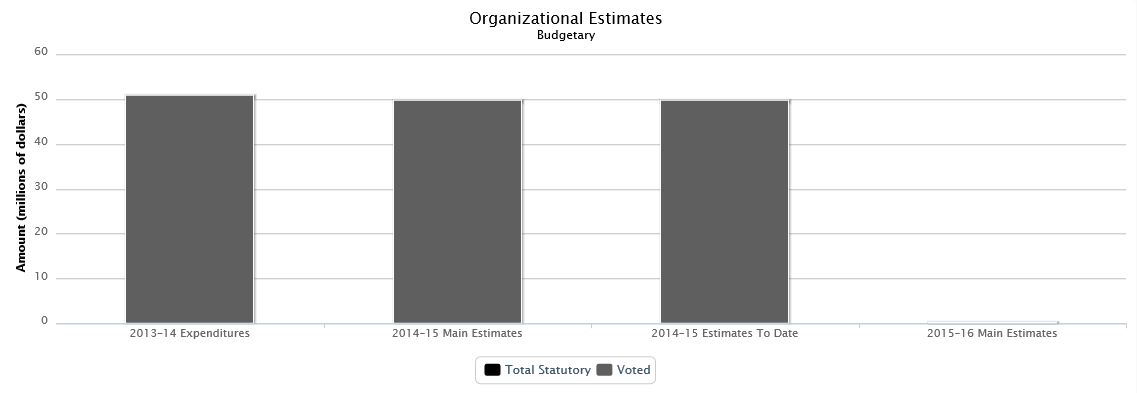
| 2013–14 Expenditures | 2014–15 Main Estimates | 2014–15 Estimates To Date | 2015–16 Main Estimates | ||
|---|---|---|---|---|---|
| Budgetary | |||||
| Voted | |||||
| - | Payments to the Enterprise Cape Breton Corporation | 50,844,000 | 49,536,000 | 49,536,000 | 0 |
| Total voted | 50,844,000 | 49,536,000 | 49,536,000 | 0 | |
| Total budgetary | 50,844,000 | 49,536,000 | 49,536,000 | 0 | |
Highlights
Not applicable
Expenditures by Strategic Outcome and Program
| 2013–14 Expenditures | 2014–15 Main Estimates | 2015–16 Main Estimates | |
|---|---|---|---|
| A competitive and sustainable Cape Breton economy. | |||
| Property Development | 0 | 2,400,000 | 0 |
| Commercial Development | 0 | 3,150,000 | 0 |
| Community Development | 0 | 1,460,000 | 0 |
| Policy and Advocacy | 0 | 250,000 | 0 |
| Environmental Stewardship | 0 | 8,692,000 | 0 |
| Human Resource Obligations | 0 | 32,194,000 | 0 |
| Regional Service Delivery | 0 | 0 | 0 |
| The following program supports all strategic outcomes within this organization. | |||
| Internal Services | 0 | 1,390,000 | 0 |
| Funds not allocated to the 2015–16 Program Alignment Architecture | 50,844,000 | 0 | 0 |
| Total | 50,844,000 | 49,536,000 | 0 |
Environment
Raison d'être
The Minister of the Environment is responsible for this organization.
Environment Canada is the lead federal department for a wide range of environmental issues affecting Canadians. The Department also plays a stewardship role in achieving and maintaining a clean, safe and sustainable environment. Environment Canada addresses issues through monitoring, research, policy development, service delivery to Canadians, regulations, enforcement of environmental laws, advancement of clean technologies and strategic partnerships. The Department's programs focus on a clean environment by minimizing threats to Canadians and their environment from pollution; a safe environment by equipping Canadians to make informed decisions on weather, water and climate conditions; and a sustainable environment by conserving and restoring Canada's natural environment. The Department's program focus reflects the increasingly evident interdependence between environmental sustainability and economic well-being.
Organizational Estimates
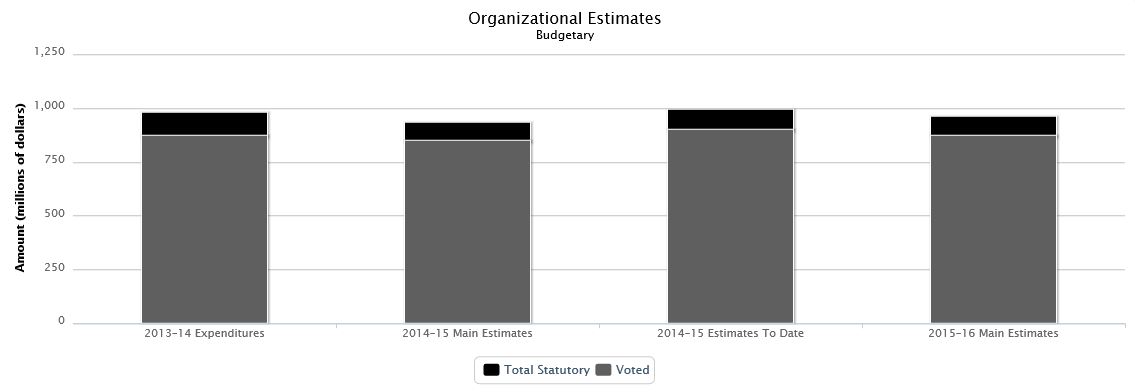
| 2013–14 Expenditures | 2014–15 Main Estimates | 2014–15 Estimates To Date | 2015–16 Main Estimates | ||
|---|---|---|---|---|---|
| Budgetary | |||||
| Voted | |||||
| 1 | Operating expenditures | 755,227,966 | 687,165,091 | 709,659,520 | 695,731,283 |
| 5 | Capital expenditures | 50,013,831 | 52,789,150 | 55,246,760 | 63,297,504 |
| 10 | Grants and contributions | 67,998,405 | 107,286,053 | 132,315,225 | 114,340,903 |
| Total voted | 873,240,202 | 847,240,294 | 897,221,505 | 873,369,690 | |
| Total Statutory | 105,709,346 | 84,927,036 | 95,660,076 | 87,681,386 | |
| Total budgetary | 978,949,548 | 932,167,330 | 992,881,581 | 961,051,076 | |
Highlights
The significant variance between Environment Canada's 2013–14 actual expenditures in the Public Accounts and the 2014–15 Main Estimates are mainly due to adjustments and transfers during the fiscal year. These include the operating and capital carry forwards, the reimbursement of paylist expenditures and the statutory payment to Nature Conservancy of Canada. These in-year changes will also be reflected in the 2014–15 Public Accounts.
Compared with the 2014–15 Main Estimates, Environment Canada's 2015–16 Main Estimates show a net planned spending increase of $28.9 million or 3.1% attributable to an increase of $8.6 million in Operating, $10.5 million in Capital, $7.1 million in Grants and Contributions and $2.7 million in the Employee Benefit Plan.
The major increases are:
- An increase in funding of $46.6 million to implement the National Conservation Plan;
- A net increase in funding of $20.1 million for the Canada's weather services;
- An increase in funding of $6.5 million for the second phase of a strategy to implement a world-class tanker safety system;
- An increase in funding of $5.3 million for the Clean Air Regulatory Agenda; and,
- An increase in funding of $3.9 million for the Federal Contaminated Sites Action Plan.
These increases are offset by a decrease of $53.5 million related to the following programs:
- A decrease in funding for Sustainable Development Technology Canada – Next Generation Biofuels Fund of $25.0 million and for Sustainable Development Technology Fund of $6.5 million;
- A decrease in funding of $12.5 million for the Species at Risk Act program;
- A decrease in funding of $5.0 million for the meteorological services and navigational warning services for defined regions of the Arctic Ocean;
- A decrease in funding of $2.3 million related to the Major Project Management Office initiative;
- A decrease in funding of $1.6 million related to the Great Lakes Nutrient initiative; and,
- Other small decreases totalling a net amount of $0.6 million.
For Estimates to date, please refer to the 2014–15 Supplementary Estimates (B) and (C).
For further details on trends, please refer to the Report on Plans and Priorities.
Expenditures by Strategic Outcome and Program
| 2013–14 Expenditures | 2014–15 Main Estimates | 2015–16 Main Estimates | |
|---|---|---|---|
| Canadaʼs natural environment is conserved and restored for present and future generations. | |||
| Biodiversity – Wildlife and Habitat | 120,519,001 | 91,592,394 | 122,779,285 |
| Water Resources | 100,322,337 | 91,196,857 | 95,770,859 |
| Sustainable Ecosystems | 70,727,194 | 92,013,642 | 91,480,613 |
| Compliance Promotion and Enforcement – Wildlife | 18,208,956 | 15,821,926 | 16,115,510 |
| Threats to Canadians and their environment from pollution are minimized. | |||
| Climate Change and Clean Air | 125,118,027 | 154,813,450 | 122,872,074 |
| Substances and Waste Management | 84,616,666 | 75,747,789 | 85,149,099 |
| Compliance Promotion and Enforcement – Pollution | 44,661,876 | 38,324,642 | 37,560,222 |
| Canadians are equipped to make informed decisions on changing weather, water and climate conditions. | |||
| Weather and Environmental Services for Canadians | 182,818,981 | 165,962,548 | 192,103,008 |
| Weather and Environmental Services for Targeted Users | 26,618,144 | 25,266,280 | 15,792,293 |
| The following program supports all strategic outcomes within this organization. | |||
| Internal Services | 205,338,366 | 181,427,802 | 181,428,113 |
| Total | 978,949,548 | 932,167,330 | 961,051,076 |
Listing of the 2015–16 Transfer Payments
| 2013–14 Expenditures | 2014–15 Main Estimates | 2015–16 Main Estimates | |
|---|---|---|---|
| Grants | |||
| Grant in support of The Natural Areas Conservation Program | 0 | 0 | 22,500,000 |
| Grants for the implementation of the Montreal Protocol on substances that deplete the ozone layer | 2,636,000 | 2,800,000 | 2,800,000 |
| Grant in support of Weather and Environmental Services for Canadians | 38,000 | 44,000 | 44,000 |
| Total Statutory | 11,207,512 | 0 | 0 |
| Contributions | |||
| Contributions in support of Biodiversity – Wildlife and Habitat | 13,587,798 | 14,213,902 | 29,427,064 |
| Contributions in support of Sustainable Ecosystems | 11,654,321 | 15,602,348 | 17,213,984 |
| Habitat Stewardship Contribution Program | 11,916,645 | 11,769,000 | 10,564,052 |
| Contributions in support of Climate Change and Clean Air | 9,501,716 | 8,126,572 | 8,141,572 |
| Contribution to the Canada Foundation for Sustainable Development Technology for the Sustainable Development Technology Fund | 0 | 0 | 6,000,000 |
| EcoAction Community Funding Program | 4,334,290 | 4,525,000 | 4,525,000 |
| Contributions for the Science Horizons Youth Internship and the International Environmental Youth Corp programs | 2,922,990 | 3,069,000 | 3,069,000 |
| Contribution for Canadaʼs share of the Commission of Environmental Co-operation budget | 2,514,300 | 2,930,000 | 2,930,000 |
| Contributions in support of Weather and Environmental Services for Canadians | 2,649,230 | 2,177,492 | 2,597,492 |
| Assessed contribution to the World Meteorological Organization (WMO) | 2,121,311 | 2,167,785 | 2,167,785 |
| Contributions in support of Substances and Waste Management | 1,745,900 | 1,260,219 | 1,260,219 |
| Contributions in support of Water Resources | 1,564,500 | 604,595 | 604,595 |
| Assessed contribution to the Convention on Wetlands of International Importance (Ramsar Convention) | 167,074 | 206,140 | 206,140 |
| Assessed contribution to the Convention on International Trade in Endangered Species of Wild Fauna and Flora (CITES) | 194,228 | 190,000 | 190,000 |
| Assessed contribution to the Organisation for Economic Co-operation and Development (OECD) | 118,662 | 100,000 | 100,000 |
Federal Economic Development Agency for Southern Ontario
Raison d'être
As Canada's most populous region – home to more than 12.7 million residents living in 288 communities – southern Ontario is a key contributor to the Canadian economy. The Government of Canada created the Federal Economic Development Agency for Southern Ontario (FedDev Ontario) in 2009 as part of Canada's Economic Action Plan. FedDev Ontario works with communities, businesses and not-for-profit organizations in southern Ontario to actively promote the region and build a strong foundation of investment and partnerships to help secure Canada's long-term prosperity.
FedDev Ontario is fulfilling its mandate by working with partners and stakeholders across southern Ontario. Through the support of businesses and organizations, FedDev Ontario is able to advance innovative technologies and leverage community capacity to develop regionally-based economic solutions. FedDev Ontario works as a co-investor, convenor, champion and delivery agent and intentionally directs its resources to activities with the greatest regional impacts. By responding to emerging economic challenges and opportunities, FedDev Ontario is supporting the overall competitiveness and future prosperity of southern Ontario.
The Minister of State for the Federal Economic Development Agency for Southern Ontario is responsible for this organization.
Organizational Estimates
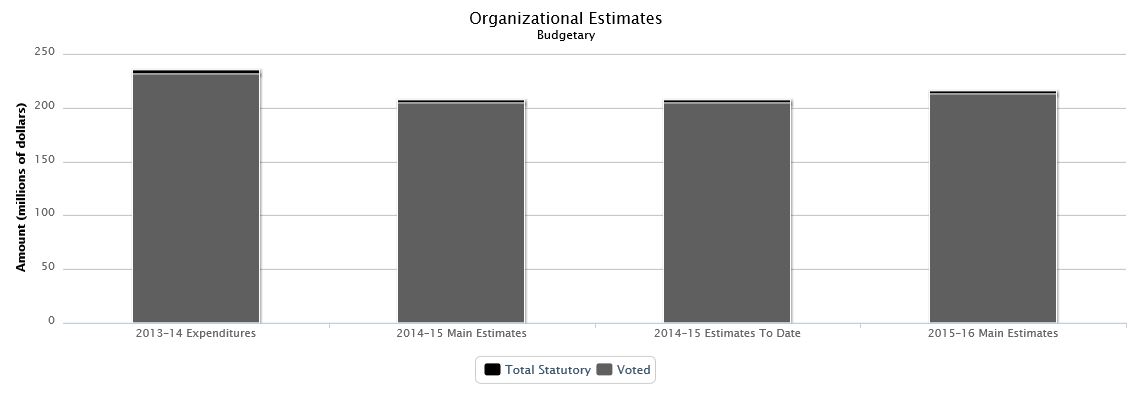
| 2013–14 Expenditures | 2014–15 Main Estimates | 2014–15 Estimates To Date | 2015–16 Main Estimates | ||
|---|---|---|---|---|---|
| Budgetary | |||||
| Voted | |||||
| 1 | Operating expenditures | 26,887,683 | 26,037,429 | 26,037,429 | 25,859,077 |
| 5 | Grants and contributions | 204,169,344 | 177,631,522 | 177,631,522 | 186,239,502 |
| Total voted | 231,057,027 | 203,668,951 | 203,668,951 | 212,098,579 | |
| Total Statutory | 3,223,378 | 3,095,164 | 3,095,164 | 3,153,140 | |
| Total budgetary | 234,280,405 | 206,764,115 | 206,764,115 | 215,251,719 | |
Highlights
FedDev Ontario is estimating budgetary expenditures of $215.3 million in 2015–16. Of this amount, $212.1 million requires voted approval by Parliament. The remaining $3.2 million represents statutory forecasts that do not require additional approval and are provided for information purposes.
FedDev Ontario's planned spending in 2015–16 will support its strategic outcome by delivering its suite of programming and all associated internal support services. For 2015–16, FedDev Ontario anticipates expending $29.0 million in operating funds and employee benefits plan in order to provide $186.2 million in transfer payment program funding to strategic projects across its suite of programming. These totals are net of the changes to funding levels announced in Budget 2012, which includes reductions to operating and transfer payment funds in 2015–16 and future years.
FedDev Ontario will deliver its core contribution budget for 2015–16 through the Southern Ontario Prosperity Initiatives (four initiatives designed to support innovation, business growth and productivity, and regional diversification). FedDev Ontario will also continue to invest in large-scale, transformative projects under the Advanced Manufacturing Fund in order to promote the long-term growth, productivity, and competitiveness of Ontarioʼs manufacturing sector. Additional programs being delivered in 2015–16 include the Community Futures Program, the Eastern Ontario Development Program and the Economic Development Initiative.
In total, FedDev Ontario is estimating an increase of $8.5 million or 4.1% from its 2014–15 Main Estimates.
Significant year-over-year changes in funding:
- A net increase of $8.6 million in transfer payments, which includes: Increases to the Advanced Manufacturing Fund ($12.0 million) and Economic Development Initiative ($7,980) and a decrease of $3.4 million to the Southern Ontario Prosperity Initiatives; and
- A net decrease of $0.1 million in operating funding as a result of changes to the administration of the Ontario Federal Council.
Expenditures by Strategic Outcome and Program
| 2013–14 Expenditures | 2014–15 Main Estimates | 2015–16 Main Estimates | |
|---|---|---|---|
| A Competitive Southern Ontario Economy. | |||
| Technological Innovation | 56,430,801 | 79,171,993 | 91,786,705 |
| Business Development | 87,659,299 | 77,643,433 | 66,123,559 |
| Community Economic Development | 71,120,480 | 34,102,802 | 41,264,851 |
| The following program supports all strategic outcomes within this organization. | |||
| Internal Services | 19,069,825 | 15,845,887 | 16,076,604 |
| Total | 234,280,405 | 206,764,115 | 215,251,719 |
Listing of the 2015–16 Transfer Payments
| 2013–14 Expenditures | 2014–15 Main Estimates | 2015–16 Main Estimates | |
|---|---|---|---|
| Contributions | |||
| Contributions for Southern Ontario Prosperity Initiatives | 137,296,695 | 115,773,898 | 112,373,898 |
| Contributions for the Advanced Manufacturing Fund | 0 | 40,000,000 | 52,000,000 |
| Contributions under the Community Futures Program | 11,267,696 | 11,285,992 | 11,285,992 |
| Contributions under the Eastern Ontario Development Program | 13,200,000 | 9,600,000 | 9,600,000 |
| Contributions under the Economic Development Initiative – Official Languages | 0 | 971,632 | 979,612 |
Finance
Raison d'être
The Department of Finance Canada (Department) contributes to a strong economy and sound public finances for Canadians. It does so by monitoring developments in Canada and around the world to provide first-rate analysis and advice to the Government of Canada and by developing and implementing fiscal and economic policies that support the economic and social goals of Canada and its people. The Department also plays a central role in ensuring that government spending is focused on results and delivers value for taxpayer dollars. The Department interacts extensively with other federal organizations and acts as an effective conduit for the views of participants in the economy from all parts of Canada.
The Minister of Finance is responsible for this organization.
Organizational Estimates
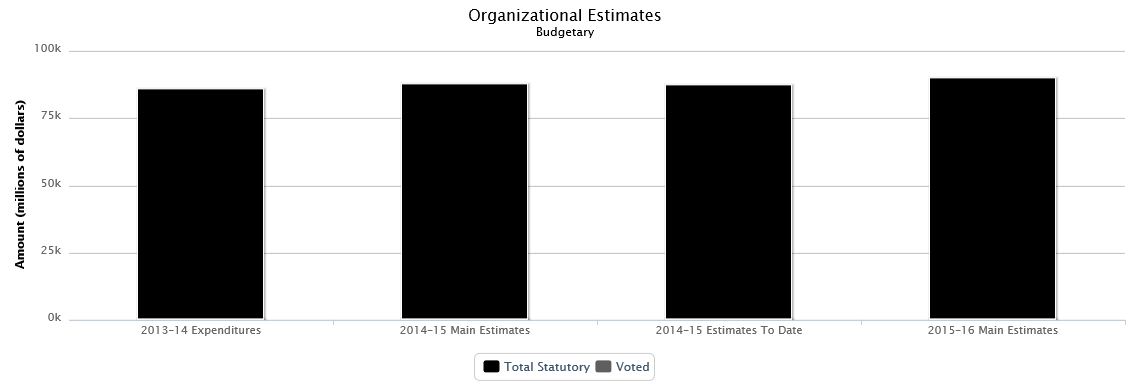
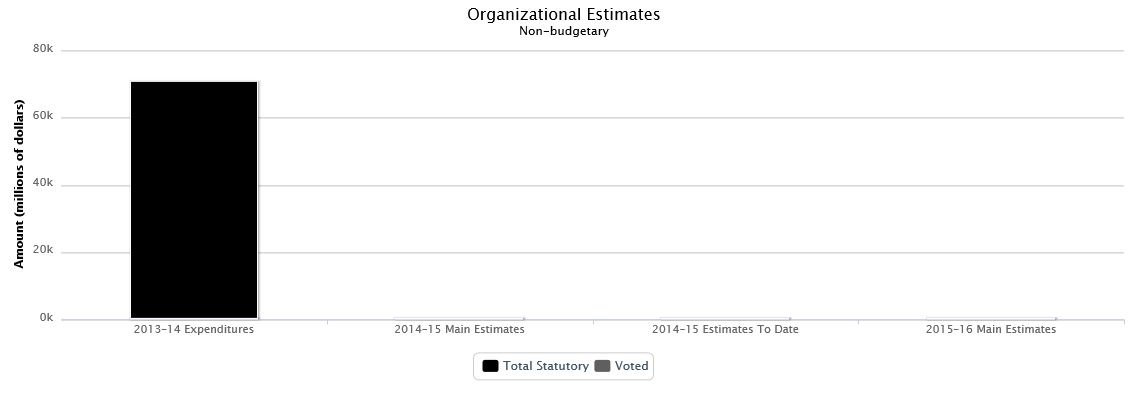
| 2013–14 Expenditures | 2014–15 Main Estimates | 2014–15 Estimates To Date | 2015–16 Main Estimates | ||
|---|---|---|---|---|---|
| Budgetary | |||||
| Voted | |||||
| 1 | Operating expenditures | 122,472,165 | 114,981,053 | 122,722,613 | 99,936,668 |
| 5 | Grants and contributions | 9,210,000 | 5,035,000 | 5,035,000 | 3,035,000 |
| 10 | Authority for amount by way of direct payments to the International Development Association pursuant to Bretton Woods and Related Agreements Act | 0 | 0 | 1 | 1 |
| - | Authority for amount by way of direct payments relating to the establishment of a Canadian securities regulation regime and a Canadian regulatory authority | 0 | 0 | 1 | 0 |
| Total voted | 131,682,165 | 120,016,053 | 127,757,615 | 102,971,669 | |
| Total Statutory | 85,447,190,014 | 87,495,714,686 | 86,851,256,291 | 89,543,425,443 | |
| Total budgetary | 85,578,872,179 | 87,615,730,739 | 86,979,013,906 | 89,646,397,112 | |
| Non-budgetary | |||||
| Voted | |||||
| - | Authority for amount of demand notes to the International Development Association pursuant to Bretton Woods and Related Agreements Act | 0 | 1 | 2 | 0 |
| Total voted | 0 | 1 | 2 | 0 | |
| Total Statutory | 70,481,709,512 | 0 | 200,000,000 | 0 | |
| Total non-budgetary | 70,481,709,512 | 1 | 200,000,002 | 0 | |
Highlights
The Department is estimating budgetary expenditures of $89.6 billion in 2015–16. Of this amount, $103.0 million requires approval by Parliament. The remaining $89.5 billion represents statutory forecasts that do not require additional approval and are provided for information only.
The spending increase of $2.0 billion from the 2014–15 Main Estimates to 2015–16 Main Estimates is due mainly to a net increase of
$2.0 billion in statutory votes as follows:
- Canada Health Transfer – An increase of $1.9 billion reflecting the annual increased funding commitment in the Jobs, Growth and Long-term Prosperity Act, 2012. This program will increase by 6% per year until 2016–17, after which it will grow based on a 3-year moving average of nominal gross domestic product, with funding guaranteed to increase by at least 3% per year;
- Fiscal Equalization – An increase of $672.0 million reflecting the increase due to the 4.0% gross domestic product-based escalator applied to the 2014–15 level;
- Canada Social Transfer – An increase of $377.5 million reflecting the 3% annual increased funding commitment in the Jobs, Growth and Long-term Prosperity Act, 2012;
- Territorial Financing – An increase of $91.8 million as a result of new and updated data entering the formula for Territorial Formula Financing;
- Additional Fiscal Equalization Offset Payment to Nova Scotia – A decrease of $27.7 million due to the decline in offshore revenues received by Nova Scotia. The Nova Scotia 2005 offshore arrangements guarantees that the province's offshore oil and gas revenues that enter the Equalization formula do not impact Equalization payments. Consequently, the province receives payments equal to the decline in Equalization due to these revenues;
- Youth Allowance Recovery – An increase in recovery of $37.1 million as a result of an increase in the estimated value of personal income tax points;
- Additional Fiscal Equalization to Nova Scotia – A reduction of $58.9 million in this program, which ensures that there is no reduction in Equalization and 2005 Offshore Accord Offset Payments due to the new formula for Equalization (2007), is due to higher growth of combined Equalization and 2005 Offshore Accord payments in the new formula compared to the formula which was in place prior to 2007;
- Interest on Unmatured Debt – A decrease of $159.0 million due to an accounting change in 2013–14 relating to bond buybacks, as explained in the Annual Financial Report of the Government of Canada for 2013–14;
- Alternative Payments for Standing Programs – An increase in recoveries in the amount of $169.7 million as a result of an increase in the value of personal income tax points; and
- Other Interest Costs – A reduction of $520.0 million mainly due to a decrease in the average Government of Canada long-term bond rate used to calculate interest on the public sector pension obligations pertaining to service pre-.
There is a net decrease of $15.0 million in Vote 1, Operating expenditures which is mainly attributable to:
- James Michael Flaherty building – A permanent decrease of $10.5 million reflecting the department's move in ;
- Government initiatives – A decrease of $6.9 million related to the expiry of temporary funding for: Government advertising ($2.5 million); development of a comprehensive legislative financial consumer code ($1.7 million); GST technical issues ($1.2 million); supporting the G-20 framework working group ($600 thousand); implementing the venture capital action plan ($485 thousand); and, corporate asset management review ($376 thousand).
- Renewal of Authorities to Support Comprehensive Claims and Self-Government Negotiations across Canada – A temporary increase of $266 thousand;
- Compensation adjustments – A permanent increase of $333 thousand to reflect salary adjustments in relation to collective agreements;
- Execution of Responsibilities Consequential to Sales Tax Harmonization – A temporary increase of $653 thousand;
- Policy and Financial Analysis and Support related to ongoing and future Government of Canada priorities – permanent increase of
$1.1 million.
Expenditures by Strategic Outcome and Program
| 2013–14 Expenditures | 2014–15 Main Estimates | 2015–16 Main Estimates | |
|---|---|---|---|
| A strong economy and sound public finances for Canadians. | |||
| Transfer and Taxation Payment Programs | 60,171,246,077 | 61,060,094,305 | 63,809,601,256 |
| Treasury and Financial Affairs | 25,258,792,413 | 26,419,500,000 | 25,726,000,000 |
| Economic and Fiscal Policy Framework | 90,992,374 | 86,840,289 | 70,864,539 |
| The following program supports all strategic outcomes within this organization. | |||
| Internal Services | 57,841,315 | 49,296,145 | 39,931,317 |
| Total | 85,578,872,179 | 87,615,730,739 | 89,646,397,112 |
| 2013–14 Expenditures | 2014–15 Main Estimates | 2015–16 Main Estimates | |
|---|---|---|---|
| A strong economy and sound public finances for Canadians. | |||
| Transfer and Taxation Payment Programs | 8,000,000 | 1 | 0 |
| Treasury and Financial Affairs | 70,473,709,512 | 0 | 0 |
| Total | 70,481,709,512 | 1 | 0 |
Listing of the 2015–16 Transfer Payments
| 2013–14 Expenditures | 2014–15 Main Estimates | 2015–16 Main Estimates | |
|---|---|---|---|
| Contributions | |||
| Contribution to the Harbourfront Centre | 5,000,000 | 5,000,000 | 3,000,000 |
| Research and Policy Initiatives Assistance | 10,000 | 35,000 | 35,000 |
| Other Transfer Payments | |||
| Total Statutory | 60,043,954,502 | 61,064,194,305 | 63,805,244,002 |
Financial Transactions and Reports Analysis Centre of Canada
Raison d'être
The Financial Transactions and Reports Analysis Centre of Canada (FINTRAC) is Canada's financial intelligence unit. The Centre exists to assist in the detection, prevention and deterrence of money laundering and the financing of terrorist activities. FINTRAC's "value-added" financial intelligence products and compliance functions are a unique contribution to the public safety of Canadians and to the protection of the integrity of Canada's financial system.
FINTRAC is an independent agency that operates at arm's length from the law enforcement agencies and other entities to which it is authorized to disclose financial intelligence. It reports to the Minister of Finance, who is in turn accountable to Parliament for the activities of the Centre. FINTRAC was established by, and operates within, the ambit of the Proceeds of Crime (Money Laundering) and Terrorist Financing Act (PCMLTFA) and its regulations.
Organizational Estimates
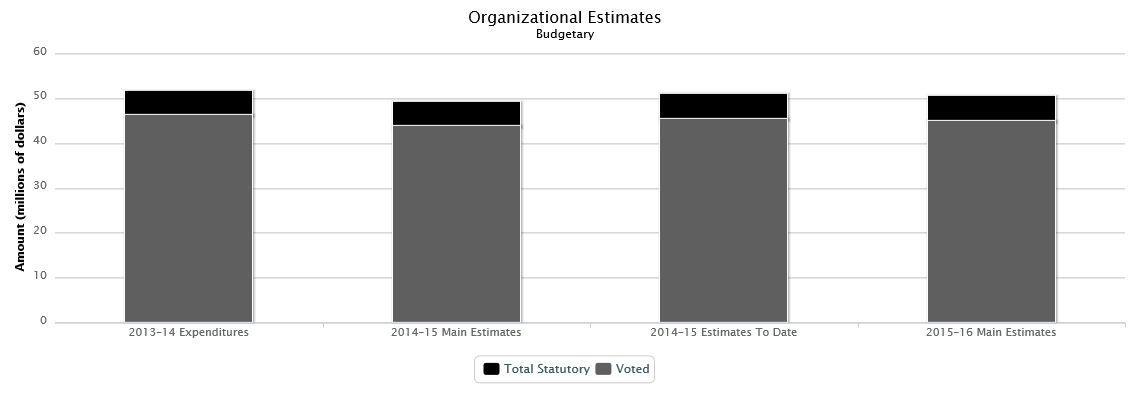
| 2013–14 Expenditures | 2014–15 Main Estimates | 2014–15 Estimates To Date | 2015–16 Main Estimates | ||
|---|---|---|---|---|---|
| Budgetary | |||||
| Voted | |||||
| 1 | Program expenditures | 46,181,452 | 43,803,658 | 45,437,914 | 44,954,660 |
| Total voted | 46,181,452 | 43,803,658 | 45,437,914 | 44,954,660 | |
| Total Statutory | 5,522,731 | 5,385,654 | 5,405,213 | 5,495,520 | |
| Total budgetary | 51,704,183 | 49,189,312 | 50,843,127 | 50,450,180 | |
Highlights
FINTRAC is one of several domestic partners in Canada's anti-money laundering and anti-terrorist financing regime, which also includes the Department of Finance as the policy and regime lead, the Royal Canadian Mounted Police, the Canadian Security Intelligence Service, the Canada Revenue Agency, the Canada Border Services Agency, the Office of the Superintendent of Financial Institutions, the Public Prosecution Service of Canada, the Department of Justice, and Public Safety Canada. FINTRAC is also part of the Egmont Group, an international network of financial intelligence units that collaborate and exchange information to combat money laundering and terrorist activity financing.
FINTRAC's role is to facilitate the detection, prevention and deterrence of money laundering and terrorist activity financing by engaging in the following activities:
- Receiving financial transaction reports and voluntary information on money laundering and terrorist activity financing in accordance with the legislation and regulations;
- Safeguarding personal information under its control;
- Ensuring compliance of reporting entities with the legislation and regulations;
- Maintaining a registry of money services businesses in Canada;
- Producing financial intelligence relevant to investigations of money laundering, terrorist activity financing and threats to the security of Canada;
- Researching and analyzing data from a variety of information sources that shed light on trends and patterns in money laundering and terrorist activity financing; and,
- Enhancing public awareness and understanding of money laundering and terrorist activity financing.
In 2015–16, FINTRAC will receive $1.7 million for the implementation of legislative amendments as identified in Budget 2014.
FINTRAC is headquartered in Ottawa, and its Montréal, Toronto and Vancouver regional offices have specific mandates related to compliance with the PCMLTFA.
For further details regarding FINTRAC, its operations and its use of funds, please refer to the 2015–16 Reports on Plans and Priorities
Expenditures by Strategic Outcome and Program
| 2013–14 Expenditures | 2014–15 Main Estimates | 2015–16 Main Estimates | |
|---|---|---|---|
| A Canadian financial system resistant to money laundering and terrorist financing. | |||
| Compliance Program | 21,702,134 | 20,905,458 | 22,060,798 |
| Financial Intelligence Program | 21,668,241 | 20,905,458 | 21,083,994 |
| The following program supports all strategic outcomes within this organization. | |||
| Internal Services | 8,333,808 | 7,378,396 | 7,305,388 |
| Total | 51,704,183 | 49,189,312 | 50,450,180 |
Fisheries and Oceans
Raison d'être
Fisheries and Oceans supports strong and sustainable economic growth in our marine and fisheries sectors and contributes to a prosperous economy through global commerce by supporting exports and advancing safe maritime trade. The Department supports the innovation needed for a knowledge-based economy through research in expanding sectors such as aquaculture and biotechnology. The Department contributes to a clean and healthy environment and sustainable aquatic ecosystems for Canadians through habitat protection, oceans management, and ecosystems research. A safe and secure Canada relies on the maritime security, safe navigation, a presence in our waters, and the effective search and rescue services that the Canadian Coast Guard provides. The Minister of Fisheries and Oceans is responsible for this organization.
Organizational Estimates
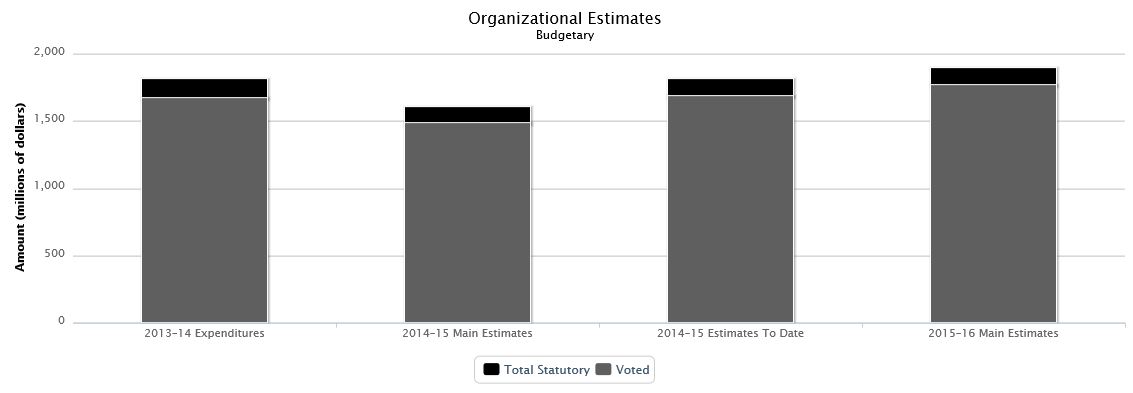
| 2013–14 Expenditures | 2014–15 Main Estimates | 2014–15 Estimates To Date | 2015–16 Main Estimates | ||
|---|---|---|---|---|---|
| Budgetary | |||||
| Voted | |||||
| 1 | Operating expenditures | 1,283,415,415 | 1,101,569,625 | 1,144,394,384 | 1,181,570,672 |
| 5 | Capital expenditures | 299,367,218 | 325,273,149 | 448,509,573 | 495,982,360 |
| 10 | Grants and contributions | 85,270,463 | 57,853,950 | 91,509,966 | 88,932,871 |
| Total voted | 1,668,053,096 | 1,484,696,724 | 1,684,413,923 | 1,766,485,903 | |
| Total Statutory | 138,350,090 | 120,614,124 | 122,389,544 | 122,754,445 | |
| Total budgetary | 1,806,403,186 | 1,605,310,848 | 1,806,803,467 | 1,889,240,348 | |
Highlights
Fisheries and Oceans has three mandated strategic outcomes, which are:
- Economically prosperous maritime sectors and fisheries;
- Sustainable aquatic ecosystems; and,
- Safe and secure waters.
Fisheries and Oceans is estimating budgetary expenditures of $1.9 billion in 2015–16. Compared to 2014–15, Main Estimates have increased by $283.9 million. Significant changes include:
- An increase of $113.7 million related to the procurement of light-lift helicopters for the Canadian Coast Guard;
- An increase of $44.2 million related to the procurement of Canadian Coast Guard offshore fisheries science vessels;
- An increase of $40.9 million related to Canadian Coast Guard vessel life extensions and mid-life modernizations;
- An increase of $40.2 million related to the procurement of medium-lift helicopters for the Canadian Coast Guard;
- An increase of $32.7 million related to the renewal of the Pacific and Atlantic Integrated Commercial Fisheries Initiatives;
- An increase of $22.2 million for investments at small craft harbours across Canada; and,
- A decrease of $27.6 million related to Targeted Review measures, as announced in Budget 2013.
For additional information, please see the Report on Plans and Priorities.
Expenditures by Strategic Outcome and Program
| 2013–14 Expenditures | 2014–15 Main Estimates | 2015–16 Main Estimates | |
|---|---|---|---|
| Safe and Secure Waters. | |||
| Fleet Operational Readiness | 448,024,899 | 434,001,300 | 679,602,143 |
| Shore-Based Asset Readiness | 114,196,788 | 114,469,108 | 108,148,093 |
| Marine Communications and Traffic Services | 43,983,435 | 39,400,851 | 33,337,572 |
| Search and Rescue Services | 36,499,413 | 30,359,815 | 30,508,166 |
| Hydrographic Products and Services | 30,826,575 | 26,671,207 | 27,983,471 |
| Canadian Coast Guard College | 15,364,943 | 12,928,545 | 13,063,489 |
| Maritime Security | 7,160,790 | 9,240,284 | 8,477,162 |
| Ocean Forecasting | 19,203,672 | 8,799,464 | 8,476,473 |
| Economically Prosperous Maritime Sectors and Fisheries. | |||
| Integrated Fisheries Management | 150,657,317 | 132,448,762 | 132,058,128 |
| Small Craft Harbours | 98,693,883 | 94,277,242 | 114,501,031 |
| Aboriginal Strategies and Governance | 83,910,543 | 54,778,338 | 85,549,894 |
| Marine Navigation | 54,590,696 | 34,167,537 | 41,828,751 |
| Salmonid Enhancement Program | 32,383,362 | 29,597,995 | 29,421,364 |
| Sustainable Aquaculture Program | 26,298,035 | 29,222,400 | 27,854,324 |
| International Engagement | 14,355,038 | 14,882,983 | 12,105,833 |
| Aquatic Animal Health | 6,801,305 | 5,564,900 | 5,503,416 |
| Biotechnology and Genomics | 3,713,029 | 2,918,827 | 3,379,708 |
| Climate Change Adaptation Program | 2,715,681 | 2,310,465 | 2,393,994 |
| Territorial Delineation | 1,476,827 | 742,607 | 1,593,377 |
| Sustainable Aquatic Ecosystems. | |||
| Compliance and Enforcement | 110,733,954 | 101,372,908 | 102,911,820 |
| Fisheries Protection | 61,504,263 | 62,943,218 | 59,284,200 |
| Oceans Management | 40,442,966 | 38,351,812 | 46,666,258 |
| Environmental Response Services | 35,040,603 | 12,932,842 | 16,965,722 |
| Species at Risk | 23,272,786 | 22,350,000 | 14,616,829 |
| The following program supports all strategic outcomes within this organization. | |||
| Internal Services | 329,182,034 | 290,577,438 | 283,009,130 |
| Funds not allocated to the 2015–16 Program Alignment Architecture | 15,370,349 | 0 | 0 |
| Total | 1,806,403,186 | 1,605,310,848 | 1,889,240,348 |
Listing of the 2015–16 Transfer Payments
| 2013–14 Expenditures | 2014–15 Main Estimates | 2015–16 Main Estimates | |
|---|---|---|---|
| Grants | |||
| Grant Program for the disposal of small craft harbours | 1,480,000 | 500,000 | 500,000 |
| Grants for the Disposal of Surplus Lighthouses | 85,000 | 500,000 | 500,000 |
| Grants to support organizations associated with research, development, management, and promotion of fisheries and oceans-related issues | 161,964 | 238,000 | 238,000 |
| Contributions | |||
| Contributions to support increased Native participation in commercial fisheries, cooperative fisheries management arrangements and consultations respecting Aboriginal fisheries agreements | 46,716,592 | 26,849,710 | 49,075,415 |
| Contributions under the Aboriginal Aquatic Resource and Oceans Management Program | 18,339,522 | 14,363,000 | 18,752,936 |
| Contributions to support the Recreational Fisheries Conservation Partnerships Program | 3,273,788 | 6,369,148 | 10,000,000 |
| Contribution agreements to permit the Canadian Coast Guard Auxiliary (CCGA) Associations to carry out authorized activities related to maritime Search and Rescue (SAR) operations, SAR prevention and other safety related activities | 5,021,000 | 5,021,000 | 5,021,000 |
| Contributions to support the Academic Research Contribution Program for the support of academic research and development related to science priorities | 182,868 | 268,000 | 2,839,228 |
| Contribution to the Pacific Salmon Foundation | 1,329,832 | 962,000 | 962,000 |
| Contributions to support the Small Craft Harbours Class Contribution Program | 3,496,712 | 2,300,000 | 500,000 |
| Contributions to support organizations associated with research, development, management, and promotion of fisheries and oceans-related issues | 494,870 | 241,192 | 296,192 |
| Contribution to the Salmon Sub-Committee of the Yukon Fish and Wildlife Management Board for implementing responsibilities pursuant to comprehensive land claim settlements | 224,296 | 241,900 | 248,100 |
Foreign Affairs, Trade and Development
Raison d'être
Under the leadership of the Minister of Foreign Affairs, the Minister for International Trade, and the Minister for International Development, the Department of Foreign Affairs, Trade and Development (DFATD) is responsible for the conduct of Canada's international relations, including foreign affairs, international trade and commerce, and international development. DFATD advances Canada's values and interests internationally, delivers international programs, and administers Canada's international aid program to alleviate poverty in the developing world and provide humanitarian assistance. The department provides commercial and consular services to Canadians at home and abroad, and manages the government of Canada's global network of missions.
Organizational Estimates
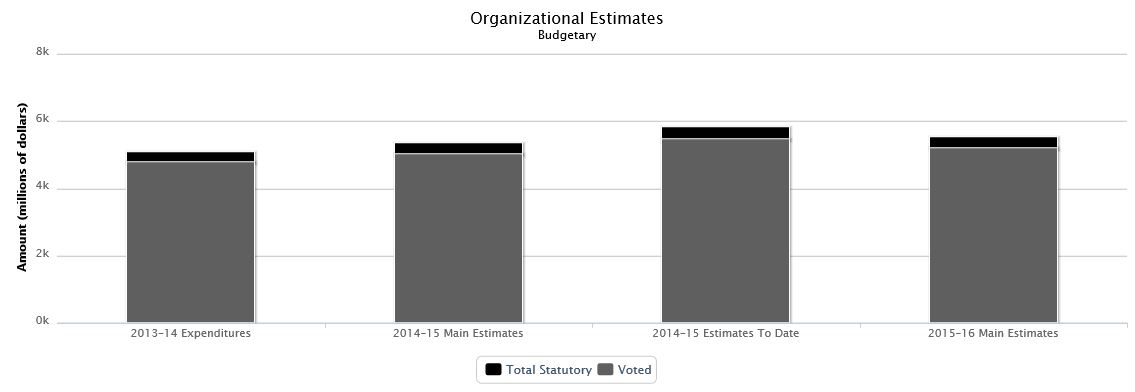
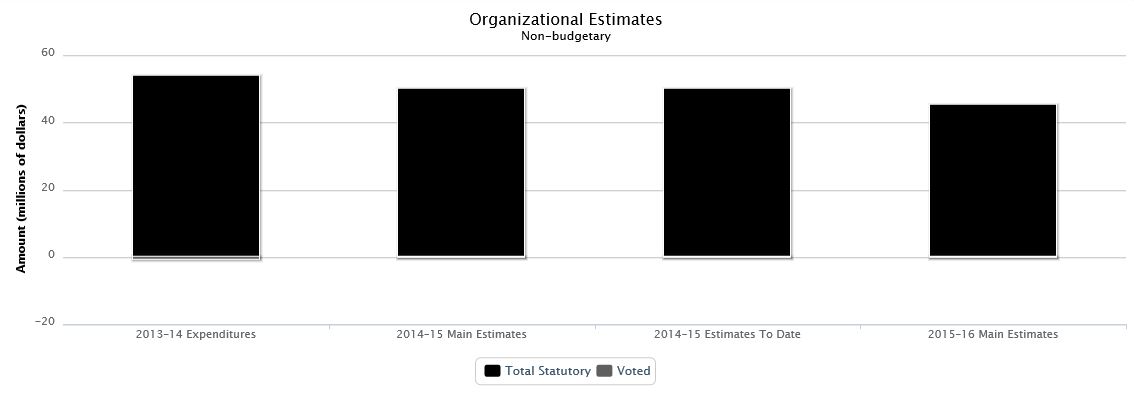
| 2013–14 Expenditures | 2014–15 Main Estimates | 2014–15 Estimates To Date | 2015–16 Main Estimates | ||
|---|---|---|---|---|---|
| Budgetary | |||||
| Voted | |||||
| 1 | Operating expenditures | 1,441,271,656 | 1,379,893,098 | 1,457,768,810 | 1,451,334,915 |
| 5 | Capital expenditures | 139,921,051 | 145,274,489 | 282,025,891 | 103,546,437 |
| 10 | Grants and contributions | 3,105,855,340 | 3,431,944,508 | 3,667,074,556 | 3,573,409,668 |
| 15 | Payments, in respect of pension, insurance and social security programs or other arrangements for employees locally engaged outside of Canada, or in respect of the administration of such programs or arrangements | 65,364,001 | 50,779,000 | 52,532,339 | 50,779,000 |
| 20 | Pursuant to subsection 12(2) of the International Development (Financial Institutions) Assistance Act, payments to international financial institutions – Direct payments | 0 | 0 | 1 | 1 |
| - | Debt forgiveness – Loans to the government of the Republic of the Union of Myanmar (Burma) | 8,306,202 | 0 | 0 | 0 |
| Total voted | 4,760,718,250 | 5,007,891,095 | 5,459,401,597 | 5,179,070,021 | |
| Total Statutory | 304,559,560 | 341,634,062 | 358,203,213 | 347,747,179 | |
| Total budgetary | 5,065,277,810 | 5,349,525,157 | 5,817,604,810 | 5,526,817,200 | |
| Non-budgetary | |||||
| Voted | |||||
| L25 | Pursuant to subsection 12(2) of the International Development (Financial Institutions) Assistance Act, payments to international financial institutions – Capital subscriptions | 0 | 1 | 1 | 1 |
| - | Pursuant to subsection 12(2) of the International Development (Financial Institutions) Assistance Act, payments to international financial institutions – Issuance and payment of demand notes | 0 | 1 | 2 | 0 |
| - | Working capital advance – Loans and advances | (1,248,874) | 0 | 0 | 0 |
| - | Working capital advance – Advances to posts abroad | 680,850 | 0 | 0 | 0 |
| Total voted | (568,024) | 2 | 3 | 1 | |
| Total Statutory | 53,945,696 | 50,082,304 | 50,082,304 | 45,146,540 | |
| Total non-budgetary | 53,377,672 | 50,082,306 | 50,082,307 | 45,146,541 | |
Highlights
Foreign Affairs, Trade and Development is estimating budgetary expenditures of $5.5 billion in 2015–16. Of this amount, $5.2 billion requires approval by Parliament. The remaining $347.7 million represents statutory forecasts that do not require additional approval and are provided for information purposes.
Significant items contributing to the net increase of $177.3 million from the 2014–15 Main Estimates include:
- An increase of $130.1 million for the Stabilization and Reconstruction Task Force and Global Peace and Security Fund;
- An increase of $43.6 million in the cost of assessed contributions, mainly due to currency fluctuations resulting from the payment in the prescribed foreign currency of these contributions which represent Canada's treaty obligations and legal commitments to international organizations such as United Nations and World Health Organization;
- An increase of $36.7 million to support the Global Fund to Fight AIDS, Tuberculosis and Malaria which is a key component of Canada's commitments in the area of maternal, newborn and child health under the 2010 Muskoka initiative; and
- A decrease of $16.8 million related to the Moscow Chancery Relocation Project.
For additional information, please refer to the department's Report on Plans and Priorities.
Expenditures by Strategic Outcome and Program
| 2013–14 Expenditures | 2014–15 Main Estimates | 2015–16 Main Estimates | |
|---|---|---|---|
| International Assistance and Poverty Alleviation - Poverty is reduced, and security and democracy are increased for those living in countries where Canada engages. | |||
| International Development | 0 | 0 | 2,491,018,462 |
| International Humanitarian Assistance | 0 | 0 | 390,590,204 |
| International Security and Democratic Development | 0 | 0 | 377,802,527 |
| Canadaʼs International Agenda - The international agenda is shaped to advance Canadian security, prosperity, interests and values. | |||
| Diplomacy, Advocacy, and International Agreements | 939,594,606 | 961,248,050 | 905,984,385 |
| Integrated Foreign Affairs, Trade, and Development Policy | 98,858,329 | 81,448,665 | 74,932,448 |
| Canadaʼs Network Abroad - The Department maintains a mission network of infrastructure and services to enable the Government of Canada to achieve its international priorities. | |||
| Mission Network Governance, Strategic Direction and Common Services | 620,548,488 | 621,876,342 | 603,804,538 |
| Management of Government of Canada Terms and Conditions of Employment Abroad | 229,133,960 | 187,651,645 | 195,598,665 |
| International Commercial and Consular Services for Canadians - Canadians are satisfied with commercial and consular services. | |||
| International Commerce | 156,811,144 | 155,940,345 | 170,922,571 |
| Consular Services and Emergency Management | 54,306,686 | 46,104,699 | 45,337,728 |
| The following program supports all strategic outcomes within this organization. | |||
| Internal Services | 258,425,197 | 255,730,898 | 270,825,672 |
| Funds not allocated to the 2015–16 Program Alignment Architecture | 2,707,599,400 | 3,039,524,513 | 0 |
| Total | 5,065,277,810 | 5,349,525,157 | 5,526,817,200 |
| 2013–14 Expenditures | 2014–15 Main Estimates | 2015–16 Main Estimates | |
|---|---|---|---|
| Canadaʼs Network Abroad - The Department maintains a mission network of infrastructure and services to enable the Government of Canada to achieve its international priorities. | |||
| Mission Network Governance, Strategic Direction and Common Services | (568,024) | 0 | 0 |
| International Assistance and Poverty Alleviation - Poverty is reduced, and security and democracy are increased for those living in countries where Canada engages. | |||
| International Security and Democratic Development | 0 | 0 | 4,558,947 |
| International Development | 0 | 0 | 40,587,594 |
| Funds not allocated to the 2015–16 Program Alignment Architecture | 53,945,696 | 50,082,306 | 0 |
| Total | 53,377,672 | 50,082,306 | 45,146,541 |
Listing of the 2015–16 Transfer Payments
| 2013–14 Expenditures | 2014–15 Main Estimates | 2015–16 Main Estimates | |
|---|---|---|---|
| Grants | |||
| Grants for Multilateral Programming: Grants in support of development assistance, humanitarian assistance or disaster preparedness, for global operations, programs, projects, activities and appeals for the benefit of developing countries or territories or countries in transition | 1,641,374,818 | 1,943,961,792 | 1,962,348,689 |
| Grants in support of the Global Peace and Security Fund and its sub-programmes | 0 | 0 | 45,000,000 |
| Grants for Partnerships with Canadians Programming: Grants for development assistance programs, projects and activities intended to support development for the benefit of developing countries or territories or countries in transition or to enhance the awareness, understanding, and engagement of Canadians with respect to development | 12,172,500 | 23,900,000 | 23,900,000 |
| Global Partnership Program for the destruction, disposal and securing of weapons and materials of mass destruction and related expertise | 19,668,063 | 22,745,000 | 21,050,000 |
| Grants in lieu of taxes on diplomatic, consular and international organizationsʼ property in Canada in accordance with terms and conditions approved by the Governor in Council | 13,017,225 | 13,516,000 | 13,516,000 |
| Grants for Bilateral Programming: Grants for cooperation with other donor countries for the benefit of developing countries or territories or countries in transition | 694,692 | 9,900,000 | 9,900,000 |
| Grants for the Anti-Crime Capacity Building Program | 9,728,079 | 8,250,000 | 7,000,000 |
| Grants for Counter-Terrorism Capacity Building Program | 5,176,993 | 8,920,000 | 5,470,000 |
| Grants in aid of academic relations | 1,554,267 | 5,510,000 | 2,530,000 |
| Annual host-country financial support for the United Nations Convention on Biological Diversity | 1,040,395 | 76,000 | 1,182,489 |
| Religious Freedom Fund Program | 400,000 | 500,000 | 500,000 |
| United Nations Voluntary Fund for Victims of Torture | 0 | 60,000 | 60,000 |
| United Nations Trust Fund on Indigenous Issues | 0 | 30,000 | 30,000 |
| Total Statutory | 119,775 | 250,000 | 250,000 |
| Contributions | |||
| Payments of Assessed Contributions to International Organizations: | |||
| United Nations peacekeeping operations (US$244,482,704) | 213,618,115 | 239,346,913 | 267,121,802 |
| United Nations Organization (US$96,006,434) | 89,548,241 | 101,356,800 | 104,896,630 |
| North Atlantic Treaty Organization (NATO) – civil administration (27,766,230 Euro) | 32,602,573 | 31,628,866 | 39,866,752 |
| Food and Agriculture Organization (US$8,067,064) (5,930,956 Euro) | 16,580,444 | 16,111,256 | 17,329,741 |
| World Health Organization (US$7,138,726) (6,696,125 Swiss Francs) | 15,071,097 | 14,665,725 | 15,758,116 |
| International Atomic Energy Agency (9,062,246 Euro) (US$1,304,856) | 14,485,023 | 14,189,963 | 14,437,258 |
| Organization for Economic Cooperation and Development (9,850,972 Euro) | 10,958,162 | 12,885,923 | 14,144,026 |
| International Labour Organization (11,705,611 Swiss Francs) | 13,418,265 | 12,845,487 | 13,912,119 |
| International Organization of La Francophonie (9,597,500 Euro) | 14,377,072 | 13,377,146 | 13,780,272 |
| United Nations Educational, Scientific and Cultural Organization (5,060,864 Euro) (US$4,416,320) | 11,501,374 | 11,149,467 | 12,091,659 |
| Organization for Security and Cooperation in Europe (8,110,260 Euro) | 11,869,858 | 11,304,080 | 11,644,711 |
| Organization of American States (US$9,766,099) | 10,392,957 | 10,311,048 | 10,670,440 |
| International Criminal Court (6,399,000 Euro) | 9,161,807 | 8,328,897 | 9,187,684 |
| Commonwealth Secretariat (3,798,045 Pounds Sterling) | 5,620,240 | 6,261,078 | 6,875,602 |
| World Trade Organization (5,434,900 Swiss Francs) | 6,336,240 | 6,474,318 | 6,459,379 |
| Comprehensive Nuclear-Test-Ban Treaty Organization (2,162,223 Euro) (US$1,366,729) | 4,184,203 | 4,083,324 | 4,597,807 |
| Inter-American Institute for Cooperation on Agriculture (US$3,293,339) | 3,659,186 | 3,477,107 | 3,598,302 |
| Organization for the Prohibition of Chemical Weapons (2,248,505 Euro) | 3,029,248 | 3,141,113 | 3,228,404 |
| International Civil Aviation Organization | 2,362,510 | 2,272,980 | 2,382,785 |
| Roosevelt Campobello International Park Commission (US$1,626,900) | 1,811,879 | 1,717,681 | 1,777,551 |
| Commonwealth Youth Program (826,320 Pounds Sterling) | 1,267,159 | 1,362,174 | 1,495,887 |
| International Energy Agency (916,134 Euro) | 1,464,338 | 1,277,502 | 1,315,385 |
| Commonwealth Foundation (724,708 Pounds Sterling) | 1,098,472 | 1,194,681 | 1,311,939 |
| United Nations framework Convention on Climate Change (578,164 Euro) | 690,025 | 1,294,984 | 830,127 |
| Nuclear Energy Agency of the Organization for Economic Cooperation and Development (449,718 Euro) | 549,560 | 601,564 | 645,705 |
| Convention on Biological Diversity (US$542,928) | 525,139 | 545,927 | 593,203 |
| Asia-Pacific Economic Cooperation Secretariat (US$128,200) (505,800 SGD) | 630,357 | 606,655 | 583,102 |
| World Intellectual Property Organization (455,790 Swiss Francs) | 537,787 | 515,179 | 541,706 |
| International Tribunal for the Law of the Sea (376,087 Euro) | 629,634 | 626,146 | 539,986 |
| World Customs Organization (340,527 Euro) | 465,885 | 474,033 | 488,929 |
| International Maritime Organization (241,661 Pounds Sterling) | 341,226 | 357,322 | 437,478 |
| Peace Implementation Council (196,950 Euro) | 291,207 | 299,848 | 282,781 |
| International Seabed Authority (US$232,287) | 315,475 | 322,793 | 253,797 |
| Stockholm Convention on Persistent Organic Pollutants (US$211,306) | 199,038 | 212,473 | 230,873 |
| Basel Convention on the Control of Transboundary Movements of Hazardous Wastes and their Disposal (US$189,589) | 190,525 | 190,954 | 207,145 |
| Organization for Economic Cooperation and Development Centre for Education and Research (142,915 Euro) | 164,916 | 187,679 | 205,198 |
| The Vienna Convention and its Montreal Protocol on Substances that Deplete the Ozone Layer (US$156,159) | 163,075 | 164,873 | 170,620 |
| Rotterdam Convention on the Prior Informed Consent Procedure for Certain Hazardous Chemicals and Pesticides in International Trade (US$111,383) | 97,262 | 104,290 | 121,697 |
| Non-proliferation, Arms Control and Disarmament (US$106,159) | 112,908 | 219,207 | 115,989 |
| Wassenaar Arrangement (72,627 Euro) | 101,536 | 97,790 | 104,277 |
| Secrétariat technique permanent des conférences ministérielles de l'éducation, de la jeunesse et des sports des pays d'expression française (21,402,443 CFA) (25,777 Euro) | 48,891 | 0 | 83,668 |
| Permanent Court of Arbitration (48,598 Euro) | 56,684 | 72,078 | 69,777 |
| International Commodity Organizations (27,877 Euro) | 43,934 | 35,286 | 40,025 |
| International Fact Finding Commission (10,910 Swiss Francs) | 11,005 | 16,261 | 12,966 |
| Contributions for Bilateral Programming: Contributions in support of development assistance, contributions for cooperation with countries in transition and contributions in support of regional or country specific development assistance programs, projects and activities for the benefit of developing countries or territories or countries in transition | 578,106,558 | 467,108,588 | 454,285,336 |
| Contributions for Partnerships with Canadians Programming: Contributions for development assistance programs, projects and activities intended to support development for the benefit of developing countries or territories or countries in transition or to enhance the awareness, understanding, and engagement of Canadians with respect to development | 181,530,889 | 235,181,753 | 239,458,590 |
| Global Peace and Security Fund | 44,387,363 | 0 | 55,000,000 |
| Contributions under the Global Partnership Program for the destruction, disposal and securing of weapons and materials of mass destruction and related expertise | 19,709,928 | 40,745,000 | 42,440,000 |
| Canada Fund for Local Initiatives | 6,930,412 | 34,100,000 | 34,100,000 |
| Investment Cooperation Program | 1,531,676 | 19,850,000 | 19,850,000 |
| Contributions for Multilateral Programming: Contributions in support of development assistance, humanitarian assistance or disaster preparedness, for global operations, programs, projects, activities and appeals for the benefit of developing countries or territories or countries in transition | 9,205,103 | 13,400,000 | 13,400,000 |
| Projects and development activities resulting from Summits of La Francophonie | 8,711,661 | 8,000,000 | 8,000,000 |
| Global Commerce Support Program | 5,410,799 | 6,955,855 | 6,955,855 |
| Contributions for the Anti-Crime Capacity Building Program | 7,541,970 | 8,093,022 | 5,601,782 |
| Contribution for Counter-Terrorism Capacity Building Program | 7,530,855 | 8,900,000 | 4,900,000 |
| Contributions in Aid of Academic Relations | 6,082,608 | 1,607,627 | 4,587,627 |
| Religious Freedom Fund Program | 364,747 | 3,750,000 | 3,750,000 |
| Annual Voluntary Contributions | 1,000,000 | 3,450,000 | 3,450,000 |
| Northern Dimension of Canadaʼs Foreign Policy | 722,789 | 700,000 | 700,000 |
| Other Transfer Payments | |||
| Total Statutory | 46,205,000 | 245,000,000 | 245,000,000 |
Governor General
Raison d'être
The Office of the Secretary to the Governor General (Office) provides support and advice to the Governor General of Canada in his/her unique role as the representative of The Queen in Canada as well as Commander-in-Chief. The Office assists the Governor General in carrying out constitutional responsibilities, in representing Canada internationally, and in encouraging excellence and achievement through the administration of the Canadian Honours System and in the granting of armorial bearings.
The Office also supports the Governor General in bringing Canadians together. It manages a visitor services program at both of the Governor General's official residences and oversees the day-to-day operations of these residences. The Office also provides support to former Governors General.
Organizational Estimates
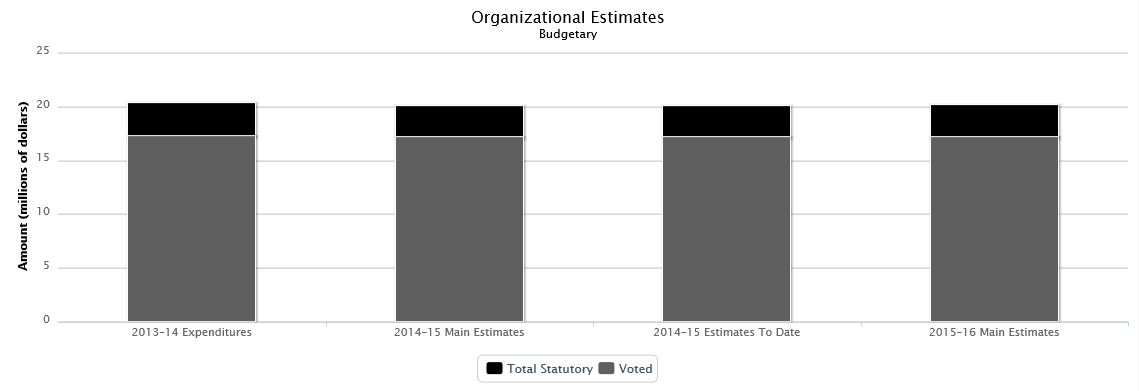
| 2013–14 Expenditures | 2014–15 Main Estimates | 2014–15 Estimates To Date | 2015–16 Main Estimates | ||
|---|---|---|---|---|---|
| Budgetary | |||||
| Voted | |||||
| 1 | Program expenditures | 17,271,740 | 17,150,426 | 17,150,426 | 17,165,126 |
| Total voted | 17,271,740 | 17,150,426 | 17,150,426 | 17,165,126 | |
| Total Statutory | 3,034,764 | 2,837,293 | 2,837,293 | 2,965,991 | |
| Total budgetary | 20,306,504 | 19,987,719 | 19,987,719 | 20,131,117 | |
Highlights
The Office is estimating budgetary expenditures of $20.1 million in 2015-16. Of this amount, $17.2 million requires approval by Parliament. The remaining $2.9 million represents statutory forecasts that do not require additional approval and are provided for information purposes only.
The increase from the previous year is the result of the Governor Generalʼs Act adjusting statutory payments paid to the current and former Governors General, adjustments for signed collective agreements and an adjustment to the contributions to employee benefit plans.
Expenditures by Strategic Outcome and Program
| 2013–14 Expenditures | 2014–15 Main Estimates | 2015–16 Main Estimates | |
|---|---|---|---|
| The Governor General, representing The Queen in Canada, is enabled to fulfill constitutional, state, ceremonial and public duties. | |||
| Governor General Support | 14,033,636 | 13,858,784 | 13,981,917 |
| The following program supports all strategic outcomes within this organization. | |||
| Internal Services | 6,272,868 | 6,128,935 | 6,149,200 |
| Total | 20,306,504 | 19,987,719 | 20,131,117 |
Health
Raison d'être
Health Canada regulates specific products and controlled substances, works with partners to support improved health outcomes for First Nations and Inuit, supports innovation and information sharing in Canada's health system to help Canadians maintain and improve their health, and contributes to strengthening Canada's record as a country with one of the healthiest populations in the world.
The Minister of Health is responsible for this organization.
Organizational Estimates
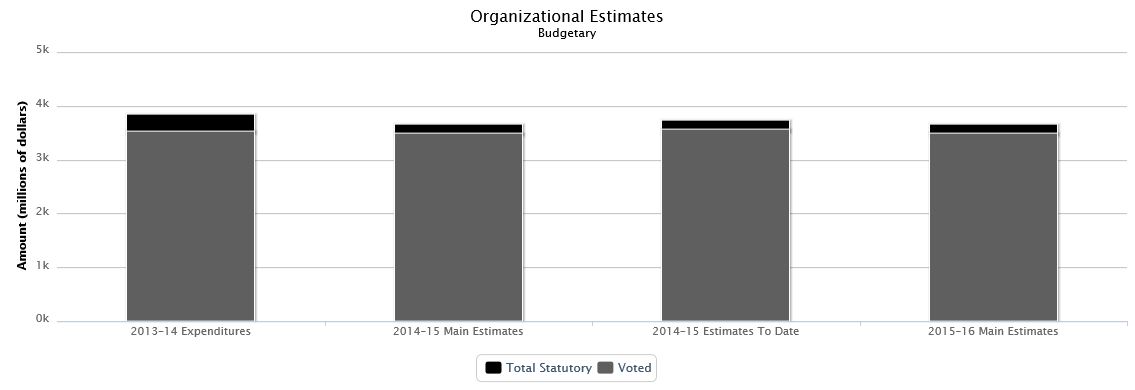
| 2013–14 Expenditures | 2014–15 Main Estimates | 2014–15 Estimates To Date | 2015–16 Main Estimates | ||
|---|---|---|---|---|---|
| Budgetary | |||||
| Voted | |||||
| 1 | Operating expenditures | 1,863,065,740 | 1,774,856,975 | 1,761,719,329 | 1,777,987,439 |
| 5 | Capital expenditures | 21,683,176 | 31,656,363 | 32,433,364 | 28,035,364 |
| 10 | Grants and contributions | 1,640,642,661 | 1,683,745,108 | 1,755,536,333 | 1,678,425,178 |
| Total voted | 3,525,391,577 | 3,490,258,446 | 3,549,689,026 | 3,484,447,981 | |
| Total Statutory | 302,787,920 | 167,053,642 | 168,115,123 | 174,322,368 | |
| Total budgetary | 3,828,179,497 | 3,657,312,088 | 3,717,804,149 | 3,658,770,349 | |
Highlights
With authorities of $3.7 billion anticipated through the Main Estimates, which is in line with previous year funding, Health Canada will continue improving the lives of all Canadians making this countryʼs population among the healthiest in the world as measured by longevity, lifestyle and effective use of the public health care system. Health Canada's total authorities for 2015–16 have a net increase of $1.5 million from the previous year's Main Estimates.
Some important items to note which support these goals are the following:
- An increase in funding for preventing Prescription Drug Abuse (PDA), as announced in Budget 2014, to increase public awareness, enhance existing federal PDA facilities for First Nations communities, improve PDA research, and increase federal inspections of pharmacies;
- An increase in funding for Strengthening Canada's Food Safety Oversight System, as announced in Budget 2014, to strengthen responses to food safety incidents, share and analyse Federal / Provincial / Territorial food safety data, and generate national performance evidence to demonstrate food safety effectiveness; and,
- Increases in funding for First Nations and Inuit Health for the continued implementation of the B.C. Tripartite Framework agreement, the Territorial Health Investment Fund as a transitional measure to fund priority health areas and strengthen territorial capacity to manage and deliver health services, and the Renewal of First Nations Water and Wastewater Action Plan for two years to continue the protection of health and safety of First Nations residents.
Once tabled in the House of Commons, additional information will be available in the departmental Report on Plans and Priorities.
Expenditures by Strategic Outcome and Program
| 2013–14 Expenditures | 2014–15 Main Estimates | 2015–16 Main Estimates | |
|---|---|---|---|
| First Nations and Inuit communities and individuals receive health services and benefits that are responsive to their needs so as to improve their health status. | |||
| Supplementary Health Benefits for First Nations and Inuit | 1,071,034,484 | 1,133,324,859 | 1,128,474,836 |
| First Nations and Inuit Primary Health Care | 927,125,272 | 853,702,552 | 809,838,696 |
| Health Infrastructure Support for First Nations and Inuit | 525,066,806 | 604,177,779 | 635,463,846 |
| Health risks and benefits associated with food, products, substances, and environmental factors are appropriately managed and communicated to Canadians. | |||
| Health Products | 179,564,797 | 152,060,884 | 148,110,784 |
| Environmental Risks to Health | 101,141,190 | 102,849,859 | 100,282,109 |
| Substance Use and Abuse | 88,591,578 | 82,748,939 | 86,731,215 |
| Food Safety and Nutrition | 71,238,491 | 59,175,139 | 67,838,730 |
| Pesticides | 46,299,835 | 40,651,125 | 40,190,336 |
| Consumer Product and Workplace Chemical Safety | 35,535,627 | 37,725,014 | 37,689,337 |
| Radiation Protection | 21,420,658 | 20,522,668 | 20,282,587 |
| A health system responsive to the needs of Canadians. | |||
| Canadian Health System Policy | 353,877,280 | 242,633,254 | 260,390,118 |
| Official Language Minority Community Development | 25,830,789 | 37,527,825 | 37,528,856 |
| Specialized Health Services | 16,475,781 | 18,728,166 | 19,133,053 |
| The following program supports all strategic outcomes within this organization. | |||
| Internal Services | 364,976,909 | 271,484,025 | 266,815,846 |
| Total | 3,828,179,497 | 3,657,312,088 | 3,658,770,349 |
Listing of the 2015–16 Transfer Payments
| 2013–14 Expenditures | 2014–15 Main Estimates | 2015–16 Main Estimates | |
|---|---|---|---|
| Grants | |||
| Grant to support the Mental Health Commission of Canada | 14,550,000 | 14,250,000 | 14,250,000 |
| Grant to the Canadian Centre on Substance Abuse | 3,562,500 | 3,562,500 | 3,562,500 |
| Total Statutory | 106,193,803 | 0 | 0 |
| Contributions | |||
| Contributions for First Nations and Inuit Health Infrastructure Support | 482,855,878 | 577,908,871 | 598,167,682 |
| Contributions for First Nations and Inuit Primary Health Care | 675,173,550 | 629,883,254 | 570,922,419 |
| Contributions for First Nations and Inuit Supplementary Health Benefits | 195,140,821 | 186,779,721 | 202,486,815 |
| Contribution to the Canadian Institute for Health Information | 79,293,905 | 77,658,979 | 78,508,979 |
| Contribution to the Canadian Partnership Against Cancer | 48,500,000 | 47,500,000 | 47,500,000 |
| Official Languages Health Contribution Program | 24,861,552 | 36,400,000 | 36,400,000 |
| Health Care Policy Contribution Program | 19,712,535 | 26,359,000 | 25,709,000 |
| Territorial Health Investment Fund | 0 | 0 | 23,000,000 |
| Anti-Drug Strategy Initiatives | 0 | 0 | 22,787,514 |
| Canada Brain Research Fund to Advance Knowledge for the Treatment of Brain Disorders | 6,747,567 | 20,000,000 | 20,000,000 |
| Contribution to the Canadian Agency for Drugs and Technologies in Health | 16,396,848 | 16,058,769 | 16,058,769 |
| Contribution to the Canadian Patient Safety Institute | 7,760,000 | 7,600,000 | 7,600,000 |
| Canadian Blood Services: Blood Research and Development Program | 5,000,000 | 5,000,000 | 5,000,000 |
| Contribution to strengthen Canadaʼs organs and tissues donation and transplantation system | 3,432,179 | 3,580,000 | 3,580,000 |
| McMaster University - Teams Advancing Patient Experience: Strengthening Quality | 1,742,000 | 2,416,500 | 2,341,500 |
| Mood Disorders Society of Canada | 1,951,800 | 2,000,000 | 550,000 |
| Total Statutory | 169,296 | 0 | 0 |
House of Commons
Raison d'être
The House of Commons is the elected assembly of the Parliament of Canada. The House has 308 Members who work on behalf of Canadians in four main areas – the Chamber, committees, caucus and their constituencies – and as representatives of Canada. Proudly supporting the House of Commons and its Members, the House Administration provides Members with the services, infrastructure and advice they need to carry out their work as legislators and representatives. The Speaker of the House of Commons is responsible for this organization.
Organizational Estimates
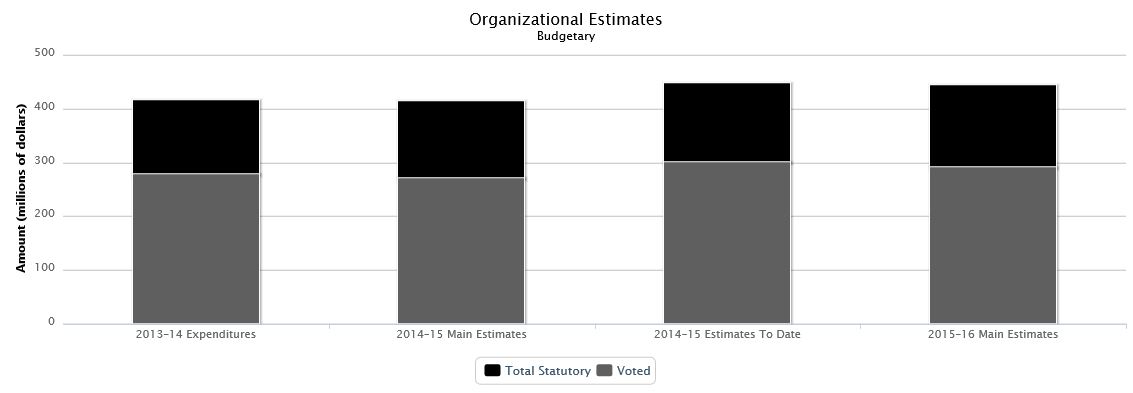
| 2013–14 Expenditures | 2014–15 Main Estimates | 2014–15 Estimates To Date | 2015–16 Main Estimates | ||
|---|---|---|---|---|---|
| Budgetary | |||||
| Voted | |||||
| 1 | Program expenditures | 277,998,639 | 270,118,849 | 300,136,321 | 290,860,044 |
| Total voted | 277,998,639 | 270,118,849 | 300,136,321 | 290,860,044 | |
| Total Statutory | 136,612,399 | 143,606,288 | 147,351,440 | 152,589,048 | |
| Total budgetary | 414,611,038 | 413,725,137 | 447,487,761 | 443,449,092 | |
Highlights
The budget increase from 2014–15 to 2015–16 is mostly attributable to the electoral boundaries redistribution, funding related to the Long-Term Vision and Plan and the disclosure of Members' expenditures.
Expenditures by Strategic Outcome and Program
| 2013–14 Expenditures | 2014–15 Main Estimates | 2015–16 Main Estimates | |
|---|---|---|---|
| Effective administrative and professional support for Members, both individually and collectively, in their roles as legislators and representatives of 308 constituencies, in the Chamber, in committee and in caucus. | |||
| Members and House Officers | 245,512,498 | 254,986,378 | 269,774,379 |
| House Administration | 169,098,540 | 158,738,759 | 173,674,713 |
| Total | 414,611,038 | 413,725,137 | 443,449,092 |
Listing of the 2015–16 Transfer Payments
| 2013–14 Expenditures | 2014–15 Main Estimates | 2015–16 Main Estimates | |
|---|---|---|---|
| Contributions | |||
| Payments to Parliamentary and Procedural Associations | 946,920 | 938,549 | 938,549 |
Immigration and Refugee Board
Raison d'être
The Immigration and Refugee Board (IRB) is an independent, accountable administrative tribunal established by Parliament on to resolve immigration and refugee cases fairly, efficiently and in accordance with the law. The IRB ensures continued benefits to Canadians: by only accepting refugee claimants needing protection in accordance with international obligations and Canadian law; by contributing to the integrity of the immigration system, the safety and security of Canadians and upholding Canada's reputation of justice and fairness for individuals; and promoting family reunification. The IRB also contributes to the quality of life of Canada's communities by strengthening our country's social fabric and by reflecting and reinforcing core values that are important to Canadians. These include respect for human rights, peace, security and the rule of law.
The Minister of Citizenship and Immigration is responsible for this organization.
Organizational Estimates
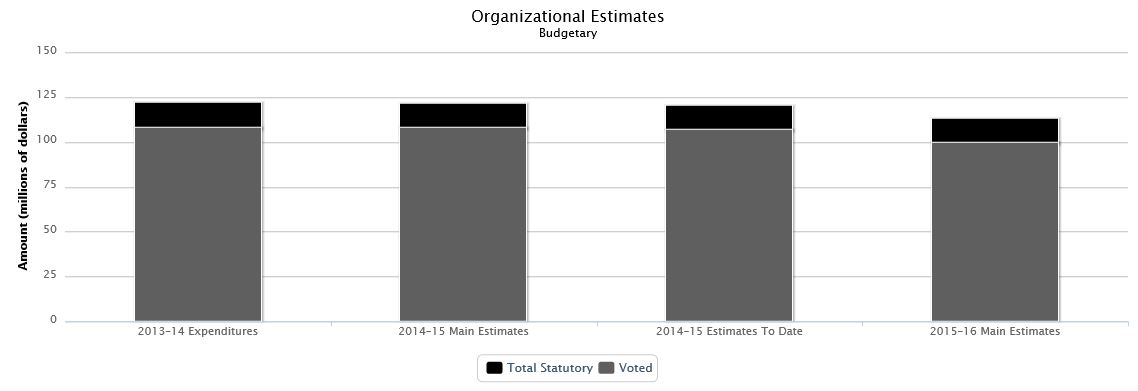
| 2013–14 Expenditures | 2014–15 Main Estimates | 2014–15 Estimates To Date | 2015–16 Main Estimates | ||
|---|---|---|---|---|---|
| Budgetary | |||||
| Voted | |||||
| 1 | Program expenditures | 108,051,120 | 107,869,316 | 106,824,274 | 99,542,732 |
| Total voted | 108,051,120 | 107,869,316 | 106,824,274 | 99,542,732 | |
| Total Statutory | 13,869,200 | 13,191,333 | 13,191,333 | 13,166,759 | |
| Total budgetary | 121,920,320 | 121,060,649 | 120,015,607 | 112,709,491 | |
Highlights
The IRB is estimating budgetary expenditures of $112.7 million in 2015–16. Of this amount, $99.5million requires approval by Parliament. The remaining $13.2 million represents statutory forecasts that do not require approval and are provided for information purposes.
The net decrease of $8.4 million from 2014–15 is due to the following:
- A decrease of $6.0 million in funds reprofiled from previous years due to legislative changes to enable the implementation of remaining activities associated with the new refugee determination system;
- A decrease of $1.6 million in temporary funding ending during 2014–15 for activities related to cases requiring the protection of information pursuant to Division 9 of the Immigration and Refugee Protection Act (IRPA);
- A decrease of $1.2 million due to the delay in the effective transfer date of the pre-removal risk assessment function;
- A decrease of $0.1 million to support the delivery of a core curriculum common to the operations of all federal institutions;
- An increase of $0.3 million in compensation for revised collective agreements; and
- An increase of $0.2 million in employee benefit plan costs.
Additional information on IRBʼs operations is provided in the 2015–16 Report on Plans and Priorities.
Expenditures by Strategic Outcome and Program
| 2013–14 Expenditures | 2014–15 Main Estimates | 2015–16 Main Estimates | |
|---|---|---|---|
| Resolve immigration and refugee cases before the Immigration and Refugee Board of Canada efficiently, fairly and in accordance with the law. | |||
| Refugee Protection | 55,762,477 | 53,292,210 | 46,343,210 |
| Immigration Appeal | 12,516,921 | 17,883,497 | 15,099,168 |
| Refugee Appeal | 7,504,740 | 10,756,411 | 13,725,196 |
| Admissibility Hearings and Detention Reviews | 12,366,193 | 10,008,164 | 8,827,134 |
| The following program supports all strategic outcomes within this organization. | |||
| Internal Services | 33,769,989 | 29,120,367 | 28,714,783 |
| Total | 121,920,320 | 121,060,649 | 112,709,491 |
Indian Affairs and Northern Development
Raison d'être
Aboriginal Affairs and Northern Development Canada supports Aboriginal people (First Nations, Inuit and Métis) and Northerners in their efforts to:
- improve social well-being and economic prosperity;
- develop healthier, more sustainable communities; and
- participate more fully in Canadaʼs political, social and economic development – to the benefit of all Canadians.
Note: Until the establishing legislation is amended, the legal name of the department for the purposes of Appropriation Acts remains Indian Affairs and Northern Development.
Organizational Estimates
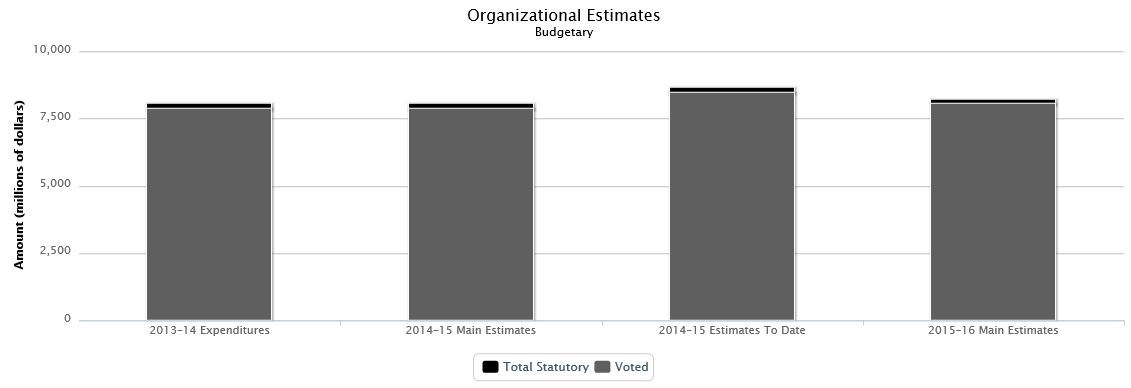
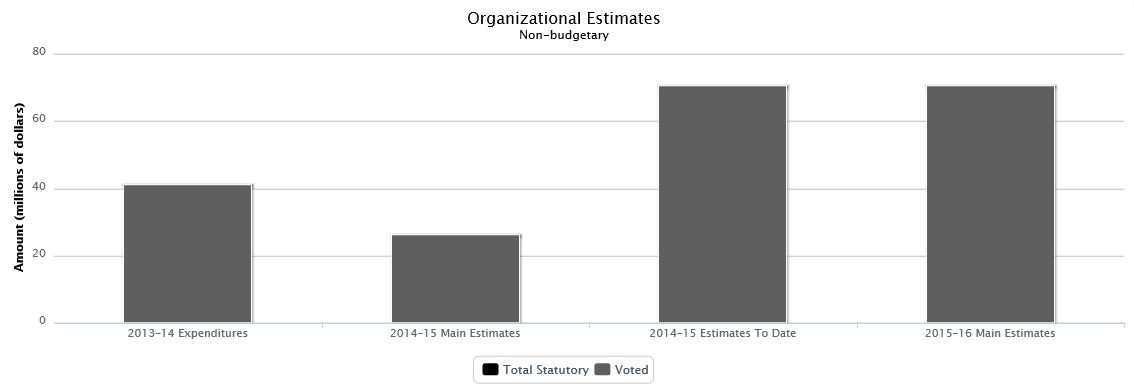
| 2013–14 Expenditures | 2014–15 Main Estimates | 2014–15 Estimates To Date | 2015–16 Main Estimates | ||
|---|---|---|---|---|---|
| Budgetary | |||||
| Voted | |||||
| 1 | Operating expenditures | 1,336,860,834 | 1,215,376,476 | 1,357,162,301 | 1,069,154,628 |
| 5 | Capital expenditures | 6,632,304 | 5,695,536 | 43,811,820 | 35,946,145 |
| 10 | Grants and contributions | 6,509,861,747 | 6,654,152,734 | 7,057,148,703 | 6,936,151,589 |
| Total voted | 7,853,354,885 | 7,875,224,746 | 8,458,122,824 | 8,041,252,362 | |
| Total Statutory | 186,136,790 | 178,750,659 | 181,904,046 | 146,165,506 | |
| Total budgetary | 8,039,491,675 | 8,053,975,405 | 8,640,026,870 | 8,187,417,868 | |
| Non-budgetary | |||||
| Voted | |||||
| L15 | Loans to native claimants | 18,471,689 | 25,903,000 | 39,903,000 | 39,903,000 |
| L20 | Loans to First Nations in British Columbia | 22,472,063 | 0 | 30,400,000 | 30,400,000 |
| Total voted | 40,943,752 | 25,903,000 | 70,303,000 | 70,303,000 | |
| Total non-budgetary | 40,943,752 | 25,903,000 | 70,303,000 | 70,303,000 | |
Highlights
The total Estimates to date of $8.7 billion (budgetary and non-budgetary) for 2014–15 includes $8.1 billion in Main Estimates plus additional funding of about $0.6 billion accessed through Supplementary Estimates. Major items in the $0.6 billion include:
- $155.7 million for the assessment, management and remediation of federal contaminated sites;
- $137.3 million for the First Nations Water and Wastewater Action Plan;
- $88.6 million to support comprehensive claims and self-government negotiations across Canada;
- $69.1 million to advance a comprehensive and sustainable approach to emergency management on reserve and to reimburse First Nations and emergency management service providers for costs incurred as a result of on-reserve response and recovery activities;
- $40.6 million for Operation Return Home: Manitoba Interlake Flood remediation and Settlement;
- $38.7 million for construction of the Canadian High Arctic Research Station and the implementation of the associated Science and Technology Program; and,
- $15.0 million from the new Building Canada Fund to support investments through the First Nations Infrastructure Fund.
Aboriginal Affairs and Northern Development Canada is estimating budgetary and non-budgetary expenditures of $8.3 billion in 2015–16. Of this amount, $8.1 billion requires approval by Parliament and the remainder represents statutory forecasts that do not require additional approval and are provided for information purposes. Note that the 2015–16 Main Estimates do not include any adjustments that may be announced as part of Budget 2015.
The net increase in budgetary and non-budgetary spending of approximately $177.8 million or 2.2% over the 2014–15 Main Estimates, primarily reflects changes in the resource profile for targeted initiatives including:
- An increase of $137.3 million for the First Nations Water and Wastewater Action Plan;
- An increase of $113.1 million for the assessment, management and remediation of federal contaminated sites;
- An increase of $104.9 million to meet increased demand for ongoing Indian and Inuit programs which reflects a 2% allowance for inflation and population growth and provides access to basic services such as education, housing, community infrastructure (water and sewage systems), and social support services;
- A net increase of $68.7 million in the cash flow for the negotiation, settlement and implementation of specific and comprehensive claims (primarily for the renewal of funding to support comprehensive land claims and self-government negotiations across Canada offset by the sunset of statutory funding for the Nisga'a Nation and the Labrador Inuit);
- An increase of $46.2 million for the construction of the Canadian High Arctic Research Station and the implementation of the associated Science and Technology Program;
- An increase of $32.3 million to advance a comprehensive and sustainable approach to Emergency Management on reserve;
- An increase of $17.3 million for the facilitation of Aboriginal participation in West Coast energy development;
- An increase of $15.0 million from the new Building Canada Fund to support investments through the First Nations Infrastructure Fund;
- An increase of $14.6 million to help meet increasing demands of the Nutrition North Canada Program;
- A decrease of $207.9 million for the Indian Residential Schools Settlement Agreement including funding for awards to claimants resulting from the Independent Assessment Process and Alternative Dispute Resolution as well as funding for the administration and research required to support the federal government's obligations under the agreement;
- A decrease of $133.4 million primarily reflecting the sunset of targeted funding for initiatives to improve First Nations Education; and,
- A decrease of $33.4 million to meet the Government of Canada`s obligations under the Northwest Territories Land and Resources Devolution Agreement.
For further details on the department's plans and priorities, please see the 2015–16 Report on Plan and Priorities.
Expenditures by Strategic Outcome and Program
| 2013–14 Expenditures | 2014–15 Main Estimates | 2015–16 Main Estimates | |
|---|---|---|---|
| The People – Individual, family and community well-being for First Nations and Inuit. | |||
| Education | 1,775,804,549 | 1,798,304,555 | 1,779,502,873 |
| Social Development | 1,723,318,991 | 1,666,669,213 | 1,711,936,209 |
| Residential Schools Resolution | 574,379,693 | 646,415,026 | 441,605,934 |
| First Nations Individual Affairs | 33,836,437 | 25,228,617 | 25,732,113 |
| The Government – Support good governance, rights and interests of Aboriginal peoples. | |||
| Aboriginal Rights and Interests | 485,123,423 | 826,318,323 | 868,880,226 |
| Management and Implementation of Agreements and Treaties | 715,832,560 | 719,340,126 | 740,282,191 |
| Governance and Institutions of Government | 484,218,256 | 398,449,544 | 389,416,006 |
| The Land and Economy – Full participation of First Nations, Métis, Non-Status Indians and Inuit individuals and communities in the economy. | |||
| Infrastructure and Capacity | 1,038,948,588 | 1,160,687,268 | 1,252,453,270 |
| Community Economic Development | 0 | 196,637,835 | 213,382,395 |
| Urban Aboriginal Participation | 51,708,349 | 40,014,054 | 53,457,622 |
| Aboriginal Entrepreneurship | 0 | 49,640,071 | 42,637,318 |
| Strategic Partnerships | 0 | 24,738,453 | 39,586,727 |
| The North – Self-reliance, prosperity and well-being for the people and communities of the North. | |||
| Northern Land, Resources and Environmental Management | 238,498,638 | 120,402,745 | 195,493,907 |
| Northern Governance and People | 170,331,482 | 130,218,356 | 150,430,663 |
| Northern Science and Technology | 13,504,948 | 7,320,522 | 48,961,314 |
| The following program supports all strategic outcomes within this organization. | |||
| Internal Services | 375,954,708 | 243,590,697 | 233,659,100 |
| Funds not allocated to the 2015–16 Program Alignment Architecture | 358,031,053 | 0 | 0 |
| Total | 8,039,491,675 | 8,053,975,405 | 8,187,417,868 |
| 2013–14 Expenditures | 2014–15 Main Estimates | 2015–16 Main Estimates | |
|---|---|---|---|
| The Government – Support good governance, rights and interests of Aboriginal peoples. | |||
| Aboriginal Rights and Interests | 40,943,752 | 25,903,000 | 70,303,000 |
| Total | 40,943,752 | 25,903,000 | 70,303,000 |
Listing of the 2015–16 Transfer Payments
| 2013–14 Expenditures | 2014–15 Main Estimates | 2015–16 Main Estimates | |
|---|---|---|---|
| Grants | |||
| Grants to First Nations to settle specific and special claims negotiated by Canada and/or awarded by the Specific Claims Tribunal | 0 | 706,292,860 | 706,292,860 |
| Grants to implement comprehensive land claims and self-government agreements | 0 | 407,791,749 | 444,682,118 |
| Grant for Band Support Funding | 152,355,432 | 231,050,132 | 230,370,291 |
| Grants to the Government of the Northwest Territories and the Government of Nunavut for health care of Indians and Inuit | 51,231,000 | 52,256,000 | 53,301,000 |
| Grant to the Miawpukek Indian Band to support designated programs | 10,220,400 | 10,424,808 | 10,633,304 |
| Grants to provide income support to on-reserve residents | 10,963,536 | 10,000,000 | 10,000,000 |
| Grants for the Political Evolution of the Territories, particularly as it pertains to Devolution | 26,146,842 | 0 | 8,250,036 |
| Grants to support First Nations and Inuit Post-Secondary Educational Advancement | 956,304 | 1,500,000 | 1,500,000 |
| Grants to participating First Nations and the First Nation Education Authority pursuant to the First Nations Jurisdiction over Education in British Columbia Act | 0 | 600,000 | 600,000 |
| Grant to the First Nations Finance Authority pursuant to the First Nations Fiscal and Statistical Management Act | 500,000 | 500,000 | 500,000 |
| Grants to British Columbia Indian bands in lieu of a per capita annuity | 300,000 | 300,000 | 300,000 |
| Grants to support the Advancement of Northern Science and Technology | 0 | 0 | 290,000 |
| Grants to support First Nations Elementary and Secondary Educational Advancement | 9,361 | 150,000 | 150,000 |
| Grants to increase First Nations and Inuit Youth Participation in Education and Labour Market Opportunities | 0 | 45,000 | 45,000 |
| Total Statutory | 87,562,845 | 86,004,927 | 55,988,925 |
| Contributions | |||
| Contributions to support First Nations Elementary and Secondary Educational Advancement | 0 | 1,384,067,155 | 1,371,530,321 |
| Contributions to support the construction and maintenance of community infrastructure | 0 | 1,069,789,156 | 1,121,408,108 |
| Contributions to provide income support to on-reserve residents | 0 | 924,781,896 | 1,014,725,872 |
| Contributions to provide women, children and families ordinarily resident on-reserve with Protection and Prevention Services | 0 | 664,190,368 | 672,053,368 |
| Contributions to support First Nations and Inuit Post-Secondary Educational Advancement | 0 | 345,229,449 | 342,885,217 |
| Contributions to support the negotiation and implementation of Treaties, Claims and self-government agreements or initiatives | 0 | 236,519,817 | 270,102,481 |
| Contributions to support Land Management and Economic Development | 0 | 172,276,708 | 172,059,931 |
| Contributions to supply public services in Indian Government Support and to build strong governance, administrative and accountability systems | 0 | 125,425,899 | 118,853,415 |
| Contributions to support access to healthy foods in isolated northern communities | 63,879,237 | 53,930,000 | 68,498,325 |
| Contributions for emergency management assistance for activities on reserves | 77,129,658 | 35,650,667 | 67,977,822 |
| Contributions to support the Urban Aboriginal Strategy | 47,710,516 | 38,700,980 | 51,172,210 |
| Transfer Payments to the Government of Yukon for the care and maintenance, remediation and management of the closure of contaminated sites in Yukon | 41,121,323 | 0 | 44,473,327 |
| Contributions to increase First Nations and Inuit Youth Participation in Education and Labour Market Opportunities | 0 | 41,376,000 | 36,376,000 |
| Contributions to support the Aboriginal Economic Development Strategic Partnerships Initiative | 13,398,857 | 14,450,000 | 31,700,000 |
| Contributions for the purpose of consultation and policy development | 23,535,348 | 8,052,719 | 26,250,569 |
| Contributions for promoting the safe use, development, conservation and protection of the North's natural resources, and promoting scientific development | 0 | 27,611,000 | 19,943,025 |
| Contributions to support the basic organizational capacity of representative Aboriginal organizations | 28,443,359 | 10,940,796 | 10,940,796 |
| Contributions to First Nations for the management of contaminated sites | 32,497,133 | 3,971,327 | 10,833,108 |
| Contributions to Indian bands for registration administration | 4,213,627 | 8,344,648 | 7,982,403 |
| Federal Interlocutorʼs Contribution Program | 10,917,592 | 13,504,000 | 3,943,588 |
| Contributions to promote social and political development in the North | 0 | 979,000 | 1,907,111 |
| Contributions to support the Advancement of Northern Science and Technology | 0 | 0 | 1,830,000 |
| Transfer payments to the Government of Yukon for the remediation of the Marwell Tar Pit Site to support the Contaminated Sites Program | 250,000 | 90,600 | 1,717,900 |
| Contribution for Inuit counselling in the South | 80,000 | 80,000 | 72,083 |
| Total Statutory | 5,000,000 | 26,730,568 | 26,730,568 |
Indian Residential Schools Truth and Reconciliation Commission
Raison d'être
The Minister of Aboriginal Affairs and Northern Development is responsible for implementing Canada's legal obligation pursuant to the Indian Residential Schools Settlement Agreement which include the Truth and Reconciliation Commission (TRC). The goals are to:
- acknowledge and record the experiences, impacts and consequences of the Indian Residential School (IRS) system on former students, their families, communities, former school employees;
- witness, support, promote and facilitate truth and reconciliation events at both the national and community levels;
- promote awareness and educate Canadians about the IRS system and its impacts;
- identify sources and create a historical record of the IRS system and legacy, by conducting research and establishing a National Research Centre. The record shall be preserved and made accessible to the public for future study and use; and
- produce a report, including any recommendations to government.
Organizational Estimates
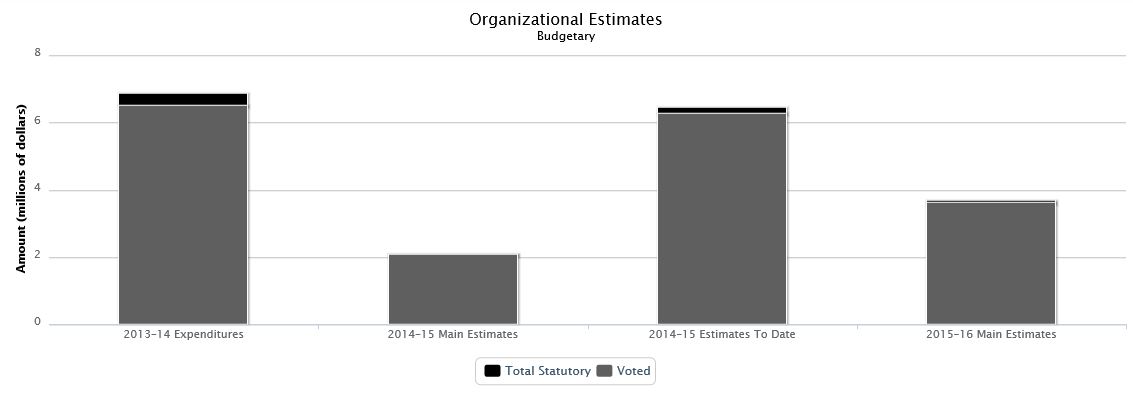
| 2013–14 Expenditures | 2014–15 Main Estimates | 2014–15 Estimates To Date | 2015–16 Main Estimates | ||
|---|---|---|---|---|---|
| Budgetary | |||||
| Voted | |||||
| 1 | Program expenditures | 6,501,067 | 2,062,393 | 6,261,309 | 3,600,757 |
| Total voted | 6,501,067 | 2,062,393 | 6,261,309 | 3,600,757 | |
| Total Statutory | 360,329 | 7,325 | 183,054 | 59,401 | |
| Total budgetary | 6,861,396 | 2,069,718 | 6,444,363 | 3,660,158 | |
Highlights
On , the Minister announced that the Government of Canada will work with the Indian Residential Schools Truth and Reconciliation Commission, the parties to the Indian Residential Schools Settlement Agreement, as well as the Ontario Superior Court to provide TRC with a one-year extension to its operating mandate from to . The Government of Canada also announced additional operating funding for TRC to complete and finalize the work of its mandate.
In , TRC is hosting a Closing Ceremony and will present its final report to the Government of Canada.
Expenditures by Strategic Outcome and Program
| 2013–14 Expenditures | 2014–15 Main Estimates | 2015–16 Main Estimates | |
|---|---|---|---|
| Disclosure and recognition of the truth regarding Indian Residential Schools furthers healing and reconciliation for the individuals and communities affected. | |||
| Truth and Reconciliation | 4,300,396 | 1,719,718 | 2,663,458 |
| The following program supports all strategic outcomes within this organization. | |||
| Internal Services | 2,561,000 | 350,000 | 996,700 |
| Total | 6,861,396 | 2,069,718 | 3,660,158 |
Industry
Raison d'être
Industry Canada's mission is to foster a growing, competitive, knowledge-based Canadian economy. The Department works with Canadians throughout the economy, and in all parts of the country, to improve conditions for investment, improve Canada's innovation performance, increase Canada's share of global trade, and build an efficient and competitive marketplace. Industry Canada's mandate is to help make Canadian industry more productive and competitive in the global economy, thus improving the economic and social well-being of Canadians.
Organizational Estimates

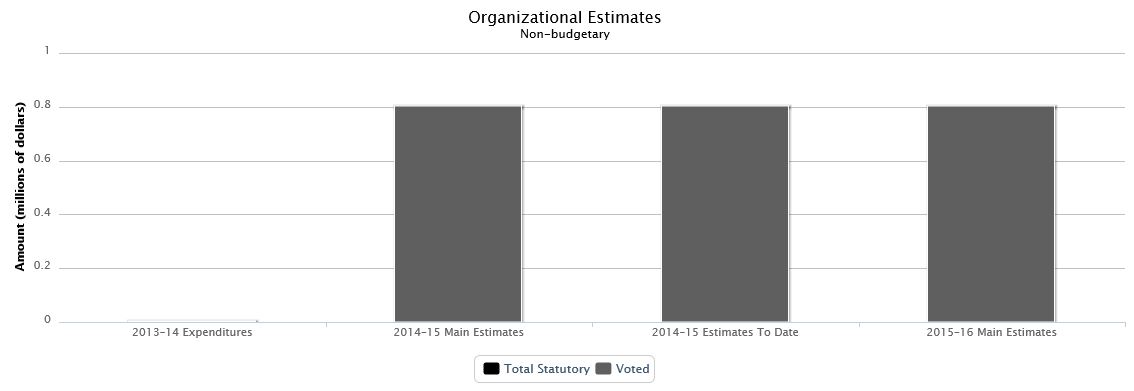
| 2013–14 Expenditures | 2014–15 Main Estimates | 2014–15 Estimates To Date | 2015–16 Main Estimates | ||
|---|---|---|---|---|---|
| Budgetary | |||||
| Voted | |||||
| 1 | Operating expenditures | 373,431,712 | 297,683,017 | 332,669,971 | 303,247,705 |
| 5 | Capital expenditures | 23,496,933 | 16,840,692 | 20,156,382 | 16,528,241 |
| 10 | Grants and contributions | 557,545,624 | 557,723,370 | 592,311,612 | 645,876,909 |
| Total voted | 954,474,269 | 872,247,079 | 945,137,965 | 965,652,855 | |
| Total Statutory | 161,001,195 | 205,496,434 | 205,940,021 | 204,849,301 | |
| Total budgetary | 1,115,475,464 | 1,077,743,513 | 1,151,077,986 | 1,170,502,156 | |
| Non-budgetary | |||||
| Voted | |||||
| L15 | Payments pursuant to subsection 14(2) of the Department of Industry Act | 0 | 300,000 | 300,000 | 300,000 |
| L20 | Loans pursuant to paragraph 14(1)(a) of the Department of Industry Act | 0 | 500,000 | 500,000 | 500,000 |
| Total voted | 0 | 800,000 | 800,000 | 800,000 | |
| Total non-budgetary | 0 | 800,000 | 800,000 | 800,000 | |
Highlights
Industry Canada has three mandated strategic outcomes:
- The Canadian marketplace is efficient and competitive;
- Advancements in science and technology, knowledge, and innovation strengthen the Canadian Economy; and
- Canadian businesses and communities are competitive.
In 2015–16, the Department will be focusing on a number of key priorities in support of the outcomes noted above. For additional information, please refer to the 2015–16 Report on Plans and Priorities.
Industry Canada is estimating budgetary expenditures of $1.2 billion in 2015–16. Of this amount, $965.7 million requires approval by Parliament. The remaining $204.8 million represents statutory forecasts that do not require additional approval and are provided for information purposes only.
The 2015–16 Main Estimates present an overall increase of $92.8 million compared to 2014–15.
Major changes are:
- New funding from Budget 2014 for: the new Connecting Canadians program ($79.3 million); the Computers for Schools program and its youth component ($7.9 million); the Institute for Quantum Computing ($5 million); Mitacs Inc. ($5 million); and for reducing barriers on internal trade ($900 thousand); and
- Increases in contributions funding under the Technology Demonstration Program ($17 million) and the Strategic Aerospace Defence Initiative ($8.8 million) for investments in projects in the aerospace industry; and for the Canada Foundation for Innovation ($8.9 million) to support advanced research infrastructure.
These increases are partially offset by the following decreases:
- The sunset of three Grants and Contributions programs: Canarie Inc. ($26.4 million), Canadian Youth Business Foundation ($9 million) and Technology Partnerships Canada ($500 thousand); and
- A reduction in the grants and contributions to Genome Canada ($7.9 million) as a result of changes in the approved cash flow requirements of that program.
Explanation of Estimates to Date for 2014–15
Industry Canada showed a significant increase to its Estimates to date for 2014–15. This is a recurring occurrence for the department, for the following reasons:
- Industry Canada is partly funded from royalty payments it collected in the previous year. These can only be accessed through Supplementary Estimates, once amounts collected have been officially validated; and
- Every year, Industry Canada accesses new funding stemming from Budget announcements through Supplementary Estimates. In 2014–15, the Department accessed new funding from Budget 2014 for four programs: Connecting Canadians, Institute for Quantum Computing, Computers for Schools and Mitacs Inc.
Expenditures by Strategic Outcome and Program
| 2013–14 Expenditures | 2014–15 Main Estimates | 2015–16 Main Estimates | |
|---|---|---|---|
| Advancements in science and technology, knowledge, and innovation strengthen the Canadian economy. | |||
| Science, Technology and Innovation Capacity | 210,195,969 | 319,889,018 | 304,380,758 |
| Industrial Research and Development Financing | 330,580,008 | 262,634,343 | 287,630,154 |
| Canadian businesses and communities are competitive. | |||
| Community Economic Development | 72,366,822 | 61,707,284 | 150,391,867 |
| Small Business Research, Financing and Services | 85,577,041 | 95,390,065 | 86,766,345 |
| Industrial Competitiveness and Capacity | 37,132,066 | 31,560,065 | 34,249,228 |
| The Canadian marketplace is efficient and competitive. | |||
| Spectrum, Telecommunications, and the Digital Economy | 104,364,290 | 114,149,657 | 109,811,139 |
| Marketplace Frameworks and Regulation | 47,207,056 | 54,391,487 | 56,111,095 |
| Marketplace Competition and Investments | 0 | 46,211,463 | 47,089,170 |
| The following program supports all strategic outcomes within this organization. | |||
| Internal Services | 138,479,491 | 91,810,131 | 94,072,400 |
| Funds not allocated to the 2015–16 Program Alignment Architecture | 89,572,721 | 0 | 0 |
| Total | 1,115,475,464 | 1,077,743,513 | 1,170,502,156 |
| 2013–14 Expenditures | 2014–15 Main Estimates | 2015–16 Main Estimates | |
|---|---|---|---|
| Canadian businesses and communities are competitive. | |||
| Industrial Competitiveness and Capacity | 0 | 800,000 | 800,000 |
| Total | 0 | 800,000 | 800,000 |
Listing of the 2015–16 Transfer Payments
| 2013–14 Expenditures | 2014–15 Main Estimates | 2015–16 Main Estimates | |
|---|---|---|---|
| Grants | |||
| Grant to the International Telecommunication Union, Geneva, Switzerland | 4,808,000 | 4,808,000 | 4,808,000 |
| Grant to the Internal Trade Secretariat Corporation | 337,500 | 550,000 | 550,000 |
| Grant to the Organisation for Economic Co-operation and Development | 0 | 300,000 | 300,000 |
| Grant to the Radio Advisory Board of Canada | 85,000 | 85,000 | 85,000 |
| Total Statutory | 0 | 13,800,000 | 13,600,000 |
| Contributions | |||
| Contributions under the Strategic Aerospace and Defence Initiative | 182,045,487 | 176,924,000 | 185,687,000 |
| Contributions under the Canada Foundation for Innovation | 85,300,000 | 168,200,000 | 177,100,000 |
| Contributions under the Connecting Canadians Program | 0 | 0 | 76,000,000 |
| Contributions under the Automotive Innovation Fund | 55,882,771 | 64,584,802 | 64,700,099 |
| Contributions under the Northern Ontario Development Program | 28,576,221 | 31,840,000 | 31,840,000 |
| Contributions under the Technology Demonstration Program | 0 | 10,181,560 | 27,181,560 |
| Contributions to Mitacs Inc. | 12,975,000 | 13,975,000 | 19,000,000 |
| Contributions under the Broadband Connecting Rural Canadian Program | 6,534,431 | 10,800,000 | 12,325,000 |
| Contributions to the Perimeter Institute for Theoretical Physics | 10,000,000 | 10,000,000 | 10,000,000 |
| Contributions under the Community Futures Program | 8,360,008 | 8,360,008 | 8,360,008 |
| Contributions to Genome Canada | 21,200,000 | 22,500,000 | 7,500,000 |
| Contributions to the Canadian Institute for Advanced Research | 5,000,000 | 5,000,000 | 5,000,000 |
| Contributions to the University of Waterloo for the purpose of the Institute for Quantum Computing | 0 | 0 | 4,975,000 |
| Contributions under the Computers for Schools program | 4,000,000 | 0 | 4,000,000 |
| Contributions under the Youth Employment Strategy – Computers for Schools program | 3,173,299 | 0 | 3,200,242 |
| Contributions under the Program for Non-Profit Consumer and Voluntary Organizations | 1,660,466 | 1,690,000 | 1,690,000 |
| Contributions under the Economic Development Initiative | 0 | 1,025,000 | 975,000 |
| Contributions under the Strategic Activities Program | 800,000 | 0 | 600,000 |
| Total Statutory | 103,584,724 | 132,452,000 | 130,654,000 |
International Development Research Centre
Raison d'être
Part of Canada's foreign affairs and development efforts, the International Development Research Centre (IDRC) invests in knowledge, innovation, and solutions to improve lives and livelihoods in the developing world. Bringing together the right partners around opportunities for impact, IDRC builds leaders for today and tomorrow and helps drive change for those who need it most.
IDRC was established by an Act of Canada's Parliament in 1970 to help developing countries find solutions to their challenges. A leader among the world's top funders of development research, IDRC wields considerable influence in this field, and boosts Canada's reputation as an innovative and important player on the world stage.
IDRC is governed by a board of up to 14 governors, whose chairperson reports to Canada's Parliament through the Minister of Foreign Affairs.
Organizational Estimates
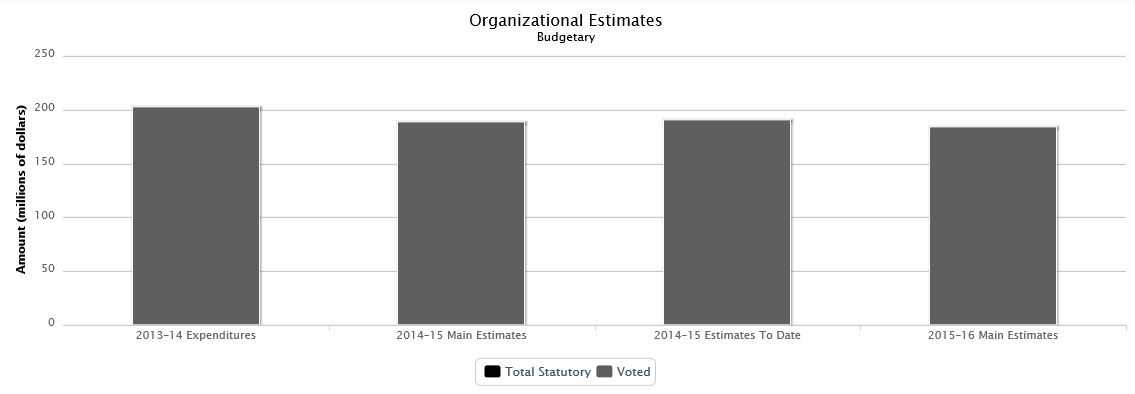
| 2013–14 Expenditures | 2014–15 Main Estimates | 2014–15 Estimates To Date | 2015–16 Main Estimates | ||
|---|---|---|---|---|---|
| Budgetary | |||||
| Voted | |||||
| 1 | Payments to the International Development Research Centre | 202,416,279 | 188,019,646 | 190,019,647 | 183,478,242 |
| Total voted | 202,416,279 | 188,019,646 | 190,019,647 | 183,478,242 | |
| Total budgetary | 202,416,279 | 188,019,646 | 190,019,647 | 183,478,242 | |
Highlights
IDRC is estimating budgetary expenditures of $183.5 million in 2015–16, which requires approval by Parliament.
IDRC's year-over-year decrease of $4.5 million from the 2014–15 Main Estimates includes:
- An increase of $1.1 million from the Canadian Institutes of Health Research to support maternal, newborn and child health research;
- A decrease of $4.0 million related to the Next Einstein Initiative in mathematical science and support for African Adaptation Research Centres; and,
- A decrease of $1.2 million related to the funding from Canadian Institutes of Health, Natural Sciences and Engineering Research Council and Social Sciences and Humanities Research Council for the International Research Initiative on Adaptation to Climate Change.
Expenditures by Strategic Outcome and Program
| 2013–14 Expenditures | 2014–15 Main Estimates | 2015–16 Main Estimates | |
|---|---|---|---|
| Stronger capacity in developing countries to research and propose solutions that support sustainable and equitable development and poverty reduction. | |||
| Research on Development Challenges | 0 | 128,981,477 | 126,930,197 |
| Capacity to Do, Use and Manage Research | 0 | 40,800,263 | 38,214,480 |
| The following program supports all strategic outcomes within this organization. | |||
| Internal Services | 0 | 18,237,906 | 18,333,565 |
| Funds not allocated to the 2015–16 Program Alignment Architecture | 202,416,279 | 0 | 0 |
| Total | 202,416,279 | 188,019,646 | 183,478,242 |
International Joint Commission (Canadian Section)
Raison d'être
The International Joint Commissionʼs mandate is prompt and effective prevention and/or resolution of potential disputes under the Boundary Water Treaty and Great Lakes Water Quality Agreement to ensure there are no negative impacts on Canada-U.S. relations.
The Minister of Foreign Affairs is responsible for this organization.
Organizational Estimates
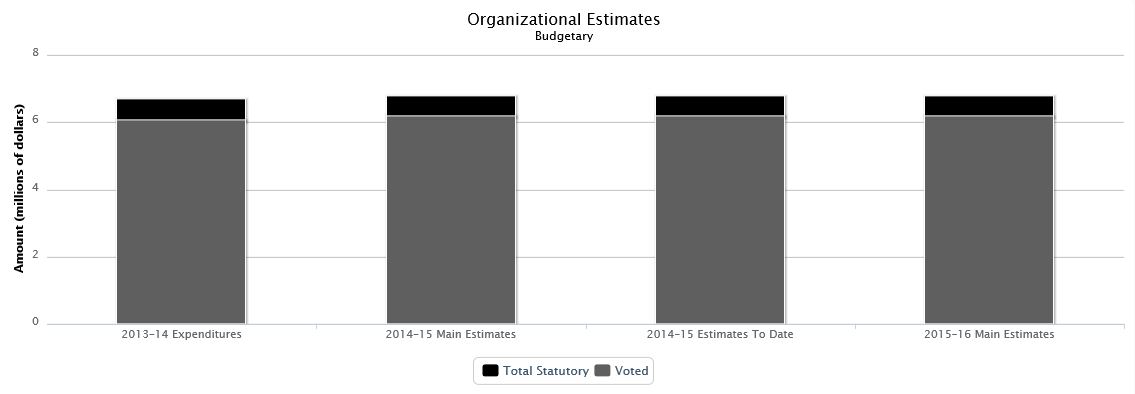
| 2013–14 Expenditures | 2014–15 Main Estimates | 2014–15 Estimates To Date | 2015–16 Main Estimates | ||
|---|---|---|---|---|---|
| Budgetary | |||||
| Voted | |||||
| 1 | Program expenditures | 6,045,036 | 6,169,457 | 6,169,457 | 6,172,075 |
| Total voted | 6,045,036 | 6,169,457 | 6,169,457 | 6,172,075 | |
| Total Statutory | 624,859 | 577,500 | 577,500 | 588,969 | |
| Total budgetary | 6,669,895 | 6,746,957 | 6,746,957 | 6,761,044 | |
Highlights
Under the International Watersheds Initiative, there are many strategic efforts underway that are being completed and are helping to anticipate, prevent and resolve water-related issues at the local level before they develop into international issues, for example:
- Hydrographic data harmonization in trans-boundary basins;
- Binational water quality modelling in the Red-Souris basins; and
- An adaptive management strategy for the Great Lakes-St. Lawrence system.
The International Joint Commission is also implementing a Plan of Study for Review of the Orders for the Rainy River and Namakan Reservoir system that provides the science-basis and knowledge for informed decision-making. There are six projects being completed on the Canadian side to evaluate the regulation of water levels and involve:
- Hydrologic, hydraulic and habitat modelling in the system;
- Assessing flood inpacts on historic First Nations cultural resources;
- Assessing residential flooding potential.
The Commission has also undertaken foundational scientific work on the Lake Champlain Richelieu River system to alleviate future flooding and is working to modernize the regulation of Great Lakes water levels. The renewed governance of the Commissionʼs Great Lakes advisory boards and launching of their renewed work plans focus on implementation of the 2012 Great Lakes Water Quality Agreement.
Expenditures by Strategic Outcome and Program
| 2013–14 Expenditures | 2014–15 Main Estimates | 2015–16 Main Estimates | |
|---|---|---|---|
| Prompt and effective prevention and/or resolution of potential disputes under the Boundary Water Treaty and Great Lakes Water Quality Agreement to ensure they have no negative impact on Canada-US relations. | |||
| Boundary Waters Treaty | 4,437,575 | 4,635,457 | 4,850,044 |
| Great Lakes Water Quality Agreement | 2,232,320 | 2,111,500 | 1,911,000 |
| Total | 6,669,895 | 6,746,957 | 6,761,044 |
Justice
Raison d'être
The Department of Justice has the mandate to support the dual roles of the Minister of Justice and the Attorney General of Canada. Under Canada's federal system, the administration of justice is an area of shared jurisdiction between the federal government and the provinces and territories. The Department supports the Minister of Justice in his responsibilities for 50 statutes and areas of federal law by ensuring a bilingual and bijural national legal framework, principally within the following domains: criminal justice (including youth criminal justice), family justice, access to justice, Aboriginal justice, public law and private international law. The Department also supports the Attorney General as the chief law officer of the Crown, both in terms of the ongoing operations of government and of the development of new policies, programs and services for Canadians. The Department provides legal advice to the Government and federal government departments and agencies, represents the Crown in civil litigation and before administrative tribunals, and drafts legislation.
Organizational Estimates
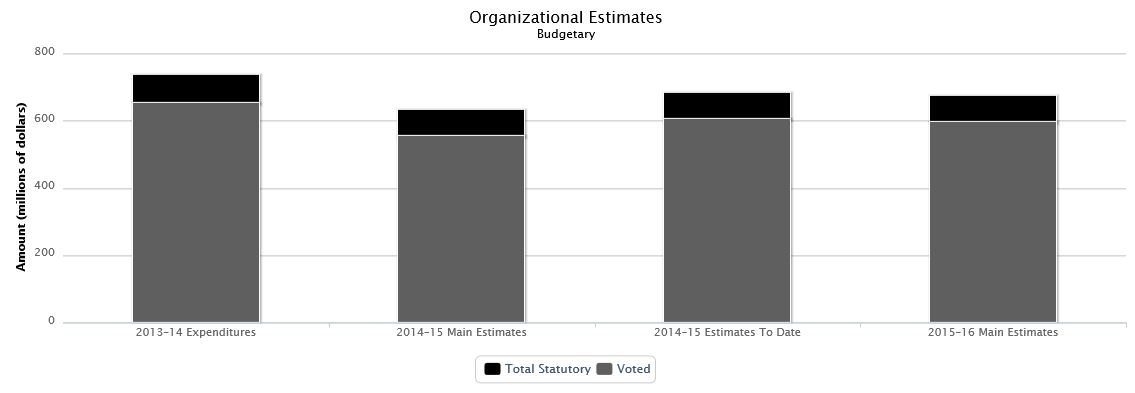
| 2013–14 Expenditures | 2014–15 Main Estimates | 2014–15 Estimates To Date | 2015–16 Main Estimates | ||
|---|---|---|---|---|---|
| Budgetary | |||||
| Voted | |||||
| 1 | Operating expenditures | 308,287,237 | 236,861,079 | 248,217,598 | 241,797,227 |
| 5 | Grants and contributions | 345,578,345 | 317,485,223 | 356,435,223 | 354,900,159 |
| Total voted | 653,865,582 | 554,346,302 | 604,652,821 | 596,697,386 | |
| Total Statutory | 83,175,282 | 76,241,572 | 77,501,864 | 77,169,488 | |
| Total budgetary | 737,040,864 | 630,587,874 | 682,154,685 | 673,866,874 | |
Highlights
The Department of Justice is estimating net budgetary expenditures of $673.9 million in 2015–16, of which $354.9 million is for expenditures linked to Grants and Contributions; $241.8 million is for the departmental operating expenditures; and $77.2 million associated with statutory expenditures. As the primary legal services provider to other government departments and agencies, the Department of Justice collects fees for services rendered. An additional $296.2 million is planned to be collected and expended in 2015–16 under the department's Net Vote Revenue Authority.
With the funds presented in these Main Estimates, the Department of Justice will fulfill three distinctive roles within the Government of Canada. It acts as:
- A policy department with broad responsibilities for overseeing all matters relating to the administration of justice that fall within the federal domain—in this capacity, it helps to ensure a fair, relevant and accessible justice system for all Canadians;
- A provider of a range of legal advisory, litigation and legislative services to government departments and agencies; and,
- A central agency responsible for supporting the Minister in advising Cabinet on all legal matters.
For more detailed information consult the Department of Justice 2015–16 Report on Plans and Priorities.
The Department of Justice's total authority will increase by $43.3 million from the 2014–15 Main Estimates. The primary changes include:
- An increase of $22.8 million for the renewal of the funding for the Supporting Families Experiencing Separation and Divorce Initiative;
- An increase of $14.4 million for the renewal of the funding for the delivery of immigration and refugee legal aid in provinces and territories and the management of court-ordered counsel in federal prosecutions;
- An increase of $11.0 million for the renewal of the funding for the Aboriginal Justice Strategy;
- An increase of $3.0 million for the renewal of the funding for comprehensive claims and self-government negotiations across Canada;
- An increase of $1.9 million in funding in support of non-legislative measures to address prostitution;
- An increase of $1.5 million to reflect an increase in the employee benefit plan rate;
- A decrease of $1.6 million due to the sunsetting of the funding to support victim services and violence prevention in Aboriginal communities and to increase national support for missing persons investigations;
- A decrease of $1.6 million due to the Legal Services Review; and,
- A decrease of $7.4 million due to the sunsetting of the funding to address challenges in the management of security inadmissibility cases, protect classified information in immigration proceedings, and obtain assurances against torture in exceptional removal cases.
In 2013–14, the Department of Justice had total net spending of $737.0 million. These included expenditures linked to funding received from Treasury Board Central Votes of $90.3 million for Paylist Requirements, Operating Budget Carry Forward and Compensation Adjustments.
As part of the Government's commitment to better and more effectively manage resources on an ongoing basis, a horizontal review of legal services was undertaken in 2013–14 to improve the delivery of legal services government-wide, with a view to manage the demand for legal services to ensure the fiscal sustainability of those services in the long term.
As demand for legal services continues to fluctuate, the profile of its total authorities has changed in recent years. From 2009–10 Main Estimates to 2015–16 Main Estimates, the trend shows a decrease of 6.1%.in base operating funding ($257.4 million to $241.8 million excluding EBP) while the total approved Net Vote Revenue Authority increased from $178.0 million to $296.2 million or 66.4%. While the Department's base resources related to the costs of legal services were reduced as Justice underwent its Strategic Review in 2008 and Deficit Reduction Action Plan, the Net Vote Revenue Authority has grown largely due to the increase in demand for legal services and the increase in the salary cost related to the implementation of collective agreements.
Expenditures by Strategic Outcome and Program
| 2013–14 Expenditures | 2014–15 Main Estimates | 2015–16 Main Estimates | |
|---|---|---|---|
| A Fair, Relevant and Accessible Canadian Justice System. | |||
| Stewardship of the Canadian Legal Framework | 382,305,605 | 348,317,035 | 393,390,464 |
| Office of the Federal Ombudsman for Victims of Crime | 1,195,444 | 1,318,570 | 1,320,994 |
| A Federal Government that is Supported by High Quality Legal Services. | |||
| Legal Services to Government Program | 191,292,725 | 194,550,000 | 192,604,324 |
| The following program supports all strategic outcomes within this organization. | |||
| Internal Services | 162,247,090 | 86,402,269 | 86,551,092 |
| Total | 737,040,864 | 630,587,874 | 673,866,874 |
Listing of the 2015–16 Transfer Payments
| 2013–14 Expenditures | 2014–15 Main Estimates | 2015–16 Main Estimates | |
|---|---|---|---|
| Grants | |||
| Grants from the Victims Fund | 1,745,910 | 3,250,000 | 3,250,000 |
| Grant under the Justice Partnership and Innovation Program | 0 | 0 | 1,749,158 |
| Grants under the Access to Justice in both Official Languages Support Fund | 49,466 | 600,000 | 600,000 |
| Grants in support of the Youth Justice Fund | 482,144 | 679,655 | 79,655 |
| Grants under the Aboriginal Justice Strategy Fund | 0 | 0 | 50,000 |
| Grants in support of the Supporting Families Fund | 0 | 0 | 50,000 |
| Contributions | |||
| Contributions to the provinces and territories in support of the youth justice services | 141,692,415 | 141,692,415 | 141,692,415 |
| Contributions to the provinces to assist in the operation of legal aid systems | 120,327,507 | 108,827,507 | 120,327,507 |
| Contributions in support of the Supporting Families Fund | 15,999,842 | 0 | 15,950,000 |
| Contributions under the Aboriginal Justice Strategy Fund | 12,443,549 | 2,900,000 | 12,650,000 |
| Contributions to the provinces and territories in support of the youth justice services – Intensive Rehabilitative Custody and Supervision Program | 10,770,273 | 11,048,000 | 11,048,000 |
| Contributions from the Victims Fund | 8,929,669 | 8,253,223 | 9,148,159 |
| Contributions to support the implementation of official languages requirements under the Contraventions Act | 4,938,711 | 9,094,900 | 9,094,900 |
| Contributions under the Access to Justice in Both Official Languages Support Fund | 4,231,006 | 5,892,845 | 5,892,845 |
| Contributions to the provinces under the Aboriginal Courtwork Program | 5,155,570 | 4,911,363 | 4,911,363 |
| Contributions for Access to Justice Services to the Territories (being Legal Aid, Aboriginal Courtwork and Public Legal Education and Information Services) | 4,856,593 | 4,856,593 | 4,856,593 |
| Contributions in support of the Youth Justice Fund | 3,266,760 | 3,825,345 | 4,425,345 |
| Drug Treatment Court Funding Program | 3,582,810 | 3,631,276 | 3,631,276 |
| Contributions in support of Public Security and Anti-Terrorism – Legal Aid | 1,282,561 | 2,880,000 | 2,000,000 |
| Contributions in support of Federal Court Ordered Counsel Cases | 1,648,144 | 0 | 1,650,000 |
| Contributions under the Justice Partnership and Innovation Program | 2,364,470 | 2,568,756 | 962,943 |
| Integrated Market Enforcement Teams Reserve Fund | 0 | 550,000 | 550,000 |
| Contributions to the Hague Conference on Private International Law | 731,874 | 250,000 | 250,000 |
| Contributions to the International Institute for the Unification of Private Law (UNIDROIT) | 192,710 | 80,000 | 80,000 |
Library and Archives of Canada
Raison d'être
The Minister of Canadian Heritage and Official Languages is responsible for Library and Archives of Canada.
The mandate of Library and Archives of Canada under the Library and Archives of Canada Act is to:
- Preserve the documentary heritage of Canada for the benefit of present and future generations;
- Serve as a source of enduring knowledge accessible to all, contributing to the cultural, social, and economic advancement of Canada as a free and democratic society;
- Facilitate cooperation among Canadian communities involved in the acquisition, preservation, and diffusion of knowledge; and
- Serve as the continuing memory of the Government of Canada and its institutions.
Organizational Estimates
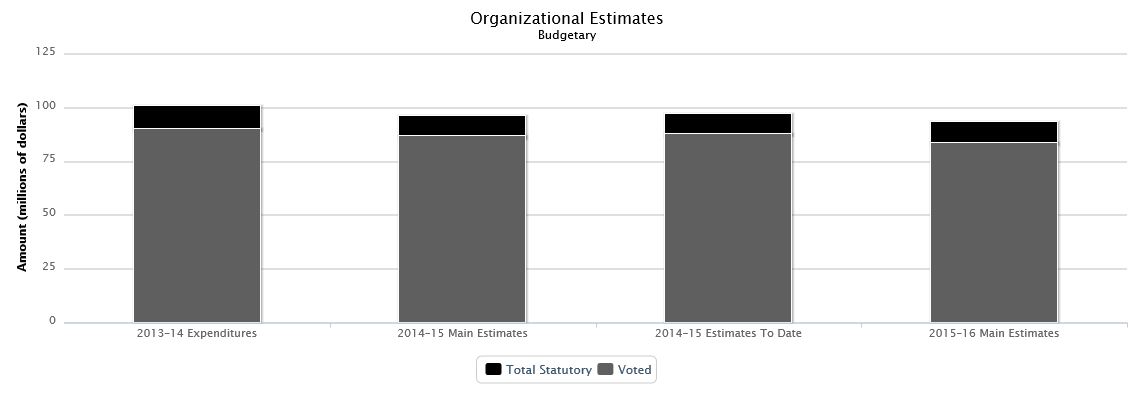
| 2013–14 Expenditures | 2014–15 Main Estimates | 2014–15 Estimates To Date | 2015–16 Main Estimates | ||
|---|---|---|---|---|---|
| Budgetary | |||||
| Voted | |||||
| 1 | Program expenditures | 89,849,885 | 86,431,409 | 87,431,410 | 83,183,100 |
| Total voted | 89,849,885 | 86,431,409 | 87,431,410 | 83,183,100 | |
| Total Statutory | 10,953,807 | 9,433,379 | 9,433,379 | 9,828,389 | |
| Total budgetary | 100,803,692 | 95,864,788 | 96,864,789 | 93,011,489 | |
Highlights
An overall decrease of $2.9 million between the 2014–15 and 2015–16 Main Estimates is mainly due to a decrease of $3.1 million for the conversion of a commercial building in Gatineau, Quebec, into a collection storage facility with a high-density shelving system.
Expenditures by Strategic Outcome and Program
| 2013–14 Expenditures | 2014–15 Main Estimates | 2015–16 Main Estimates | |
|---|---|---|---|
| Canada's continuing memory is documented and accessible to current and future generations. | |||
| Access to documentary heritage | 31,959,088 | 28,589,912 | 29,762,349 |
| Stewardship of documentary heritage | 18,019,293 | 23,377,784 | 16,742,862 |
| Documentation of Canadian society | 15,112,669 | 12,902,706 | 11,591,441 |
| Current government information is managed to support government accountability. | |||
| Collaboration in the management of government records | 8,506,781 | 7,595,563 | 6,212,732 |
| Development of regulatory instruments and recordkeeping tools | 2,694,577 | 3,471,762 | 2,753,175 |
| The following program supports all strategic outcomes within this organization. | |||
| Internal Services | 24,511,284 | 19,927,061 | 25,948,930 |
| Total | 100,803,692 | 95,864,788 | 93,011,489 |
Listing of the 2015–16 Transfer Payments
| 2013–14 Expenditures | 2014–15 Main Estimates | 2015–16 Main Estimates | |
|---|---|---|---|
| Grants | |||
| International Serials Data System | 26,116 | 25,000 | 25,000 |
| International Federation of Library Associations and Institutions | 10,650 | 11,000 | 11,000 |
Library of Parliament
Raison d'être
Formally established under the Parliament of Canada Act, the Library of Parliament's (the Library) efforts in support of an informed and accessible Parliament pre-date Confederation.
The Library provides Senators, MPs, and parliamentary committees with the independent, non-partisan information they need to examine the issues of the day, consider legislation and hold the government accountable. It preserves Parliament's rich documentary heritage while optimizing access to its important collections. It also welcomes hundreds of thousands of visitors to Parliament each year, and offers interpretive tours and educational programs and products to help the public understand Parliament's role in our democratic system and the important work parliamentarians do.
The Speakers of the Senate and the House of Commons are vested with the direction and control of the Library of Parliament in accordance with the Parliament of Canada Act.
Organizational Estimates
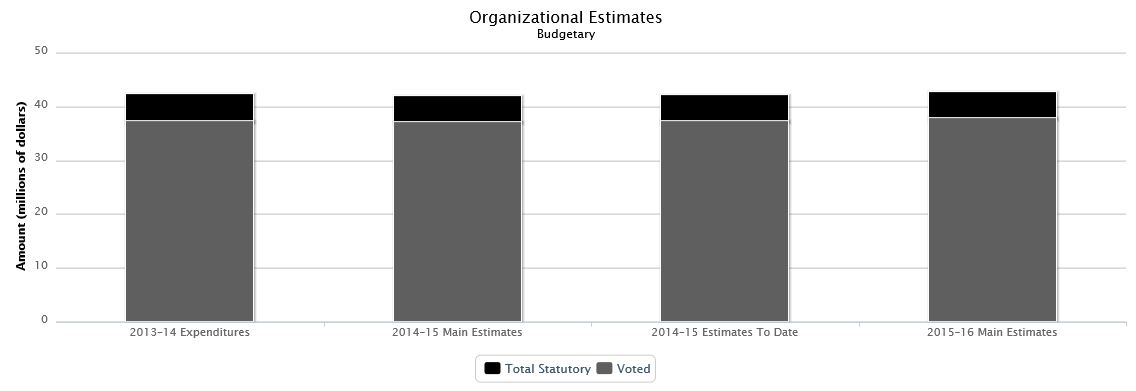
| 2013–14 Expenditures | 2014–15 Main Estimates | 2014–15 Estimates To Date | 2015–16 Main Estimates | ||
|---|---|---|---|---|---|
| Budgetary | |||||
| Voted | |||||
| 1 | Program expenditures | 37,347,525 | 37,117,035 | 37,317,035 | 37,754,035 |
| Total voted | 37,347,525 | 37,117,035 | 37,317,035 | 37,754,035 | |
| Total Statutory | 4,983,016 | 4,852,972 | 4,852,972 | 4,985,560 | |
| Total budgetary | 42,330,541 | 41,970,007 | 42,170,007 | 42,739,595 | |
Highlights
The Library is estimating budgetary expenditures of $42.7 million in 2015–16. Of this amount, $37.7 million requires approval by Parliament. The remaining $5.0 million represents statutory forecasts that do not require additional approval and are provided for information purposes.
The Library's operating budget has been adjusted to include expenses for security enhancements related to visitor services.
The Library continues to build on the tradition of service while responding to the challenges of a 21st century Parliament. The Library's professional staff is committed to meeting the evolving needs of parliamentarians for timely and authoritative information, research and analysis.
This information should be read in conjunction with the Library's Strategic Outlook 2012–2017.
Expenditures by Strategic Outcome and Program
| 2013–14 Expenditures | 2014–15 Main Estimates | 2015–16 Main Estimates | |
|---|---|---|---|
| An Informed and Accessible Parliament. | |||
| Information Support for Parliament | 32,716,190 | 32,386,644 | 33,088,740 |
| The following program supports all strategic outcomes within this organization. | |||
| Internal Services | 9,614,351 | 9,583,363 | 9,650,855 |
| Total | 42,330,541 | 41,970,007 | 42,739,595 |
Marine Atlantic Inc.
Raison d'être
Marine Atlantic Inc. (MAI) is a parent Crown Corporation created through the Marine Atlantic Acquisition Authorization Act, 1986 and replaced Canadian National Marine in providing a year-round constitutionally mandated ferry service between North Sydney, Nova Scotia and Port aux Basques, Newfoundland and Labrador (NL). This is the only constitutionally mandated ferry service in Canada. MAI also operates a non-mandated, seasonal service between North Sydney and Argentia, NL. MAI carries over 25 percent of all non-resident visitors to NL, as well as 66 percent of freight and 90 percent of perishables and time sensitive goods. The service is considered vital as infrastructure for businesses across Canada that are involved in the regional economy and for the movement of people on and off the island of Newfoundland. The Minister of Transport is responsible for this organization.
Organizational Estimates
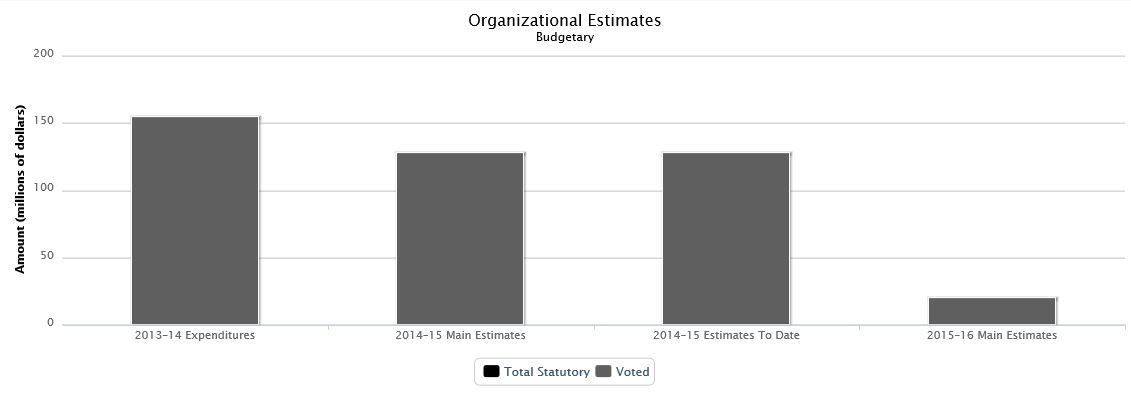
| 2013–14 Expenditures | 2014–15 Main Estimates | 2014–15 Estimates To Date | 2015–16 Main Estimates | ||
|---|---|---|---|---|---|
| Budgetary | |||||
| Voted | |||||
| 1 | Payments to Marine Atlantic Inc. | 154,430,000 | 127,484,000 | 127,484,000 | 19,384,000 |
| Total voted | 154,430,000 | 127,484,000 | 127,484,000 | 19,384,000 | |
| Total budgetary | 154,430,000 | 127,484,000 | 127,484,000 | 19,384,000 | |
Highlights
MAI is estimating budgetary expenditures of $19.4 million in 2015–16 which require approval by Parliament.
A net decrease of $108.1 million is due to a decrease of $97.0 million in operating funding and a decrease of $11.1 million in capital funding available to the corporation as five-year incremental funding provided by Budget 2010 ended in fiscal 2014–15. The Budget 2010 funding was used to renew the corporation's fleet by chartering three vessels, invest in shore-based projects at MAI.'s three terminal sites and for operating expenditures.
Expenditures by Strategic Outcome and Program
| 2013–14 Expenditures | 2014–15 Main Estimates | 2015–16 Main Estimates | |
|---|---|---|---|
| A safe, reliable, efficient, affordable and environmentally responsible ferry service between the Island of Newfoundland and the Province of Nova Scotia. | |||
| Ferry Services | 0 | 127,484,000 | 19,384,000 |
| Funds not allocated to the 2015–16 Program Alignment Architecture | 154,430,000 | 0 | 0 |
| Total | 154,430,000 | 127,484,000 | 19,384,000 |
Military Grievances External Review Committee
Raison d'être
The raison d'être of the Military Grievances External Review Committee (the Committee or MGERC) is to provide an independent and external review of military grievances. Section 29 of the National Defence Act provides a statutory right for an officer or a non-commissioned member who has been aggrieved, to grieve a decision, an act or an omission in the administration of the affairs of the Canadian Armed Forces. The importance of this broad right cannot be overstated since it is, with certain narrow exceptions, the only formal complaint process available to Canadian Armed Forces members. The Minister of National Defence is responsible for this organization.
Organizational Estimates
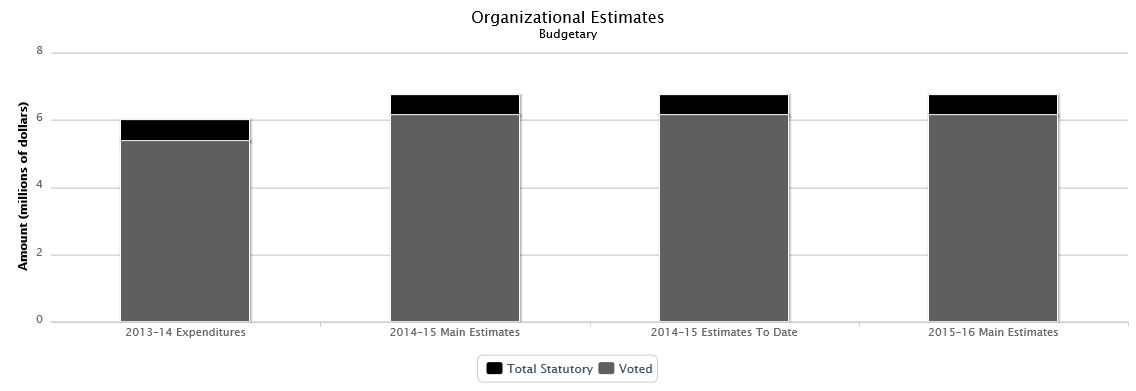
| 2013–14 Expenditures | 2014–15 Main Estimates | 2014–15 Estimates To Date | 2015–16 Main Estimates | ||
|---|---|---|---|---|---|
| Budgetary | |||||
| Voted | |||||
| 1 | Program expenditures | 5,356,375 | 6,144,993 | 6,144,993 | 6,143,503 |
| Total voted | 5,356,375 | 6,144,993 | 6,144,993 | 6,143,503 | |
| Total Statutory | 624,630 | 585,584 | 585,584 | 598,307 | |
| Total budgetary | 5,981,005 | 6,730,577 | 6,730,577 | 6,741,810 | |
Highlights
The Committee is estimating budgetary expenditures of $6.7 million in 2015–16. Of this amount $6.1 million requires approval by Parliament. The remaining amount of $598.3 thousand dollars represents a statutory forecast that does not require additional approval and is provided for information purposes. The Committee's planned expenditures remain approximately the same as the previous year.
Expenditures by Strategic Outcome and Program
| 2013–14 Expenditures | 2014–15 Main Estimates | 2015–16 Main Estimates | |
|---|---|---|---|
| The Chief of the Defence Staff and members of the Canadian Armed Forces have access to a fair, independent and timely review of military grievances. | |||
| Independent review of military grievances | 4,050,351 | 4,711,404 | 4,719,267 |
| The following program supports all strategic outcomes within this organization. | |||
| Internal Services | 1,930,654 | 2,019,173 | 2,022,543 |
| Total | 5,981,005 | 6,730,577 | 6,741,810 |
Military Police Complaints Commission
Raison d'être
On behalf of all Canadians, the Military Police Complaints Commission (MPCC) exists to provide greater public accountability by the Military Police and the chain of command in relation to Military Police activities. The MPCC derives its mandate from Part IV of Canadaʼs National Defence Act (NDA).
While it reports to Parliament through the Minister of National Defence, the MPCC is both administratively and legally independent from the Department of National Defence and the Canadian Armed Forces.
Organizational Estimates
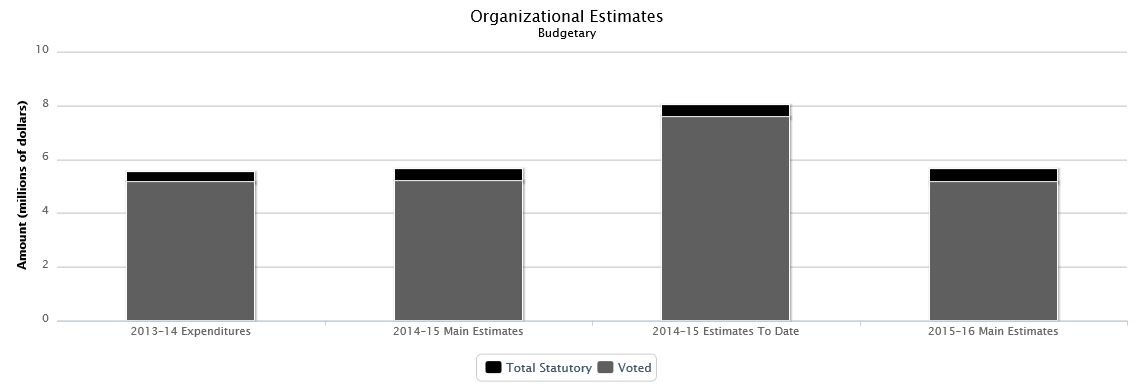
| 2013–14 Expenditures | 2014–15 Main Estimates | 2014–15 Estimates To Date | 2015–16 Main Estimates | ||
|---|---|---|---|---|---|
| Budgetary | |||||
| Voted | |||||
| 1 | Program expenditures | 5,159,799 | 5,171,097 | 7,552,583 | 5,158,208 |
| Total voted | 5,159,799 | 5,171,097 | 7,552,583 | 5,158,208 | |
| Total Statutory | 360,406 | 447,423 | 447,423 | 456,606 | |
| Total budgetary | 5,520,205 | 5,618,520 | 8,000,006 | 5,614,814 | |
Highlights
The MPCC is estimating budgetary expenditures of $5.6 million in 2015–16. Of this amount, $5.2 million requires approval by Parliament. The remaining $456.6 thousand represents statutory forecasts that do not require additional approval and are provided for information purposes.
The MPCC's Main Estimates include a reprofile of $941,024 from 2014–15 into the 2015–16 fiscal year to proceed with renovations. The renovations, planned to be completed in 2015–16, consist of fit-up of offices and upgrade of boardroom space to include a permanent hearing room.
Expenditures by Strategic Outcome and Program
| 2013–14 Expenditures | 2014–15 Main Estimates | 2015–16 Main Estimates | |
|---|---|---|---|
| The Military Police Complaints Commission (MPCC) ensures that the Canadian Forces Military Police has the highest standard of conduct according to law and police best practices, and is free from interference in its investigations. | |||
| Complaints Resolution | 3,304,538 | 2,808,098 | 2,744,736 |
| The following program supports all strategic outcomes within this organization. | |||
| Internal Services | 2,215,667 | 2,810,422 | 2,870,078 |
| Total | 5,520,205 | 5,618,520 | 5,614,814 |
National Arts Centre Corporation
Raison d'être
The Minister of Canadian Heritage and Official Languages is responsible for this organization.
The National Arts Centre Corporation (NAC) was established in 1966 pursuant to the National Arts Centre Act with the mandate to operate and maintain the National Arts Centre, develop the performing arts in the national capital region, and assist the Canada Council for the Arts in the development of the performing arts elsewhere in Canada. The Corporation arranges and sponsors performing arts activities; encourages and assists the development of performing arts companies; arranges or sponsors web, radio and television broadcasts; provides accommodations for national and local organizations who develop the performing arts in Canada; arranges for performances elsewhere in Canada by resident or non-resident performing arts companies; and arranges for performances outside Canada by resident performing arts companies.
Organizational Estimates
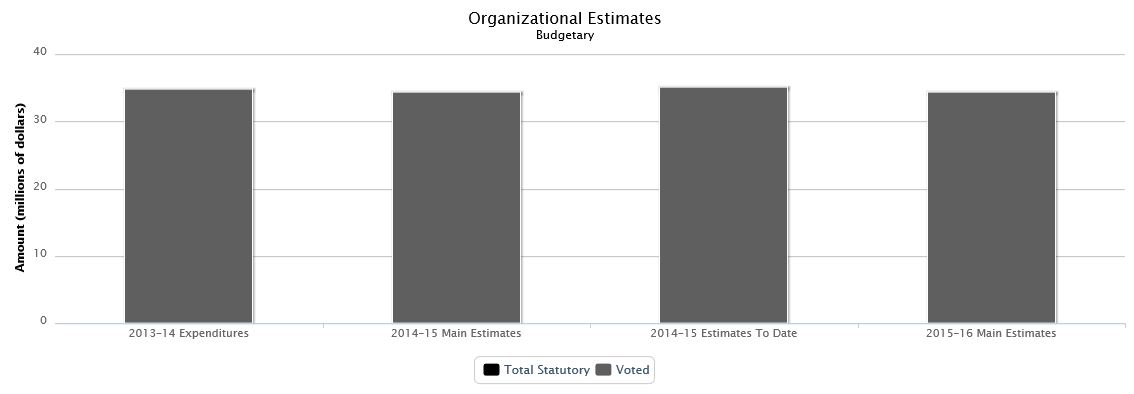
| 2013–14 Expenditures | 2014–15 Main Estimates | 2014–15 Estimates To Date | 2015–16 Main Estimates | ||
|---|---|---|---|---|---|
| Budgetary | |||||
| Voted | |||||
| 1 | Payments to the National Arts Centre Corporation for operating expenditures | 34,647,720 | 34,219,186 | 34,969,188 | 34,222,719 |
| Total voted | 34,647,720 | 34,219,186 | 34,969,188 | 34,222,719 | |
| Total budgetary | 34,647,720 | 34,219,186 | 34,969,188 | 34,222,719 | |
Highlights
The NAC is estimating budgetary expenditures of $34.2 million in 2015–16 which requires approval by Parliament.
The NAC raised its curtains for the first time in 1969. Created by the Parliament of Canada as a Centennial project during the 1960s, the NAC has become Canada's foremost showcase for the performing arts.
Today the NAC works with thousands of artists from across Canada and around the world and collaborates with dozens of arts organizations across the country. The NAC is strongly committed to being a leader and innovator in each of the performing arts fields in which it works: classical music, English theatre, French theatre, dance, and variety and community programming.
It is also at the forefront of youth and education activities, supporting programs for young and emerging artists, presenting programs for young audiences and producing resources and study materials for teachers and students. The NAC is the only multidisciplinary, bilingual performing arts centre in North America and one of the largest in the world.
Expenditures by Strategic Outcome and Program
| 2013–14 Expenditures | 2014–15 Main Estimates | 2015–16 Main Estimates | |
|---|---|---|---|
| Strong and dynamic performing arts in the National Capital Region and across Canada. | |||
| Programming | 0 | 16,734,647 | 16,734,647 |
| Accommodation | 0 | 5,981,609 | 5,981,609 |
| The following program supports all strategic outcomes within this organization. | |||
| Internal Services | 0 | 11,502,930 | 11,506,463 |
| Funds not allocated to the 2015–16 Program Alignment Architecture | 34,647,720 | 0 | 0 |
| Total | 34,647,720 | 34,219,186 | 34,222,719 |
National Battlefields Commission
Raison d'être
The National Battlefields Commission (NBC), as manager of Battlefields Park, enables Canadians to enjoy Canada's first national historic park and one of the most prestigious urban parks in the world.
The NBC is responsible for the administration, management, conservation and development of National Battlefields Park (located in the city of Quebec) and manages the funding allocated for this purpose.
The NBC takes its mandate from the Act respecting the National Battlefields at Quebec, 7–8 Edward VII, c. 57, passed on , and its amendments.
The Minister of Canadian Heritage and Official Languages is responsible for this organization.
Additional information can be found in the NBC's Report on Plans and Priorities.
Organizational Estimates
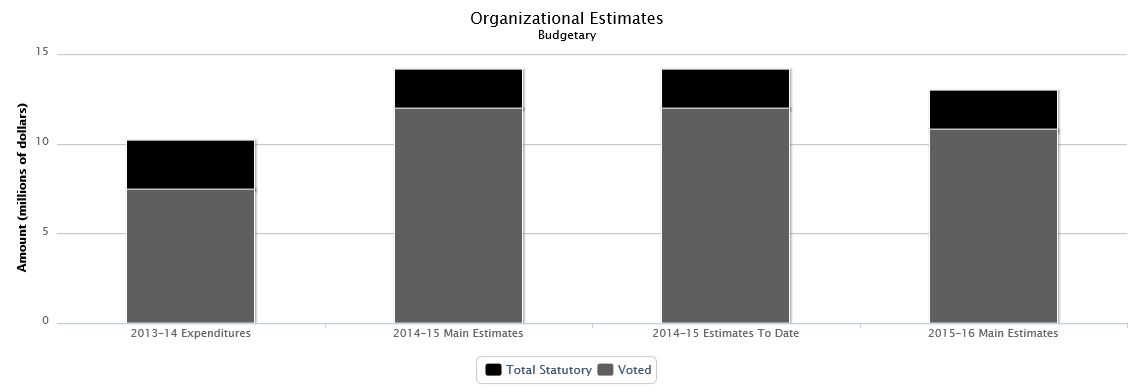
| 2013–14 Expenditures | 2014–15 Main Estimates | 2014–15 Estimates To Date | 2015–16 Main Estimates | ||
|---|---|---|---|---|---|
| Budgetary | |||||
| Voted | |||||
| 1 | Program expenditures | 7,435,086 | 11,940,643 | 11,940,643 | 10,759,494 |
| Total voted | 7,435,086 | 11,940,643 | 11,940,643 | 10,759,494 | |
| Total Statutory | 2,719,758 | 2,210,466 | 2,210,466 | 2,217,342 | |
| Total budgetary | 10,154,844 | 14,151,109 | 14,151,109 | 12,976,836 | |
Highlights
In 2015–16, the NBC will continue its conservation and development work for Battlefields Park. It will also offer visitors a wide array of exhibitions and historical interpretive activities. A vast choice of sport activities will also be offered on the site, including skating, cross-country skiing and snowshoeing in winter and inline skating, running and walking in summer.
This year, the NBC will undertake the development of the multi-purpose interpretive trail parallel to Gilmour Hill, which opened year round on . This trail, which provides a safe path for pedestrians and cyclists, will be created with respect for the environment.
The Main Estimates for 2015–16 will be $12,976,836 which is a decrease of $1,174,273 compared to the 2014–15 Main Estimates. This difference is due mainly to a net decrease of $1,172,267 that comes from the completion of the road component of the Gilmour Hill project.
Expenditures by Strategic Outcome and Program
| 2013–14 Expenditures | 2014–15 Main Estimates | 2015–16 Main Estimates | |
|---|---|---|---|
| The Battlefields Park of Quebec is a prestigious, natural, accessible, safe and educational historic and urban site. | |||
| Conservation and Development | 2,370,384 | 2,372,430 | 2,422,050 |
| Public Education and Services | 1,054,609 | 986,150 | 1,015,529 |
| The following program supports all strategic outcomes within this organization. | |||
| Internal Services | 6,729,851 | 10,792,529 | 9,539,257 |
| Total | 10,154,844 | 14,151,109 | 12,976,836 |
National Capital Commission
Raison d'être
The Minister of Foreign Affairs is responsible for this organization.
The National Capital Commission was created by Parliament in 1959 and pursues the following mandate:
- To prepare plans for and assist in the development, conservation and improvement of the National Capital Region to ensure that the nature and character of the seat of government reflect its national significance; and
- To approve building design and the use of federal lands in the Region.
Additional information can be found in the National Capital Commissionʼs Corporate Plan.
Organizational Estimates
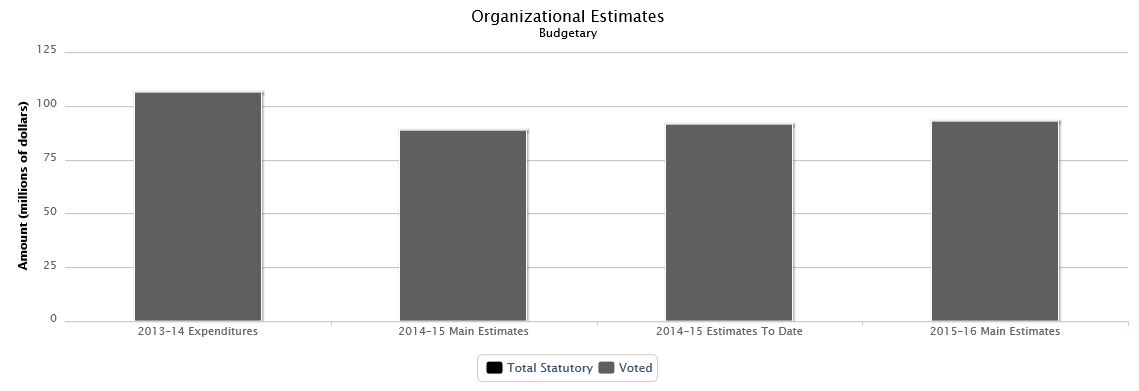
| 2013–14 Expenditures | 2014–15 Main Estimates | 2014–15 Estimates To Date | 2015–16 Main Estimates | ||
|---|---|---|---|---|---|
| Budgetary | |||||
| Voted | |||||
| 1 | Payments to the National Capital Commission for operating expenditures | 78,189,680 | 64,736,659 | 67,777,659 | 69,056,330 |
| 5 | Payments to the National Capital Commission for capital expenditures | 27,971,494 | 23,630,000 | 23,665,000 | 23,665,000 |
| Total voted | 106,161,174 | 88,366,659 | 91,442,659 | 92,721,330 | |
| Total budgetary | 106,161,174 | 88,366,659 | 91,442,659 | 92,721,330 | |
Highlights
A net increase of $4.4 million in planned spending is mainly due to the following:
- A net increase of $2.4 million in operating expenditures funded from a transfer from the Department of Foreign Affairs, Trade and Development Canada to support building the National Holocaust Monument;
- A net increase of $2.0 million in capital expenditures as a result of approved reprofiled funds from the Federal Contaminated Sites Action Plan for the remediation and risk management of sections of the LeBreton Flats;
- A net increase of $1.3 million in operating expenditures funded from the Federal Contaminated Sites Action Plan;
- A net increase of $0.9 million in operating expenditures funded from a transfer from the Department of Citizenship and Immigration Canada, to support the implementation and construction of the Victims of Communism Monument; and,
- A net decrease of $2.0 million in capital expenditures as a result of the transfer, to Public Works and Government Services Canada, of surplus remediation funds provided from the Federal Contaminated Sites Action Plan.
Expenditures by Strategic Outcome and Program
| 2013–14 Expenditures | 2014–15 Main Estimates | 2015–16 Main Estimates | |
|---|---|---|---|
| Canada's Capital Region is of national significance and is a source of pride for Canadians. | |||
| Capital Stewardship and Protection | 0 | 59,193,000 | 59,371,000 |
| Capital Planning | 0 | 3,050,000 | 2,495,000 |
| The following program supports all strategic outcomes within this organization. | |||
| Internal Services | 0 | 26,123,659 | 30,855,330 |
| Funds not allocated to the 2015–16 Program Alignment Architecture | 106,161,174 | 0 | 0 |
| Total | 106,161,174 | 88,366,659 | 92,721,330 |
National Defence
Raison d'être
On behalf of the people of Canada, the Canadian Armed Forces (CAF) and the Department of National Defence (DND) stand ready to perform three key roles:
- Defend Canada – by delivering excellence at home;
- Defend North America – by being a strong and reliable partner with the United States in the defence of the continent; and
- Contribute to International Peace and Security – by projecting leadership abroad.
The National Defence Act establishes DND and the CAF as separate entities, operating within an integrated National Defence Headquarters, as they pursue their primary responsibility of providing defence for Canada and Canadians.
Organizational Estimates
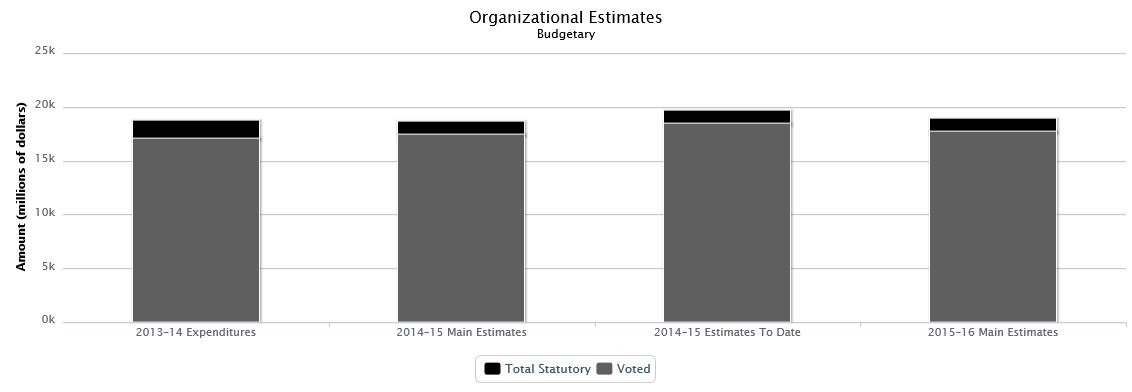
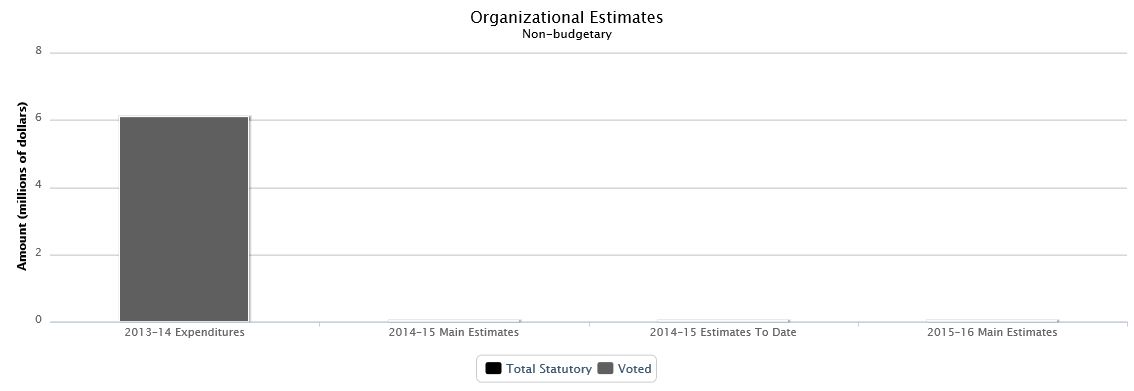
| 2013–14 Expenditures | 2014–15 Main Estimates | 2014–15 Estimates To Date | 2015–16 Main Estimates | ||
|---|---|---|---|---|---|
| Budgetary | |||||
| Voted | |||||
| 1 | Operating expenditures | 13,992,664,687 | 12,513,999,319 | 13,537,640,487 | 13,483,693,376 |
| 5 | Capital expenditures | 2,855,755,116 | 4,730,059,209 | 4,722,631,021 | 4,020,883,722 |
| 10 | Grants and contributions | 164,625,402 | 178,183,820 | 178,764,886 | 168,742,820 |
| Total voted | 17,013,045,205 | 17,422,242,348 | 18,439,036,394 | 17,673,319,918 | |
| Total Statutory | 1,751,329,001 | 1,239,312,039 | 1,240,792,334 | 1,268,733,711 | |
| Total budgetary | 18,764,374,206 | 18,661,554,387 | 19,679,828,728 | 18,942,053,629 | |
| Non-budgetary | |||||
| Voted | |||||
| - | Working capital advance account | 6,094,057 | 0 | 0 | 0 |
| Total voted | 6,094,057 | 0 | 0 | 0 | |
| Total non-budgetary | 6,094,057 | 0 | 0 | 0 | |
Highlights
DND is estimating budgetary expenditures of $18.9 billion in 2015–16. Of this amount, $17.7 billion requires approval by Parliament. The remaining $1.3 billion represents statutory forecasts that do not require approval, but are listed for information.
DND's increase in net authority of $280.5 million, or approximately 1.5%, from the 2014–15 Main Estimates to the 2015–16 Main Estimates, is due to an increase in operating costs of $969.7 million, a decrease in capital costs of $709.2 million, a decrease in grants and contributions of $9.4 million and an increase in statutory payments of $29.4 million.
Major factors contributing to the net increase in authorities include:
- An increase in funding for the sustainment and operational readiness of the CAF in support of the ongoing implementation of the Canada First Defence Strategy; and
- An increase in the annual escalator on defence spending as announced in Budget 2008 to provide long-term and predictable funding.
These increases are offset by the net decrease in adjustments to spending on major capital equipment and infrastructure projects to align financial resources with current project acquisition timelines. This funding includes investments in major capital projects such as the Family of Land Combat Vehicles, and Medium-heavy Lift Helicopter.
In 2015–16, DND will continue to ensure sound financial management of the Defence budget and deliver on the three enduring roles of the CAF: defend Canada; defend North America; and contribute to international peace and security.
Fiscal year 2014–15 was the first year of program delivery using the new Defence Program Alignment Architecture composed of five programs plus Internal Services.
More information can be found in the department's 2015–16 Report on Plans and Priorities.
Expenditures by Strategic Outcome and Program
| 2013–14 Expenditures | 2014–15 Main Estimates | 2015–16 Main Estimates | |
|---|---|---|---|
| Defence Remains Continually Prepared to Deliver National Defence and Defence Services in Alignment with Canadian Interests and Values. | |||
| Defence Capability Element Production | 0 | 13,086,304,226 | 13,336,464,765 |
| Defence Ready Force Element Production | 0 | 3,039,436,884 | 3,102,147,905 |
| Defence Capability Development and Research | 0 | 326,339,123 | 373,537,801 |
| Defence Operations and Services Improve Stability and Security, and Promote Canadian Interests and Values. | |||
| Defence Combat and Support Operations | 0 | 1,363,942,346 | 1,294,500,580 |
| Defence Services and Contributions to Government | 0 | 407,959,810 | 382,286,293 |
| The following program supports all strategic outcomes within this organization. | |||
| Internal Services | 972,661,367 | 437,571,998 | 453,116,285 |
| Funds not allocated to the 2015–16 Program Alignment Architecture | 17,791,712,839 | 0 | 0 |
| Total | 18,764,374,206 | 18,661,554,387 | 18,942,053,629 |
| 2013–14 Expenditures | 2014–15 Main Estimates | 2015–16 Main Estimates | |
|---|---|---|---|
| Funds not allocated to the 2015–16 Program Alignment Architecture | 6,094,057 | 0 | 0 |
| Total | 6,094,057 | 0 | 0 |
Listing of the 2015–16 Transfer Payments
| 2013–14 Expenditures | 2014–15 Main Estimates | 2015–16 Main Estimates | |
|---|---|---|---|
| Grants | |||
| Grants in support of the Compensation for Employers of Reservists Program | 0 | 0 | 2,310,000 |
| Grants in support of the Defence Engagement Program | 250,255 | 500,000 | 500,000 |
| Grant Program to the National Offices of the Cadet Leagues of Canada: Navy League of Canada | 434,000 | 442,000 | 450,000 |
| Grant Program to the National Offices of the Cadet Leagues of Canada: Army Cadet League of Canada | 434,000 | 442,000 | 450,000 |
| Grant Program to the National Offices of the Cadet Leagues of Canada: Air Cadet League of Canada | 434,000 | 442,000 | 450,000 |
| Grant to the Royal Canadian Naval Benevolent Fund | 25,700 | 25,700 | 25,700 |
| Total Statutory | 23,392 | 25,700 | 25,700 |
| Contributions | |||
| North Atlantic Treaty Organization Contribution Program: NATO Military Budget (NATO Programs) | 95,059,039 | 98,043,000 | 78,840,410 |
| North Atlantic Treaty Organization Contribution Program: NATO Security Investment Program (NATO Programs) | 40,540,932 | 48,961,000 | 57,979,000 |
| Contributions in Support of the Military Training and Cooperation Program | 10,064,071 | 11,389,000 | 11,389,000 |
| Contributions in support of the Capital Assistance Program | 1,024,471 | 5,450,000 | 5,450,000 |
| Contribution Program in support of the Search and Rescue New Initiatives Fund | 5,690,051 | 4,000,000 | 4,000,000 |
| Contribution to the Civil Air Search and Rescue Association | 2,773,070 | 3,053,800 | 3,100,000 |
| North Atlantic Treaty Organization Contribution Program: NATO Other Activities | 2,128,693 | 2,630,000 | 2,711,000 |
| Canadian Association of Physician Assistants Contribution Program | 700,000 | 741,000 | 770,779 |
| COSPAS-SARSAT Secretariat Contribution Program | 190,000 | 190,000 | 190,000 |
| Contribution to the Biological and Chemical Defence Review Committee | 123,120 | 124,320 | 126,931 |
| Total Statutory | 3,625,903 | 5,422,272 | 5,422,272 |
National Energy Board
Raison d'être
The National Energy Board is an independent federal quasi-judicial regulatory tribunal established in 1959 to promote safety and security, environmental protection, and economic efficiency in the Canadian public interest within the mandate set by Parliament for the regulation of pipelines, energy development and trade.
The National Energy Board is accountable to Parliament through the Minister of Natural Resources.
Organizational Estimates
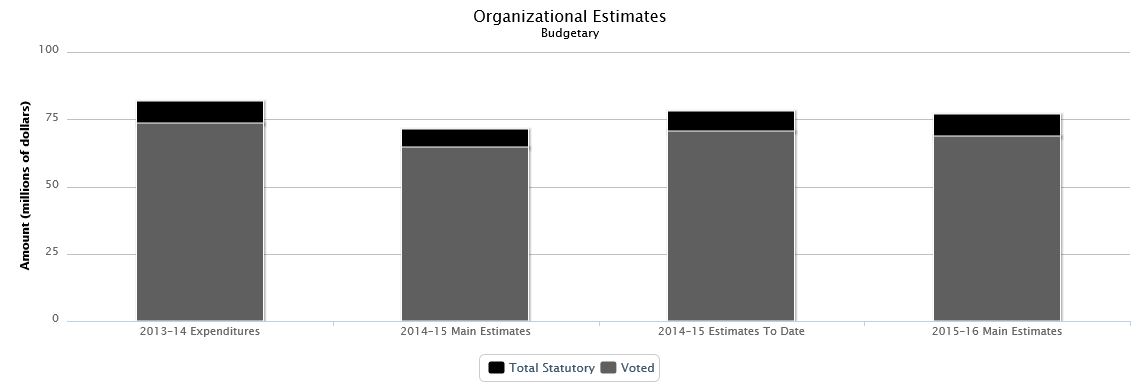
| 2013–14 Expenditures | 2014–15 Main Estimates | 2014–15 Estimates To Date | 2015–16 Main Estimates | ||
|---|---|---|---|---|---|
| Budgetary | |||||
| Voted | |||||
| 1 | Program expenditures | 73,286,166 | 64,555,107 | 70,358,930 | 68,636,080 |
| Total voted | 73,286,166 | 64,555,107 | 70,358,930 | 68,636,080 | |
| Total Statutory | 8,396,515 | 6,760,943 | 7,461,916 | 8,184,430 | |
| Total budgetary | 81,682,681 | 71,316,050 | 77,820,846 | 76,820,510 | |
Highlights
The National Energy Board is estimating budgetary expenditures of $76.8 million in 2015–16. Of this amount, $68.6 million requires approval by Parliament. The remaining $8.2 million represents statutory forecasts that do not require additional approval and are provided for information purposes. The increase in planned spending in comparison to the 2014–15 Main Estimates is primarily due to an increase of $5.6 million for Energy East and Imperial Beaufort application hearings.
Expenditures by Strategic Outcome and Program
| 2013–14 Expenditures | 2014–15 Main Estimates | 2015–16 Main Estimates | |
|---|---|---|---|
| The regulation of pipelines, power lines, energy development and energy trade contributes to the safety of Canadians, the protection of the environment and efficient energy infrastructure and markets, while respecting the rights and interests of those affected by NEB decisions and recommendations. | |||
| Energy Regulation | 47,970,746 | 39,482,860 | 49,588,459 |
| Energy Information Program | 6,156,305 | 5,294,553 | 5,982,273 |
| The following program supports all strategic outcomes within this organization. | |||
| Internal Services | 27,555,630 | 26,538,637 | 21,249,778 |
| Total | 81,682,681 | 71,316,050 | 76,820,510 |
Listing of the 2015–16 Transfer Payments
| 2013–14 Expenditures | 2014–15 Main Estimates | 2015–16 Main Estimates | |
|---|---|---|---|
| Contributions | |||
| Participant Funding Program | 316,297 | 3,614,067 | 3,214,067 |
National Film Board
Raison d'être
The National Film Board of Canada (NFB) was created by an Act of Parliament in 1939 and is a federal agency within the Canadian Heritage portfolio. The NFB's mandate is to produce and distribute original and innovative audiovisual works that add to our understanding of the issues facing Canadians and raise awareness of Canadian values and viewpoints across the country and around the world. Over the decades, it has become the standard for audiovisual innovation in Canada and plays an important role by highlighting the changes and key events in Canadian society.
As a producer and distributor of audiovisual works, the NFB provides a unique perspective on Canada's cultural wealth and diversity. The NFB explores contemporary social issues through point-of-view documentaries, auteur animation and new-media content. Today, our artists and artisans continue to lead the way with advances in form and content in documentary, animation and interactive film.
Organizational Estimates
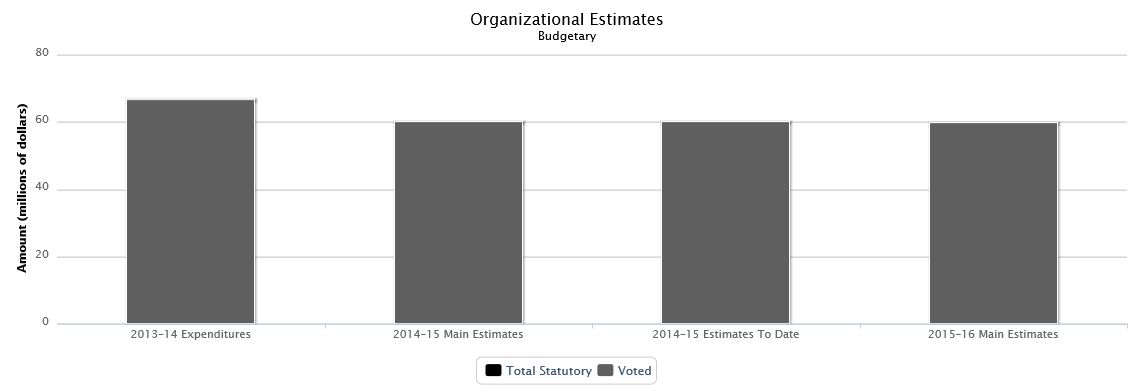
| 2013–14 Expenditures | 2014–15 Main Estimates | 2014–15 Estimates To Date | 2015–16 Main Estimates | ||
|---|---|---|---|---|---|
| Budgetary | |||||
| Voted | |||||
| 1 | Program expenditures | 66,587,103 | 59,912,241 | 59,912,241 | 59,652,377 |
| Total voted | 66,587,103 | 59,912,241 | 59,912,241 | 59,652,377 | |
| Total Statutory | 278,962 | 0 | 0 | 0 | |
| Total budgetary | 66,866,065 | 59,912,241 | 59,912,241 | 59,652,377 | |
Highlights
The NFB is estimating budgetary expenditures of $59.7 million in 2015–16, to be approved by Parliament. In comparison with 2014–15, planned spending has decreased by approximately $260,000, the net result of:
Reductions:
- An initial amount (loan) of $400,000 received in 2014–15 for the relocation of the NFB's Montreal headquarters. No funding is required in 2015–16;
- The transfer of funding for the following initiatives: Pay services centralization ($75,000), the Canadian School of Public Service ($46,000) and the Government of Canada Web Renewal ($10,000).
Additions:
- An adjustment of the rates of the Employees Benefit Plan (EBP) from 24.8% to 25.5%, for a total of $218,000; and,
- A compensation adjustment for 2013–14 related to EX (executive) and equivalent employees in the amount of $54,000.
While continuing the implementation of its 2013-2018 strategic plan, the NFB is preparing to relocate its headquarters to the Quartier des spectacles in Montreal. The move is scheduled for the fall of 2017.
Expenditures by Strategic Outcome and Program
| 2013–14 Expenditures | 2014–15 Main Estimates | 2015–16 Main Estimates | |
|---|---|---|---|
| Canadian stories and perspectives are reflected in audiovisual media and accessible to Canadians and the world. | |||
| Audiovisual production | 40,730,149 | 37,939,002 | 38,068,603 |
| Accessibility and Audience Engagement | 18,949,388 | 13,696,530 | 13,742,245 |
| The following program supports all strategic outcomes within this organization. | |||
| Internal Services | 7,186,528 | 8,276,709 | 7,841,529 |
| Total | 66,866,065 | 59,912,241 | 59,652,377 |
National Gallery of Canada
Raison d'être
The National Gallery of Canadaʼs (the Gallery) mandate is to develop, maintain, and make known, throughout Canada and internationally, a collection of works of art, both historic and contemporary, with special, but not exclusive, reference to Canada, and to further knowledge, understanding, and enjoyment of art in general among all Canadians. The Gallery is one of the worldʼs most respected art institutions, renowned for its exceptional collections, revered for its scholarship, and applauded for its unique ability to engage audiences of all ages and all levels of artistic knowledge. Created in 1880, the is among the oldest of Canadaʼs national cultural institutions.
The Minister of Canadian Heritage and Official Languages is responsible for the Gallery.
Organizational Estimates
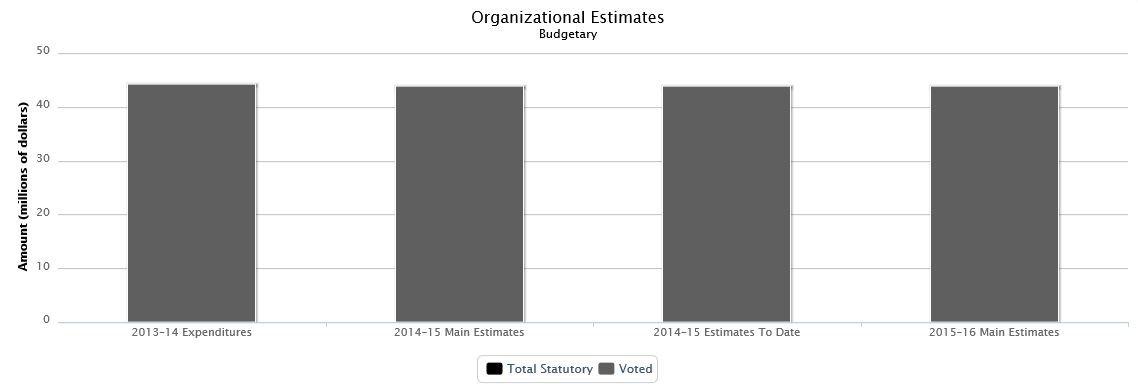
| 2013–14 Expenditures | 2014–15 Main Estimates | 2014–15 Estimates To Date | 2015–16 Main Estimates | ||
|---|---|---|---|---|---|
| Budgetary | |||||
| Voted | |||||
| 1 | Payments to the National Gallery of Canada for operating and capital expenditures | 36,193,242 | 35,770,723 | 35,770,723 | 35,773,542 |
| 5 | Payment to the National Gallery of Canada for the acquisition of objects for the Collection and other costs attributable to this activity | 8,000,000 | 8,000,000 | 8,000,000 | 8,000,000 |
| Total voted | 44,193,242 | 43,770,723 | 43,770,723 | 43,773,542 | |
| Total budgetary | 44,193,242 | 43,770,723 | 43,770,723 | 43,773,542 | |
Highlights
Budgetary expenditures in 2015–16 for the Gallery represent $43.8 million, consisting of $34.8 million in operating expenditures, $1 million in capital expenditures and $8 million in acquisition of objects for the Collection. Total budgetary expenditures remained stable when compared to the previous year.
The Gallery expects to continue to face rising costs pressures in 2015–16, driven by inflationary pressures on non-discretionary items, such as repairs and maintenance, protection services, utilities and insurance. The Gallery intends to fund these various cost pressures through internal budget re-allocations. Furthermore, the Gallery is exploring new partnerships with the private sector, philanthropists, and sponsors. In addition, with investment in programming aimed at attracting and engaging audiences, as well as revitalization investments in revenue-generating business lines, the Gallery expects to see increased self-generated revenue.
To address new and emerging demands associated with remaining relevant in the digital age including website, visitor engagement and experience tools, information management systems and security systems, the Gallery will continue to review its Long Term Capital Plan and will prioritize available resources to ensure that the most pressing projects are completed.
Expenditures by Strategic Outcome and Program
| 2013–14 Expenditures | 2014–15 Main Estimates | 2015–16 Main Estimates | |
|---|---|---|---|
| Interest in, knowledge of and appreciation and respect for visual art through collections of historic and contemporary works of art, programs and research that reflect a special but not exclusive perspective on Canada. | |||
| Accommodation | 0 | 15,581,930 | 15,087,542 |
| Collections | 0 | 13,555,951 | 13,915,000 |
| Outreach | 0 | 10,164,466 | 10,612,000 |
| The following program supports all strategic outcomes within this organization. | |||
| Internal Services | 0 | 4,468,376 | 4,159,000 |
| Funds not allocated to the 2015–16 Program Alignment Architecture | 44,193,242 | 0 | 0 |
| Total | 44,193,242 | 43,770,723 | 43,773,542 |
National Museum of Science and Technology
Raison d'être
The National Museum of Science and Technology (NMST) is a Crown corporation that was established by the Museums Act on .
The mandate of the NMST is to foster scientific and technological literacy throughout Canada by establishing, maintaining and developing a collection of scientific and technical objects, with special but not exclusive reference to Canada, and by demonstrating the products and processes of science and technology and their economic, social and cultural relationships with society.
The NMST operates as the Canada Science and Technology Museums Corporation (CSTMC). It manages three museum sites: the Canada Science and Technology Museum, the Canada Aviation and Space Museum and the Canada Agriculture and Food Museum. Additional information can be found in the NMST's Corporate Plan Summary.
The Minister of Canadian Heritage and Official Languages is responsible for this organization.
Organizational Estimates
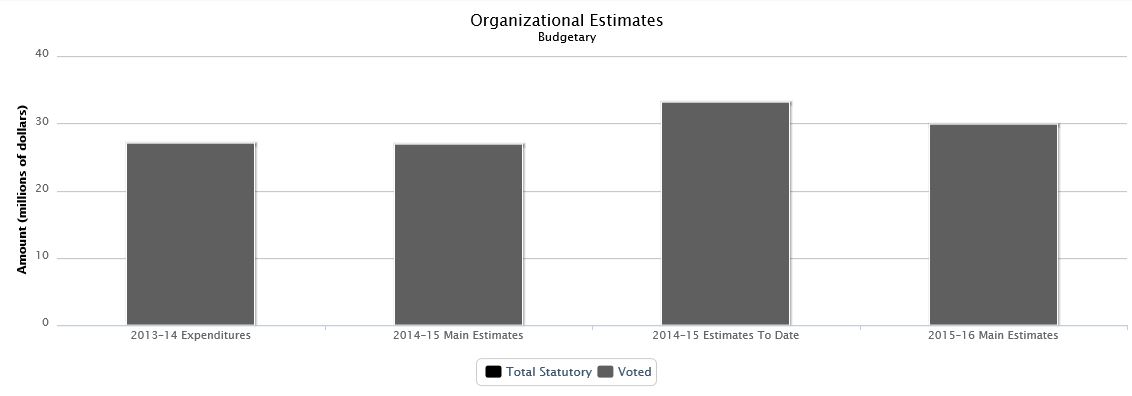
| 2013–14 Expenditures | 2014–15 Main Estimates | 2014–15 Estimates To Date | 2015–16 Main Estimates | ||
|---|---|---|---|---|---|
| Budgetary | |||||
| Voted | |||||
| 1 | Payments to the National Museum of Science and Technology for operating and capital expenditures | 27,003,126 | 26,862,194 | 33,141,274 | 29,754,746 |
| Total voted | 27,003,126 | 26,862,194 | 33,141,274 | 29,754,746 | |
| Total budgetary | 27,003,126 | 26,862,194 | 33,141,274 | 29,754,746 | |
Highlights
The NMST increase of $2.9 million in planned expenditures is a result of funding allocated for the Canada Science and Technology Museum mold remediation and stabilization plan. In 2015–16, the NMST will focus its efforts in the renewal of the Canada Science and Technology Museum building infrastructure, and on creating a national presence and sharing knowledge as detailed in its Corporate Plan.
Activities which the NMST will undertake in order to achieve the strategic directions outlined in the Corporate Plan include:
- In anticipation of the Canada's 150th anniversary in 2017, working to create exhibitions and programming in its Museums to commemorate the contribution of science, technology and innovation to the transformation of our country, using its collection and the Canadian Science and Engineering Hall of Fame;
- Pursuing the Pan Canadian energy initiative. Over the next five years, NMST will continue to bring Canadians into meaningful discussions with the purpose of raising awareness on alternative resources and altering behaviors in the area of energy use;
- Stabilizing the capital infrastructure with the roof replacement, mold remediation and seismic retrofit of the Canada Science and Technology Museum building;
- Increasing its focus on digitization by creating better access to the NMST's 2-D and 3-D collections, encouraging open data and continuing to enhance social media presence;
- Continuing the development of the collection through relevant national research and the rationalization of the collection in order to create a more comprehensive collection and better tell the story of Canada; and,
- Solidifying the NMST financial base and ensuring sustainability through enhanced focus on profitability and increased partnerships.
Expenditures by Strategic Outcome and Program
| 2013–14 Expenditures | 2014–15 Main Estimates | 2015–16 Main Estimates | |
|---|---|---|---|
| Interest in, knowledge of and appreciation and respect for science and technology through collections of scientific and technological objects, programs and research reflecting a Canadian perspective. | |||
| Accommodation | 0 | 9,850,000 | 12,640,000 |
| Sharing Knowledge | 0 | 11,532,194 | 10,890,000 |
| Heritage Preservation | 0 | 4,125,000 | 4,325,000 |
| The following program supports all strategic outcomes within this organization. | |||
| Internal Services | 0 | 1,355,000 | 1,899,746 |
| Funds not allocated to the 2015–16 Program Alignment Architecture | 27,003,126 | 0 | 0 |
| Total | 27,003,126 | 26,862,194 | 29,754,746 |
National Research Council of Canada
Raison d'être
The Minister of Industry is responsible for the National Research Council of Canada (NRC). The NRC bridges the innovation gap between early stage research and development (R&D) and commercialization, focusing on socio-economic benefits for Canada and increasing national performance in business-led R&D and innovation. A federal leader in technology development, NRC supports Canadian industry to enhance their innovation capabilities and capacity and become more productive in the development and deployment of innovative products, processes and services for markets of national priority and importance. With a presence in every province, NRC combines its strong national foundation with international linkages to help Canada grow in productivity and remain globally competitive. NRC works in collaboration with industry, governments and academia to maximize Canada's overall R&D investment.
Organizational Estimates
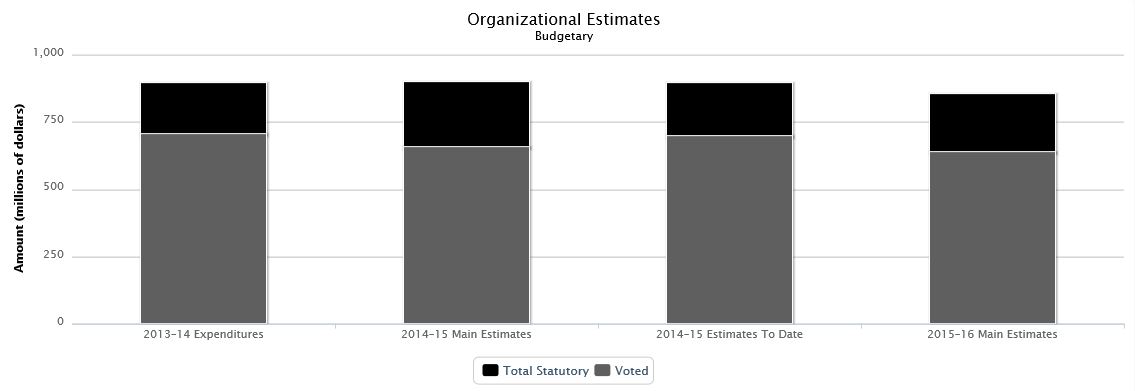
| 2013–14 Expenditures | 2014–15 Main Estimates | 2014–15 Estimates To Date | 2015–16 Main Estimates | ||
|---|---|---|---|---|---|
| Budgetary | |||||
| Voted | |||||
| 1 | Operating expenditures | 389,042,101 | 374,598,983 | 380,765,209 | 350,027,685 |
| 5 | Capital expenditures | 32,308,209 | 30,742,000 | 31,677,001 | 30,703,000 |
| 10 | Grants and contributions | 284,036,803 | 249,891,385 | 283,058,103 | 255,318,385 |
| Total voted | 705,387,113 | 655,232,368 | 695,500,313 | 636,049,070 | |
| Total Statutory | 189,031,093 | 241,200,510 | 198,260,510 | 217,205,712 | |
| Total budgetary | 894,418,206 | 896,432,878 | 893,760,823 | 853,254,782 | |
Highlights
In 2015–16, NRC will continue to focus on responding to industry needs, in alignment with the Government of Canada's Science, Technology, and Innovation Strategy, that will drive Canada's economic growth. To achieve this, NRC will generate demonstrable results for clients through market-driven research, technology development, innovation support services and access to scientific infrastructure while also enabling effective and efficient resource management for a sustainable and secure organization. For further information, please refer to NRC's Report on Plans and Priorities.
The NRC's Main Estimates for 2015–16 includes budgetary expenditures of $853.3 million. Of this amount, $636.1 million requires approval by Parliament. The remaining $217.2 million represents statutory forecasts that do not require additional approval and are provided for information purposes.
Significant changes from 2014–15 Main Estimates to 2015–16 Main Estimates include:
- A decrease of $59.6 million for the realignment to industry focused research from Budget 2013;
- A decrease of $25.7 million related to TRIUMF (Canada's National Laboratory for Particle and Nuclear Physics);
- A decrease of $22.3 million in spending of statutory revenues pursuant to paragraph 5(1)(e) of the National Research Council Act (R.S.C., 1985, c. N-15);
- An increase of $22.1 million related to the ratification of several collective agreements;
- An increase of $15 million for the Youth Employment Strategy from Budget 2014;
- An increase of $10 million for the Business Innovation Access Program from Budget 2013;
- An increase of $8.4 million for the Genomics Research and Development Initiative; and
- An increase of $6.5 million for the Canada Accelerator and Incubator Program from Budget 2014.
Expenditures by Strategic Outcome and Program
| 2013–14 Expenditures | 2014–15 Main Estimates | 2015–16 Main Estimates | |
|---|---|---|---|
| Canadian businesses prosper from innovative technologies. | |||
| Industrial Research Assistance Program (IRAP) | 278,130,653 | 260,499,279 | 293,359,644 |
| Technology Development and Advancement | 0 | 331,740,362 | 278,902,744 |
| R&D infrastructure for an innovative and knowledge-based economy. | |||
| Science Infrastructure and Measurement | 99,678,744 | 100,720,529 | 77,443,974 |
| The following program supports all strategic outcomes within this organization. | |||
| Internal Services | 179,141,403 | 203,472,708 | 203,548,420 |
| Funds not allocated to the 2015–16 Program Alignment Architecture | 337,467,406 | 0 | 0 |
| Total | 894,418,206 | 896,432,878 | 853,254,782 |
Listing of the 2015–16 Transfer Payments
| 2013–14 Expenditures | 2014–15 Main Estimates | 2015–16 Main Estimates | |
|---|---|---|---|
| Grants | |||
| International Affiliations | 559,737 | 560,000 | 560,000 |
| Contributions | |||
| Industrial Research Assistance Program – Contributions to Firms | 170,116,708 | 160,626,500 | 160,626,500 |
| Contributions for the Canada Accelerator and Incubator Program | 0 | 14,245,885 | 20,595,885 |
| Industrial Research Assistance Program – Contributions to Youth Employment Strategy | 6,278,713 | 5,000,000 | 20,000,000 |
| Contribution to TRIUMF (Canada's National Laboratory for Particle and Nuclear Physics) | 44,300,000 | 45,000,000 | 19,277,000 |
| Industrial Research Assistance Program – Contributions to Organizations | 16,091,757 | 13,800,000 | 13,800,000 |
| Contributions to the International Astronomical Observatories Program | 11,340,278 | 10,000,000 | 10,000,000 |
| Contributions for the Business Innovation Access Program | 0 | 0 | 9,800,000 |
| Payment of an assessed contribution for the Bureau International des Poids et Mesures | 571,197 | 659,000 | 659,000 |
Natural Resources
Raison d'être
The Minister of Natural Resources is responsible for this organization.
The vision of Natural Resources Canada (NRCan) is to improve the quality of life of Canadians by creating a sustainable resource advantage – now and for the future. It seeks to achieve this vision by working to improve the competitiveness of the natural resource sectors and to grow their contribution to Canada's economy. NRCan supports the responsible development of Canada's resources in a manner that advances the country's global standing as a leader on the environment, and uses its knowledge and expertise of Canada's landmass to support the safety and security of citizens.
Organizational Estimates
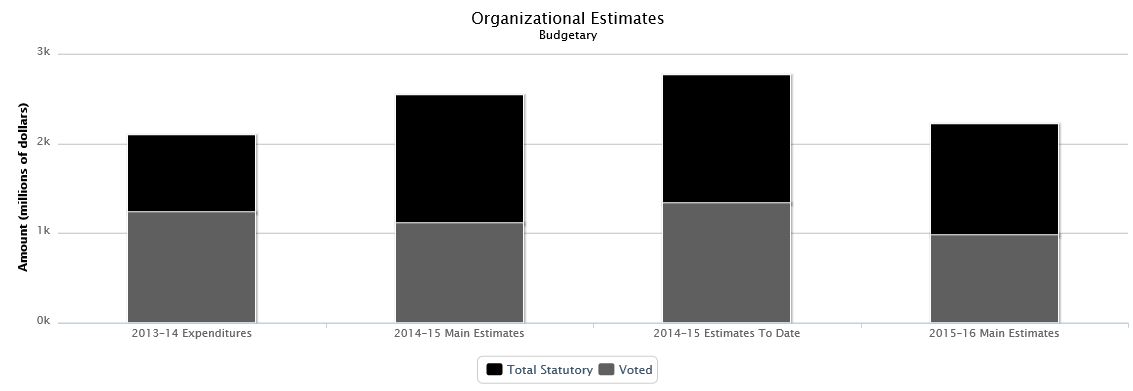
| 2013–14 Expenditures | 2014–15 Main Estimates | 2014–15 Estimates To Date | 2015–16 Main Estimates | ||
|---|---|---|---|---|---|
| Budgetary | |||||
| Voted | |||||
| 1 | Operating expenditures | 806,226,907 | 649,823,365 | 870,926,261 | 654,814,321 |
| 5 | Capital expenditures | 26,069,585 | 12,777,080 | 15,177,082 | 14,700,394 |
| 10 | Grants and contributions | 401,397,529 | 444,039,000 | 450,039,000 | 306,608,750 |
| Total voted | 1,233,694,021 | 1,106,639,445 | 1,336,142,343 | 976,123,465 | |
| Total Statutory | 857,350,572 | 1,428,011,166 | 1,428,475,582 | 1,238,353,246 | |
| Total budgetary | 2,091,044,593 | 2,534,650,611 | 2,764,617,925 | 2,214,476,711 | |
Highlights
NRCan has planned budgetary spending for fiscal year 2015–16 of $2.2 billion. Of this amount, $1.0 billion requires approval by Parliament. The remaining $1.2 billion represents statutory forecasts that do not require additional approval and are provided for information purposes.
A decrease in Main Estimates of $320.2 million or 12.6% from $2,534.7 million in fiscal year 2014–15 to $2,214.5 million in fiscal year 2015–16 is due to the net effect of $6.2 million in increases in operating, $1.9 million in increases in capital, and $328.3 million in decreases in transfer payments. Major factors contributing to the net decrease include:
- An increase of $22.8 million for the Investments in Forest Industry Transformation Program;
- An increase of $19.7 million for defining the outer limits of Canada's continental shelf in the Arctic ocean; and
- An increase of $18.4 million in support of the Port Hope Area Initiative.
The increases are offset by:
- A net decrease of $111.5 million for the statutory Atlantic Offshore Accords;
- A decrease of $110.8 million for the Sustainable Development Technology Canada appropriated and statutory Next Generation Biofuels Fund and the appropriated Technology Fund;
- A decrease of $99.0 million for the Biofuels Producer Incentive program;
- A decrease of $20.9 million for the Stakeholder Engagement and Outreach Campaign to Build Prosperity for Canada;
- A decrease of $9.4 million for the Clean Energy Fund;
- A decrease of $8.5 million to implement the restructuring of Atomic Energy of Canada Limitedʼs nuclear laboratories;
- A decrease of $7.2 million for the ecoENERGY Innovation Initiative;
- A decrease of $6.5 million for the revitalization of NRCanʼs satellite station facilities across Canada;
- A decrease of $5.4 million for the Wind Power Production Incentive program; and
- A decrease of $1.9 million in all other programs.
For further details on trends, please refer to the NRCan's Report on Plans and Priorities.
Expenditures by Strategic Outcome and Program
| 2013–14 Expenditures | 2014–15 Main Estimates | 2015–16 Main Estimates | |
|---|---|---|---|
| Canada's natural resource sectors are globally competitive. | |||
| Statutory Programs – Atlantic Offshore | 795,884,721 | 1,293,425,000 | 1,181,938,140 |
| Innovation for New Products and Processes | 94,093,063 | 67,598,586 | 83,438,001 |
| Investment in Natural Resource Sectors | 65,333,593 | 55,641,175 | 54,230,114 |
| Market Access and Diversification | 59,733,334 | 56,085,530 | 48,685,006 |
| Natural resource sectors and consumers are environmentally responsible. | |||
| Energy-efficient Practices and Lower-carbon Energy Sources | 314,652,883 | 464,018,045 | 253,978,461 |
| Responsible Natural Resource Management | 282,047,031 | 179,373,009 | 193,117,981 |
| Technology Innovation | 155,738,548 | 150,090,774 | 126,472,078 |
| Canadians have information to manage their lands and natural resources, and are protected from related risks. | |||
| Landmass Information | 73,828,231 | 53,620,414 | 71,155,143 |
| Protection for Canadians and Natural Resources | 65,535,095 | 55,878,527 | 58,672,639 |
| The following program supports all strategic outcomes within this organization. | |||
| Internal Services | 184,198,094 | 158,919,551 | 142,789,148 |
| Total | 2,091,044,593 | 2,534,650,611 | 2,214,476,711 |
Listing of the 2015–16 Transfer Payments
| 2013–14 Expenditures | 2014–15 Main Estimates | 2015–16 Main Estimates | |
|---|---|---|---|
| Grants | |||
| Grants in support of the Property Value Protection Program and the Municipal Tax Revenue Loss Protection Program associated with low-level radioactive waste clean-up in the Port Hope area | 1,151,088 | 2,600,000 | 3,000,000 |
| Grants in support of organizations associated with the research, development and promotion of activities that contribute to departmental objectives | 1,596,825 | 1,783,000 | 1,628,000 |
| Grants in support of the Geo-mapping for Energy and Minerals program | 86,400 | 800,000 | 800,000 |
| Total Statutory | 0 | 79,338,000 | 0 |
| Contributions | |||
| Contributions in support of ecoENERGY for Renewable Power | 127,117,878 | 137,939,000 | 137,939,000 |
| Contributions in support of ecoENERGY for Biofuels | 113,656,336 | 145,700,000 | 47,110,000 |
| Contributions in support of the ecoENERGY Innovation Initiative | 34,325,606 | 27,926,000 | 23,308,000 |
| Contributions in support of the Forest Innovation program | 24,353,130 | 22,700,000 | 21,600,000 |
| Contribution in support of Investments in the Forest Industry Transformation Program | 25,625,000 | 0 | 21,000,000 |
| Wind Power Production Incentive Contribution Program | 25,304,000 | 22,704,000 | 17,304,000 |
| Contribution Program for expanding market opportunities | 13,639,058 | 11,900,000 | 11,000,000 |
| Contribution to the Canada Foundation for Sustainable Development Technology for the Sustainable Development Technology Fund | 0 | 0 | 6,000,000 |
| Climate Change Adaptation Initiatives | 4,297,080 | 4,815,000 | 2,500,000 |
| Renewal and Enhancement of Funding for the Forest Research Institute | 2,368,000 | 2,368,000 | 2,368,000 |
| Contributions in support of the ecoENERGY Efficiency program | 948,241 | 2,785,000 | 2,280,000 |
| Contributions in support of the Isotope Technology Acceleration Program to advance the development of alternatives to existing medical isotope production technologies | 8,995,000 | 3,960,000 | 2,130,000 |
| Contribution in support of the clean-up of the Gunnar uranium mining facilities | 0 | 4,817,000 | 1,944,750 |
| Oil Spill Response Science Program | 0 | 0 | 1,250,000 |
| Contributions in support of organizations associated with the research, development and promotion of activities that contribute to departmental objectives | 3,150,271 | 1,354,000 | 1,209,000 |
| Contribution to the Aboriginal Forestry Initiative | 322,386 | 1,000,000 | 1,000,000 |
| Youth Employment Strategy | 542,481 | 558,000 | 558,000 |
| GeoConnections Program | 733,354 | 750,000 | 500,000 |
| Contributions in support of the ecoENERGY Alternative Fuels program | 316,500 | 180,000 | 180,000 |
| Total Statutory | 795,884,721 | 1,293,425,000 | 1,181,938,140 |
Natural Sciences and Engineering Research Council
Raison d'être
The Minister of Industry is responsible for this organization.
The Natural Sciences and Engineering Research Council of Canada (NSERC) is a key actor in making Canada a leading country of discovery and innovation. NSERC aims to maximize the value of public investments in research and development (R&D) and to advance the prosperity and quality of life of all Canadians. In today's highly competitive global economy, NSERC plays a key role in supporting Canada's innovation ecosystem. NSERC supports research that benefits all Canadians. By connecting this innovative research to industry through its partnership initiatives, NSERC also makes it easier for the private sector to collaborate with academia and access the wealth of resources Canada's first-rate academic system has to offer. NSERC develops the next generation of talented scientists and engineers through scholarships and research stipends, and increases the visibility of Canadian research.
Organizational Estimates
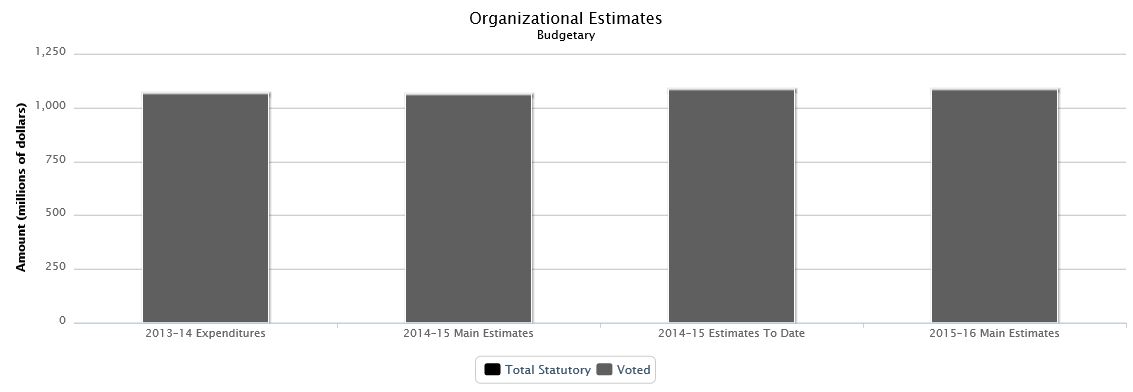
| 2013–14 Expenditures | 2014–15 Main Estimates | 2014–15 Estimates To Date | 2015–16 Main Estimates | ||
|---|---|---|---|---|---|
| Budgetary | |||||
| Voted | |||||
| 1 | Operating expenditures | 42,666,669 | 42,776,701 | 43,621,701 | 43,581,132 |
| 5 | Grants | 1,018,904,138 | 1,015,471,014 | 1,038,500,192 | 1,037,790,619 |
| Total voted | 1,061,570,807 | 1,058,247,715 | 1,082,121,893 | 1,081,371,751 | |
| Total Statutory | 5,108,223 | 4,926,534 | 4,956,534 | 5,198,574 | |
| Total budgetary | 1,066,679,030 | 1,063,174,249 | 1,087,078,427 | 1,086,570,325 | |
Highlights
The 2015–16 Main Estimates include a number of adjustments in reference levels over the 2014–15 Main Estimates. NSERC is estimating budgetary expenditures of $1.1 billion in 2015–16; which requires approval by Parliament. There is also $5.2 million representing statutory forecasts that do not require additional approval and are provided for information purposes.
The variance between the 2015–16 Main Estimates and the 2014–15 Main Estimates demonstrates a net increase of $23.4 million or 2.2% in planned spending. The primary changes include:
- An increase of $15.0 million to augment support for advanced research in the natural sciences and engineering (Budget 2014);
- An increase of $6.9 million to support the Canada Excellence Research Chairs program to attract and retain the worldʼs most accomplished and promising minds (Budget 2011);
- An increase of $3.3 million for the Centres of Excellence for Commercialization and Research program, a tri-agency initiative, to create a more effective and efficient way to identify commercialization opportunities (Budget 2007);
- An increase of $0.5 million due to the end of a transfer to the International Development Research Centre for the International Research Initiative on Adaptation to Climate Change;
- An increase of $0.2 million in support of the Business-Led Networks of Centres of Excellence program;
- An increase of $0.2 million in statutory authority for the spending of revenues pursuant to Subsection 4.2 of the Natural Sciences and Engineering Research Council Act;
- An increase of $0.1 million in support of the Innovation Enhancement Grants program to increase innovation at the community and/or regional level by enabling Canadian colleges to increase their capacity to work with local companies;
- A decrease of $1.5 million for the support of the Canadian Light Source initiative due to a reduction in the amount transferred from the National Research Council;
- A decrease of $1.1 million following the end of transfer agreements with other government departments (Natural Resources and Fisheries and Oceans); and
- A decrease of $0.2 million in operating funds to transfer the administration of the Secretariat on Responsible Conduct of Research to the Canadian Institutes of Health Research.
Other variances of less than $0.1 million include the reduction in the Council's operating budget from government's cost-effectiveness initiatives. These items include the transfer to the Canada School of Public Service, the Web Renewal Initiative and a reduction in operating budget for late fees and interest charges incurred in 2013–14.
More detailed information of the agency's spending plans can be found in the Report on Plans and Priorities.
Expenditures by Strategic Outcome and Program
| 2013–14 Expenditures | 2014–15 Main Estimates | 2015–16 Main Estimates | |
|---|---|---|---|
| Canada is a world leader in advancing, connecting and applying new knowledge in the natural sciences and engineering. | |||
| Discovery: Advancement of Knowledge | 404,299,452 | 394,168,765 | 403,233,837 |
| Innovation: Research Partnerships | 370,061,947 | 369,062,488 | 371,949,620 |
| People: Research Talent | 268,221,394 | 276,073,435 | 287,240,355 |
| The following program supports all strategic outcomes within this organization. | |||
| Internal Services | 24,096,237 | 23,869,561 | 24,146,513 |
| Total | 1,066,679,030 | 1,063,174,249 | 1,086,570,325 |
Listing of the 2015–16 Transfer Payments
| 2013–14 Expenditures | 2014–15 Main Estimates | 2015–16 Main Estimates | |
|---|---|---|---|
| Grants | |||
| Grants and Scholarships | 846,733,578 | 848,486,008 | 860,364,486 |
| Canada Graduate Scholarships | 42,563,232 | 42,580,000 | 42,580,000 |
| College and Community Innovation Program | 40,570,662 | 40,655,250 | 40,705,157 |
| Networks of Centres of Excellence | 33,430,050 | 33,430,050 | 33,430,050 |
| Canada Excellence Research Chairs | 18,200,000 | 18,200,000 | 25,050,000 |
| Vanier Canada Graduate Scholarships | 8,275,000 | 8,350,000 | 8,350,000 |
| Business-Led Networks of Centres of Excellence | 5,573,412 | 6,709,482 | 6,917,000 |
| Industrial R&D Internship Program | 6,880,000 | 6,880,125 | 6,880,125 |
| Centres of Excellence for Commercialization and Research | 10,821,538 | 3,165,493 | 6,501,237 |
| Industrial Research Chairs for colleges | 3,500,500 | 4,278,756 | 4,276,714 |
| College-University Idea to Innovation | 2,356,166 | 2,735,850 | 2,735,850 |
Northern Pipeline Agency
Raison d'être
The Northern Pipeline Agency (NPA) was established by the Northern Pipeline Act in 1978 and, in the context of the 1977 Agreement Between Canada and the United States of America on Principles Applicable to a Northern Natural Gas Pipeline. NPA has a mandate to carry out federal responsibilities in respect of the planning and construction of the Canadian portion of the Alaska Natural Gas Pipeline. The NPA plays a key role in supporting efficient and expeditious regulatory approval while ensuring environmental protection and social and economic benefits for Canada.
The Minister of Natural Resources is responsible for this organization.
Organizational Estimates
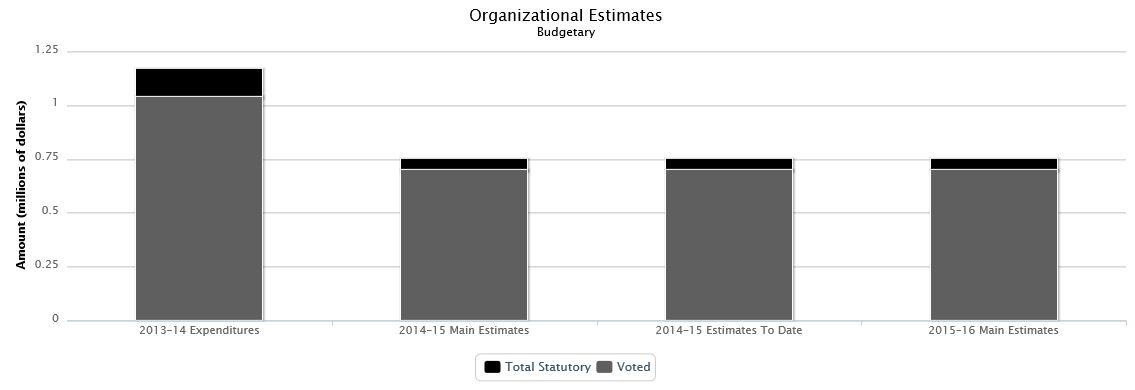
| 2013–14 Expenditures | 2014–15 Main Estimates | 2014–15 Estimates To Date | 2015–16 Main Estimates | ||
|---|---|---|---|---|---|
| Budgetary | |||||
| Voted | |||||
| 1 | Program expenditures | 1,038,693 | 701,325 | 701,325 | 701,215 |
| Total voted | 1,038,693 | 701,325 | 701,325 | 701,215 | |
| Total Statutory | 133,931 | 48,675 | 48,675 | 49,560 | |
| Total budgetary | 1,172,624 | 750,000 | 750,000 | 750,775 | |
Highlights
The NPA is estimating budgetary expenditures of $751 thousand in 2015–16. Of this amount, $701 thousand requires approval by Parliament. The remaining $50 thousand represents statutory forecasts that do not require additional approval and are provided for information purposes.
Planned spending of $751 thousand in 2015–16 is constant with the planned spending of $750 thousand in 2014–15.
The key factor contributing to the decrease in spending from 2013–14 is due to the announcement by TransCanada PipeLines Ltd. (TransCanada) that they would be working with other partners to study a liquefied natural gas export project within Alaska as an alternative to a natural gas pipeline through Canada. However, TransCanada will continue to maintain its Alaska Highway Gas Pipeline (AHGP) assets in Canada. In 2015–16, and to align with the reduced AHGP project activities in the foreseeable future, the NPA will continue its scaled down operations and will fulfil Canada's obligations as set out in the Northern Pipeline Act (the Act) and the Agreement under the Act.
For additional information, please refer to the NPA's Report on Plans and Priorities.
Expenditures by Strategic Outcome and Program
| 2013–14 Expenditures | 2014–15 Main Estimates | 2015–16 Main Estimates | |
|---|---|---|---|
| The planning and construction of the Canadian portion of the Alaska Highway Gas Pipeline project is efficient and expeditious while ensuring environmental protection and social and economic benefits for Canadians. | |||
| Oversee the planning and construction of the Canadian portion of the Alaska Highway Gas Pipeline | 1,172,624 | 750,000 | 750,775 |
| Total | 1,172,624 | 750,000 | 750,775 |
Listing of the 2015–16 Transfer Payments
| 2013–14 Expenditures | 2014–15 Main Estimates | 2015–16 Main Estimates | |
|---|---|---|---|
| Contributions | |||
| Funding to conduct consultation activities, primarily with Aboriginal groups who could be affected by the Alaska Highway Gas Pipeline project | 0 | 10,000 | 10,000 |
Office of Infrastructure of Canada
Raison d'être
Strong, modern, world-class public infrastructure is a key factor in achieving the Government of Canada's priorities of a stronger economy, a cleaner environment and more prosperous, safer communities. Infrastructure Canada leads the Government of Canada's efforts in addressing Canada's public infrastructure challenges.
The Minister of Infrastructure, Communities and Intergovernmental Affairs and Minister of the Economic Development Agency of Canada for the Regions of Quebec is responsible for this organization.
Organizational Estimates
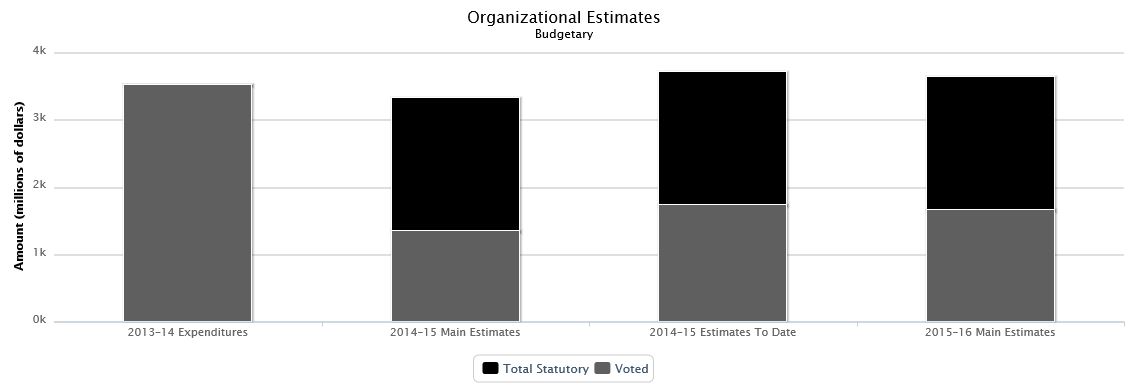
| 2013–14 Expenditures | 2014–15 Main Estimates | 2014–15 Estimates To Date | 2015–16 Main Estimates | ||
|---|---|---|---|---|---|
| Budgetary | |||||
| Voted | |||||
| 1 | Operating expenditures | 46,209,274 | 2,050,758 | 72,874,002 | 59,796,691 |
| 5 | Capital expenditures | 0 | 0 | 94,036,524 | 24,652,150 |
| 10 | Contributions | 3,463,223,390 | 1,345,967,616 | 1,566,102,718 | 1,569,894,628 |
| Total voted | 3,509,432,664 | 1,348,018,374 | 1,733,013,244 | 1,654,343,469 | |
| Total Statutory | 4,392,827 | 1,973,579,397 | 1,979,812,477 | 1,978,919,279 | |
| Total budgetary | 3,513,825,491 | 3,321,597,771 | 3,712,825,721 | 3,633,262,748 | |
Highlights
Infrastructure Canada is estimating budgetary expenditures of $3.6 billion in 2015–16. Of this amount, approximately $1,654.3 million requires approval by Parliament. The remaining $1,978.9 million represents statutory forecasts that do not require additional approval and are provided for information purposes.
Infrastructure Canada will continue to make significant investments in communities across Canada, as well as continue to work with funding partners to implement new and existing programs, ensure the timely completion of projects and provide stewardship and oversight as we process and pay thousands of claims for projects.
A net increase of $311.7 million in spending is mainly due to the following:
- Increase of $203.2 million under the Building Canada Fund Major Infrastructure Fund related to the recipients projected cash flow requirements for approved projects;
- Increase of $186.7 million related to the approval of the New Building Canada Fund;
- Increase of $41.7 million related to the approval of the New Bridge for the St. Lawrence Corridor project;
- Increase of $35.4 million under the Provincial-Territorial Infrastructure Base Funding Program to reflect the current cash flow projections of provinces and territories subject to each province and territory meeting certain requirements set out in the agreements for payments;
- Decrease of $108.6 million under the Canada Strategic Infrastructure Fund based on recipients projected cash flow requirements for approved projects;
- Decrease of $38.6 million under the Green Infrastructure Fund based on recipients projected cash flow requirements for approved projects.
Expenditures by Strategic Outcome and Program
| 2013–14 Expenditures | 2014–15 Main Estimates | 2015–16 Main Estimates | |
|---|---|---|---|
| Public Infrastructure for a More Prosperous Canada. | |||
| Permanent and Flexible Infrastructure Funding | 2,107,905,313 | 1,973,411,002 | 1,976,213,928 |
| Large-Scale Infrastructure Investments | 0 | 958,832,530 | 1,174,990,518 |
| Infrastructure Investments in Small Communities and Rural Areas | 0 | 139,431,232 | 171,319,905 |
| Investments in National Infrastructure Priorities | 0 | 193,145,913 | 148,607,942 |
| Funding for Provincial-Territorial Priorities | 191,464,385 | 55,351,611 | 91,061,247 |
| New Bridge for the St. Lawrence Corridor Project | 0 | 0 | 42,661,977 |
| The following program supports all strategic outcomes within this organization. | |||
| Internal Services | 35,404,150 | 1,425,483 | 28,407,231 |
| Funds not allocated to the 2015–16 Program Alignment Architecture | 1,179,051,643 | 0 | 0 |
| Total | 3,513,825,491 | 3,321,597,771 | 3,633,262,748 |
Listing of the 2015–16 Transfer Payments
| 2013–14 Expenditures | 2014–15 Main Estimates | 2015–16 Main Estimates | |
|---|---|---|---|
| Contributions | |||
| Contributions under the Building Canada Fund Major Infrastructure Component | 692,803,945 | 706,677,090 | 909,927,997 |
| Contributions under the Building Canada Fund Communities Component | 120,382,787 | 139,298,397 | 154,956,816 |
| Contributions under the Canada Strategic Infrastructure Fund | 196,634,325 | 251,695,831 | 143,090,980 |
| New Building Canada Fund – Provincial-Territorial Infrastructure Component – National and Regional Projects | 0 | 0 | 114,480,000 |
| Inuvik to Tuktoyaktuk Highway Program | 0 | 52,500,000 | 51,375,000 |
| Contributions under the Green Infrastructure Fund | 84,567,663 | 89,429,335 | 50,784,093 |
| Contributions under the Border Infrastructure Fund | 28,196,496 | 51,032,163 | 21,874,942 |
| New Building Canada Fund – National Infrastructure Component | 0 | 0 | 15,000,000 |
| New Building Canada Fund – Provincial-Territorial Infrastructure Component – Small Communities Fund | 0 | 0 | 12,720,000 |
| National Recreational Trails program | 0 | 0 | 5,000,000 |
| Other Transfer Payments | |||
| Provincial-Territorial Infrastructure Base Funding Program | 191,431,000 | 55,334,800 | 90,684,800 |
| Total Statutory | 0 | 1,973,269,432 | 1,973,269,432 |
Office of the Commissioner of Lobbying
Raison d'être
As an Agent of Parliament, the Commissioner of Lobbying of Canada reports directly to the House of Commons and the Senate. The Office of the Commissioner of Lobbying (OCL) supports the Commissioner in administering and ensuring compliance with the Lobbying Act (the Act) and the Lobbyists' Code of Conduct (the Code). The Act and the Code contribute to the confidence of Canadians in the integrity of government decision-making, by ensuring lobbying activities are conducted in a transparent manner and according to the highest ethical standards.
For administrative purposes, the President of the Treasury Board is responsible for tabling in Parliament the OCL's Report on Plans and Priorities and Departmental Performance Report.
Organizational Estimates
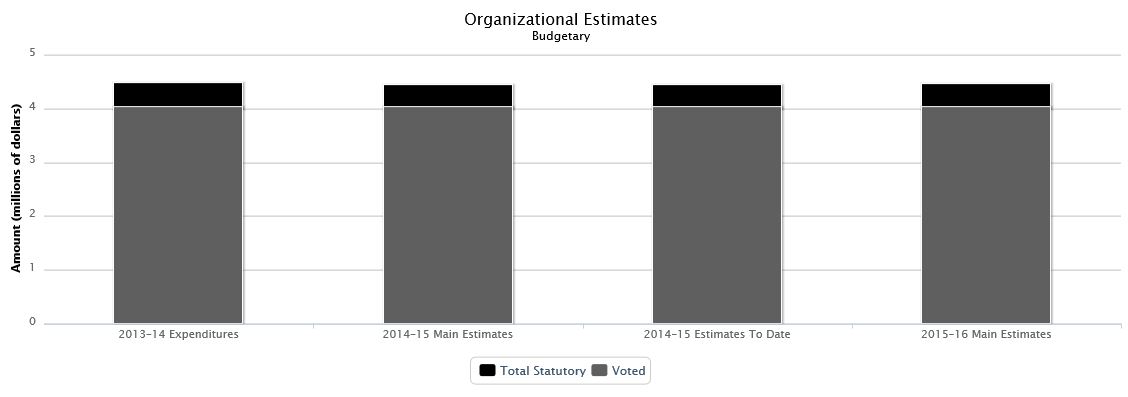
| 2013–14 Expenditures | 2014–15 Main Estimates | 2014–15 Estimates To Date | 2015–16 Main Estimates | ||
|---|---|---|---|---|---|
| Budgetary | |||||
| Voted | |||||
| 1 | Program expenditures | 4,026,928 | 4,015,579 | 4,015,579 | 4,026,414 |
| Total voted | 4,026,928 | 4,015,579 | 4,015,579 | 4,026,414 | |
| Total Statutory | 436,595 | 416,721 | 416,721 | 426,126 | |
| Total budgetary | 4,463,523 | 4,432,300 | 4,432,300 | 4,452,540 | |
Highlights
In 2015–16, the OCL will finalize, implement and communicate the revised Lobbyists' Code of Conduct. The OCL will develop the necessary guidance and tools for lobbyists to ensure that those who are subject to the Code can comply.
The OCL will continue to refine existing compliance verification processes. This will enhance transparency and accountability by ensuring that those who are lobbying federal public office holders are in compliance with the Lobbying Act.
The OCL will complete the replication of the Lobbyists Registration System (LRS) on its segregated network. The LRS development environment will be used to update, mine and report on Registry data internally, and to develop cost effective options for the long-term maintenance and development of the LRS.
To further improve the overall effectiveness and efficiency of OCL, an IM/IT strategy will be finalized and implemented.
Expenditures by Strategic Outcome and Program
| 2013–14 Expenditures | 2014–15 Main Estimates | 2015–16 Main Estimates | |
|---|---|---|---|
| Transparency and accountability in the lobbying of public office holders contribute to confidence in the integrity of government decision-making. | |||
| Compliance and Enforcement | 1,080,788 | 1,137,784 | 1,136,392 |
| Registry of Lobbyists | 887,751 | 824,989 | 1,029,060 |
| Outreach and Education | 732,456 | 780,733 | 694,327 |
| The following program supports all strategic outcomes within this organization. | |||
| Internal Services | 1,762,528 | 1,688,794 | 1,592,761 |
| Total | 4,463,523 | 4,432,300 | 4,452,540 |
Office of the Commissioner of Official Languages
Raison d'être
The mandate of the Commissioner of Official Languages is to oversee the full implementation of the Official Languages Act, protect the language rights of Canadians, and promote linguistic duality and bilingualism in Canada.
Section 56 of the Official Languages Act states: "It is the duty of the Commissioner to take all actions and measures within the authority of the Commissioner with a view to ensuring recognition of the status of each of the official languages and compliance with the spirit and intent of this Act in the administration of the affairs of federal institutions, including any of their activities relating to the advancement of English and French in Canadian society."
Under the Act, therefore, the Commissioner is required to take every measure within his power to ensure that the three main objectives of the Official Languages Act are met:
- the equality of the status and use of English and French in Parliament, the Government of Canada, the federal administration and the institutions subject to the Act;
- the development of official language communities in Canada; and
- the advancement of the equality of English and French in Canadian society.
The Commissioner of Official Languages is appointed by commission under the Great Seal, after approval by resolution of the House of Commons and the Senate. The Commissioner of Official Languages, reports directly to Parliament.
The President of the Queen's Privy Council for Canada is responsible for tabling in Parliament the Office of the Commissioner of Official Languages's administrative reports, including the Report on Plans and Priorities and the Departmental Performance Report.
Organizational Estimates
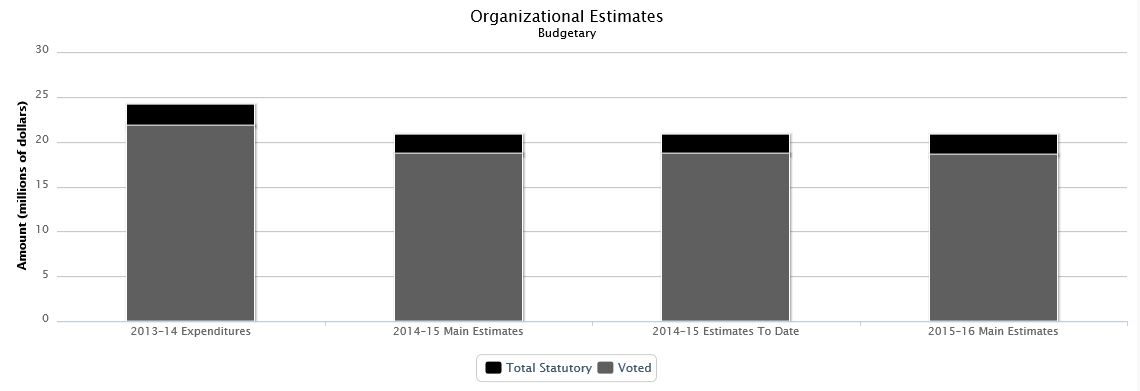
| 2013–14 Expenditures | 2014–15 Main Estimates | 2014–15 Estimates To Date | 2015–16 Main Estimates | ||
|---|---|---|---|---|---|
| Budgetary | |||||
| Voted | |||||
| 1 | Program expenditures | 21,841,701 | 18,623,744 | 18,623,744 | 18,556,100 |
| Total voted | 21,841,701 | 18,623,744 | 18,623,744 | 18,556,100 | |
| Total Statutory | 2,346,062 | 2,153,208 | 2,153,208 | 2,277,425 | |
| Total budgetary | 24,187,763 | 20,776,952 | 20,776,952 | 20,833,525 | |
Highlights
The Office of the Commissioner of Official Languages is estimating budgetary expenditures of $20.8 million for 2015–16. Of this amount, $18.6 million requires approval by Parliament. The remaining $2.3 million represents statutory authorities that do not require additional approval and are provided for information purposes.
The funding will be used to address the following priorities:
- Increase recognition of linguistic duality;
- Identify solutions to recurring compliance issues;
- Intervene in key areas to support the vitality of official language minority communities; and,
- Manage change while enabling a productive workforce and fostering a healthy work environment.
Expenditures by Strategic Outcome and Program
| 2013–14 Expenditures | 2014–15 Main Estimates | 2015–16 Main Estimates | |
|---|---|---|---|
| Rights guaranteed by the Official Languages Act are protected and linguistic duality is promoted as a fundamental value of Canadian society. | |||
| Protection of Language Rights | 6,527,651 | 6,814,886 | 6,959,977 |
| Promotion of Linguistic Duality | 7,033,889 | 6,548,834 | 6,902,349 |
| The following program activity supports all strategic outcomes within this organization. | |||
| Internal Services | 10,626,223 | 7,413,232 | 6,971,199 |
| Total | 24,187,763 | 20,776,952 | 20,833,525 |
Office of the Communications Security Establishment Commissioner
Raison d'être
The position of Communications Security Establishment Commissioner was created to review the activities of Communications Security Establishment (CSE) to determine whether it performs its duties and functions in accordance with the laws of Canada. This includes having due regard for the privacy of Canadians. The Commissioner's office exists to support the Commissioner in the effective discharge of his mandate. Additional information can be found in the Report on Plans and Priorities of the Office of the Communications Security Establishment Commissioner.
Under the Financial Administration Act, the Minister of National Defence is responsible for the Office of the Communications Security Establishment Commissioner.
Organizational Estimates

| 2013–14 Expenditures | 2014–15 Main Estimates | 2014–15 Estimates To Date | 2015–16 Main Estimates | ||
|---|---|---|---|---|---|
| Budgetary | |||||
| Voted | |||||
| 1 | Program expenditures | 1,775,440 | 1,847,027 | 1,847,027 | 1,850,071 |
| Total voted | 1,775,440 | 1,847,027 | 1,847,027 | 1,850,071 | |
| Total Statutory | 167,680 | 177,261 | 177,261 | 180,996 | |
| Total budgetary | 1,943,120 | 2,024,288 | 2,024,288 | 2,031,067 | |
Highlights
The Office of the Communications Security Establishment Commissioner is estimating expenditures of $2.0 million in 2015–16. Of this amount, $1.9 million require approval by Parliament. The remaining $180,996 represent statutory forecasts that do not require additional approval and are provided for information purposes.
The planned expenditures of the Office of the Communications Security Establishment Commissioner remain approximately the same as the previous year. The Office will continue to conduct rigorous reviews to determine whether activities conducted by CSE under ministerial authorization are those authorized by the Minister of National Defence; to determine whether CSE complies with the law and only directs its activities at foreign entities located outside Canada; to assess the extent that, in all the activities CSE undertakes, it effectively applies satisfactory measures to protect the privacy of Canadians; and to report the results of these reviews to the Minister of National Defence, who is responsible for CSE.
Expenditures by Strategic Outcome and Program
| 2013–14 Expenditures | 2014–15 Main Estimates | 2015–16 Main Estimates | |
|---|---|---|---|
| The Communications Security Establishment performs its duties and functions in accordance with the laws of Canada and with due regard for the privacy of Canadians. | |||
| The Communications Security Establishment Commissionerʼs Review Program | 1,322,494 | 1,489,913 | 1,549,695 |
| The following program supports all strategic outcomes within this organization. | |||
| Internal Services | 620,626 | 534,375 | 481,372 |
| Total | 1,943,120 | 2,024,288 | 2,031,067 |
Office of the Conflict of Interest and Ethics Commissioner
Raison d'être
The Conflict of Interest and Ethics Commissioner administers the Conflict of Interest Act (Act) and the Conflict of Interest Code for Members of the House of Commons (Code). These two regimes seek to ensure that public officials, whether appointed as public office holders or elected as Members, are not in a conflict of interest. The Act and the Code establish conflict of interest rules for public office holders and Members, and hold them to standards that place the public interest above their private interests when the two come into conflict. The Commissioner is also mandated to provide confidential advice to the Prime Minister about conflict of interest and ethics issues.
The Speaker of the House of Commons is the appropriate Minister for this organization.
Organizational Estimates
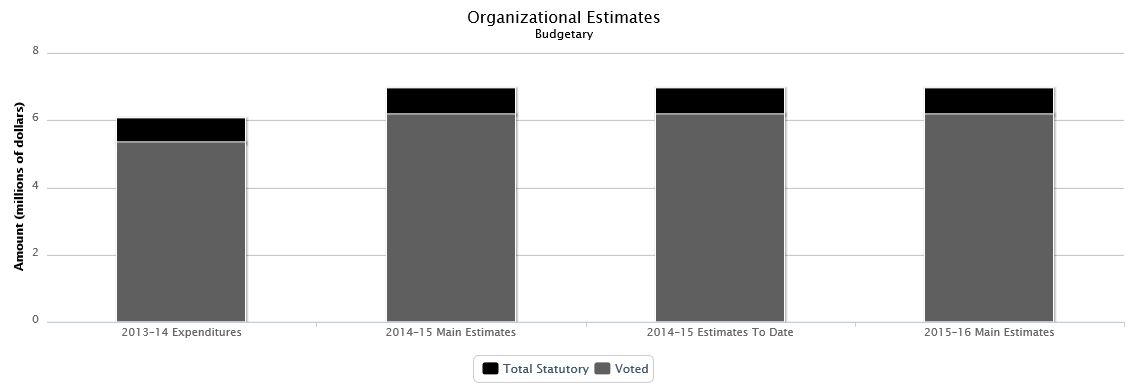
| 2013–14 Expenditures | 2014–15 Main Estimates | 2014–15 Estimates To Date | 2015–16 Main Estimates | ||
|---|---|---|---|---|---|
| Budgetary | |||||
| Voted | |||||
| 1 | Program expenditures | 5,335,910 | 6,178,280 | 6,178,280 | 6,178,280 |
| Total voted | 5,335,910 | 6,178,280 | 6,178,280 | 6,178,280 | |
| Total Statutory | 699,140 | 760,125 | 760,125 | 773,946 | |
| Total budgetary | 6,035,050 | 6,938,405 | 6,938,405 | 6,952,226 | |
Highlights
The operating budget of the Office of the Conflict of Interest and Ethics Commissioner (Office) is used to support the delivery of the legislative mandate of the Commissioner. The main responsibilities of her Office consist of advising public office holders and Members on their obligations under the Act and the Code; receiving and reviewing confidential reports of assets, liabilities, income and activities of reporting public office holders and Members in order to advise on and establish appropriate compliance measures; maintaining confidential files of required disclosures; maintaining public registries of publicly declarable information; administering an administrative monetary penalty regime for failures to comply with certain reporting requirements; and conducting examinations and inquiries into alleged contraventions of the Act and the Code. A considerable portion of the budget is spent on salaries and shared internal services agreements.
More details on the operations of the Office can be found in the Commissioner's annual reports which are available on her website at www.ciec-ccie.gc.ca.
Expenditures by Strategic Outcome and Program
| 2013–14 Expenditures | 2014–15 Main Estimates | 2015–16 Main Estimates | |
|---|---|---|---|
| The public can feel confident that public office holders and MPs are meeting the requirements of the conflict of interest compliance measures. | |||
| Administration of the Conflict of Interest Act and the Conflict of Interest Code for Members of the House of Commons | 3,899,081 | 4,859,860 | 4,842,213 |
| The following program supports all strategic outcomes within this organization. | |||
| Internal Services | 2,135,969 | 2,078,545 | 2,110,013 |
| Total | 6,035,050 | 6,938,405 | 6,952,226 |
Office of the Co-ordinator, Status of Women
Raison d'être
The Office of the Co-ordinator, Status of Women, known as Status of Women Canada (SWC), is a federal government agency that promotes equality between women and men in all aspects of Canadian life. The mandate of SWC is "to coordinate policy with respect to the status of women and administer related programs" (1976).
SWC is responsible for exercising leadership and working in partnership to promote and advance equality by: supporting community-based action and innovation that will lead to equality by helping to create conditions for success for women and girls in Canada; providing expert advice on gender equality and gender-based analysis in the development of effective programs, policies and legislation for all Canadians; promoting commemorative dates relating to women and girls in Canada; and supporting Canada's efforts to meet international obligations.
SWC works to promote and advance equality for women and girls, focusing its efforts in three areas: improving women's and girlsʼ economic security and prosperity; ending violence against women and girls; and supporting the advancement and increased representation of women and girls in leadership and decision-making roles.
While SWC focuses on these three areas, the agency is able to address specific issues such as engaging men and boys in ending violence, increasing womenʼs participation in skilled trades and technical professions or assisting women in rural and remote communities.
The Minister of Labour and Minister of Status of Women is responsible for this organisation.
Organizational Estimates
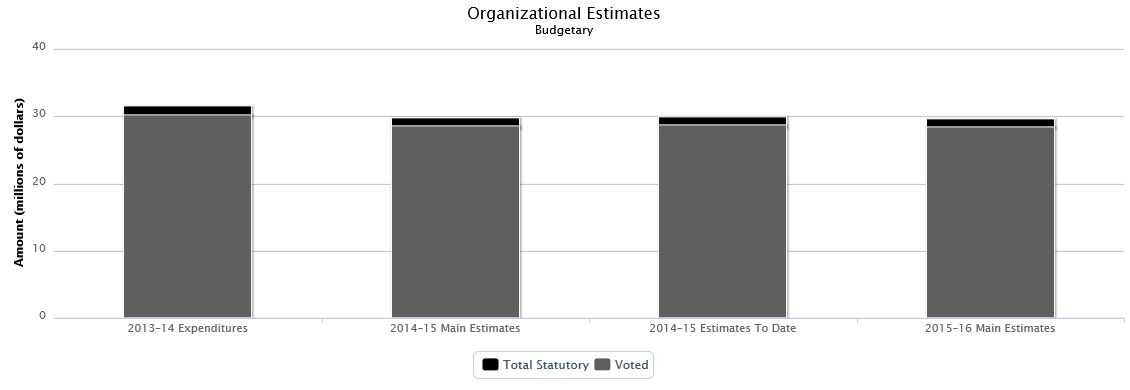
| 2013–14 Expenditures | 2014–15 Main Estimates | 2014–15 Estimates To Date | 2015–16 Main Estimates | ||
|---|---|---|---|---|---|
| Budgetary | |||||
| Voted | |||||
| 1 | Operating expenditures | 11,063,460 | 9,370,497 | 9,520,497 | 9,364,355 |
| 5 | Grants and contributions | 19,033,333 | 19,033,333 | 19,033,333 | 18,950,000 |
| Total voted | 30,096,793 | 28,403,830 | 28,553,830 | 28,314,355 | |
| Total Statutory | 1,325,490 | 1,203,900 | 1,203,900 | 1,228,722 | |
| Total budgetary | 31,422,283 | 29,607,730 | 29,757,730 | 29,543,077 | |
Highlights
SWC is estimating budgetary expenditures of $29.5 million in 2015–16. Of this amount, approximately $28.3 million requires approval by Parliament. The remaining $1.2 million represents statutory forecasts that do not require additional approval and are provided for information purposes.
SWCʼs planned expenditures remain similar to the previous year.
Once tabled in the House of Commons, additional information will be available in SWCʼs 2015–16 Report on Plans and Priorities.
Details on SWCʼs 2013–14 spending may be found in the organizationʼs 2013–14 Departmental Performance Report.
Expenditures by Strategic Outcome and Program
| 2013–14 Expenditures | 2014–15 Main Estimates | 2015–16 Main Estimates | |
|---|---|---|---|
| Equality between women and men is promoted and advanced in Canada. | |||
| Advancing Equality for Women | 22,750,591 | 24,267,723 | 23,155,089 |
| Leadership, Expertise and Advice | 2,189,159 | 2,136,900 | 2,142,013 |
| The following program supports all strategic outcomes within this organization. | |||
| Internal Services | 6,482,533 | 3,203,107 | 4,245,975 |
| Total | 31,422,283 | 29,607,730 | 29,543,077 |
Listing of the 2015–16 Transfer Payments
| 2013–14 Expenditures | 2014–15 Main Estimates | 2015–16 Main Estimates | |
|---|---|---|---|
| Grants | |||
| Womenʼs Program – Grants to women's and other voluntary organizations for the purpose of furthering womenʼs participation in Canadian society | 14,301,705 | 14,750,000 | 14,750,000 |
| Contributions | |||
| Womenʼs Program – Contributions to women's and other voluntary organizations for the purpose of furthering womenʼs participation in Canadian society | 4,731,628 | 4,283,333 | 4,200,000 |
Office of the Correctional Investigator
Raison d'être
As the ombudsman for federally sentenced offenders, the Office of the Correctional Investigator serves Canadians and contributes to safe, lawful and humane corrections through independent oversight of the Correctional Service of Canada by providing accessible, impartial and timely investigation of individual and systemic concerns.
While an independent organization, the Office of the Correctional Investigator is part of the Public Safety and Emergency Preparedness portfolio.
Organizational Estimates
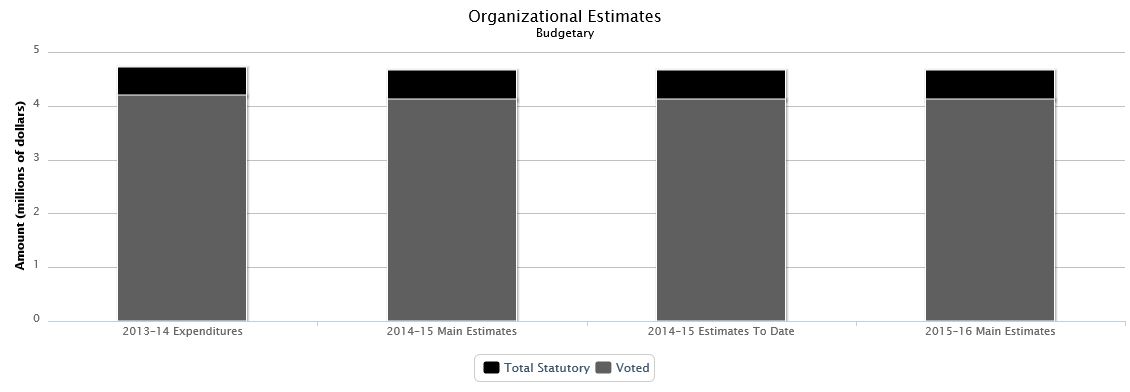
| 2013–14 Expenditures | 2014–15 Main Estimates | 2014–15 Estimates To Date | 2015–16 Main Estimates | ||
|---|---|---|---|---|---|
| Budgetary | |||||
| Voted | |||||
| 1 | Program expenditures | 4,192,211 | 4,120,298 | 4,120,298 | 4,106,381 |
| Total voted | 4,192,211 | 4,120,298 | 4,120,298 | 4,106,381 | |
| Total Statutory | 533,970 | 539,354 | 539,354 | 549,160 | |
| Total budgetary | 4,726,181 | 4,659,652 | 4,659,652 | 4,655,541 | |
Highlights
The Office of the Correctional Investigator is estimating budgetary expenditures of $4.7 million in 2015–16. Of this amount, approximately $4.1 million requires approval from Parliament. The remaining $549.2 thousand represents statutory forecasts that do not require additional approval and are provided for information purposes.
Historically, operating expenditures have been relatively stable as the organization's Main Estimates does not fluctuate significantly from year to year. The organization's investigative priorities in 2015–16 will include: access to health care; prevention of deaths in custody; conditions of confinement; Aboriginal corrections; safe and timely reintegration and federally sentenced women.
Expenditures by Strategic Outcome and Program
| 2013–14 Expenditures | 2014–15 Main Estimates | 2015–16 Main Estimates | |
|---|---|---|---|
| The problems of offenders in the federal correctional system are identified and addressed in a timely fashion. | |||
| Ombudsman for federal offenders | 3,592,430 | 3,623,993 | 3,682,952 |
| The following program supports all strategic outcomes within this organization. | |||
| Internal Services | 1,133,751 | 1,035,659 | 972,589 |
| Total | 4,726,181 | 4,659,652 | 4,655,541 |
Office of the Director of Public Prosecutions
Raison d'être
The Office of the Director of Public Prosecutions (ODPP), created on , with the coming into force of the Director of Public Prosecutions Act is an independent prosecution service mandated to prosecute offences under federal jurisdiction. On , by virtue of the adoption of an Order in Council providing for the coming into force of amendments to the Canada Elections Act, the Office of the Commissioner of Canada Elections (OCCE) was formally transferred from Elections Canada to the ODPP. The Commissioner and the Director exercise their statutory duties independently from each other even while operating within the same organization.
The Minister of Justice and Attorney General of Canada is responsible for this organization.
The first strategic outcome under the ODPP's Program Alignment Architecture is that criminal and regulatory offences under federal law are prosecuted in an independent, impartial and fair manner. The ODPP is responsible for:
- providing legal advice to federal investigative agencies and government departments on the criminal law implications of investigations and prosecutions;
- ensuring the appropriate enforcement of federal laws through principled and independent decisions by prosecutors; and
- maintaining confidence in the administration of justice through professionally conducted prosecutions that result in a judicial determination on the merits of the evidence.
The second strategic outcome is that compliance and enforcement activities under the Canada Elections Act and Referendum Act are conducted by the Commissioner of Canada Elections and his staff in a fair, impartial and independent manner. Activities related to this mandate include:
- the use of non–punitive and informal corrective measures in response to certain situations of non–compliance and of formal measures for others, such as the conclusion of compliance agreements with offenders, the seeking of injunctions during election periods, and the making of applications for the judicial deregistration of a registered party; and
- taking enforcement measures to respond to situations of non-compliance, including deciding which matters will be referred to the ODPP for possible prosecution and what charges will be recommended.
Additional information on the ODPP can be found in the Public Prosecution Service of Canada Report on Plans and Priorities.
Organizational Estimates
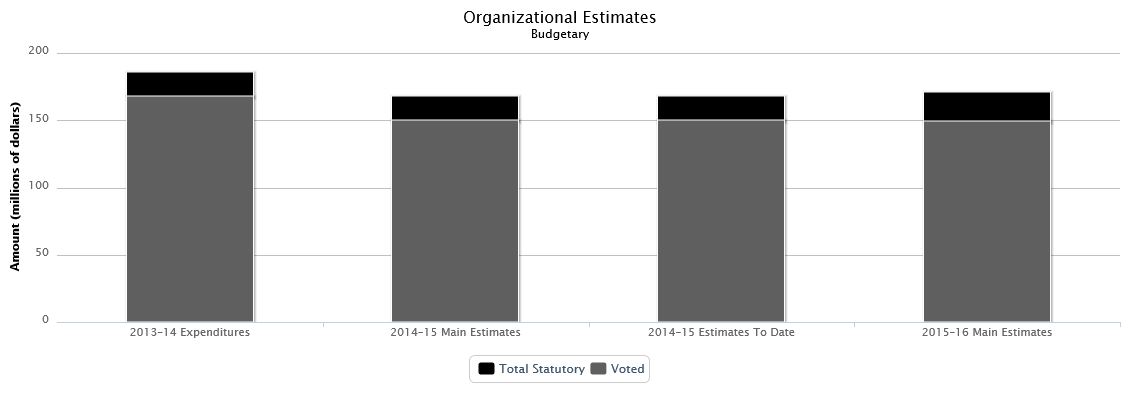
| 2013–14 Expenditures | 2014–15 Main Estimates | 2014–15 Estimates To Date | 2015–16 Main Estimates | ||
|---|---|---|---|---|---|
| Budgetary | |||||
| Voted | |||||
| 1 | Program expenditures | 167,621,734 | 149,579,834 | 149,579,834 | 149,298,354 |
| Total voted | 167,621,734 | 149,579,834 | 149,579,834 | 149,298,354 | |
| Total Statutory | 17,671,807 | 18,236,040 | 18,236,040 | 21,419,841 | |
| Total budgetary | 185,293,541 | 167,815,874 | 167,815,874 | 170,718,195 | |
Highlights
The 2015–16 budgetary authorities equal $170.7 million and include $149.3 million for program expenditures and $21.4 million for statutory expenditures. Of the statutory expenditures, $18.9 million are to contribute to employees benefit plans and $2.5 million to ensure compliance and enforcement of the Canada Elections Act and the Referendum Act.
- The increase of $2.9 million from the 2014–15 Main Estimates ($167.8 million) to the 2015–16 Main Estimates ($170.7 million) is mainly due to the transfer of the Commissioner of Canada Elections to the ODPP; and
- The variance of $17.5 million between the 2013–14 Expenditures ($185.3) and the 2014-5 Main Estimates ($167.8 million) is mainly due to payments for the relocation and refit of offices, new collective bargaining settlements, payments to terminate severance pay entitlements, as well as an increase in legal services which were recovered from other government departments.
Budgetary authorities will be used to fulfill the following key duties of the ODPP:
- The duty to act independently in making decisions related to criminal prosecutions – This constitutional principle recognizes that decisions to prosecute, stay proceedings, withdraw charges or launch an appeal must be made solely in accordance with legal criteria. The public interest must be taken into account, but not considerations of a partisan political nature; and
- The duty to act independently in providing prosecution-related legal advice – While prosecution-related advice to law enforcement and other federal investigative agencies will take into account the agency's legal and policy setting, prosecutors cannot be drawn into the agency's policy making and program administration such that their ability to provide impartial and effective legal advice is undermined.
The budgetary authorities of the OCCE will be used to ensure compliance with, and enforcement of, the Canada Elections Act and the Referendum Act.
Areas of Prosecution
The ODPP prosecutes cases under federal jurisdiction that are referred to it by the Royal Canadian Mounted Police (RCMP), other federal investigative agencies, as well as provincial and municipal police forces.
It is responsible for the prosecution of all drug offences under the Controlled Drugs and Substances Act, regardless of whether a federal, provincial, or municipal police agency lays the charges, in all provinces except Quebec and New Brunswick. In the latter two provinces, the ODPP is responsible for drug charges laid by the RCMP only.
In all provinces and territories, the ODPP prosecutes offences under federal statutes aimed at protecting the environment and natural resources as well as the country's economic and social health (e.g., Fisheries Act, Income Tax Act, Copyright Act, Canada Elections Act, Canadian Environmental Protection Act, Competition Act, Customs Act, Excise Act, and Excise Tax Act), offences involving fraud against the government, capital market fraud offences, along with conspiracies and attempts to violate any of these statutes. The ODPP routinely provides advice in relation to, and prosecutes offences under approximately 40 of those statutes.
In the three territories, the ODPP prosecutes all Criminal Code offences as well as offences under all other federal legislation and certain territorial statutes. In the provinces, the ODPP has jurisdiction to prosecute certain Criminal Code offences, including those related to terrorism, criminal organizations, money laundering, capital markets fraud and proceeds of crime. Under arrangements with the provinces, the ODPP may prosecute Criminal Code offences that are otherwise within provincial jurisdiction when the accused also faces charges within federal jurisdiction.
Where requested by investigators, the ODPP also provides advice to investigators in respect of prosecutions generally or in respect of investigations that may lead to prosecutions. Such advice is key to ensure that investigative techniques and procedures are consistent with evolving rules of evidence and protections under the Canadian Charter of Rights and Freedoms. The advantage of early prosecutorial advice is that it reduces the risk that operational decisions, such as those about methods of obtaining evidence, will detrimentally affect the admissibility of evidence at trial or the constitutional rights of Canadians.
The Commissioner of Canada Electionsʼ duty pursuant to section 509.2 of the Canada Elections Act is to ensure that the Act is complied with and enforced. The Commissioner is also responsible for ensuring compliance with, and enforcement of, the Referendum Act. Accordingly, the Commissioner is responsible for the investigation of offences and for making recommendations to the Director of Public Prosecutions with respect to the laying of charges under these acts. The Commissioner exercises this mandate in accordance with these acts, other relevant statutory authorities and constitutional law, as well as applicable internal practices and policies.
Expenditures by Strategic Outcome and Program
| 2013–14 Expenditures | 2014–15 Main Estimates | 2015–16 Main Estimates | |
|---|---|---|---|
| Criminal and regulatory offences under federal law are prosecuted in an independent, impartial and fair manner. | |||
| Drug, Criminal Code, and terrorism prosecution program | 137,105,995 | 129,925,298 | 130,464,160 |
| Regulatory offences and economic crime prosecution program | 18,552,131 | 16,484,725 | 16,245,056 |
| Compliance and enforcement activities under the Canada Elections Act and Referendum Act are conducted by the Commissioner of Canada Elections in an independent, impartial and fair manner. | |||
| Compliance | 0 | 0 | 2,457,484 |
| Enforcement | 0 | 0 | 1,638,323 |
| The following program supports all strategic outcomes within this organization. | |||
| Internal Services | 29,635,415 | 21,405,851 | 19,913,172 |
| Total | 185,293,541 | 167,815,874 | 170,718,195 |
Office of the Public Sector Integrity Commissioner
Raison d'être
The Office of the Public Sector Integrity Commissioner of Canada (the Office) was set up to administer the Public Servants Disclosure Protection Act, which came into force in . The Office is mandated to establish a safe, independent, and confidential process for public servants and members of the public to disclose potential wrongdoing in the federal public sector. The Office also helps to protect public servants who have filed disclosures or participated in related investigations from reprisal.
The disclosure regime is an element of the framework which strengthens accountability and management oversight in government operations.
The Commissioner reports directly to Parliament, and the President of the Treasury Board is responsible for tabling the Report on Plans and Priorities and the Departmental Performance Report of the Office.
Organizational Estimates
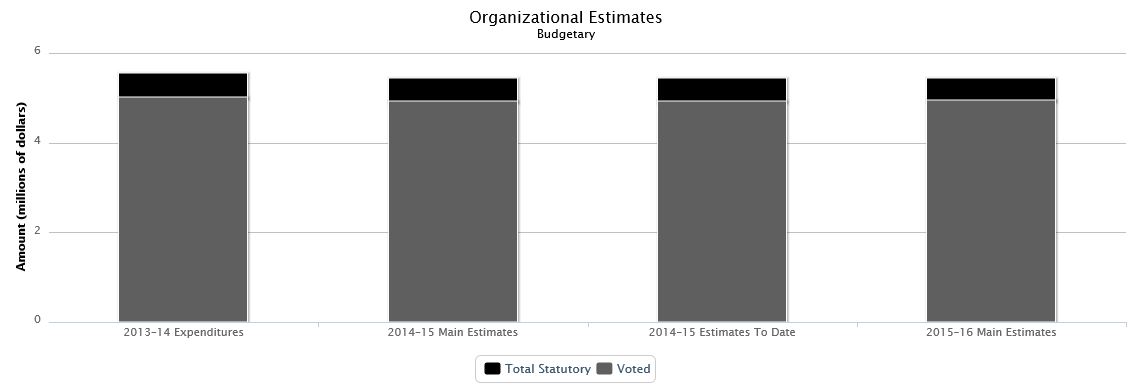
| 2013–14 Expenditures | 2014–15 Main Estimates | 2014–15 Estimates To Date | 2015–16 Main Estimates | ||
|---|---|---|---|---|---|
| Budgetary | |||||
| Voted | |||||
| 1 | Program expenditures | 5,006,607 | 4,923,694 | 4,923,694 | 4,934,882 |
| Total voted | 5,006,607 | 4,923,694 | 4,923,694 | 4,934,882 | |
| Total Statutory | 536,434 | 502,540 | 502,540 | 513,560 | |
| Total budgetary | 5,543,041 | 5,426,234 | 5,426,234 | 5,448,442 | |
Highlights
The Office is estimating budgetary expenditures of $5.4 million in 2015-16. Of this amount, $4.9 million requires approval by Parliament. The remaining $0.5 million represents statutory forecasts that do not require additional approval and are provided for information purposes. The 2015–16 level of expenditures is slightly lower, $0.1 million, than the actual spending in 2013–14, and is on par with the 2014–15 Main Estimates. The main use of funds is to pay for salaries, benefits, and professional services which provide and support a disclosure and reprisal function that is timely, rigorous, independent and accessible. Further information on the use of funds can be found in the Report on Plans and Priorities.
The level of spending is fairly constant, and in 2014–15 the number of new cases and the number of investigations has not changed significantly. There is a risk that increases in the number of new cases or the complexity of cases received may impact the timeliness in which the Office can respond to disclosures of wrongdoing and complaints of reprisal.
Expenditures by Strategic Outcome and Program
| 2013–14 Expenditures | 2014–15 Main Estimates | 2015–16 Main Estimates | |
|---|---|---|---|
| Wrongdoing in the federal public sector is addressed and public servants are protected in case of reprisal. | |||
| Disclosure and Reprisal Management Program | 3,608,322 | 3,571,794 | 3,418,985 |
| The following program supports all strategic outcomes within this organization. | |||
| Internal Services | 1,934,719 | 1,854,440 | 2,029,457 |
| Total | 5,543,041 | 5,426,234 | 5,448,442 |
Listing of the 2015–16 Transfer Payments
| 2013–14 Expenditures | 2014–15 Main Estimates | 2015–16 Main Estimates | |
|---|---|---|---|
| Contributions | |||
| Contributions for access to legal advice under the Public Servants Disclosure Protection Act | 34,533 | 40,000 | 40,000 |
Office of the Superintendent of Financial Institutions
Raison d'être
The Office of the Superintendent of Financial Institutions (OSFI) was established in 1987 by an Act of Parliament: the Office of the Superintendent of Financial Institutions Act (OSFI Act). It is an independent agency of the Government of Canada and reports to Parliament through the Minister of Finance.
OSFI supervises and regulates all banks in Canada and all federally incorporated or registered trust and loan companies, insurance companies, cooperative credit associations, fraternal benefit societies and private pension plans. OSFI's mandate does not include consumer-related issues or the securities industry.
The Office of the Chief Actuary, which is an independent unit within OSFI, provides actuarial valuation and advisory services for the Canada Pension Plan, the Old Age Security program, the Canada Student Loans and Employment Insurance Programs and other public sector pension and benefit plans.
Organizational Estimates

| 2013–14 Expenditures | 2014–15 Main Estimates | 2014–15 Estimates To Date | 2015–16 Main Estimates | ||
|---|---|---|---|---|---|
| Budgetary | |||||
| Voted | |||||
| 1 | Program expenditures | 945,058 | 937,691 | 937,691 | 945,058 |
| Total voted | 945,058 | 937,691 | 937,691 | 945,058 | |
| Total Statutory | 16,092,391 | 141,825,838 | 141,825,838 | 146,989,054 | |
| Total budgetary | 17,037,449 | 142,763,529 | 142,763,529 | 147,934,112 | |
Highlights
The OSFI is estimating budgetary expenditures of $147.9 million in 2015–16. Of this amount, $0.9 million requires approval by Parliament. The remaining $147.0 million represents statutory forecasts that do not require additional approval and are provided for information purposes.
OSFI's $0.9 million appropriation is used to fund part of the activities of the Office of the Chief Actuary. All other expenditures are fully recovered through assessments and user fees billed on the accrual basis of accounting. Historically, OSFI's statutory respendable revenue was presented in the Main Estimates and Public Accounts as an offset to OSFI's expenditures. As a result, OSFI's total planned spending in any given year was shown as either a net expenditure or receipt. Starting in 2014–15, the full amount of statutory expenditure will be shown (without offsetting revenues) in order to present a more meaningful representation of OSFI's costs and level of activities.
In 2015–16, OSFI will continue to focus on contributing to public confidence in the Canadian financial system. Specifically, OSFI will:
- Supervise federally regulated financial institutions and pension plans to determine whether they are in sound financial condition and meeting minimum plan funding requirements respectively, and are complying with their governing law and supervisory requirements;
- Promptly advise institutions and plans in the event there are material deficiencies and take or require management, boards or plan administrators to take necessary corrective measures expeditiously;
- Advance and administer a regulatory framework that promotes the adoption of policies and procedures designed to control and manage risk;
- Monitor and evaluate system-wide or sectoral issues that may impact institutions negatively.
Please refer to OSFI's 2015–16 Report on Plans and Priorities for further details.
Expenditures by Strategic Outcome and Program
| 2013–14 Expenditures | 2014–15 Main Estimates | 2015–16 Main Estimates | |
|---|---|---|---|
| A safe and sound Canadian financial system. | |||
| Regulation and Supervision of Federally Regulated Financial Institutions | 5,262,282 | 77,788,097 | 78,956,478 |
| Regulation and Supervision of Federally Regulated Private Pension Plans | (2,461,381) | 4,420,260 | 4,105,818 |
| A financially sound and sustainable Canadian public retirement income system. | |||
| Actuarial Valuation and Advisory Services | (710,886) | 5,231,775 | 6,130,074 |
| The following program supports all strategic outcomes within this organization. | |||
| Internal Services | 14,947,434 | 55,323,397 | 58,741,742 |
| Total | 17,037,449 | 142,763,529 | 147,934,112 |
Offices of the Information and Privacy Commissioners of Canada
Raison d'être
Office of the Privacy Commissioner of Canada
As an Agent of Parliament, the Privacy Commissioner of Canada reports directly to the House of Commons and the Senate. The mandate of the Office of the Privacy Commissioner of Canada (OPC) is to oversee compliance with both the Privacy Act, which covers the personal information-handling practices of federal government departments and agencies, and the Personal Information Protection and Electronic Documents Act (PIPEDA), Canada's private-sector privacy law, along with some aspects of Canada's anti-spam law (CASL). The OPC's mission is to protect and promote the privacy rights of individuals.
Office of the Information Commissioner of Canada
The Information Commissioner of Canada reports directly to the House of Commons and the Senate. The Office of the Information Commissioner of Canada ensures that the rights conferred by the Access to Information Act are respected, which ultimately enhances transparency and accountability across the federal government.
For administrative purposes, the Minister of Justice is responsible for submitting these organizations' Reports on Plans and Priorities and Departmental Performance Reports.
Organizational Estimates
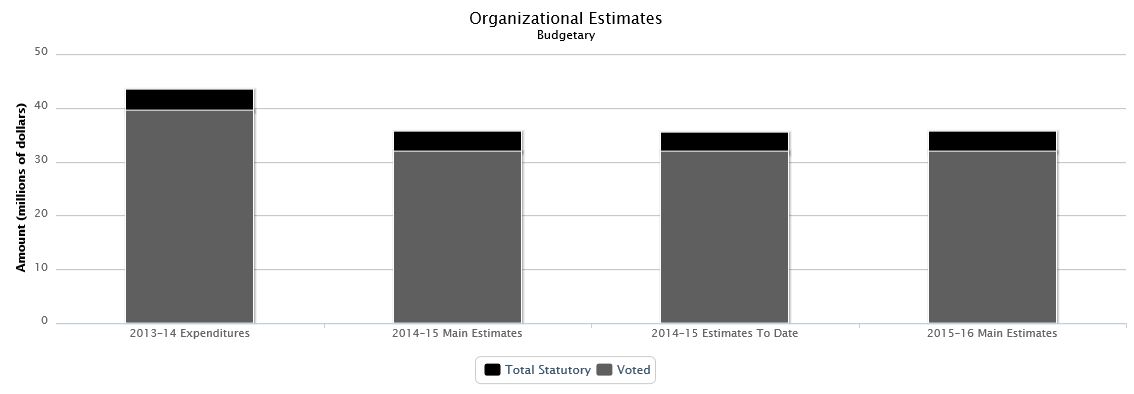
| 2013–14 Expenditures | 2014–15 Main Estimates | 2014–15 Estimates To Date | 2015–16 Main Estimates | ||
|---|---|---|---|---|---|
| Budgetary | |||||
| Voted | |||||
| 1 | Office of the Information Commissioner of Canada – Program expenditures | 13,965,233 | 9,897,674 | 9,897,674 | 9,927,361 |
| 5 | Office of the Privacy Commissioner of Canada – Program expenditures | 25,553,435 | 21,949,100 | 21,883,000 | 21,908,457 |
| Total voted | 39,518,668 | 31,846,774 | 31,780,674 | 31,835,818 | |
| Total Statutory | 3,905,549 | 3,674,639 | 3,674,639 | 3,750,848 | |
| Total budgetary | 43,424,217 | 35,521,413 | 35,455,313 | 35,586,666 | |
Highlights
Office of the Privacy Commissioner of Canada
The OPC is estimating budgetary expenditures of $24.3 million in 2015–16. Of this amount, $21.9 million requires approval by Parliament. The remaining $2.4 million represents statutory forecasts that do not require additional approval and are provided for information purposes.
The OPCʼs budgetary Main Estimates for 2015–16 are $24.3 million which remains stable since 2014–15. However, in 2015–16, the OPC budget reflects the following adjustments:
- A decrease of $125.0 thousand due to the transfer to Canadian Radio-television and Telecommunications Commission to assist with the establishment and operation of the Spam Reporting Centre;
- An increase of $59.0 thousand annually for a period of 15 years for relocation of offices to Gatineau;
- The adjustment to the employee benefit plans of $47.0 thousand; and,
- An increase in salary of $26.0 thousand related to recently signed collective agreements.
The OPC permanent funding in 2015–16 and ongoing will remain stable and will be used to carry out OPC efforts and activities towards achieving the organization's single Strategic Outcome – the privacy rights of individuals are protected – and also the Office priorities for 2015–16:
- Advance the new privacy priorities;
- Optimize organizational capacity and agility; and,
- Enhance partnership and collaboration opportunities.
Office of the Information Commissioner of Canada
The OIC is estimating budgetary expenditures of $11.3 million in 2015–16. Of this amount, $9.9 million requires approval by Parliament. The remaining $1.3 million represents statutory forecasts that do not require additional approval and are provided for information purposes.
The OIC's budgetary Main Estimates for 2015–16 are $11.3 million, an increase of $58.9 thousand from the previous year. Major factors contributing to the net increase include:
- An increase of $29,932 due to recently signed collective agreements;
- An increase to the employee benefit plans of $28,725; and,
- A decrease of $245 for late fees.
In 2015–16, the funding will be used first and foremost to carry out efficient, fair and confidential investigations of complaints and issues of concern on how federal institutions handle access to information requests from the public. Other activities will be conducted in support of the Commissioner's advisory role to Parliament on all access to information matters. Where required, the OIC staff will also assist the Commissioner in bringing issues of interpretation and enforcement of the law before the courts.
Expenditures by Strategic Outcome and Program
| 2013–14 Expenditures | 2014–15 Main Estimates | 2015–16 Main Estimates | |
|---|---|---|---|
| The privacy rights of individuals are protected. | |||
| Compliance Activities | 11,423,618 | 11,672,022 | 11,675,374 |
| Research and Policy Development | 2,968,987 | 3,834,863 | 3,835,821 |
| Public Outreach | 2,698,747 | 3,096,659 | 3,097,548 |
| Requestorsʼ rights under the Access to Information Act are safeguarded. | |||
| Compliance with access to information obligations | 9,961,251 | 8,624,739 | 8,669,716 |
| The following program supports all strategic outcomes within this organization. | |||
| Internal Services – Office of the Privacy Commissioner | 11,027,772 | 5,716,909 | 5,718,551 |
| Internal Services – Office of the Information Commissioner | 5,343,842 | 2,576,221 | 2,589,656 |
| Total | 43,424,217 | 35,521,413 | 35,586,666 |
Listing of the 2015–16 Transfer Payments
| 2013–14 Expenditures | 2014–15 Main Estimates | 2015–16 Main Estimates | |
|---|---|---|---|
| Contributions | |||
| The Personal Information Protection and Electronic Documents Act Contribution Program | 480,999 | 500,000 | 500,000 |
Old Port of Montreal Corporation Inc.
Raison d'être
Order in Council P.C. 2012-1583 authorized the amalgamation of Old Port of Montreal Inc. with Canada Lands Company Limited.
Organizational Estimates

| 2013–14 Expenditures | 2014–15 Main Estimates | 2014–15 Estimates To Date | 2015–16 Main Estimates | ||
|---|---|---|---|---|---|
| Budgetary | |||||
| Voted | |||||
| - | Payments to the Old Port of Montreal Corporation Inc. or to the Crown corporation to which it is amalgamated for operating and capital expenditures of the Old Port of Montreal Division | 17,196,000 | 0 | 0 | 0 |
| Total voted | 17,196,000 | 0 | 0 | 0 | |
| Total budgetary | 17,196,000 | 0 | 0 | 0 | |
Highlights
Not applicable
Expenditures by Strategic Outcome and Program
| 2013–14 Expenditures | 2014–15 Main Estimates | 2015–16 Main Estimates | |
|---|---|---|---|
| An urban park dedicated to recreational, tourist and cultural activities that safeguard and promote the Old Port of Montrealʼs cultural heritage while facilitating public access to the waterfront. | |||
| Management of the Old Port of Montreal as an urban park, a tourist destination offering recreational and cultural activities | 17,196,000 | 0 | 0 |
| Total | 17,196,000 | 0 | 0 |
Parks Canada Agency
Raison d'être
The Minister of the Environment is responsible for the Parks Canada Agency. Parks Canada protects and presents nationally significant examples of Canada's natural and cultural heritage, and fosters public understanding, appreciation and enjoyment in ways that ensure the ecological and commemorative integrity of these places for present and future generations. National parks, national historic sites, heritage canals and national marine conservation areas, of which Parks Canada is the proud steward, offer to Canadians the opportunity to live meaningful experiences and to personally connect with these heritage places. In carrying out its responsibilities, Parks Canada works in collaboration with Aboriginal peoples, stakeholders and neighbouring communities.
Organizational Estimates
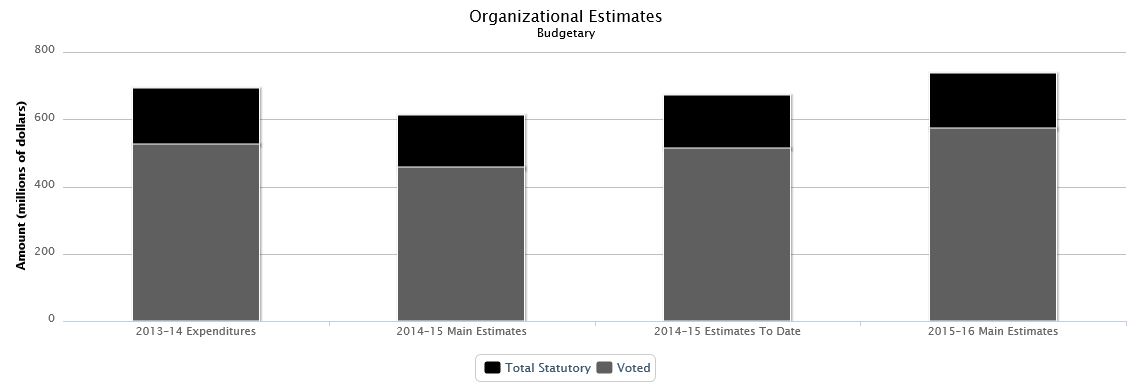
| 2013–14 Expenditures | 2014–15 Main Estimates | 2014–15 Estimates To Date | 2015–16 Main Estimates | ||
|---|---|---|---|---|---|
| Budgetary | |||||
| Voted | |||||
| 1 | Program expenditures | 523,350,794 | 451,381,399 | 510,133,010 | 571,135,767 |
| 5 | Payments to the New Parks and Historic Sites Account | 500,000 | 3,500,000 | 3,500,000 | 500,000 |
| Total voted | 523,850,794 | 454,881,399 | 513,633,010 | 571,635,767 | |
| Total Statutory | 167,090,562 | 157,583,735 | 157,754,486 | 165,637,236 | |
| Total budgetary | 690,941,356 | 612,465,134 | 671,387,496 | 737,273,003 | |
Highlights
With authorities of $737.3 million anticipated through the 2015–16 Main Estimates, Parks Canada Agency will continue to present, protect and manage national parks, national historic sites, heritage canals and national marine conservation areas for the benefit and enjoyment of Canadians. Parks Canada Agency's total authorities for 2015–16 have a net increase of $124.8 million from the previous year's Main Estimates.
This increase is primarily due to new funding received as part of Canada's Economic Action Plan 2014 to make improvements to highways, bridges and dams located in national parks and along historic canals.
For more information, details on the Agency's priorities will be made available in its 2015–16 Report on Plans and Priorities.
Expenditures by Strategic Outcome and Program
| 2013–14 Expenditures | 2014–15 Main Estimates | 2015–16 Main Estimates | |
|---|---|---|---|
| Canadians have a strong sense of connection to their national parks, national historic sites, heritage canals, and national marine conservation areas and these protected places are experienced in ways that leave them unimpaired for the enjoyment of present and future generations. | |||
| Visitor Experience | 263,655,992 | 238,298,011 | 234,733,102 |
| Heritage Canals, Highways and Townsites Management | 118,681,423 | 93,460,532 | 191,344,084 |
| Heritage Places Conservation | 140,659,981 | 157,590,219 | 157,901,824 |
| Heritage Places Promotion and Public Support | 43,793,272 | 39,448,240 | 37,259,692 |
| Heritage Places Establishment | 27,859,372 | 23,867,969 | 27,582,536 |
| The following program supports all strategic outcomes within this organization. | |||
| Internal Services | 96,291,316 | 59,800,163 | 88,451,765 |
| Total | 690,941,356 | 612,465,134 | 737,273,003 |
Listing of the 2015–16 Transfer Payments
| 2013–14 Expenditures | 2014–15 Main Estimates | 2015–16 Main Estimates | |
|---|---|---|---|
| Grants | |||
| Funding to Support the Trans Canada Trail Foundation's Fundraising Campaign | 7,152,037 | 6,250,000 | 6,250,000 |
| Grant to the Qikiqtani Inuit Association | 0 | 0 | 3,000,000 |
| Grant to the International Peace Garden | 22,700 | 22,700 | 22,700 |
| Contributions | |||
| Contributions in support of activities or projects related to national parks, national marine conservation areas, national historic sites and historic canals | 3,576,886 | 3,788,275 | 3,708,175 |
Parole Board of Canada
Raison d'être
The Parole Board of Canada (the Board) is an agency within the Public Safety and Emergency Preparedness Portfolio.
The Board is an independent administrative tribunal that has exclusive jurisdiction and absolute discretion under the Corrections and Conditional Release Act to grant, cancel, terminate or revoke day parole and full parole. The Board can also terminate or revoke the statutory release.
The Board has exclusive jurisdiction and absolute discretion to order, refuse to order or revoke a record suspension under the Criminal Records Act. The Board also makes recommendations for the exercise of clemency through the Royal Prerogative of Mercy.
Additional information can be found in the organization's Report on Plans and Priorities.
Organizational Estimates
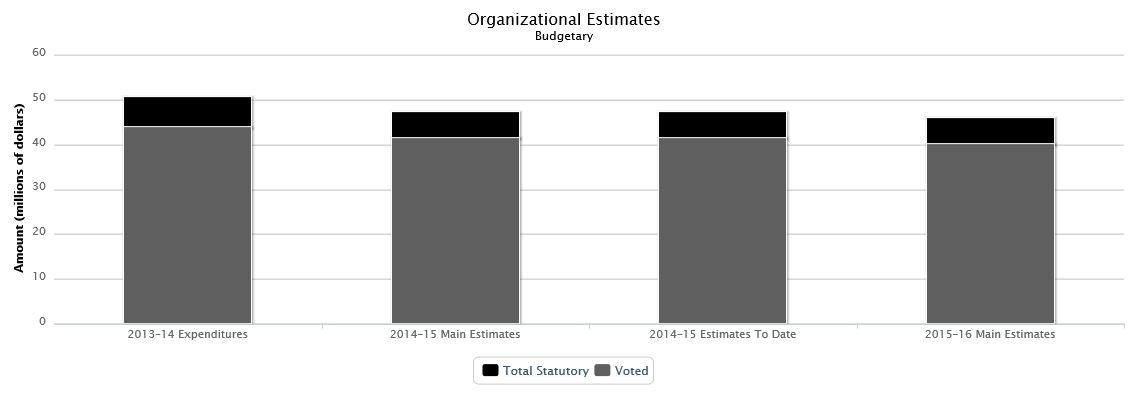
| 2013–14 Expenditures | 2014–15 Main Estimates | 2014–15 Estimates To Date | 2015–16 Main Estimates | ||
|---|---|---|---|---|---|
| Budgetary | |||||
| Voted | |||||
| 1 | Program expenditures | 43,721,153 | 41,357,732 | 41,357,732 | 40,021,838 |
| Total voted | 43,721,153 | 41,357,732 | 41,357,732 | 40,021,838 | |
| Total Statutory | 6,689,324 | 5,771,262 | 5,771,262 | 5,893,912 | |
| Total budgetary | 50,410,477 | 47,128,994 | 47,128,994 | 45,915,750 | |
Highlights
The Board is estimating expenditures of $45.9 million in 2015–16. Of this amount $40.0 million requires annual approval by Parliament. The remaining $5.9 million represents statutory forecasts that do not require additional approval and are provided for information purposes.
In total, the Board is estimating a net decrease of $1.2 million, or 2.6% from previous Main Estimates, mainly due to the following:
- A decrease of $1.4 million due to the net results of reprofiling funds between various fiscal years for the department's Medium to Long Term Accommodation Plan for Program Delivery;
- An increase of $0.1 million related to the Employee Benefit Plan; and,
- An increase of $0.1 million due to the compensation for collective agreement.
The Board also realigned the attribution of its activities under its program alignment architecture to conform to the Treasury Board Secretariat release of new guidelines on Internal Services with the objective to provide greater consistency in the recording and reporting of internal services expenditures across government.
Expenditures by Strategic Outcome and Program
| 2013–14 Expenditures | 2014–15 Main Estimates | 2015–16 Main Estimates | |
|---|---|---|---|
| Conditional release and record suspension decisions and decision processes that safeguard Canadian communities. | |||
| Conditional Release Decisions | 36,601,459 | 34,858,585 | 33,532,213 |
| Conditional Release Openness and Accountability | 5,552,600 | 6,626,610 | 4,942,242 |
| Record Suspension Decisions/Clemency Recommendations | 2,846,012 | 529,452 | 539,078 |
| The following program supports all strategic outcomes within this organization. | |||
| Internal Services | 5,410,406 | 5,114,347 | 6,902,217 |
| Total | 50,410,477 | 47,128,994 | 45,915,750 |
Patented Medicine Prices Review Board
Raison d'être
The Patented Medicine Prices Review Board (PMPRB) is an independent, quasi-judicial body created by Parliament in 1987. Its mandate is two-fold:
- Regulatory – to ensure that prices charged by patentees for patented medicines sold in Canada are not excessive; and
- Reporting – to report on pharmaceutical trends of all medicines and on R&D spending by pharmaceutical patentees.
In carrying out its mandate, the PMPRB ensures that Canadians are protected from excessive prices for patented medicines sold in Canada and that stakeholders are informed on pharmaceutical trends.
The Minister of Health is responsible for this organization.
Organizational Estimates
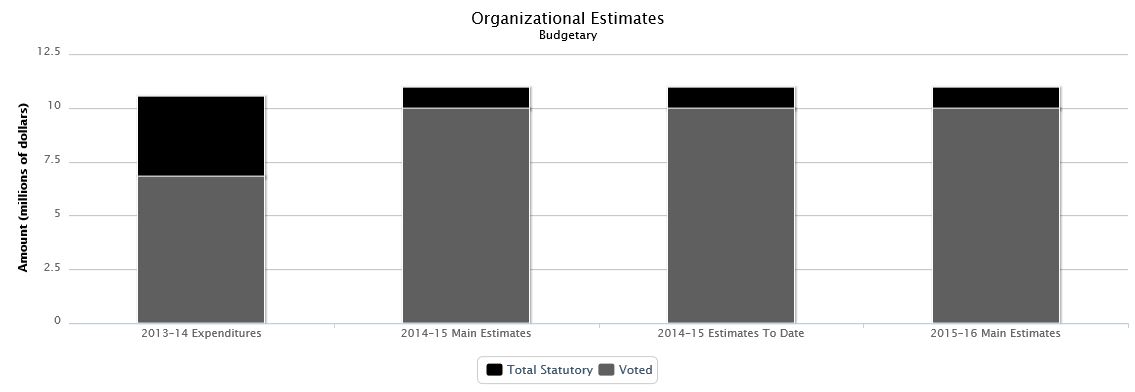
| 2013–14 Expenditures | 2014–15 Main Estimates | 2014–15 Estimates To Date | 2015–16 Main Estimates | ||
|---|---|---|---|---|---|
| Budgetary | |||||
| Voted | |||||
| 1 | Program expenditures | 6,807,076 | 9,949,348 | 9,949,348 | 9,947,595 |
| Total voted | 6,807,076 | 9,949,348 | 9,949,348 | 9,947,595 | |
| Total Statutory | 3,733,491 | 977,682 | 977,682 | 997,586 | |
| Total budgetary | 10,540,567 | 10,927,030 | 10,927,030 | 10,945,181 | |
Highlights
The PMPRB is estimating budgetary expenditures of $10.9 million in 2015–16. Of this amount, $9.9 million requires approval by Parliament. The remaining $1.0 million represents statutory forecasts that do not require further approval and is provided for information purposes.
The Main Estimates for the PMPRB are $10.9 million, approximately the same amount as the 2014–15 Main Estimates.
Detailed information on the PMPRB authority, mandate and program activities can be found in the PMPRB's Report on Plans and Priorities.
Expenditures by Strategic Outcome and Program
| 2013–14 Expenditures | 2014–15 Main Estimates | 2015–16 Main Estimates | |
|---|---|---|---|
| Canadians are protected from excessive prices for patented medicines sold in Canada and stakeholders are informed on pharmaceutical trends. | |||
| Patented Medicine Prices Regulation Program | 6,395,602 | 6,827,010 | 6,834,096 |
| Pharmaceutical Trends Program | 1,146,790 | 1,267,557 | 1,506,994 |
| The following program supports all strategic outcomes within this organization. | |||
| Internal Services | 2,998,175 | 2,832,463 | 2,604,091 |
| Total | 10,540,567 | 10,927,030 | 10,945,181 |
PPP Canada Inc.
Raison d'être
PPP Canada is a Crown Corporation established in 2008 to support the development of public-private partnerships (P3). The Minister of Finance is responsible for this organization.
P3s are an alternative method for procuring large and complex public infrastructure projects. They offer three major benefits, which are better costs and delay controls, optimization of risk and resources, and innovation. P3 contracts are typically long-term engagements that use specific financial structures to leverage performance and innovation from the private sector and divest the taxpayer of risks associated with the design, construction, maintenance and operation of the infrastructure. PPP Canada acts as a leading source on P3 matters through knowledge development and sharing. In addition, the Corporation provides expertise and advice in assessing and executing P3 opportunities at the federal level as well as leveraging greater value for money from federal investments in provincial, territorial, municipal and First Nations infrastructure through the P3 Canada Fund.
Organizational Estimates
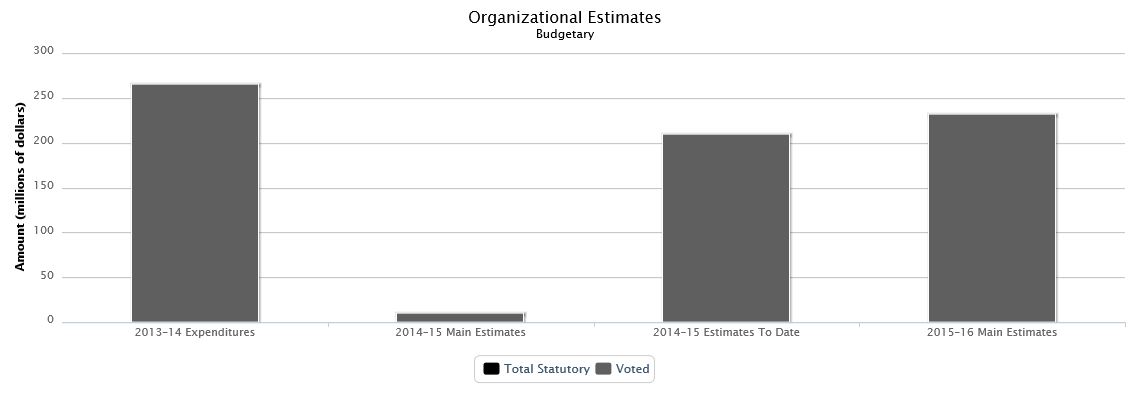
| 2013–14 Expenditures | 2014–15 Main Estimates | 2014–15 Estimates To Date | 2015–16 Main Estimates | ||
|---|---|---|---|---|---|
| Budgetary | |||||
| Voted | |||||
| 1 | Payments to PPP Canada Inc. for operations and program delivery | 12,300,000 | 9,500,000 | 11,800,000 | 11,800,000 |
| 5 | Payments to PPP Canada Inc. for P3 Canada Fund investments | 252,900,000 | 0 | 197,700,000 | 219,400,000 |
| Total voted | 265,200,000 | 9,500,000 | 209,500,000 | 231,200,000 | |
| Total budgetary | 265,200,000 | 9,500,000 | 209,500,000 | 231,200,000 | |
Highlights
PPP Canada is presenting $231.2 million of budgetary expenditures in the 2015–16 Main Estimates which require approval by Parliament.
The $11.8 million in operating funds will continue to support internal expertise and increased knowledge of PPP Canada staff through the development of relevant tools, studies and products; to support efforts in providing advice on the execution of projects for the federal government including the development and production of a suite of federal guidance tools; support activities related to the P3 Canada Fund and the New Building Canada Fund P3 Screen including outreach and awareness activities; and support day-to-day operations including pay and benefits and office space equipment.
The $219.4 million in program funding for the P3 Canada Fund will continue to focus on supporting innovative P3 projects that deliver value for money for all Canadians and develop the Canadian P3 market and will focus, in particular, on jurisdictions inexperienced with P3 procurement. In addition, PPP Canada has a mandate to work with Infrastructure Canada and New Building Canada Fund applicants to screen designated projects for P3 viability through the P3 Screen. Projects that are found to demonstrate potential to succeed as a P3 will be required to work with PPP Canada to develop a Procurement Options Analysis (POA). The Government of Canada has allocated $10 million from the P3 Canada Fund to support applicants in their preparation of a POA.
Expenditures by Strategic Outcome and Program
| 2013–14 Expenditures | 2014–15 Main Estimates | 2015–16 Main Estimates | |
|---|---|---|---|
| Transform Canada into a leader for public-private partnerships (P3). | |||
| Federal Public-Private Partnership Initiatives | 0 | 9,500,000 | 231,200,000 |
| Funds not allocated to the 2015–16 Program Alignment Architecture | 265,200,000 | 0 | 0 |
| Total | 265,200,000 | 9,500,000 | 231,200,000 |
Privy Council
Raison d'être
The mandate of the Privy Council Office (PCO) is to serve Canada and Canadians by providing professional, non-partisan advice and support to the Prime Minister, the ministers within the Prime Minister's portfolio and Cabinet. The Prime Minister is responsible for this organization.
PCO supports the development of the Government of Canada's policy and legislative agendas, coordinates responses to issues facing the Government and the country, and supports the effective operation of Cabinet. PCO is led by the Clerk of the Privy Council. In addition to serving as the Deputy Head for PCO, the Clerk also acts as Secretary to the Cabinet and the Head of the Public Service.
Additional information can be found in PCO's Report on Plans and Priorities.
Organizational Estimates
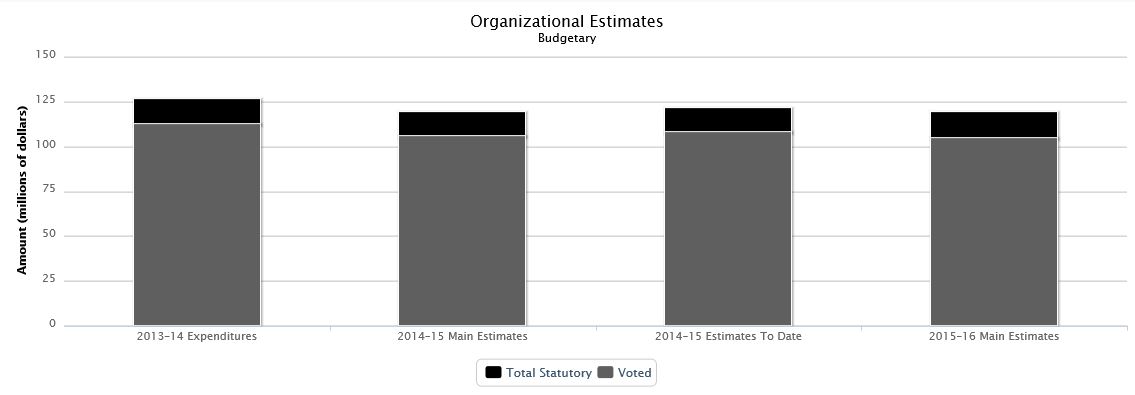
| 2013–14 Expenditures | 2014–15 Main Estimates | 2014–15 Estimates To Date | 2015–16 Main Estimates | ||
|---|---|---|---|---|---|
| Budgetary | |||||
| Voted | |||||
| 1 | Program expenditures | 112,118,460 | 105,754,626 | 107,986,991 | 104,454,216 |
| Total voted | 112,118,460 | 105,754,626 | 107,986,991 | 104,454,216 | |
| Total Statutory | 14,266,667 | 13,052,363 | 13,422,977 | 14,379,063 | |
| Total budgetary | 126,385,127 | 118,806,989 | 121,409,968 | 118,833,279 | |
Highlights
PCO is estimating budgetary expenditures of $118.8 million in 2015–16. Of this amount, $104.4 million requires approval by Parliament. The remaining $14.4 million represents statutory authorities that do not require additional approval and are provided for information purposes.
When comparing the 2015–16 Main Estimates to those of the 2014–15 fiscal year, there is a net increase in spending of $26,290. The major changes since last fiscal year are explained as follows:
- An increase of $3.3 million in funding for the operations of the Canadian Secretariat to the Canada-U.S. Regulatory Cooperation Council and for the newly created Central Innovation Hub;
- An increase of $0.3 million for the ratification of specific collective agreements that took effect prior to the 2014 and 2015 budget freeze;
- A decrease of $3.4 million for the sunsetting of funds related to the coordination of government-wide communications for Canada's Economic Action Plan, the Office of the Special Advisor on Human Smuggling and Illegal Migration and the Beyond the Border Action Plan; and,
- A decrease of $0.3 million in funding for the implementation of various government-wide initiatives, including the continued consolidation of pay services, the implementation of the Canada School of Public Service's new business model, the Web Renewal Initiative, the Human Resources Modernization Initiative and the elimination of wasteful spending on late fees and interest charges for delinquent payments to suppliers, as announced in the 2014 Economic Action Plan.
Also in comparison to 2014–15 Main Estimates, there is a $1.3 million decrease to PCO's planned Voted expenditures and a corresponding $1.3 million increase in statutory expenditures. This is due to an internal budget transfer from operating to personnel and Employee Benefits Plan to better align PCO's reference levels with its actual spending profile. The transfer has no impact on PCO's total authorities.
Expenditures by Strategic Outcome and Program
| 2013–14 Expenditures | 2014–15 Main Estimates | 2015–16 Main Estimates | |
|---|---|---|---|
| The Government's agenda and decision making are supported and implemented and the institutions of government are supported and maintained. | |||
| Advice and support to the Prime Minister and portfolio ministers | 65,873,503 | 63,116,304 | 63,821,864 |
| Advice and support to Cabinet and Cabinet committees | 14,105,792 | 14,292,030 | 13,921,562 |
| Public Service leadership and direction | 2,463,664 | 3,115,243 | 4,408,311 |
| Commissions of inquiry | 0 | 0 | 0 |
| The following program supports all strategic outcomes within this organization. | |||
| Internal Services | 43,942,168 | 38,283,412 | 36,681,542 |
| Total | 126,385,127 | 118,806,989 | 118,833,279 |
Public Health Agency of Canada
Raison d'être
The Minister of Health is responsible for this organization.
Public health involves the organized efforts of society to keep people healthy and to prevent injury, illness and premature death. The Public Health Agency of Canada (the Agency) has put in place programs, services and policies that protect and promote the health of all Canadians which form part of "public health". In Canada, public health is a responsibility that is shared by all three levels of government in collaboration with the private sector, non-governmental organizations, health professionals and the public.
In , the Agency was created within the federal Health Portfolio to deliver on the Government of Canada's commitment to increase its focus on public health in order to help protect and improve the health and safety of all Canadians and to contribute to strengthening public health capacities across Canada.
Organizational Estimates
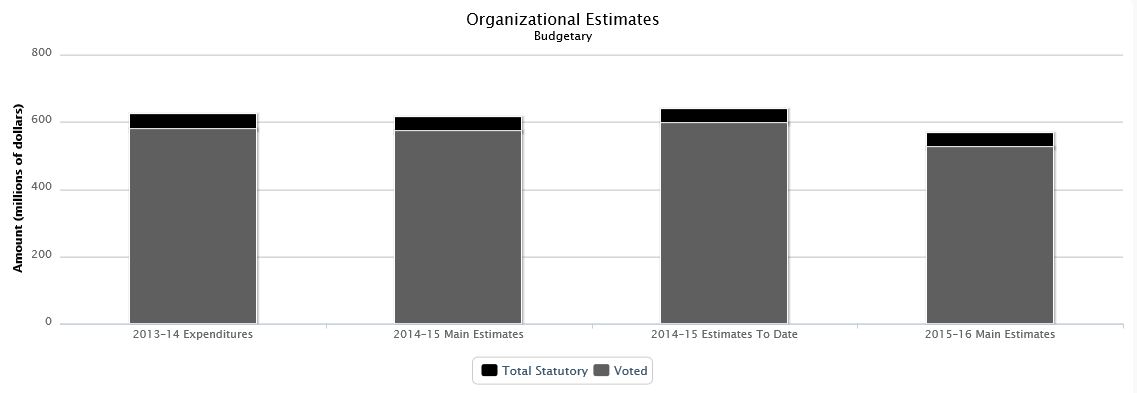
| 2013–14 Expenditures | 2014–15 Main Estimates | 2014–15 Estimates To Date | 2015–16 Main Estimates | ||
|---|---|---|---|---|---|
| Budgetary | |||||
| Voted | |||||
| 1 | Operating expenditures | 360,684,001 | 312,527,662 | 336,035,745 | 317,729,513 |
| 5 | Capital expenditures | 11,357,101 | 6,100,596 | 7,706,281 | 5,705,314 |
| 10 | Grants and contributions | 205,633,323 | 253,014,798 | 251,101,573 | 199,999,484 |
| Total voted | 577,674,425 | 571,643,056 | 594,843,599 | 523,434,311 | |
| Total Statutory | 43,823,211 | 43,053,629 | 43,218,454 | 43,718,110 | |
| Total budgetary | 621,497,636 | 614,696,685 | 638,062,053 | 567,152,421 | |
Highlights
The Agency is estimating budgetary expenditures of $567.2 million in 2015–16 which represents a decrease of $47.5 million from the 2014–15 Main Estimates of $614.7 million. Factors contributing to the net decrease include:
- A decrease of $49.7 million related to the sunsetting of funding received to make the final payment under the Hepatitis C Health Care Services Program to improve access to health care services to persons infected with hepatitis C through the blood system.
This decrease was offset by:
- An increase of $5.0 million of funding for Ebola preparedness and response initiative to protect Canadians at home and abroad.
Once tabled in the House of Commons, additional information will be available in the Agencyʼs Report on Plans and Priorities.
Expenditures by Strategic Outcome and Program
| 2013–14 Expenditures | 2014–15 Main Estimates | 2015–16 Main Estimates | |
|---|---|---|---|
| Protecting Canadians and empowering them to improve their health. | |||
| Health Promotion and Disease Prevention | 305,929,930 | 350,697,145 | 297,110,496 |
| Public Health Infrastructure | 132,987,799 | 118,150,146 | 114,621,598 |
| Health Security | 73,097,007 | 55,329,126 | 59,776,240 |
| The following program supports all strategic outcomes within this organization. | |||
| Internal Services | 109,482,900 | 90,520,268 | 95,644,087 |
| Total | 621,497,636 | 614,696,685 | 567,152,421 |
Listing of the 2015–16 Transfer Payments
| 2013–14 Expenditures | 2014–15 Main Estimates | 2015–16 Main Estimates | |
|---|---|---|---|
| Grants | |||
| Grants to individuals and organizations in support of health promotion projects in the areas of building community capacity, stimulating knowledge development and dissemination, and partnership building/intersectoral collaboration | 250,000 | 18,441,916 | 18,894,000 |
| Grant to eligible non-profit international organizations in support of their projects or programs on health | 2,293,472 | 2,530,000 | 2,530,000 |
| Grants to individuals and organizations in support of public health infrastructure | 0 | 0 | 1,484,000 |
| Grants to graduate students, post-graduate students and Canadian post–secondary institutions to increase professional capacity and training levels in order to build an effective public health sector | 0 | 240,000 | 240,000 |
| Contributions | |||
| Contributions to non-profit organizations to support, on a long-term basis, the development and provision of preventative and early intervention services aimed at addressing the health and developmental problems experienced by young children at risk in Canada | 84,750,452 | 82,088,000 | 82,088,000 |
| Contributions to individuals and organizations to support health promotion projects in the areas of building community capacity, stimulating knowledge development and dissemination, and partnership building/intersectoral collaboration | 44,286,691 | 34,948,352 | 33,724,242 |
| Contributions to incorporated local or regional non-profit Aboriginal organizations and institutions for the purpose of developing early intervention programs for Aboriginal pre-school children and their families | 32,666,837 | 32,134,000 | 29,134,000 |
| Contributions in support of the Federal Initiative on HIV/AIDS | 23,772,078 | 15,356,334 | 15,631,758 |
| Assessed contribution to the Pan-American Health Organization (PAHO) | 13,298,807 | 12,500,000 | 12,500,000 |
| Contributions to Canadian Blood Services and/or other designated transfusion/transplantation centres to support adverse event surveillance activities | 2,157,880 | 2,190,000 | 2,190,000 |
| Contributions to non-government organizations, corporations, other levels of government, post-secondary institutions and individuals to support development and creation of public health workforce development products and tools | 1,195,375 | 963,000 | 963,000 |
| Contributions to individuals and organizations in support of public health infrastructure | 961,731 | 1,923,196 | 620,484 |
Public Safety and Emergency Preparedness
Raison d'être
The Department of Public Safety and Emergency Preparedness (PSEP) plays a key role in discharging the Government's fundamental responsibility for the safety and security of its citizens. The Minister of PSEP is responsible for the Department. Legislation governing the Department sets out two essential roles: (i) support the Minister's responsibility for all matters, except those assigned to another federal minister, related to public safety and emergency management, including national leadership; and (ii) coordinate the efforts of Public Safety's Portfolio agencies, as well as provide guidance on their strategic priorities.
The Department provides strategic policy advice and support to the Minister of PSEP on a range of issues, including: national security, border strategies, countering crime and emergency management. The Department also delivers a number of grant and contribution programs related to emergency management, national security and community safety.
Additional information can be found in the Department's Report on Plans and Priorities.
Organizational Estimates
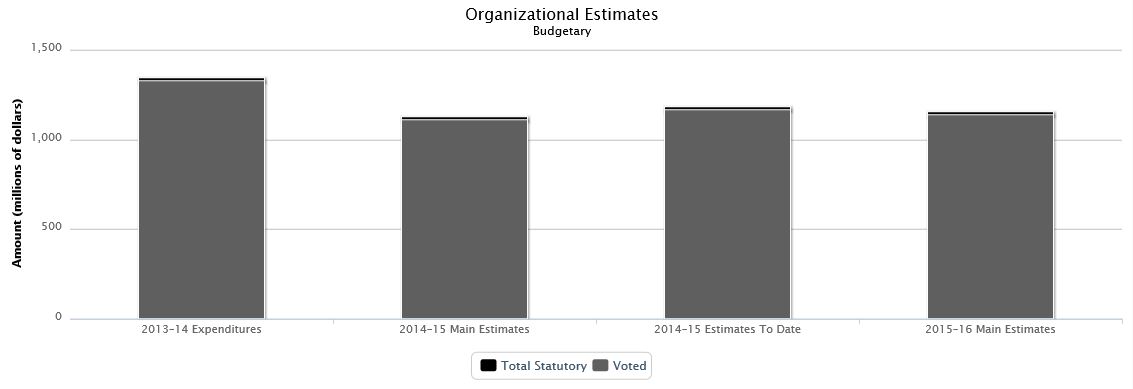
| 2013–14 Expenditures | 2014–15 Main Estimates | 2014–15 Estimates To Date | 2015–16 Main Estimates | ||
|---|---|---|---|---|---|
| Budgetary | |||||
| Voted | |||||
| 1 | Operating expenditures | 133,245,148 | 115,159,335 | 118,906,190 | 113,188,545 |
| 5 | Grants and contributions | 1,192,322,278 | 993,008,766 | 1,046,154,424 | 1,022,476,287 |
| Total voted | 1,325,567,426 | 1,108,168,101 | 1,165,060,614 | 1,135,664,832 | |
| Total Statutory | 15,682,817 | 14,600,255 | 14,600,255 | 14,771,419 | |
| Total budgetary | 1,341,250,243 | 1,122,768,356 | 1,179,660,869 | 1,150,436,251 | |
Highlights
PSEP is estimating budgetary expenditures of $1,150.4 million in 2015–16 which includes $14.8 million in statutory forecasts.
There is a minimal net spending increase of $27.7 million or 2.5% from previous Main Estimates which is the net result of various increases offset by certain planned decreases.
Major factors contributing to the net increase of $27.7 million include increases of:
- $86.4 million for the Disaster Financial Assistance Arrangements (DFAA) contribution program for non-discretionary requirements to address existing and future obligations under the DFAA. The program provides a consistent and equitable mechanism for federal sharing of provincial or territorial costs for natural disaster response and recovery where such costs would place an undue burden on a provincial or territorial economy; and
- $1.1 million for the First Nations Policing Program, the majority of which is to maintain funding for policing agreements with First Nation and Inuit communities.
These increases are partially offset by a decrease of $59.9 million as a result of time-limited programs (sunset programs) of which some are under review and may be renewed:
- To provide financial support to Provinces and Territories for the 2011 Flood Mitigation Investments ($51.0 million);
- Funding for contribution agreements with the provinces of Ontario and Quebec to support the Biology Casework Analysis ($6.9 million);
- Funding for concrete actions on missing and murdered aboriginal women ($1.3 million);
- Funding in support of Division 9 of the Immigration and Refugee Protection Act ($0.6 million); and
- Funding for the renewal of the National Counterfeit Enforcement Strategy ($0.1 million).
National Security
PSEP will continue to advance key national security policy issues such as pursuing work on priorities raised in the 2014 Annual Public Report on the Terrorist Threat to Canada. PSEP will work with partners towards consolidating and providing whole-of-government cyber threat information to help mitigate cyber risks and improve responses to cyber incidents.
Border Strategies
PSEP will continue to work with the U.S. and partners to advance the implementation of the remaining elements of the Canada-U.S. Perimeter Action Plan, Beyond the Border: A Shared Vision for Perimeter Security and Economic Competitiveness. PSEP will plan and assist the 2015 Canada-U.S. Cross-Border Crime Ministerial Forum.
Countering Crime
PSEP will continue to improve the efficiency and effectiveness of policing and public safety; and collaborate with the Royal Canadian Mounted Police (RCMP) on the coming into force of provisions from the Enhancing RCMP Accountability Act. It will also continue to advance the crime and safety agenda by working with government partners and stakeholders to combat human trafficking and child sexual exploitation, illicit drugs, contraband tobacco, First Nations organized crime, as well as economic and financial crime.
Emergency Management
PSEP will work with key stakeholders on the development of the National Disaster Mitigation Program and review the Disaster Financial Assistance Arrangements to ensure program sustainability. PSEP will continue to make progress addressing the operational needs of the Government Operations Centre's necessary infrastructure and response capability.
Internal Services
PSEP will continue to ensure sound stewardship of public funds through the refinement of its Financial Management Framework, improving and streamlining internal processes, the continued implementation of the Departmental Security Plan, sound business continuity planning and participation in the Federal Sustainable Development Strategy. PSEP will also continue efforts focused on its leadership and culture.
Additional information can be found in the PSEP's Report on Plans and Priorities.
Expenditures by Strategic Outcome and Program
| 2013–14 Expenditures | 2014–15 Main Estimates | 2015–16 Main Estimates | |
|---|---|---|---|
| A safe and resilient Canada. | |||
| Emergency Management | 1,085,379,860 | 838,995,532 | 874,644,725 |
| Countering Crime | 163,491,325 | 205,923,086 | 197,065,838 |
| National Security | 28,121,465 | 24,807,177 | 24,927,394 |
| Border Strategies | 4,651,452 | 3,694,890 | 4,211,070 |
| The following program supports all strategic outcomes within this organization. | |||
| Internal Services | 59,606,141 | 49,347,671 | 49,587,224 |
| Total | 1,341,250,243 | 1,122,768,356 | 1,150,436,251 |
Listing of the 2015–16 Transfer Payments
| 2013–14 Expenditures | 2014–15 Main Estimates | 2015–16 Main Estimates | |
|---|---|---|---|
| Grants | |||
| Grants in support of the Safer Communities Initiative | 468,700 | 1,960,000 | 1,960,000 |
| Other National Voluntary Organizations active in the criminal justice sector | 1,796,143 | 1,796,144 | 1,796,144 |
| Kanishka Project Research Initiative | 0 | 1,297,844 | 1,010,365 |
| Grants to provincial partners for the National Flagging System to identify and track high-risk violent offenders who jeopardize public safety | 499,913 | 500,000 | 500,000 |
| Cyber Security Cooperation Program | 0 | 150,000 | 150,000 |
| Contributions | |||
| Contributions to the provinces for assistance related to natural disasters | 1,018,988,056 | 762,000,000 | 848,385,000 |
| Payments to the provinces, territories, municipalities, Indian band councils and recognized authorities representing Indians on reserve, Indian communities on Crown land and Inuit communities, for the First Nations Policing Program | 86,732,870 | 121,611,662 | 122,721,662 |
| Contributions in support of the Safer Communities Initiative | 29,763,087 | 38,954,516 | 39,854,516 |
| Contribution Program to Combat Serious and Organized Crime | 0 | 2,551,000 | 2,551,000 |
| Contribution Program to Combat Child Sexual Exploitation and Human Trafficking | 2,161,000 | 2,035,600 | 2,035,600 |
| International Association of Fire Fighters, Canada | 420,000 | 500,000 | 500,000 |
| Kanishka Project Research Initiative | 2,687,858 | 800,000 | 500,000 |
| Payments to the provinces, territories, and public and private bodies in support of activities complementary to those of the Department of Public Safety and Emergency Preparedness | 361,321 | 362,000 | 362,000 |
| Cyber Security Cooperation Program | 0 | 150,000 | 150,000 |
Public Service Commission
Raison d'être
The Minister of Canadian Heritage and Official Languages is responsible for the Public Service Commission (PSC) for the purpose of the Financial Administration Act and to table the PSC Annual Report under the Public Service Employment Act (PSEA). The PSC reports independently on its mandate to Parliament.
The mandate of the PSC is to promote and safeguard merit-based appointments and, in collaboration with other stakeholders, to protect the non-partisan nature of the public service. Under the delegated staffing system set out in the PSEA, the PSC fulfills its mandate by providing policy guidance and expertise, as well as by conducting effective oversight. In addition, the PSC delivers innovative staffing and assessment services.
Additional information can be found in the PSC's Annual Report.
Organizational Estimates
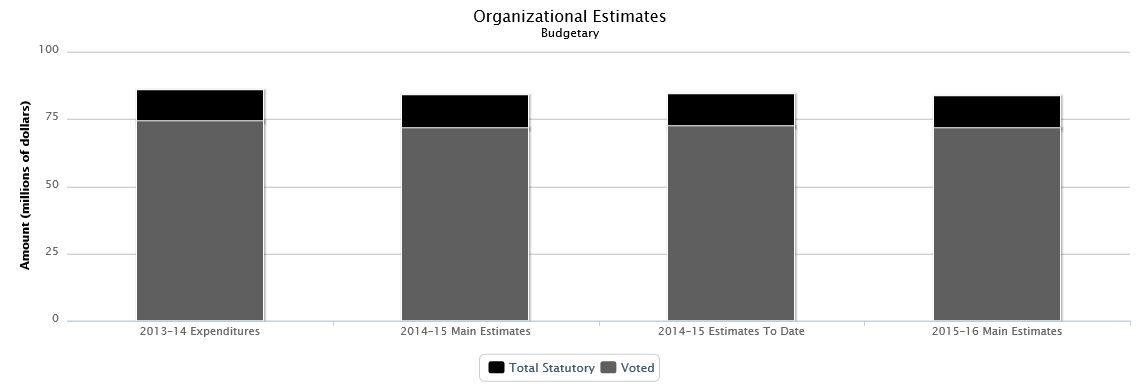
| 2013–14 Expenditures | 2014–15 Main Estimates | 2014–15 Estimates To Date | 2015–16 Main Estimates | ||
|---|---|---|---|---|---|
| Budgetary | |||||
| Voted | |||||
| 1 | Program expenditures | 73,980,568 | 71,676,677 | 72,180,678 | 71,397,504 |
| Total voted | 73,980,568 | 71,676,677 | 72,180,678 | 71,397,504 | |
| Total Statutory | 11,586,697 | 12,016,810 | 12,016,810 | 12,203,512 | |
| Total budgetary | 85,567,265 | 83,693,487 | 84,197,488 | 83,601,016 | |
Highlights
The PSC is estimating budgetary expenditures of $83.6 million in 2015–16 which is similar to the previous year. Of this amount, $71.4million requires approval by Parliament. The remaining $12.2 million represents statutory forecasts that do not require additional approval and are provided for information purposes only.
For 2015–16, the PSC's resources will be dedicated to achieve the following priorities:
- To provide independent oversight on the health of the staffing system and protect merit-based staffing and the non-partisan nature of the public service;
- To implement enhancements to the PSC's policy and oversight functions to ensure they are well integrated and serve to improve staffing across the public service; and
- To offer support and expertise in staffing and assessment to delegated organizations and stakeholders.
For further details please refer to the PSC's Report on Plans and Priorities, available on its website – http://www.psc-cfp.gc.ca.
Expenditures by Strategic Outcome and Program
| 2013–14 Expenditures | 2014–15 Main Estimates | 2015–16 Main Estimates | |
|---|---|---|---|
| A highly competent, non-partisan and representative public service, able to provide service in both official languages, in which appointments are based on merit and the values of fairness, access, representativeness and transparency. | |||
| Staffing Services and Assessment | 21,763,483 | 22,626,987 | 23,214,547 |
| Oversight of Integrity in Staffing and of Non-Partisanship | 16,955,912 | 16,972,232 | 18,847,474 |
| Staffing System Integrity and Political Impartiality | 15,951,135 | 16,033,630 | 16,045,990 |
| The following program supports all strategic outcomes within this organization. | |||
| Internal Services | 30,896,735 | 28,060,638 | 25,493,005 |
| Total | 85,567,265 | 83,693,487 | 83,601,016 |
Public Service Labour Relations Board
Raison d'être
Pursuant to the Public Service Labour Relations and Employment Board Act, the Public Service Labour Relations Board was merged with the Public Service Staffing Tribunal into the Public Service Labour Relations and Employment Board, and pursuant to the Administrative Tribunals Support Service of Canada Act, the Public Service Labour Relations and Employment Board was amalgamated to the Administrative Tribunals Support Service of Canada, effective .
Organizational Estimates
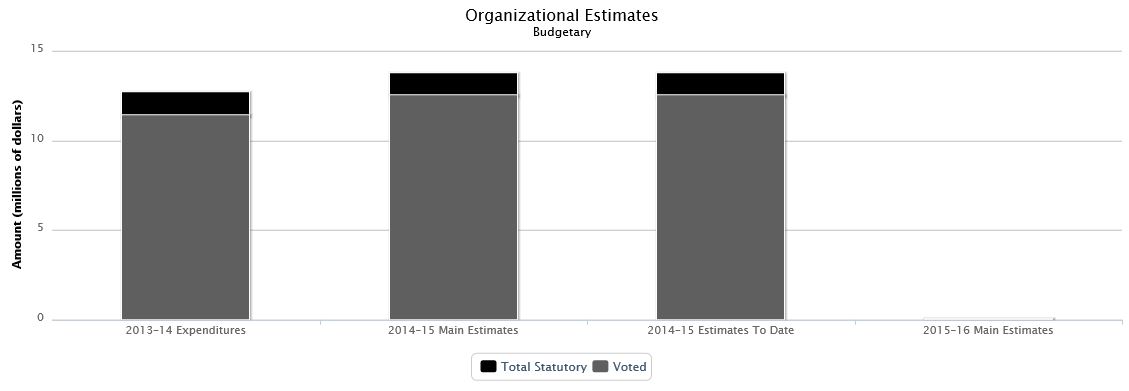
| 2013–14 Expenditures | 2014–15 Main Estimates | 2014–15 Estimates To Date | 2015–16 Main Estimates | ||
|---|---|---|---|---|---|
| Budgetary | |||||
| Voted | |||||
| - | Program expenditures | 11,398,804 | 12,501,779 | 12,501,779 | 0 |
| Total voted | 11,398,804 | 12,501,779 | 12,501,779 | 0 | |
| Total Statutory | 1,307,144 | 1,243,633 | 1,243,633 | 0 | |
| Total budgetary | 12,705,948 | 13,745,412 | 13,745,412 | 0 | |
Highlights
Not applicable
Expenditures by Strategic Outcome and Program
| 2013–14 Expenditures | 2014–15 Main Estimates | 2015–16 Main Estimates | |
|---|---|---|---|
| Resolution of labour relations issues in the federal public service and in Parliament in an impartial manner. | |||
| Adjudication, mediation and compensation analysis and research | 9,080,117 | 9,896,701 | 0 |
| The following program supports all strategic outcomes within this organization. | |||
| Internal Services | 3,625,831 | 3,848,711 | 0 |
| Total | 12,705,948 | 13,745,412 | 0 |
Public Service Staffing Tribunal
Raison d'être
Pursuant to the Public Service Labour Relations and Employment Board Act, the Public Service Staffing Tribunal was merged with the Public Service Labour Relations Board into the Public Service Labour Relations and Employment Board, and pursuant to the Administrative Tribunals Support Service of Canada Act, the Public Service Labour Relations and Employment Board was amalgamated to the Administrative Tribunals Support Service of Canada, effective .
Organizational Estimates

| 2013–14 Expenditures | 2014–15 Main Estimates | 2014–15 Estimates To Date | 2015–16 Main Estimates | ||
|---|---|---|---|---|---|
| Budgetary | |||||
| Voted | |||||
| - | Program expenditures | 4,236,419 | 4,891,908 | 4,891,908 | 0 |
| Total voted | 4,236,419 | 4,891,908 | 4,891,908 | 0 | |
| Total Statutory | 532,271 | 589,208 | 589,208 | 0 | |
| Total budgetary | 4,768,690 | 5,481,116 | 5,481,116 | 0 | |
Highlights
Not applicable
Expenditures by Strategic Outcome and Program
| 2013–14 Expenditures | 2014–15 Main Estimates | 2015–16 Main Estimates | |
|---|---|---|---|
| Fair and impartial resolution of disputes related to internal appointments and lay-offs in the federal public service. | |||
| Adjudication and mediation of complaints filed under the Public Service Employment Act | 3,680,159 | 4,003,475 | 0 |
| The following program supports all strategic outcomes within this organization. | |||
| Internal Services | 1,088,531 | 1,477,641 | 0 |
| Total | 4,768,690 | 5,481,116 | 0 |
Public Works and Government Services
Raison d'être
Public Works and Government Services Canada (PWGSC) plays an important role in the daily operations of the Government of Canada as a key provider of services for federal departments and agencies. It supports them in the achievement of their mandated objectives as their central purchasing agent, linguistic authority, real property manager, treasurer, accountant, integrity adviser, and pay and pension administrator.
PWGSC's vision is to excel in government operations, and our strategic outcome and mission is to deliver high-quality, central programs and services that ensure sound stewardship on behalf of Canadians and meet the program needs of federal institutions.
Organizational Estimates
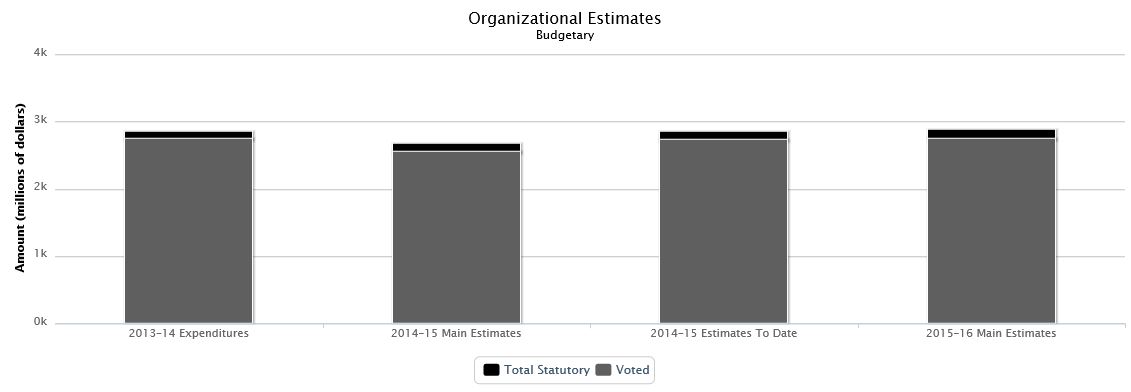

| 2013–14 Expenditures | 2014–15 Main Estimates | 2014–15 Estimates To Date | 2015–16 Main Estimates | ||
|---|---|---|---|---|---|
| Budgetary | |||||
| Voted | |||||
| 1 | Operating expenditures | 2,085,289,360 | 1,786,071,771 | 1,628,377,440 | 1,651,054,220 |
| 5 | Capital expenditures | 654,842,004 | 759,963,628 | 1,094,462,483 | 1,099,063,968 |
| Total voted | 2,740,131,364 | 2,546,035,399 | 2,722,839,923 | 2,750,118,188 | |
| Total Statutory | 106,992,770 | 118,088,514 | 118,088,514 | 121,407,408 | |
| Total budgetary | 2,847,124,134 | 2,664,123,913 | 2,840,928,437 | 2,871,525,596 | |
| Non-budgetary | |||||
| Voted | |||||
| - | Imprest funds, accountable advances and recoverable advances. Limit $22,000,000 (Net) | (28,086) | 0 | 0 | 0 |
| Total voted | (28,086) | 0 | 0 | 0 | |
| Total Statutory | (35,589) | 0 | 0 | 0 | |
| Total non-budgetary | (63,675) | 0 | 0 | 0 | |
Highlights
PWGSC is estimating budgetary expenditures of $2.9 billion in 2015–16. Of this amount, $2.8 billion requires approval by Parliament. The remaining $121.4 million represents statutory forecasts that do not require additional approval and are provided for information purposes.
An increase in spending of $30.6million from $2.8billion of Estimates to Date in fiscal year 2014–15 to $2.9billion in 2015–16 Main Estimates is due primarily to the following:
Long Term Vision and Plan
- An increase of $57.5 million to cover the planned program of work to be undertaken for the rehabilitation of the Parliament Buildings.
Cape Breton Operations
- An increase of $34.2 million in funding mainly due to the transfer to PWGSC of former Enterprise Cape Breton Corporation activities as per the Budget Implementation Act, 2014.
PWGSC Reductions (Deficit Reduction Action Plan)
- A decrease of $28.8 million in funding due to savings identified as part of the Budget 2012 spending review generated from operating efficiencies and improving productivity.
Engineering Assets
- A decrease of $18.2 million is the result of the continued completion of projects under the phase II of the Engineering Assets portfolios to repair and rehabilitate major federal assets; notably, bridges and crossings.
Pay Modernization
- A decrease of $10.3 million is due to the completion of the planned activities for the Pay Modernization Project.
Accommodation and Real Property Services program administers the statutory grant, "Payments in lieu of taxes to municipalities and other taxing authorities", which amounts to $581.2 million and is recovered by PWGSC from custodian departments.
Expenditures by Strategic Outcome and Program
| 2013–14 Expenditures | 2014–15 Main Estimates | 2015–16 Main Estimates | |
|---|---|---|---|
| High quality, central programs and services that ensure sound stewardship on behalf of Canadians and meet the program needs of federal institutions. | |||
| Accommodation and Real Property Services | 2,111,237,753 | 1,966,139,279 | 2,175,548,102 |
| Acquisitions | 152,781,604 | 152,864,600 | 151,339,610 |
| Federal Pay and Pension Administration | 101,211,263 | 118,212,847 | 114,163,435 |
| Receiver General for Canada | 120,686,479 | 101,056,015 | 99,157,873 |
| Linguistic Management and Services | 61,627,911 | 68,100,297 | 60,913,368 |
| Specialized Programs and Services | 56,443,732 | 32,606,961 | 29,617,191 |
| Integrity Programs and Services | 0 | 19,913,717 | 15,505,622 |
| Procurement Ombudsman | 4,075,023 | 4,103,650 | 4,111,325 |
| The following program supports all strategic outcomes within this organization. | |||
| Internal Services | 239,060,369 | 201,126,547 | 221,169,070 |
| Funds not allocated to the 2015–16 Program Alignment Architecture | 0 | 0 | 0 |
| Total | 2,847,124,134 | 2,664,123,913 | 2,871,525,596 |
| 2013–14 Expenditures | 2014–15 Main Estimates | 2015–16 Main Estimates | |
|---|---|---|---|
| Funds not allocated to the 2015–16 Program Alignment Architecture | (63,675) | 0 | 0 |
| Total | (63,675) | 0 | 0 |
Registry of the Competition Tribunal
Raison d'être
Pursuant to the Administrative Tribunals Support Service of Canada Act, the Registry of the Competition Tribunal was amalgamated to the Administrative Tribunals Support Service of Canada, effective .
Organizational Estimates
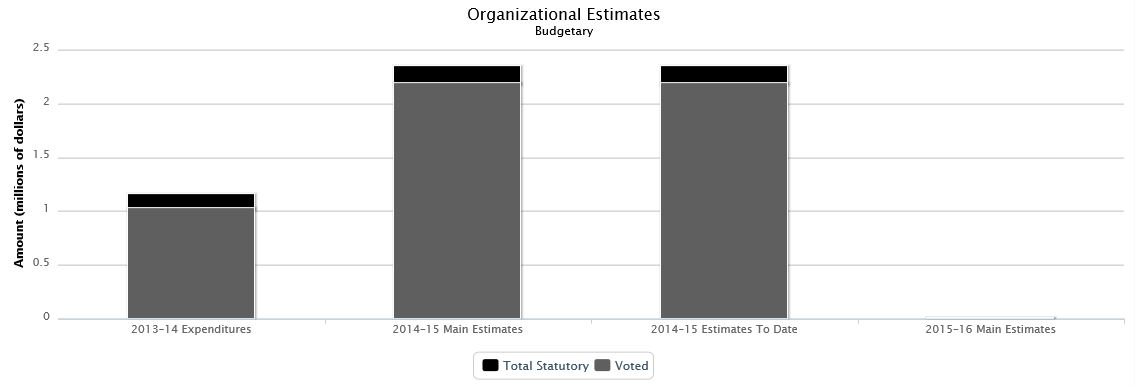
| 2013–14 Expenditures | 2014–15 Main Estimates | 2014–15 Estimates To Date | 2015–16 Main Estimates | ||
|---|---|---|---|---|---|
| Budgetary | |||||
| Voted | |||||
| - | Program expenditures | 1,028,926 | 2,186,169 | 2,186,169 | 0 |
| Total voted | 1,028,926 | 2,186,169 | 2,186,169 | 0 | |
| Total Statutory | 126,497 | 159,137 | 159,137 | 0 | |
| Total budgetary | 1,155,423 | 2,345,306 | 2,345,306 | 0 | |
Highlights
Not applicable
Expenditures by Strategic Outcome and Program
| 2013–14 Expenditures | 2014–15 Main Estimates | 2015–16 Main Estimates | |
|---|---|---|---|
| Open, fair, transparent and expeditious hearings related to the Tribunal's jurisdiction. | |||
| Process Cases | 848,462 | 1,758,980 | 0 |
| The following program supports all strategic outcomes within this organization. | |||
| Internal Services | 306,961 | 586,326 | 0 |
| Total | 1,155,423 | 2,345,306 | 0 |
Registry of the Public Servants Disclosure Protection Tribunal
Raison d'être
Pursuant to the Administrative Tribunals Support Service of Canada Act, the Registry of the Public Servant Disclosure Protection Tribunal was amalgamated to the Administrative Tribunals Support Service of Canada, effective .
Organizational Estimates
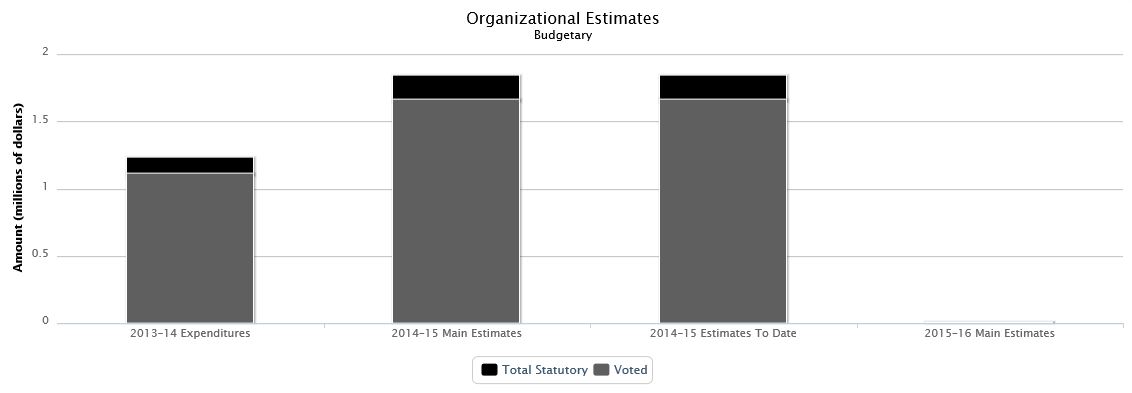
| 2013–14 Expenditures | 2014–15 Main Estimates | 2014–15 Estimates To Date | 2015–16 Main Estimates | ||
|---|---|---|---|---|---|
| Budgetary | |||||
| Voted | |||||
| - | Program expenditures | 1,111,720 | 1,664,105 | 1,664,105 | 0 |
| Total voted | 1,111,720 | 1,664,105 | 1,664,105 | 0 | |
| Total Statutory | 117,642 | 181,517 | 181,517 | 0 | |
| Total budgetary | 1,229,362 | 1,845,622 | 1,845,622 | 0 | |
Highlights
Not applicable
Expenditures by Strategic Outcome and Program
| 2013–14 Expenditures | 2014–15 Main Estimates | 2015–16 Main Estimates | |
|---|---|---|---|
| Remedial and disciplinary actions that ensure complainants to the Office of the Public Sector Integrity Commissioner are protected against reprisals. | |||
| Reprisal Hearings Program | 1,229,362 | 1,845,622 | 0 |
| Total | 1,229,362 | 1,845,622 | 0 |
Registry of the Specific Claims Tribunal
Raison d'être
Pursuant to the Administrative Tribunals Support Service of Canada Act, the Registry of the Specific Claims Tribunal was amalgamated to the Administrative Tribunals Support Service of Canada, effective .
Organizational Estimates

| 2013–14 Expenditures | 2014–15 Main Estimates | 2014–15 Estimates To Date | 2015–16 Main Estimates | ||
|---|---|---|---|---|---|
| Budgetary | |||||
| Voted | |||||
| - | Program expenditures | 1,981,845 | 2,728,608 | 2,728,608 | 0 |
| Total voted | 1,981,845 | 2,728,608 | 2,728,608 | 0 | |
| Total Statutory | 159,591 | 168,917 | 168,917 | 0 | |
| Total budgetary | 2,141,436 | 2,897,525 | 2,897,525 | 0 | |
Highlights
Not applicable
Expenditures by Strategic Outcome and Program
| 2013–14 Expenditures | 2014–15 Main Estimates | 2015–16 Main Estimates | |
|---|---|---|---|
| Efficient administration of the Specific Claims Tribunal. | |||
| Registry Services | 1,555,970 | 2,318,020 | 0 |
| The following program supports all strategic outcomes within this organization. | |||
| Internal Services | 585,466 | 579,505 | 0 |
| Total | 2,141,436 | 2,897,525 | 0 |
Royal Canadian Mounted Police
Raison d'être
The Minister of Public Safety and Emergency Preparedness is responsible for this organization.
As Canada's national police service, the Royal Canadian Mounted Police (RCMP) is a critical element of the Government of Canada's commitment to providing for the safety and security of Canadians. By tackling crime at the municipal, provincial/territorial, federal and international levels, the RCMP provides integrated approaches to safety and security and a consistent federal role and presence from coast to coast to coast.
The RCMP's mandate, as outlined in section 18 of the Royal Canadian Mounted Police Act, is multi-faceted. It includes preventing and investigating crime; maintaining peace and order; enforcing laws; contributing to national security; ensuring the safety of state officials, visiting dignitaries and foreign missions; and providing vital operational support services to other police and law enforcement agencies within Canada and abroad.
Organizational Estimates
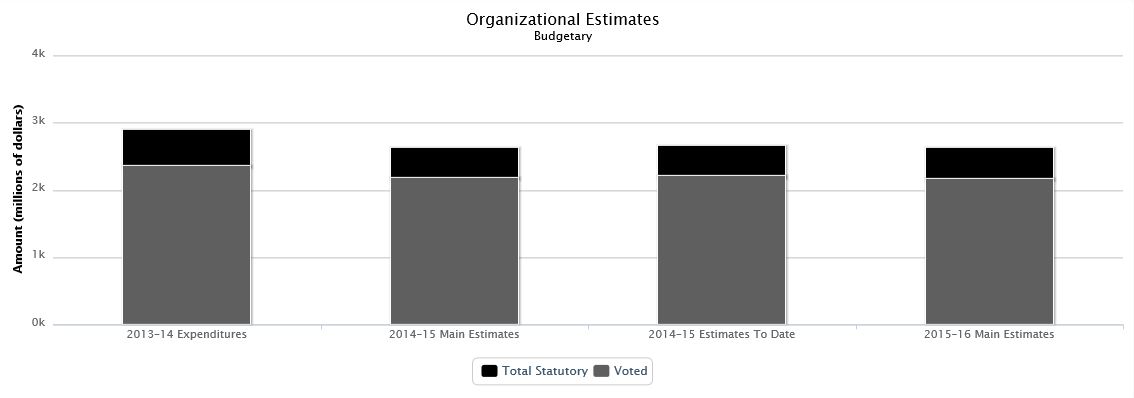
| 2013–14 Expenditures | 2014–15 Main Estimates | 2014–15 Estimates To Date | 2015–16 Main Estimates | ||
|---|---|---|---|---|---|
| Budgetary | |||||
| Voted | |||||
| 1 | Operating expenditures | 1,981,451,541 | 1,766,280,232 | 1,778,516,622 | 1,726,192,674 |
| 5 | Capital expenditures | 220,101,586 | 246,469,709 | 255,150,967 | 261,996,018 |
| 10 | Grants and contributions | 150,151,242 | 163,636,131 | 166,457,517 | 180,351,933 |
| Total voted | 2,351,704,369 | 2,176,386,072 | 2,200,125,106 | 2,168,540,625 | |
| Total Statutory | 540,676,327 | 449,590,271 | 451,884,712 | 461,517,071 | |
| Total budgetary | 2,892,380,696 | 2,625,976,343 | 2,652,009,818 | 2,630,057,696 | |
Highlights
The RCMP is estimating budgetary expenditures of $2.6 billion in 2015–16. Of this $2.2 billion requires approval by Parliament. The remaining $0.4 billion represents statutory forecasts that do not require additional approval and are provided for information purposes.
The 2015–16 Main Estimates represents a $4.1 million increase or 0.2% from the federal appropriations requested in the 2014–15 Main Estimates. The request is comprised of a decrease of $40.1 million for operating costs, which is offset by increases of $15.5 million in capital costs, $11.9 million in statutory programs, and $16.7 million for grants and contributions funding requirements.
Some of the noteworthy factors contributing to the changes in year-over-year funding levels include:
- A transfer to Shared Services Canada of $39.7 million as a result of the creation of Shared Services Canada. The RCMP transferred $135.9 million of its voted appropriations to fund the information technology services to be provided by the organization in 2012–13. In 2015–16, the RCMP is transferring an additional $39.7 million for a total ongoing transfer of $175.6 million;
- The RCMP had previously transferred funding to Public Works and Government Services Canada for the creation of new office spaces to replace the existing RCMP headquarters facility in British Columbia. This included a one-time transfer of capital funding related to fit-up and special purpose space which ended in 2014–15, therefore $11 million is being reinstated to the RCMP's base capital budget;
- The Grant to compensate members injured in the performance of their duties has increased by $17.9 million resulting from an increase in the number of members receiving disability pension awards and the annual increases due to indexation of disability pension benefits;
- Budget 2012 provided funding for the implementation of integrated cross-border law enforcement commitments under the Beyond the Border Action Plan. The 2015–16 Main Estimates includes an increase of $9.5 million to existing funding levels in support of this initiative; and,
- In accordance with the Enhancing RCMP Accountability Act, an increase of $8.7 million in funding has been approved to implement modernized HR management processes, including the creation of a new occupational group.
The spending authorities in the 2015–16 Main Estimates are integral to achieving the RCMP's plans and priorities. Further details can be obtained from the RCMP's 2015–16 Report on Plans and Priorities.
Expenditures by Strategic Outcome and Program
| 2013–14 Expenditures | 2014–15 Main Estimates | 2015–16 Main Estimates | |
|---|---|---|---|
| Criminal activity affecting Canadians is reduced. | |||
| Police Operations | 1,761,000,036 | 1,531,403,670 | 1,585,420,286 |
| Canadian Law Enforcement Services | 241,130,536 | 241,141,544 | 177,934,590 |
| Incomes are secure for RCMP members and their survivors affected by disability or death. | |||
| Transfer Payments | 147,142,744 | 159,849,131 | 177,864,933 |
| Canada's police provide international collaboration and assistance while maintaining a rich police heritage nationally. | |||
| International Policing Operations | 53,068,140 | 54,882,026 | 52,395,181 |
| Canadian Police Culture and Heritage | 13,359,752 | 10,842,331 | 10,929,545 |
| The following program supports all strategic outcomes within this organization. | |||
| Internal Services | 676,679,488 | 627,857,641 | 625,513,161 |
| Total | 2,892,380,696 | 2,625,976,343 | 2,630,057,696 |
Listing of the 2015–16 Transfer Payments
| 2013–14 Expenditures | 2014–15 Main Estimates | 2015–16 Main Estimates | |
|---|---|---|---|
| Grants | |||
| To compensate members of the Royal Canadian Mounted Police for injuries received in the performance of duty (R.S.C., 1985, c. R-11) | 132,140,008 | 144,500,000 | 162,400,000 |
| RCMP Survivor Income Plan | 2,686,991 | 2,349,131 | 2,464,933 |
| Grant to Promote Law Enforcement through Crime Prevention, Training and Public Relations | 838,797 | 1,000,000 | 1,000,000 |
| Total Statutory | 12,315,745 | 13,000,000 | 13,000,000 |
| Contributions | |||
| Contributions to the provinces and territories and to aboriginal and/or other communities and organizations (not for profit) | 14,485,446 | 15,787,000 | 14,487,000 |
Royal Canadian Mounted Police External Review Committee
Raison d'être
The Royal Canadian Mounted Police External Review Committee (ERC) is an independent and impartial administrative tribunal that contributes to fair and equitable labour relations within the Royal Canadian Mounted Police (RCMP). To this end, the ERC conducts an independent review of appeals relating to certain conduct measures, and of written decisions involving harassment complaints, revocations of appointments, discharges and demotions, and ordered stoppages of pay and allowances, that are referred to it pursuant to section 33 and subsection 45.15 of the Royal Canadian Mounted Police Act and section 17 of the Royal Canadian Mounted Police Regulations.
Organizational Estimates
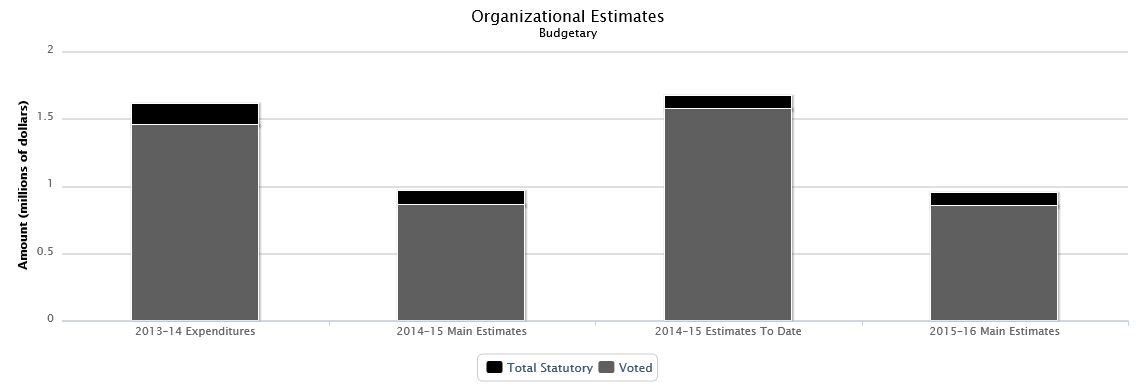
| 2013–14 Expenditures | 2014–15 Main Estimates | 2014–15 Estimates To Date | 2015–16 Main Estimates | ||
|---|---|---|---|---|---|
| Budgetary | |||||
| Voted | |||||
| 1 | Program expenditures | 1,445,271 | 858,554 | 1,568,555 | 848,114 |
| Total voted | 1,445,271 | 858,554 | 1,568,555 | 848,114 | |
| Total Statutory | 160,657 | 102,864 | 102,864 | 104,734 | |
| Total budgetary | 1,605,928 | 961,418 | 1,671,419 | 952,848 | |
Highlights
The ERC is estimating budgetary expenditures of $952.8 thousand in 2015–16. Of this amount, $848.1 thousand requires approval by Parliament. The remaining $104.7 thousand represents statutory forecasts that do not require additional approval and are provided for information purposes.
A net decrease of $8.5 thousand in planned spending from the 2014–15 Main Estimates is due to the reductions for government-wide initiatives and a small increase in statutory forecasts.
Additional information can be found in the ERC's Report on Plans and Priorities.
Expenditures by Strategic Outcome and Program
| 2013–14 Expenditures | 2014–15 Main Estimates | 2015–16 Main Estimates | |
|---|---|---|---|
| Independent, impartial and thorough analysis, findings and recommendations for transparency in Royal Canadian Mounted Police (RCMP) grievances and appeals. | |||
| Independent and impartial case review | 1,605,928 | 961,418 | 952,848 |
| Total | 1,605,928 | 961,418 | 952,848 |
Security Intelligence Review Committee
Raison d'être
The Security Intelligence Review Committee (SIRC) is an independent, external review body which reports to Parliament of Canada on the operations of the Canadian Security Intelligence Service (CSIS). The Prime Minister is responsible for this organization.
Parliament has given CSIS powers to enhance the security of Canadians. SIRC ensures that these powers are used in accordance with the rule of law and appropriately, in order to protect Canadiansʼ rights and freedoms. To do this, SIRC examines past operations of the Service and investigates complaints. It has absolute authority to examine all information concerning CSIS activities, no matter how sensitive and highly classified that information may be. The result of this work, edited to protect national security and personal privacy, are summarized in its Annual Report to Parliament.
Organizational Estimates
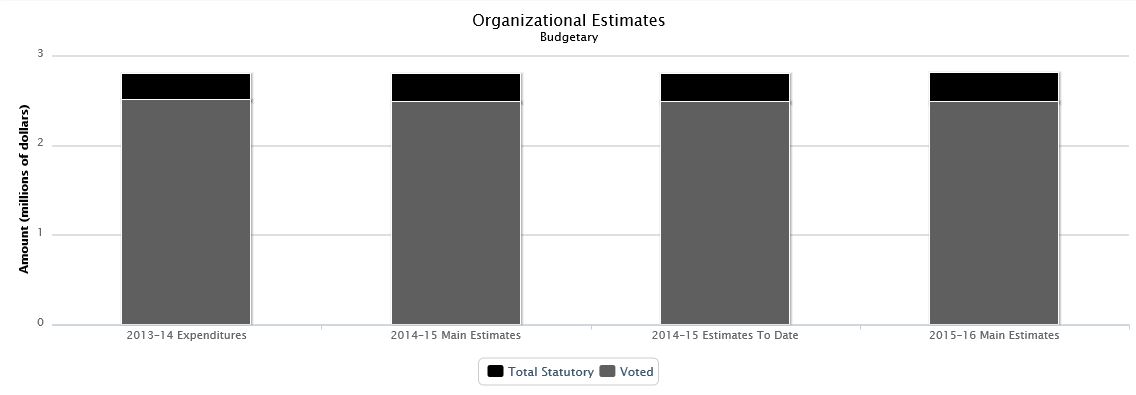
| 2013–14 Expenditures | 2014–15 Main Estimates | 2014–15 Estimates To Date | 2015–16 Main Estimates | ||
|---|---|---|---|---|---|
| Budgetary | |||||
| Voted | |||||
| 1 | Program expenditures | 2,496,497 | 2,477,760 | 2,477,760 | 2,479,321 |
| Total voted | 2,496,497 | 2,477,760 | 2,477,760 | 2,479,321 | |
| Total Statutory | 286,024 | 309,039 | 309,039 | 317,047 | |
| Total budgetary | 2,782,521 | 2,786,799 | 2,786,799 | 2,796,368 | |
Highlights
SIRC is estimating budgetary expenditures of $2.8 million in 2015–16. Of this amount, $2.5 million requires approval by Parliament. The remaining $0.3 million represents statutory forecasts that do not require additional approval and are provided for information purposes.
SIRC's work is designed to provide expert advice to policymakers and lawmakers on CSIS's performance. It also serves to reassure Canadians that CSIS investigates threats to national security in a manner that respects Canada's core democratic values. The Canadian Security Intelligence Service Act (CSIS Act) continues to guide SIRC's work in assessing CSIS's performance against the mandate and authorities conferred upon it by Parliament.
For additional details, please see SIRC's 2015–16 Report on Plans and Priorities.
Expenditures by Strategic Outcome and Program
| 2013–14 Expenditures | 2014–15 Main Estimates | 2015–16 Main Estimates | |
|---|---|---|---|
| Canadian Security Intelligence Service (CSIS) performs its duties and functions in accordance with the law, policy and Ministerial direction. | |||
| Reviews | 1,181,764 | 1,362,186 | 1,325,417 |
| Investigations | 652,793 | 682,873 | 771,306 |
| The following program supports all strategic outcomes within this organization. | |||
| Internal Services | 947,964 | 741,740 | 699,645 |
| Total | 2,782,521 | 2,786,799 | 2,796,368 |
Senate Ethics Officer
Raison d'être
The main responsibilities of the Senate Ethics Officer are to:
- Advise individual senators on a confidential and ongoing basis concerning their obligations under The Ethics and Conflict of Interest Code for Senators and to assist them in remaining in compliance with the requirements of the Code;
- Oversee the ongoing annual disclosure process in which senators are required to disclose their financial and other interests;
- Conduct inquiries in order to determine whether a senator has complied with his or her obligations under the Code;
- Maintain a registry, available to the public, containing information concerning the financial and other interests of senators that are required to be publicly disclosed under the Code; and
- Submit an annual report of the Office's activities to the Speaker of the Senate for tabling in the Senate.
Organizational Estimates
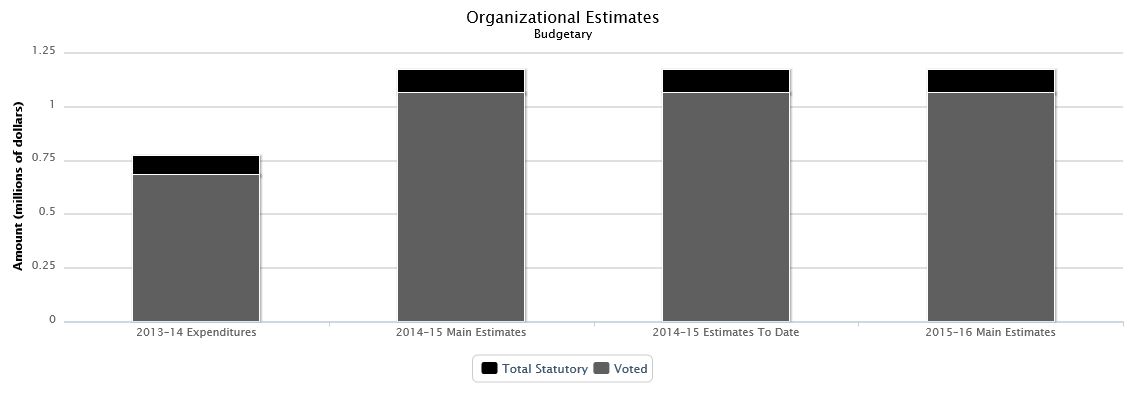
| 2013–14 Expenditures | 2014–15 Main Estimates | 2014–15 Estimates To Date | 2015–16 Main Estimates | ||
|---|---|---|---|---|---|
| Budgetary | |||||
| Voted | |||||
| 1 | Program expenditures | 675,099 | 1,059,500 | 1,059,500 | 1,059,500 |
| Total voted | 675,099 | 1,059,500 | 1,059,500 | 1,059,500 | |
| Total Statutory | 90,819 | 107,250 | 107,250 | 109,200 | |
| Total budgetary | 765,918 | 1,166,750 | 1,166,750 | 1,168,700 | |
Highlights
Senate Ethics Officer is estimating budgetary expenditures of $1.169 million in 2015–16. Of this amount, $1.060 million requires approval by Parliament. The remaining $109 thousand represents statutory forecasts that do not require additional approval and are provided for information purposes.
Expenditures by Strategic Outcome and Program
| 2013–14 Expenditures | 2014–15 Main Estimates | 2015–16 Main Estimates | |
|---|---|---|---|
| Senators meet their obligations under The Ethics and Conflict of Interest Code for Senators in a manner that contributes to the integrity of the Senate as an institution. | |||
| Administration | 765,918 | 1,166,750 | 1,168,700 |
| Total | 765,918 | 1,166,750 | 1,168,700 |
Shared Services Canada
Raison d'être
Shared Services Canada (SSC) was created on , to transform how the Government of Canada manages its information technology (IT) infrastructure. SSC is delivering mandated email, data centre and network services to partner organizations in a consolidated and standardized manner to support the delivery of Government of Canada programs and services. With a whole-of-government approach to IT infrastructure services, SSC is creating economies of scale to deliver more efficient, reliable and secure IT infrastructure services to the Government of Canada departments. SSC also provides certain optional technology-related services to government organizations on a cost-recovery basis.
The Minister of Public Works and Government Services is responsible for this organization.
Organizational Estimates
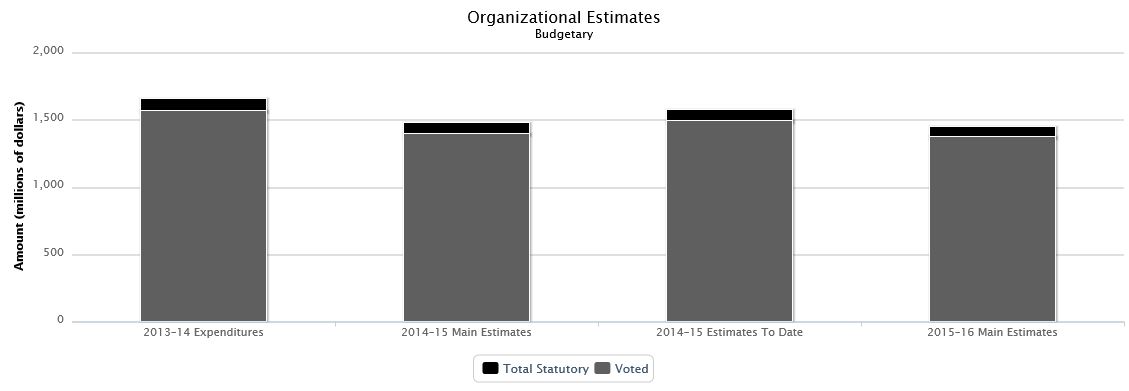
| 2013–14 Expenditures | 2014–15 Main Estimates | 2014–15 Estimates To Date | 2015–16 Main Estimates | ||
|---|---|---|---|---|---|
| Budgetary | |||||
| Voted | |||||
| 1 | Operating expenditures | 1,363,797,879 | 1,176,098,834 | 1,229,953,549 | 1,169,183,901 |
| 5 | Capital expenditures | 198,876,713 | 216,592,917 | 261,212,835 | 203,868,605 |
| Total voted | 1,562,674,592 | 1,392,691,751 | 1,491,166,384 | 1,373,052,506 | |
| Total Statutory | 90,563,213 | 80,631,826 | 80,673,260 | 70,991,519 | |
| Total budgetary | 1,653,237,805 | 1,473,323,577 | 1,571,839,644 | 1,444,044,025 | |
Highlights
SSC is estimating budgetary expenditures of $1.44 billion in 2015–16. Of this amount, $1.37 billion requires approval by Parliament. The remaining $71 million represents statutory forecasts that do not require additional approval and are provided for information purposes.
Compared to the 2014–15 Main Estimates, the 2015–16 Main Estimates have decreased by $29.3 million. This variance is mainly attributed to:
- A decrease of $49.9 million for the savings related to the Email Transformation Initiative; and
- An increase of $11.8 million to support the partnering organizationsʼ projects and initiatives, such as 2016 Census of Population and the Revitalization of Canadaʼs Weather Services.
SSC will continue to modernize Canadaʼs IT infrastructure, including email, data centres and networks, across partner departments and agencies and it will continue to generate savings for Canadians as it carries out this mandate.
For additional information, please see the department's 2015–16 Report on Plans and Priorities.
Expenditures by Strategic Outcome and Program
| 2013–14 Expenditures | 2014–15 Main Estimates | 2015–16 Main Estimates | |
|---|---|---|---|
| Modern, reliable, secure and cost-effective information technology infrastructure services to support government priorities and program delivery. | |||
| Information Technology Infrastructure Services | 1,509,268,650 | 1,288,659,177 | 1,284,972,140 |
| The following program supports all strategic outcomes within this organization. | |||
| Internal Services | 143,969,155 | 184,664,400 | 159,071,885 |
| Total | 1,653,237,805 | 1,473,323,577 | 1,444,044,025 |
Social Sciences and Humanities Research Council
Raison d'être
The Minister of Industry is responsible for this organization.
The Social Sciences and Humanities Research Council (SSHRC) funds research and research training that builds knowledge about people, past and present, with a view toward creating a better future. From questions of family and culture to concerns about jobs and employment, research about people – how we live, what we think, how we act – informs new knowledge and insights on the issues that matter most to Canadians.
SSHRC plays a unique role within Canada's science, technology and innovation system by awarding grants and scholarships to researchers, students and fellows who work as individuals, in small groups and in formal partnerships to develop talent, generate insights and build connections that address the needs of all sectors of society.
Organizational Estimates
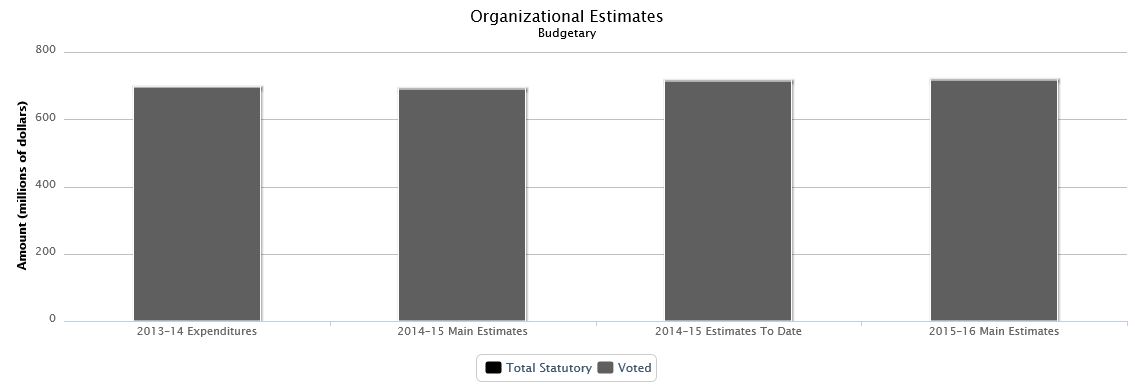
| 2013–14 Expenditures | 2014–15 Main Estimates | 2014–15 Estimates To Date | 2015–16 Main Estimates | ||
|---|---|---|---|---|---|
| Budgetary | |||||
| Voted | |||||
| 1 | Operating expenditures | 22,537,753 | 22,576,658 | 23,474,658 | 23,257,304 |
| 5 | Grants | 670,382,869 | 666,664,097 | 689,298,073 | 690,998,526 |
| Total voted | 692,920,622 | 689,240,755 | 712,772,731 | 714,255,830 | |
| Total Statutory | 2,798,816 | 2,509,410 | 2,585,910 | 2,834,022 | |
| Total budgetary | 695,719,438 | 691,750,165 | 715,358,641 | 717,089,852 | |
Highlights
The 2015–16 Main Estimates include a number of adjustments in reference levels over the 2014–15 Main Estimates. SSHRC is estimating budgetary expenditures of $717.1 million in 2015–16. Of this amount, $714.3 million requires approval by Parliament. The remaining
$2.8 million represents statutory forecasts that do not require additional approval and are provided for information purposes.
The variance between the 2015–16 Main Estimates and the 2014–15 Main Estimates demonstrates a net increase of $25.3 million or 3.7% in planned spending. The primary changes include:
- An increase of $9.0 million in the Research Support Fund to ensure that federally funded research projects are conducted in world-class facilities with the best equipment and administrative support available (Budget 2014);
- An increase of $7.0 million in the Grants and Scholarships program to support advanced research in the social sciences and humanities (Budget 2014);
- An increase of $5.0 million for a pilot initiative to support social innovation research projects at colleges and polytechnics (Budget 2014);
- An increase of $4.0 million for the Centres of Excellence for Commercialization and Research, a tri-agency initiative, to create a more effective and efficient way to identify commercialization opportunities (Budget 2007);
- An increase of $0.3 million following the end of agreements with other government departments (the International Development Research Centre for a climate change initiative and the Canadian Nuclear Safety Commission for scholarships);
- An increase of $0.2 million in statutory authority for the spending of revenues pursuant to Subsection 4.2 of the Social Sciences and Humanities Research Council Act;
- An increase of $0.1 million for the Business-Led Networks of Centres of Excellence program; and
- A decrease of $0.2 million in operating funds to transfer the administration of the Secretariat on Responsible Conduct of Research to the Canadian Institutes of Health Research.
Other variances of less than $0.1 million include the reduction in the Council's operating budget from government's cost-effectiveness initiatives. These items include the transfer to the Canada School of Public Service, the Web Renewal Initiative and a reduction in operating budget for late fees and interest charges incurred in 2013–14.
More detailed information of the agency's spending plans can be found in the Report on Plans and Priorities.
Expenditures by Strategic Outcome and Program
| 2013–14 Expenditures | 2014–15 Main Estimates | 2015–16 Main Estimates | |
|---|---|---|---|
| Canada is a world leader in social sciences and humanities research and research training. | |||
| Talent: attraction, retention and development of students and researchers in the social sciences and humanities | 170,656,178 | 173,584,311 | 172,834,808 |
| Insight: new knowledge in the social sciences and humanities | 143,601,012 | 142,782,747 | 156,251,032 |
| Connection: mobilization of social sciences and humanities knowledge | 34,556,118 | 27,204,962 | 30,186,058 |
| Canada has the institutional capacity to enable research and research-related activities in social sciences and humanities, natural sciences and engineering and health. | |||
| Indirect Costs of Research | 331,845,665 | 332,572,946 | 341,675,018 |
| The following program supports all strategic outcomes within this organization. | |||
| Internal Services | 15,060,465 | 15,605,199 | 16,142,936 |
| Total | 695,719,438 | 691,750,165 | 717,089,852 |
Listing of the 2015–16 Transfer Payments
| 2013–14 Expenditures | 2014–15 Main Estimates | 2015–16 Main Estimates | |
|---|---|---|---|
| Grants | |||
| Research Support Fund | 331,624,374 | 332,403,000 | 341,403,000 |
| Grants and Scholarships | 245,505,854 | 244,501,198 | 255,781,701 |
| Canada Graduate Scholarships | 68,567,976 | 69,018,500 | 68,983,500 |
| Networks of Centres of Excellence | 8,911,000 | 8,911,000 | 8,911,000 |
| Vanier Canada Graduate Scholarships | 8,286,666 | 8,300,000 | 8,300,000 |
| Centres of Excellence for Commercialization and Research | 6,101,107 | 1,790,164 | 5,777,289 |
| Business-Led Networks of Centres of Excellence | 1,221,206 | 1,319,241 | 1,419,000 |
| College and Community Innovation Program | 43,692 | 300,000 | 300,000 |
| Industrial Research Chairs for colleges | 120,994 | 120,994 | 123,036 |
Standards Council of Canada
Raison d'être
The Standards Council of Canada (SCC) is a federal Crown corporation with a mandate to promote efficient and effective standardization in Canada. The SCC coordinates and oversees the work of Canada's standardization network. This includes Canadian organizations and individuals involved in voluntary standards development and conformity assessment activities. Some 12,500 Canadian volunteers contribute to the work of committees that develop national and international standards. Standards and conformity assessment practices are a key component of Canadians' economic and social well-being – they provide business and industry with key building blocks to success and facilitate the flow of goods and services both nationally and internationally.
The Minister of Industry is responsible for this organization.
Organizational Estimates
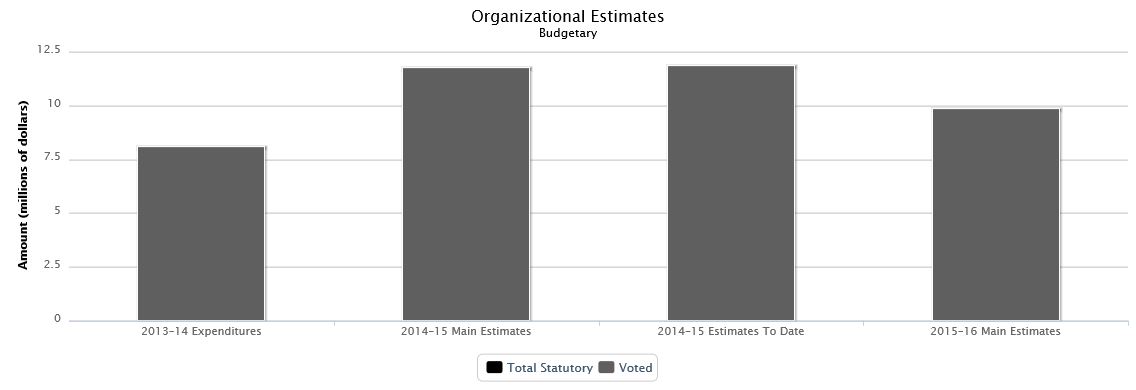
| 2013–14 Expenditures | 2014–15 Main Estimates | 2014–15 Estimates To Date | 2015–16 Main Estimates | ||
|---|---|---|---|---|---|
| Budgetary | |||||
| Voted | |||||
| 1 | Payments to the Standards Council of Canada | 8,081,241 | 11,729,000 | 11,829,000 | 9,829,000 |
| Total voted | 8,081,241 | 11,729,000 | 11,829,000 | 9,829,000 | |
| Total budgetary | 8,081,241 | 11,729,000 | 11,829,000 | 9,829,000 | |
Highlights
The SCC is estimating budgetary expenditures of $9.8 million in 2015–16. Last year, SCC's Main Estimates include a one-time $2 million reprofile from fiscal year 2013–14 which explains the net year-over-year reduction.
The SCC continues with the project "Reducing Barriers to Internal Trade" that started last year, in partnership with Industry Canada. During 2015–16, SCC is planning to receive $100 thousand to be spent on research and to evaluate technical barriers to trade within Canada in several sectors of the economy. Also, SCC continues with the Northern Infrastructure Standardization Initiative in partnership with Aboriginal Affairs and Northern Development Canada. During 2015–16, SCC will receive $500 thousand to be spent on ensuring that codes, standards and other related instruments are effective in addressing the climate risks inherent in Northern infrastructure design, planning and management.
Remaining appropriations supports SCC with its mandate to promote Canadaʼs economic growth through the pursuit of efficient and effective standardization. Standards are put in place to safeguard the health and safety of Canadians, improve the flow of goods and services within Canada and internationally, and reduce red tape and compliance costs facing Canadian businesses. SCC's vision is to be a global leader driving prosperity and well-being for Canada through innovative standardization solutions.
Expenditures by Strategic Outcome and Program
| 2013–14 Expenditures | 2014–15 Main Estimates | 2015–16 Main Estimates | |
|---|---|---|---|
| Canada has an effective and efficient National Standards System. | |||
| Standards Program | 0 | 4,560,000 | 7,439,000 |
| Conformity Assessment Program | 0 | 0 | 0 |
| Standards and Conformity Assessment Policy | 0 | 5,476,000 | 0 |
| The following program supports all strategic outcomes within this organization. | |||
| Internal Services | 0 | 1,693,000 | 2,390,000 |
| Funds not allocated to the 2015–16 Program Alignment Architecture | 8,081,241 | 0 | 0 |
| Total | 8,081,241 | 11,729,000 | 9,829,000 |
Statistics Canada
Raison d'être
The minister responsible for Statistics Canada is the Minister of Industry.
Statistics Canada was established to ensure that Canadians have access to a trusted source of statistics on Canada to meet their highest priority needs.
The Agency's mandate derives primarily from the Statistics Act. The Act requires that Statistics Canada collect, compile, analyze and publish statistical information on the economic, social and general conditions of the country and its people. It also requires that Statistics Canada conduct a census of population and a census of agriculture every fifth year, and that the Agency protect the confidentiality of the information with which it is entrusted.
Organizational Estimates
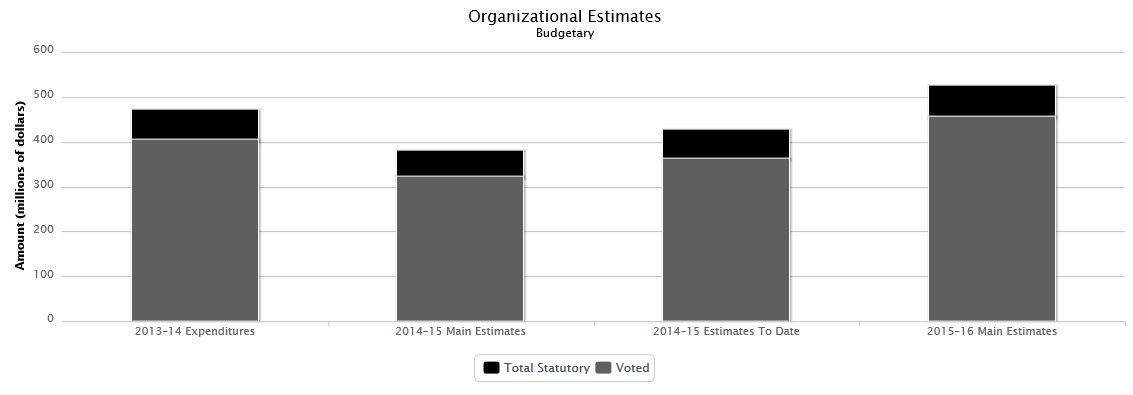
| 2013–14 Expenditures | 2014–15 Main Estimates | 2014–15 Estimates To Date | 2015–16 Main Estimates | ||
|---|---|---|---|---|---|
| Budgetary | |||||
| Voted | |||||
| 1 | Program expenditures | 403,702,440 | 322,744,376 | 363,219,058 | 456,012,343 |
| Total voted | 403,702,440 | 322,744,376 | 363,219,058 | 456,012,343 | |
| Total Statutory | 67,809,335 | 56,811,148 | 63,381,961 | 69,078,477 | |
| Total budgetary | 471,511,775 | 379,555,524 | 426,601,019 | 525,090,820 | |
Highlights
Statistics Canada is committed to ensuring that Canadians have the key information on Canada's economy, society and environment that they require to function effectively as citizens and decision makers in a rapidly evolving world. During the 2015–16 fiscal year, the Agency's organizational priorities are to:
- Deliver the ongoing statistical program in compliance with the Quality Assurance Framework;
- Respond to the emerging and evolving information needs of data users and stakeholders;
- Operate a responsive program to fill ad hoc statistical requests on a cost-recovery basis; and
- Enhance the efficiency, responsiveness and robustness of the Agency's operations.
The Agency continues to pursue emerging opportunities with imagination and energy in order to deliver the greatest possible value to Canadians.
Main Estimates planned expenditures (net of revenue) were $379.6 million in 2014–15 and are $525.1 million for 2015–16. The increase of $145.5 million is mainly due to the following:
- A decrease of $2.8 million for the 2011 Census of Population and National Household Survey which reflects the end of the 2011 cycle;
- A decrease of $894,299 for the Consumer Price Index (CPI). The remaining funds for the CPI will become stable as of 2015–16;
- An increase of $141.9 million for the 2016 Census of Population Program. Applicable funding in 2015–16 will be used mostly to publish the 2016 Census content in the Canada Gazette; print Census Program questionnaires; develop communications strategies and partnerships; develop and test census collection and processing systems and procedures; conduct address listing operations; finalize acquisition of census facilities and complete fit-up; recruit and train census field managers, supervisors and field staff; establish the final product and service line for disseminating 2016 Census results; and conduct early enumeration of northern communities;
- An increase of $7.2 million for the 2016 Census of Agriculture. Applicable funding in 2015–16 will be used to publish 2016 Census of Agriculture content in the Canada Gazette; initialize the frame for the 2016 Census of Agriculture; develop a respondent relations plan; prepare quality assurance/control plans; implement human resources and facilities plans; print/insert census questionnaires, letters and mail-out packages; complete modifications and testing of production processing systems; establish and test 2016 Census of Agriculture dissemination products and services; and continue research on potential administrative data replacements;
- An increase of $639,762 for previous year collective agreements; and
- A decrease of $487,960 which reflects a transfer of funds to the Canada School of Public Service for the transition to the new enterprise-wide approach to learning.
Additional information can be found in Statistics Canada's Report on Plans and Priorities.
Expenditures by Strategic Outcome and Program
| 2013–14 Expenditures | 2014–15 Main Estimates | 2015–16 Main Estimates | |
|---|---|---|---|
| Canadians have access to timely, relevant and quality statistical information on Canadaʼs changing economy and society for informed debate, research and decision making on social and economic issues. | |||
| Censuses | 45,036,722 | 3,263,305 | 145,443,672 |
| Economic and Environmental Statistics | 130,781,314 | 127,927,320 | 127,982,162 |
| Statistical Infrastructure | 135,719,900 | 98,556,365 | 105,110,975 |
| Socio-economic Statistics | 103,547,956 | 93,735,987 | 94,887,730 |
| Specific client needs for high-quality and timely statistical services are met. | |||
| Cost-recovered Statistical Services | (279,336) | 0 | 0 |
| The following program supports all strategic outcomes within this organization. | |||
| Internal Services | 56,705,219 | 56,072,547 | 51,666,281 |
| Total | 471,511,775 | 379,555,524 | 525,090,820 |
Supreme Court of Canada
Raison d'être
Created by an Act of Parliament in 1875, the Supreme Court of Canada (SCC) is Canada's final court of appeal. It serves Canadians by deciding legal issues of public importance, thereby contributing to the development of all branches of law applicable within Canada. The independence of the Court, the quality of its work and the esteem in which it is held both in Canada and abroad contribute significantly as foundations for a secure, strong and democratic country founded on the Rule of Law. The SCC consists of the Chief Justice and eight puisne judges.
The Office of the Registrar of the Supreme Court of Canada provides all necessary services and support for the Court to process, hear and decide cases. It also serves as the interface between litigants and the Court. The Minister of Justice is responsible for this institution.
Organizational Estimates
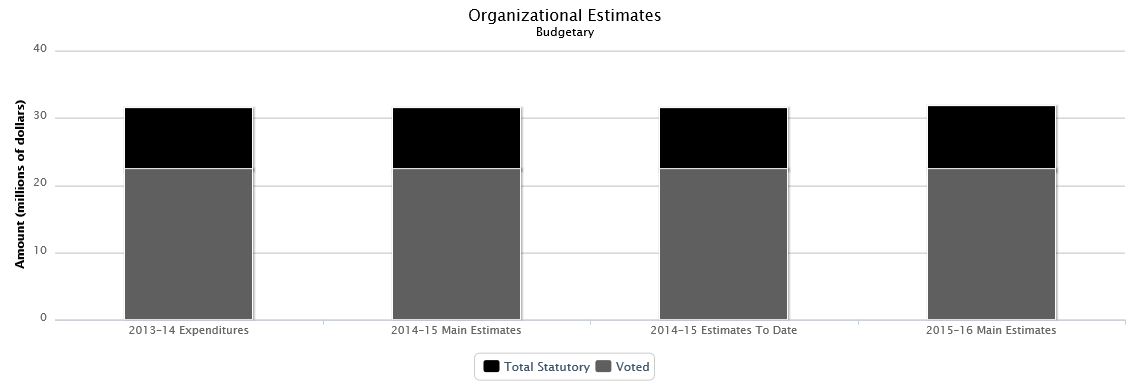
| 2013–14 Expenditures | 2014–15 Main Estimates | 2014–15 Estimates To Date | 2015–16 Main Estimates | ||
|---|---|---|---|---|---|
| Budgetary | |||||
| Voted | |||||
| 1 | Program expenditures | 22,419,896 | 22,307,652 | 22,425,952 | 22,304,846 |
| Total voted | 22,419,896 | 22,307,652 | 22,425,952 | 22,304,846 | |
| Total Statutory | 9,011,043 | 9,082,142 | 9,082,142 | 9,459,097 | |
| Total budgetary | 31,430,939 | 31,389,794 | 31,508,094 | 31,763,943 | |
Highlights
The SCC is estimating budgetary expenditures of $31.8 million in 2015–16. Of that amount, $22.3 million requires approval by Parliament. The remaining $9.5 million represents the statutory funding forecast that does not require additional approval and is provided for information purposes.
The net increase of $374,149 in the 2015–16 Estimates is attributable to:
- A net decrease of $2,806 in operating funding due to an increase of $18,773 for various collective agreement settlements that is offset by a net decrease of $21,579 for SCC's mandatory contribution towards central agencies initiatives;
- An increase of $331,517 in statutory funding for Judges' salaries and annuities; and
- An increase of $45,438 for an adjustment to the contributions to employee benefit plans.
The increase in the Statutory Authorities of the SCC is due to increased costs for salaries of SCC judges and annuities arising from the retirement of SCC Judges.
With the funds anticipated through these Main Estimates, the Office of the Registrar of the Supreme Court of Canada (Office) will continue to focus its efforts on the processing of cases without delay while maintaining stakeholder satisfaction and high standards of service. This is achieved through its single strategic outcome, namely that the "administration of Canada's final court of appeal is effective and independent".
In 2015–16, the Office will place a high priority on pursuing its work towards the adaptation of business processes in an electronic environment, with a view to continuously improving electronic access to the Court's case files and information, both for internal use by the Court as well as by the public and litigants. The Office will also continue to work on enhancing the Court's physical and IT security program. More robust security measures are needed in response to an increase in both the complexity and sensitivity of cases being heard. In addition, the Office will pursue its focus of exploring operational efficiencies and ensuring optimal use of its resources.
Once tabled in the House of Commons, additional information will be available in SCC's Report on Plans and Priorities.
Expenditures by Strategic Outcome and Program
| 2013–14 Expenditures | 2014–15 Main Estimates | 2015–16 Main Estimates | |
|---|---|---|---|
| The administration of Canada's final court of appeal is effective and independent. | |||
| Court Operations | 16,627,433 | 15,765,325 | 16,286,129 |
| Payments to Judges of the Supreme Court of Canada Pursuant to the Judges Act | 6,155,512 | 6,756,473 | 7,087,990 |
| The following program supports all strategic outcomes within this organization. | |||
| Internal Services | 8,647,994 | 8,867,996 | 8,389,824 |
| Total | 31,430,939 | 31,389,794 | 31,763,943 |
Telefilm Canada
Raison d'être
The Minister of Canadian Heritage and Official Languages is responsible for this organization.
Telefilm Canada (Telefilm) was established in 1967 by the Telefilm Canada Act. The mandate of Telefilm is to foster and promote the development of the audiovisual industry in Canada.
A strong and vibrant audiovisual industry
Telefilm's corporate vision embraces both building production capacity and stimulating demand for Canadian screen-based content. To this end, Telefilm aims to ensure that Canadian screen-based content is accessible to audiences anywhere, anytime and on any platform.
Telefilm's strategic orientations are built around four strategic pillars:
- Maintain and expand its core role of funder;
- Develop its role as promoter;
- Provide thought leadership by developing and sharing industry intelligence; and
- Reinforce its organizational excellence.
Additional information can be found in Telefilm's corporate plan: Fostering Cultural Success. A corporate plan will be available soon and will be in continuity with the previous plan.
Organizational Estimates
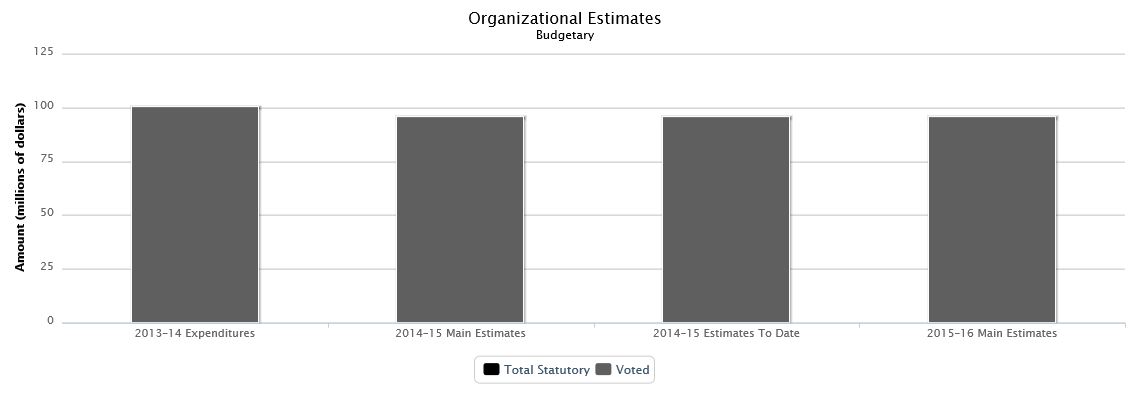
| 2013–14 Expenditures | 2014–15 Main Estimates | 2014–15 Estimates To Date | 2015–16 Main Estimates | ||
|---|---|---|---|---|---|
| Budgetary | |||||
| Voted | |||||
| 1 | Payments to Telefilm Canada to be used for the purposes set out in the Telefilm Canada Act | 99,975,111 | 95,363,072 | 95,363,072 | 95,453,551 |
| Total voted | 99,975,111 | 95,363,072 | 95,363,072 | 95,453,551 | |
| Total budgetary | 99,975,111 | 95,363,072 | 95,363,072 | 95,453,551 | |
Highlights
Telefilm is estimating budgetary expenditures of $95.5 million in fiscal 2015–16.
These planned expenditures are similar to the 2014–15 Main Estimates.
Telefilm's funding programs are essential to the Canadian audiovisual industry; they provide financial support to Canadian production and distribution companies that deliver content to audiences.
The investment in the development of and support to the Canadian audiovisual industry program and the promotional support for Canadian content program both present a stable level of financing compared with the preceding fiscal year.
Telefilm pursues concrete actions in order to optimize the use of its parliamentary appropriation and to maximize the results of the funding provided:
- Telefilm has completed the redesign of its funding programs. These programs offer greater autonomy and flexibility for clients, improve the quality of customer service and provide better alignment to Telefilm's Success Index which measures the results for the commercial, cultural and industrial success of feature films supported by Telefilm;
- The new decision-making process applicable to feature films favours the growth of private-sector funding;
- The use of partnerships as the cornerstone to Telefilm's promotional strategy; and finally,
- Telefilm created the Talent Fund which draws on financial support from Canadian corporations as well as individual donors interested in supporting the production and promotion of Canadian feature films.
Expenditures by Strategic Outcome and Program
| 2013–14 Expenditures | 2014–15 Main Estimates | 2015–16 Main Estimates | |
|---|---|---|---|
| Quality audiovisual content developed by Canadians and promoted to audiences in Canada and internationally. | |||
| Investment in the development of and support to the Canadian audiovisual industry | 69,383,016 | 66,535,127 | 66,306,278 |
| National and international promotional support for Canadian content | 18,337,064 | 16,235,931 | 16,390,499 |
| The following program supports all strategic outcomes within this organization. | |||
| Internal Services | 12,255,031 | 12,592,014 | 12,756,774 |
| Total | 99,975,111 | 95,363,072 | 95,453,551 |
The Federal Bridge Corporation Limited
Raison d'être
The Federal Bridge Corporation Limited (FBCL) is a Crown corporation established in 1998 to provide the Government of Canada with oversight and accountability for specific international bridges and associated structures in Ontario, including the Canadian portions of the international bridge systems in Cornwall, Thousand Islands and Sault Ste. Marie.
FBCL is accountable to Parliament through the Minister of Transport.
Organizational Estimates
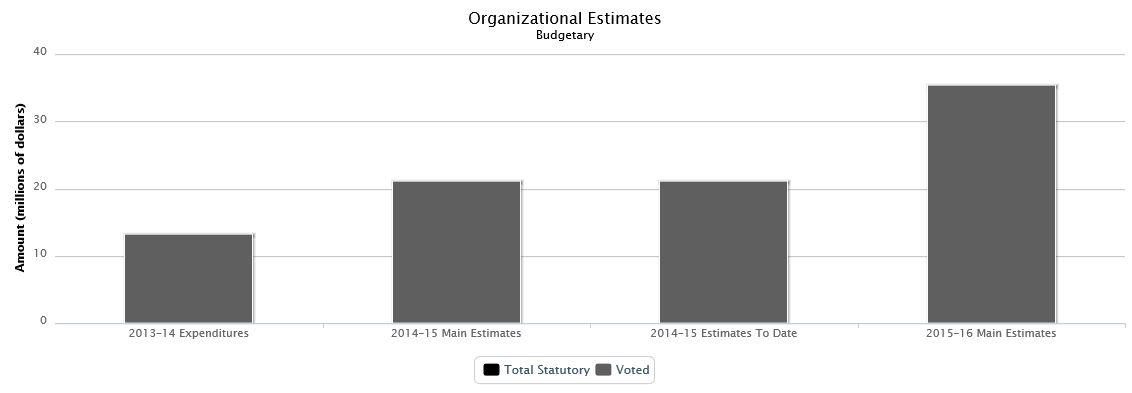
| 2013–14 Expenditures | 2014–15 Main Estimates | 2014–15 Estimates To Date | 2015–16 Main Estimates | ||
|---|---|---|---|---|---|
| Budgetary | |||||
| Voted | |||||
| 1 | Payments to The Federal Bridge Corporation Limited | 13,190,982 | 21,040,000 | 21,040,000 | 35,281,996 |
| Total voted | 13,190,982 | 21,040,000 | 21,040,000 | 35,281,996 | |
| Total budgetary | 13,190,982 | 21,040,000 | 21,040,000 | 35,281,996 | |
Highlights
The FBCL is estimating budgetary expenditures of $35.28 million in 2015–16. Of this amount, $15.28 million is for the demolition of the old high-level North Channel Bridge in Cornwall. $20.00 million is for the Port of Entry rehabilitation project at the Thousand Islands Bridge. This spending is $14.24 million higher than in 2014–15 due to the starting of construction at the Port of Entry rehabilitation project at the Thousand Islands Bridge.
Expenditures by Strategic Outcome and Program
| 2013–14 Expenditures | 2014–15 Main Estimates | 2015–16 Main Estimates | |
|---|---|---|---|
| Safe and efficient transit on the infrastructure maintained, operated and managed by The Federal Bridge Corporation Limited. | |||
| Construction of a new low-level bridge in Cornwall, Ontario as well as related infrastructure improvements | 0 | 21,040,000 | 35,281,996 |
| Funds not allocated to the 2015–16 Program Alignment Architecture | 13,190,982 | 0 | 0 |
| Total | 13,190,982 | 21,040,000 | 35,281,996 |
The Jacques-Cartier and Champlain Bridges Inc.
Raison d'être
The Jacques-Cartier and Champlain Bridges Incorporated is a Crown corporation established in 1978 whose mission is to own, manage, operate and maintain the Jacques-Cartier Bridge, the Champlain Bridge and its Estacade (Ice Control Structure), the Nuns' Island Bridge, the Melocheville Tunnel and the federal sections of the Honoré Mercier Bridge, the Bonaventure Expressway and Highway 15, to provide safe and efficient transport system to the public.
The Minister of Infrastructure, Communities and Intergovernmental Affairs and Minister of the Economic Development Agency of Canada for the Regions of Quebec is responsible for this organization.
Organizational Estimates
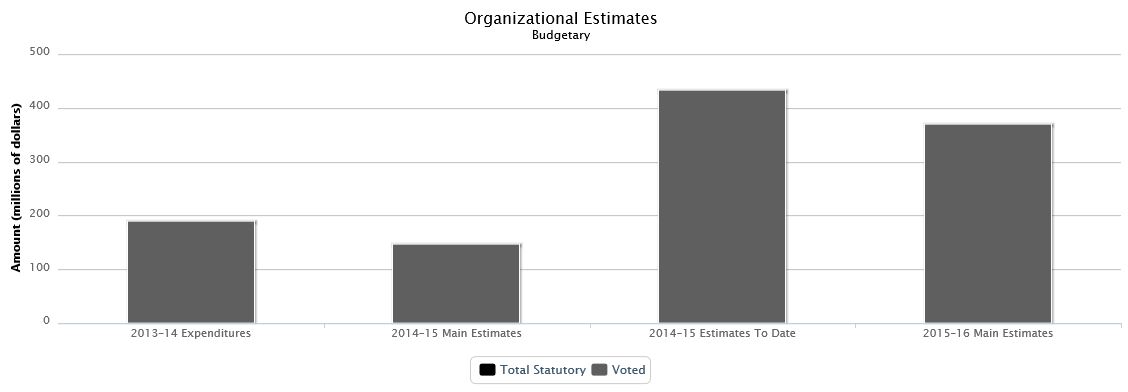
| 2013–14 Expenditures | 2014–15 Main Estimates | 2014–15 Estimates To Date | 2015–16 Main Estimates | ||
|---|---|---|---|---|---|
| Budgetary | |||||
| Voted | |||||
| 1 | Payments to the Jacques-Cartier and Champlain Bridges Inc. | 189,218,871 | 146,168,159 | 432,832,159 | 368,737,000 |
| Total voted | 189,218,871 | 146,168,159 | 432,832,159 | 368,737,000 | |
| Total budgetary | 189,218,871 | 146,168,159 | 432,832,159 | 368,737,000 | |
Highlights
The Jacques-Cartier and Champlain Bridges Incorporated is estimating budgetary expenditures of $368.7 million in 2015–16.
Planned spending in 2014–15 takes into consideration the total of Main Estimates 2014–15, Supplementary Estimates (A) 2014–15 and Supplementary Estimates (B) 2014–15 ($432 million). The decrease in planned spending from 2014–15 to 2015–16 can be attributed to a decrease of the project scope for repairs of Highway 15 and construction works of the temporary causeway-bridge to replace the Nuns' Island Bridge. Planned spending in 2015–16 will include urgent repairs to the Champlain Bridge and maintenance work on other structures, including the Jacques Cartier and Honoré Mercier bridges.
Expenditures by Strategic Outcome and Program
| 2013–14 Expenditures | 2014–15 Main Estimates | 2015–16 Main Estimates | |
|---|---|---|---|
| Safe and efficient transit on the infrastructure maintained, operated and managed by the Jacques-Cartier and Champlain Bridges Incorporated. | |||
| Management of federal bridge, highway and tunnel infrastructure, and properties in the Montreal area | 0 | 146,168,159 | 368,737,000 |
| Funds not allocated to the 2015–16 Program Alignment Architecture | 189,218,871 | 0 | 0 |
| Total | 189,218,871 | 146,168,159 | 368,737,000 |
The Senate
Raison d'être
The Senate of Canada, established by the Constitution Act, 1867, functions as a chamber complementary to, and independent of, the House of Commons. The Senate has 105 members appointed from the provinces and territories. Its primary purpose is to study and review all legislation passed by the House of Commons or initiated in the Senate. Both houses of Parliament must approve bills in identical form before they can become law. The Senate has the power to adopt, amend or reject any bill. In practice, it rarely defeats bills, but does frequently amend them. Through its committees, the Senate also undertakes the examination of public policy issues, often of a far-reaching and long-term nature, providing guidance to government and informing the national debate on issues of importance to Canadians.
The Speaker of the Senate is responsible for this organization.
Organizational Estimates
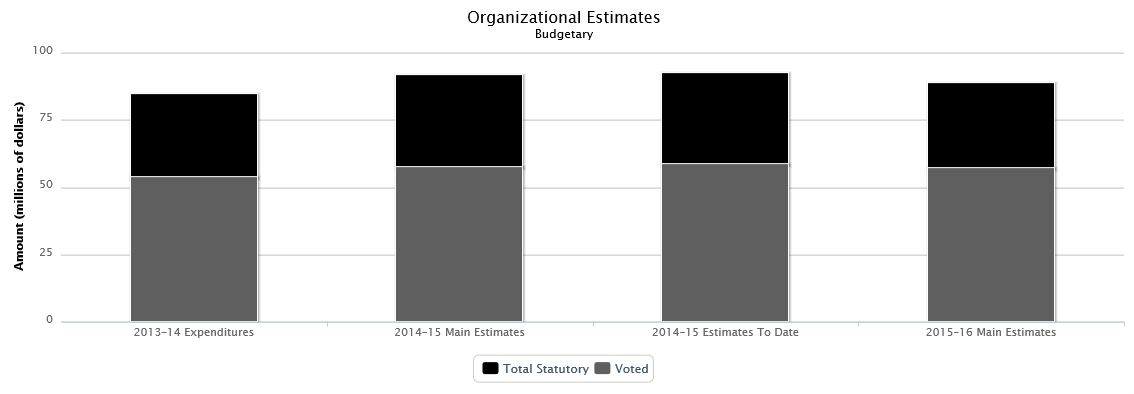
| 2013–14 Expenditures | 2014–15 Main Estimates | 2014–15 Estimates To Date | 2015–16 Main Estimates | ||
|---|---|---|---|---|---|
| Budgetary | |||||
| Voted | |||||
| 1 | Program expenditures | 53,815,856 | 57,532,359 | 58,432,359 | 57,031,359 |
| Total voted | 53,815,856 | 57,532,359 | 58,432,359 | 57,031,359 | |
| Total Statutory | 30,878,194 | 33,952,818 | 33,952,818 | 31,716,599 | |
| Total budgetary | 84,694,050 | 91,485,177 | 92,385,177 | 88,747,958 | |
Highlights
The Senate is estimating budgetary expenditures of $88.7 million in 2015–16. Of this amount, $57 million requires approval by Parliament. The remaining $31.7 million represents statutory forecasts that do not require additional approval and are provided for information purposes.
While the Senate was not obligated to conduct a cost-cutting exercise under the federal government's Strategic and Operating Review and the Economic Action Plan 2014, the Senate undertook budget cost-containment measures and will continue in 2015–16. This exercise has resulted in reductions of the Senate total budget for 2015–16.
As well, the Senate undertook a significant exercise whereby some reductions were identified and other modifications were discussed with a view to achieving longer term efficiencies, for example: review of the organizational structure; review of service standards; use of leave income averaging and attrition; centralization of the professional services budget; continuation of the vacancy management process and exploring further partnership or alternate delivery models.
Expenditures by Strategic Outcome and Program
| 2013–14 Expenditures | 2014–15 Main Estimates | 2015–16 Main Estimates | |
|---|---|---|---|
| To provide the best possible environment for Senators to effectively contribute to federal legislation and public policy issues in the best interest of all Canadians. | |||
| Senators and their Offices | 39,491,143 | 45,477,706 | 42,275,393 |
| Administrative Support | 28,203,881 | 29,420,786 | 30,516,196 |
| Chamber, Committees and Associations | 16,999,026 | 16,586,685 | 15,956,369 |
| Total | 84,694,050 | 91,485,177 | 88,747,958 |
Listing of the 2015–16 Transfer Payments
| 2013–14 Expenditures | 2014–15 Main Estimates | 2015–16 Main Estimates | |
|---|---|---|---|
| Grants | |||
| Total Statutory | 46,402 | 167,000 | 167,000 |
| Contributions | |||
| Contributions to Parliamentary Associations | 402,207 | 380,000 | 405,609 |
Transport
Raison d'être
A safe and secure transportation system provides reliable and efficient movement of goods and people across the country and around the world. In an environmentally responsible way, it meets the challenges posed by topography and geography, linking communities and reducing the effects of the distance that separates people. These vital roles reflect transportationʼs interdependent relationship with all sectors of the economy and society.
Transport Canada (Department) is responsible for the Government of Canadaʼs transportation policies and programs. The Department develops legislative and regulatory frameworks, and conducts transportation oversight through legislative, regulatory, surveillance and enforcement activities. While not directly responsible for all aspects or modes of transportation, the department plays a leadership role to ensure that all parts of the transportation system across Canada work together effectively.
Organizational Estimates
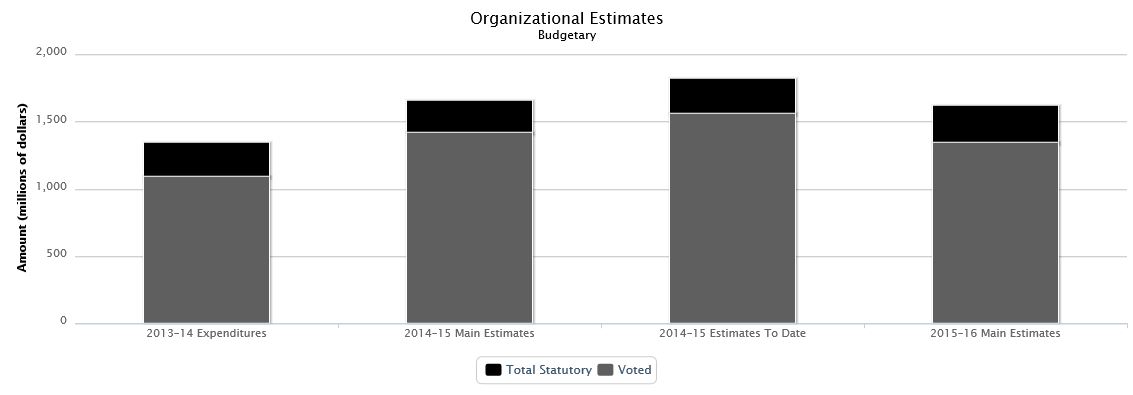
| 2013–14 Expenditures | 2014–15 Main Estimates | 2014–15 Estimates To Date | 2015–16 Main Estimates | ||
|---|---|---|---|---|---|
| Budgetary | |||||
| Voted | |||||
| 1 | Operating expenditures | 549,165,564 | 513,898,673 | 564,861,615 | 551,124,773 |
| 5 | Capital expenditures | 75,558,930 | 145,753,473 | 211,509,473 | 106,911,344 |
| 10 | Grants and contributions | 462,317,216 | 757,956,898 | 778,474,908 | 683,312,718 |
| Total voted | 1,087,041,710 | 1,417,609,044 | 1,554,845,996 | 1,341,348,835 | |
| Total Statutory | 253,591,125 | 238,073,450 | 262,568,801 | 273,663,443 | |
| Total budgetary | 1,340,632,835 | 1,655,682,494 | 1,817,414,797 | 1,615,012,278 | |
Highlights
The department is estimating budgetary expenditures of $1.6 billion in 2015–16. Of this amount, $1.3 billion requires approval by Parliament and the remaining $273.7 million represents statutory forecasts that do not require additional approval and are provided for information purposes only. When compared to the 2014–15 Main Estimates, this represents a $76.3 million decrease in total voted expenditures as a result of a $37.2 million increase in Operating offset by a $38.8 million decrease in Capital and a $74.6 million decrease in Grants and contributions.
Planned operating expenditures have increased from 2014–15 mostly due to new funding for the delivery of the Ports Asset Transfer program which forms part of an asset management strategy to reduce the inventory of ports, for the extension of the Ferry Services Contribution Program, and to strengthen Canada's marine oil spill prevention, preparedness and response regime.
Planned spending in the capital vote is expected to decrease mostly as a result of changes in spending related to the Detroit River International Crossing (DRIC) as some of the capital funding for the DRIC project was transferred to the Windsor Detroit Bridge Authority to manage the procurement process for the design, construction, operation and maintenance of the new bridge between Windsor, Ontario and Detroit, Michigan through a public-private partnership.
Planned spending in the grants and contributions vote is expected to decrease mostly as a result of decreased planned spending for the Asia-Pacific Gateway and Corridor Transportation Infrastructure Fund initiative, as the program approaches its maturity date, as well as sunsetting funding for the Contribution to Provide Short Term Financial Assistance for the Costs of Repairs, Maintenance, Rehabilitation and Other Related Initiatives Supporting the Ongoing Operations for the Port of Churchill and the Contribution for the Oshawa Harbour Port Consolidation Project. The decrease is partially offset by new funding for the Contribution Program for the Centre of Excellence for Marine Transportation of Oil and Liquefied Natural Gas, the Ocean Networks Canada – Smart Oceans Contribution Program and the Community Participation Funding Program. The total change in planned spending for grants and contributions is also impacted by changes in cash flows of various other programs.
Details on the department's priorities, core activities and related resource requirements can be found in the Departmentʼs Report on Plans and Priorities.
Expenditures by Strategic Outcome and Program
| 2013–14 Expenditures | 2014–15 Main Estimates | 2015–16 Main Estimates | |
|---|---|---|---|
| An Efficient Transportation System. | |||
| Gateways and Corridors | 336,988,453 | 702,272,494 | 576,569,290 |
| Transportation Infrastructure | 363,848,205 | 333,815,823 | 399,495,001 |
| Transportation Marketplace Frameworks | 11,917,295 | 24,854,622 | 24,473,890 |
| A Safe and Secure Transportation System. | |||
| Aviation Safety | 184,628,770 | 170,709,221 | 173,447,956 |
| Marine Safety | 59,638,305 | 56,003,982 | 57,475,536 |
| Rail Safety | 29,250,946 | 34,265,437 | 35,707,671 |
| Aviation Security | 29,743,295 | 31,672,052 | 29,791,738 |
| Motor Vehicle Safety | 26,152,233 | 20,905,007 | 22,723,248 |
| Transportation of Dangerous Goods | 14,663,095 | 14,727,734 | 15,322,623 |
| Marine Security | 12,331,970 | 12,788,946 | 12,872,129 |
| Multimodal Safety and Security | 10,722,526 | 11,153,164 | 10,890,897 |
| Surface and Intermodal Security | 4,280,788 | 4,739,231 | 4,703,731 |
| A Clean Transportation System. | |||
| Environmental Stewardship of Transportation | 29,431,954 | 29,171,557 | 33,906,726 |
| Clean Water from Transportation | 16,198,195 | 18,074,900 | 31,902,400 |
| Clean Air from Transportation | 27,755,589 | 38,992,028 | 29,417,677 |
| The following program supports all strategic outcomes within this organization. | |||
| Internal Services | 170,195,608 | 151,536,296 | 156,311,765 |
| Funds not allocated to the 2015–16 Program Alignment Architecture | 12,885,608 | 0 | 0 |
| Total | 1,340,632,835 | 1,655,682,494 | 1,615,012,278 |
Listing of the 2015–16 Transfer Payments
| 2013–14 Expenditures | 2014–15 Main Estimates | 2015–16 Main Estimates | |
|---|---|---|---|
| Grants | |||
| Grant to the Province of British Columbia in respect of the provision of ferry and coastal freight and passenger services | 28,372,954 | 28,868,346 | 29,238,376 |
| Community Participation Funding Program | 0 | 0 | 800,000 |
| Grant to close grade crossings | 95,000 | 300,000 | 300,000 |
| Grants to support Clean Transportation Initiatives | 250,000 | 250,000 | 250,000 |
| Grant for the Northern Transportation Adaptation Initiative | 249,985 | 200,000 | 200,000 |
| Grant to the International Civil Aviation Organization (ICAO) for Cooperative Development of Operational Safety and Continuing Airworthiness Program (COSCAP) | 130,000 | 130,000 | 130,000 |
| Contributions | |||
| Gateways and Border Crossings Fund | 128,832,901 | 470,934,398 | 484,147,493 |
| Asia-Pacific Gateway and Corridor Transportation Infrastructure Fund | 185,097,539 | 135,662,628 | 40,249,710 |
| Airports Capital Assistance Program | 12,869,974 | 38,000,000 | 38,000,000 |
| Ferry Services Contribution Program | 28,349,829 | 16,720,000 | 34,569,754 |
| Contribution to Support Clean Transportation Initiatives | 5,247,655 | 18,418,941 | 11,217,704 |
| Regional and Remote Passenger Rail Service Class Contribution Program (RRPRSCCP) | 12,809,202 | 11,200,000 | 11,200,000 |
| Payments in support of crossing improvements approved under the Railway Safety Act | 7,052,349 | 10,945,000 | 10,945,000 |
| Smart Oceans Contribution Program | 0 | 0 | 7,400,000 |
| Road Safety Transfer Payment Program | 4,440,264 | 4,442,681 | 4,442,681 |
| Contribution Program for the Centre of Excellence for Marine Transportation of Oil and Liquefied Natural Gas | 0 | 0 | 3,700,000 |
| Airports Operations and Maintenance Subsidy Program | 1,401,487 | 1,600,000 | 1,600,000 |
| Labrador Coastal Airstrips Restoration Program | 550,000 | 1,000,000 | 1,000,000 |
| Contribution in Support of Boating Safety | 528,875 | 1,000,000 | 1,000,000 |
| Contributions to provinces toward highway improvements to enhance overall efficiency and promote safety while encouraging industrial development and tourism from a regional economic perspective: Outaouais Road Development Agreement | 13,066,408 | 8,380,000 | 950,000 |
| Contribution for the Northern Transportation Adaptation Initiative | 859,383 | 940,000 | 645,000 |
| Allowances to former employees of Newfoundland Railways, Steamships and Telecommunications Services transferred to Canadian National Railways | 391,369 | 484,000 | 484,000 |
| Transportation Association of Canada | 410,294 | 419,000 | 419,000 |
| Contributions to the Railway Association of Canada for Operation Lifesaver | 300,000 | 300,000 | 300,000 |
| Payments to other governments or international agencies for the operation and maintenance of airports, air navigation and airways facilities | 44,835 | 100,000 | 100,000 |
| Canadian Transportation Research Forumʼs Scholarship program | 24,000 | 24,000 | 24,000 |
| Total Statutory | 64,130,420 | 66,136,173 | 67,089,074 |
Transportation Appeal Tribunal of Canada
Raison d'être
Pursuant to the Administrative Tribunals Support Service of Canada Act, the Transportation Appeal Tribunal of Canada was amalgamated to the Administrative Tribunals Support Service of Canada, effective .
Organizational Estimates

| 2013–14 Expenditures | 2014–15 Main Estimates | 2014–15 Estimates To Date | 2015–16 Main Estimates | ||
|---|---|---|---|---|---|
| Budgetary | |||||
| Voted | |||||
| - | Program expenditures | 1,340,954 | 1,295,394 | 1,295,394 | 0 |
| Total voted | 1,340,954 | 1,295,394 | 1,295,394 | 0 | |
| Total Statutory | 130,083 | 120,680 | 120,680 | 0 | |
| Total budgetary | 1,471,037 | 1,416,074 | 1,416,074 | 0 | |
Highlights
Not applicable
Expenditures by Strategic Outcome and Program
| 2013–14 Expenditures | 2014–15 Main Estimates | 2015–16 Main Estimates | |
|---|---|---|---|
| The Canadian transportation community is provided with the opportunity to have enforcement and licensing decisions of the Minister of Transport reviewed in a fair manner by unbiased hearing officers. | |||
| Review and Appeal Hearings | 1,164,373 | 1,079,871 | 0 |
| The following program supports all strategic outcomes within this organization. | |||
| Internal Services | 306,664 | 336,203 | 0 |
| Total | 1,471,037 | 1,416,074 | 0 |
Treasury Board Secretariat
Raison d'être
The Treasury Board of Canada Secretariat (Secretariat) is the administrative arm of the Treasury Board, and the President of the Treasury Board is the Minister responsible for the Secretariat. This organization supports the Treasury Board by making recommendations and providing advice on program spending, regulations and management policies and directives, while respecting the primary responsibility of deputy heads in managing their organizations and their roles as accounting officers before Parliament. In this way, the Secretariat strengthens the way government is managed and helps to ensure value for money in government spending and results for Canadians.
Organizational Estimates
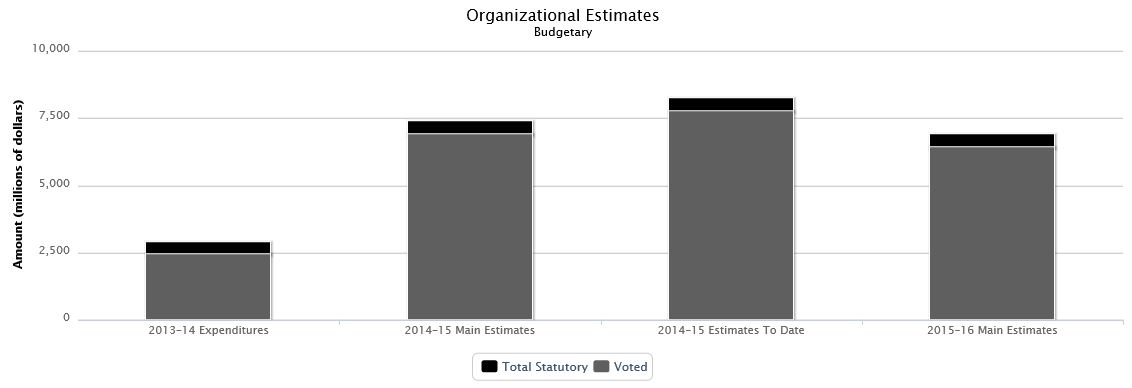
| 2013–14 Expenditures | 2014–15 Main Estimates | 2014–15 Estimates To Date | 2015–16 Main Estimates | ||
|---|---|---|---|---|---|
| Budgetary | |||||
| Voted | |||||
| 1 | Program expenditures | 234,224,053 | 231,214,433 | 305,084,727 | 219,601,334 |
| 5 | Government Contingencies | 0 | 750,000,000 | 750,000,000 | 750,000,000 |
| 10 | Government-Wide Initiatives | 0 | 3,193,000 | 3,193,000 | 2,090,470 |
| 20 | Public Service Insurance | 2,186,132,708 | 2,260,002,208 | 2,506,134,407 | 2,250,070,604 |
| 25 | Operating Budget Carry Forward | 0 | 1,600,000,000 | 1,600,000,000 | 1,600,000,000 |
| 30 | Paylist Requirements | 0 | 1,450,000,000 | 1,850,000,000 | 1,000,000,000 |
| 33 | Capital Budget Carry Forward | 0 | 600,000,000 | 600,000,000 | 600,000,000 |
| - | Compensation Adjustments | 0 | 0 | 151,651,354 | 0 |
| Total voted | 2,420,356,761 | 6,894,409,641 | 7,766,063,488 | 6,421,762,408 | |
| Total Statutory | 472,164,188 | 470,514,473 | 470,514,473 | 470,681,925 | |
| Total budgetary | 2,892,520,949 | 7,364,924,114 | 8,236,577,961 | 6,892,444,333 | |
Highlights
The Secretariat is estimating budgetary expenditures of $6.9 billion in 2015–16, of which $6.4 billion requires approval by Parliament. The remaining $470.7 million represents statutory forecasts that do not require additional approval and are provided for information purposes.
The Secretariat's net spending will decrease by $472.5 million from the previous Main Estimates. This is comprised of government-wide Votes of $461 million and Program Expenditures of $11.6 million. The decrease is offset by increases in statutory items of $0.2 million.
Specifically, the major changes include:
- A decrease to government-wide votes of $461 million. This includes a decrease of $450 million to Vote 30, Paylist Requirements; a decrease of $9.9 million to Vote 20, Public Service Insurance, related to the Vertical Review 2008; and a decrease of $1.1 million to Vote 10, Government-wide Initiatives, for Web Renewal Initiative; and,
- A net decrease to Program Expenditures, of $11.6 million. This includes a net decrease of $9.9 million for the Workspace Renewal Initiative and a net decrease of $1.7 million for the National Managers' Community and miscellaneous items.
Expenditures by Strategic Outcome and Program
| 2013–14 Expenditures | 2014–15 Main Estimates | 2015–16 Main Estimates | |
|---|---|---|---|
| Good governance and sound stewardship to enable efficient and effective service to Canadians. | |||
| Government-wide Funds and Public Service Employer Payments | 2,629,221,633 | 7,106,195,208 | 6,645,161,074 |
| Management Policies Development and Monitoring | 0 | 0 | 73,826,361 |
| Government Wide Programs Design and Delivery | 0 | 0 | 50,671,220 |
| Decision-Making Support and Oversight | 0 | 0 | 47,506,141 |
| The following program supports all strategic outcomes within this organization. | |||
| Internal Services | 80,724,486 | 78,425,603 | 75,279,537 |
| Funds not allocated to the 2015–16 Program Alignment Architecture | 182,574,830 | 180,303,303 | 0 |
| Total | 2,892,520,949 | 7,364,924,114 | 6,892,444,333 |
Listing of the 2015–16 Transfer Payments
| 2013–14 Expenditures | 2014–15 Main Estimates | 2015–16 Main Estimates | |
|---|---|---|---|
| Other Transfer Payments | |||
| Payments, in the nature of Workers' Compensation, in accordance with the Public Service Income Benefit Plan for Survivors of Employees Slain on Duty | 322,784 | 495,000 | 495,000 |
| Special Indemnity Plan for Spouses of Canadian Forces Attachés | 4,679 | 5,000 | 5,000 |
| Total Statutory | 4,603 | 0 | 0 |
Veterans Affairs
Raison d'être
Canada's development as an independent country with a unique identity stems partly from its proud military achievements. Veterans Affairs Canada exists to help those whose courageous efforts gave us this legacy and contributed to our growth as a nation.
The Minister of Veterans Affairs is responsible for this organization.
Veterans Affairs Canada's mandate is set out in the Department of Veterans Affairs Act. It charges the Minister of Veterans Affairs with responsibility for "the care, treatment, or re-establishment in civil life of any person who served in the Canadian Forces or Merchant Navy or in the naval, army, air forces or merchant navies of Her Majesty, of any person who has otherwise engaged in pursuits relating to war, and of any other person designated . . . and the care of the dependants or survivors of any person referred to." Veterans Affairs Canada is also responsible for keeping alive the achievements and sacrifices of those who served Canada in times of war, military conflict and peace.
Organizational Estimates
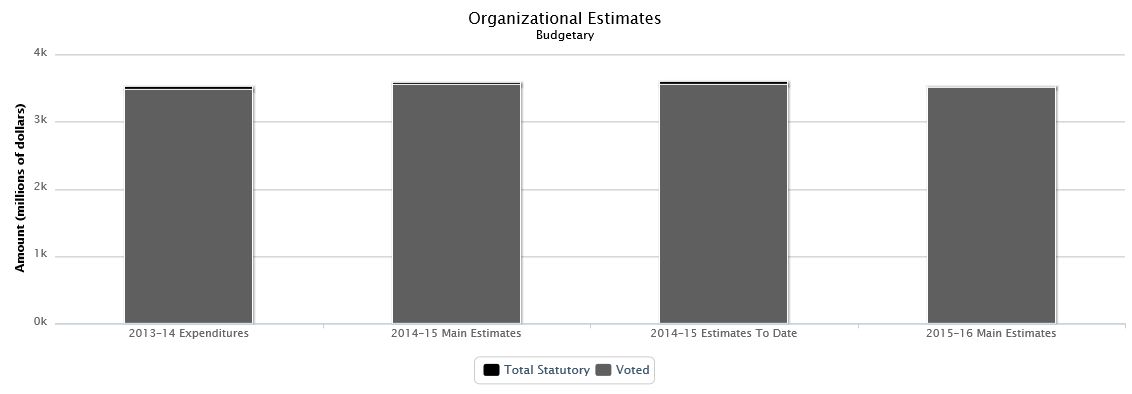
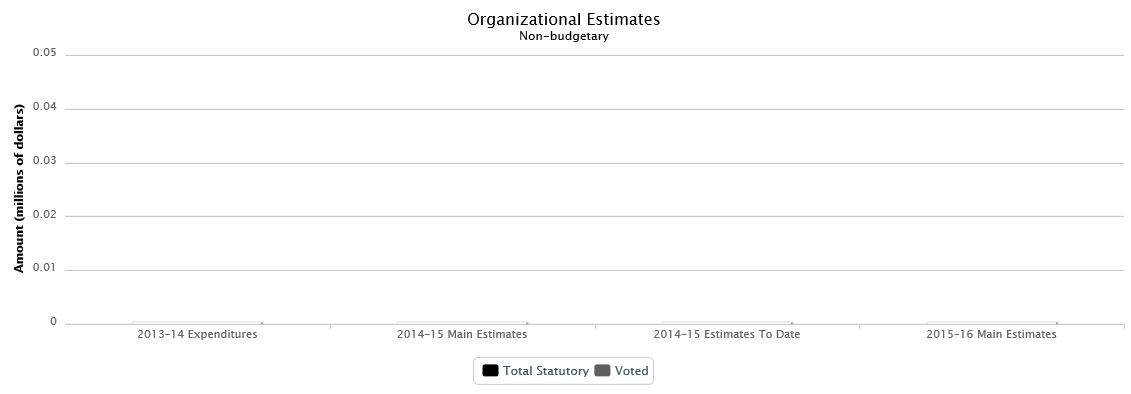
| 2013–14 Expenditures | 2014–15 Main Estimates | 2014–15 Estimates To Date | 2015–16 Main Estimates | ||
|---|---|---|---|---|---|
| Budgetary | |||||
| Voted | |||||
| 1 | Operating expenditures | 836,468,983 | 855,453,817 | 863,887,295 | 855,502,774 |
| 5 | Grants and contributions | 2,635,519,439 | 2,685,987,300 | 2,688,403,902 | 2,639,248,000 |
| Total voted | 3,471,988,422 | 3,541,441,117 | 3,552,291,197 | 3,494,750,774 | |
| Total Statutory | 41,584,467 | 35,537,649 | 35,537,649 | 27,327,401 | |
| Total budgetary | 3,513,572,889 | 3,576,978,766 | 3,587,828,846 | 3,522,078,175 | |
| Non-budgetary | |||||
| Total Statutory | 208 | 0 | 0 | 0 | |
| Total non-budgetary | 208 | 0 | 0 | 0 | |
Highlights
Veterans Affairs Canada's (VAC) budget fluctuates each year due to the demand-driven nature of its programs which are based on Veterans' needs and entitlements. In other words, a Veteran who is entitled to a benefit is paid that benefit, whether 10 Veterans come forward or 10,000.
Total planned spending for the 2015–16 fiscal year is $3.5 billion, a net decrease of 1.5% ($54.9 million) from the 2014–15 fiscal year. This is primarily related to a reduction in requirements for World War I and II and Korean War Veterans, as well as administrative savings.
It is estimated there are approximately 697,400 Veterans nationwide. Only about 98,200 of them are war-service Veterans (from the Second World War and/or Korean War) and, with an average age of 89 years, their numbers grow smaller with each passing month. At the same time, Canadian Armed Forces or modern-day Veterans are turning to VAC for help in growing numbers. Over 90% of the Department's budget, ($3.2 billion or 90.9%) represents payments to Veterans, their families and other program recipients.
These Estimates reflect sustained funding related to the Government of Canada's commitment to ensure that:
- Services and benefits respond effectively to the needs of Veterans, their families and others served by the Department;
- The Department keeps pace with the evolving needs and realities of the Canadians it serves, through both immediate and future action in line with the Government's response to the Standing Committee on Veterans Affairs Report (as well as Veteran's associations);
- VAC hosts commemorative events and activities both in Canada and abroad, to commemorate the 100th and 75th anniversaries of the First and Second World Wars, including planned commencement of construction of a new permanent Visitor Centre at the Canadian National Vimy Memorial in France. Such initiatives permit Canadians to recognize and remember the service and sacrifice of all those who have served our nation;
- VAC continues to work on transferring Ste. Anne's Hospital to the Province of Quebec while maintaining excellence in service; and
- The Department adapts and improves service to Veterans.
For more information on Departmental planned spending and priorities, please see VAC's latest Report on Plans and Priorities.
Expenditures by Strategic Outcome and Program
| 2013–14 Expenditures | 2014–15 Main Estimates | 2015–16 Main Estimates | |
|---|---|---|---|
| Financial, physical and mental well being of eligible Veterans. | |||
| Disability and Death Compensation | 2,099,828,254 | 2,131,096,720 | 2,075,599,433 |
| Health Care Program and Re-establishment Services | 1,118,351,751 | 1,100,616,904 | 1,094,951,813 |
| Financial Support Program | 163,442,979 | 223,360,801 | 228,636,029 |
| Canadians remember and demonstrate their recognition of all those who served in Canada's efforts during war, military conflict and peace. | |||
| Canada Remembers Program | 41,150,530 | 50,034,622 | 50,557,923 |
| Veterans' rights to services and benefits that address their needs are considered by the Veterans Affairs Portfolio. | |||
| Veterans Ombudsman | 4,953,006 | 5,790,009 | 5,779,872 |
| The following program supports all strategic outcomes within this organization. | |||
| Internal Services | 85,846,369 | 66,079,710 | 66,553,105 |
| Total | 3,513,572,889 | 3,576,978,766 | 3,522,078,175 |
| 2013–14 Expenditures | 2014–15 Main Estimates | 2015–16 Main Estimates | |
|---|---|---|---|
| Financial, physical and mental well being of eligible Veterans. | |||
| Disability and Death Compensation | 208 | 0 | 0 |
| Total | 208 | 0 | 0 |
Listing of the 2015–16 Transfer Payments
| 2013–14 Expenditures | 2014–15 Main Estimates | 2015–16 Main Estimates | |
|---|---|---|---|
| Grants | |||
| Pensions for disability and death, including pensions granted under the authority of the Civilian Government Employees (War) Compensation Order, P.C. 45/8848 of , which shall be subject to the Pension Act; for former prisoners of war under the Pension Act, and Newfoundland special awards | 1,562,918,105 | 1,539,000,000 | 1,467,122,000 |
| Disability Awards and Allowances | 461,366,803 | 531,871,000 | 546,378,000 |
| Housekeeping and Grounds Maintenance | 245,571,113 | 268,610,000 | 281,400,000 |
| Earnings Loss and Supplementary Retirement Benefit | 149,391,628 | 204,195,000 | 208,953,000 |
| War Veterans Allowances and Civilian War Allowances | 8,511,410 | 15,071,000 | 13,338,000 |
| Last Post Fund | 8,461,534 | 11,814,000 | 12,887,000 |
| Commonwealth War Graves Commission | 9,714,969 | 10,648,000 | 11,248,000 |
| Payments under the Flying Accidents Compensation Regulations | 711,007 | 850,000 | 975,000 |
| Canadian Forces Income Support Allowance | 322,312 | 358,000 | 972,000 |
| Children of Deceased Veterans Education Assistance | 569,658 | 660,000 | 750,000 |
| Grant for Commemorative Partnerships | 0 | 750,000 | 750,000 |
| Treatment Allowances | 556,890 | 650,000 | 625,000 |
| Assistance in accordance with the provisions of the Assistance Fund Regulations | 296,665 | 460,000 | 420,000 |
| Assistance to Canadian Veterans – Overseas District | 129,968 | 120,000 | 150,000 |
| United Nations Memorial Cemetery in Korea | 18,021 | 70,000 | 70,000 |
| Career Transition Services | 11,684 | 296,300 | 37,000 |
| Payments of Gallantry Awards | 13,749 | 15,000 | 15,000 |
| Canadian Veterans Association of the United Kingdom | 5,000 | 5,000 | 5,000 |
| Total Statutory | 1,067 | 197,000 | 197,000 |
| Contributions | |||
| Contributions to Veterans, under the Veterans Independence Program, to assist in defraying costs of extended health care not covered by provincial health programs | 184,061,004 | 97,246,000 | 90,600,000 |
| Contributions under the Commemorative Partnerships Program, to organizations, institutions and other levels of government, in support of projects related to the health and well-being of the veteran population, and commemoration activities and events | 2,140,321 | 2,548,000 | 2,553,000 |
Veterans Review and Appeal Board
Raison d'être
The Veterans Review and Appeal Board is an independent, administrative tribunal created in 1995. The Board provides an appeal program for service-related disability decisions made by Veterans Affairs Canada. This program gives applicants two levels of redress for disability pension and disability award decisions and the final level of appeal for War Veterans Allowance claims.
The Board's objective is to ensure that Canada's traditional Veterans, Canadian Armed Forces members and Veterans, Royal Canadian Mounted Police applicants, qualified civilians and their families receive the disability pensions, disability awards and other benefits to which they are entitled under the law.
The responsible Minister for the Board is the Minister of Veterans Affairs.
Organizational Estimates
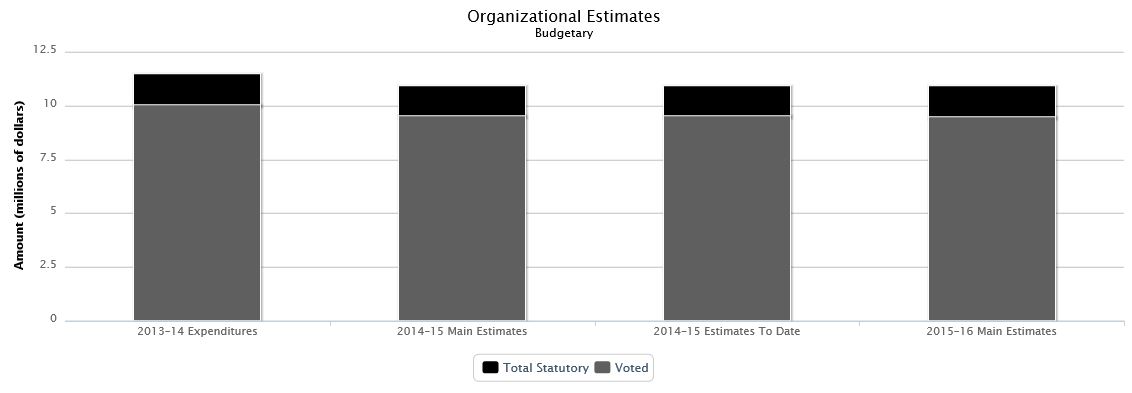
| 2013–14 Expenditures | 2014–15 Main Estimates | 2014–15 Estimates To Date | 2015–16 Main Estimates | ||
|---|---|---|---|---|---|
| Budgetary | |||||
| Voted | |||||
| 1 | Program expenditures | 10,022,700 | 9,478,024 | 9,478,024 | 9,460,756 |
| Total voted | 10,022,700 | 9,478,024 | 9,478,024 | 9,460,756 | |
| Total Statutory | 1,435,388 | 1,409,914 | 1,409,914 | 1,435,807 | |
| Total budgetary | 11,458,088 | 10,887,938 | 10,887,938 | 10,896,563 | |
Highlights
Veterans Review and Appeal Board is estimating budgetary expenditures of $10.9 million in 2015–16. Of this amount, $9.5 million requires approval by Parliament. The remaining $1.4 million represents statutory forecasts that do not require additional approval and are provided for information purposes.
The planned expenditures of the Veterans Review and Appeal Board remain approximately the same as the previous year. In 2015–16, the Board will continue implementing its strategic plan. It will undertake the following activities:
- Program Delivery – Ensure applicants have an avenue of redress by an independent tribunal for disability compensation and War Veterans Allowance applications.
- Improved Program Delivery – Enhance program delivery through innovation and the use of technology to improve the process for applicants.
- Communication – Ensure applicants and all Canadians have information on the Boardʼs mandate, program, and redress process, while meeting the increasing information needs of applicants.
- Accountable Management – Provide an effective program for applicants and their families by focusing on management, transparency and accountability.
Please refer to the Report on Plans and Priorities for further detail.
Expenditures by Strategic Outcome and Program
| 2013–14 Expenditures | 2014–15 Main Estimates | 2015–16 Main Estimates | |
|---|---|---|---|
| An independent and fair appeal process for disability pension, award and allowance decisions made by Veterans Affairs Canada. | |||
| Review and Appeal | 11,458,088 | 10,887,938 | 10,896,563 |
| Total | 11,458,088 | 10,887,938 | 10,896,563 |
VIA Rail Canada Inc.
Raison d'être
VIA Rail Canada Inc. (VIA Rail) was established as a crown corporation in 1978 to operate as the nation's passenger rail carrier. Its objective is to provide a safe, secure, efficient, environmentally sustainable and reliable passenger service in Canada. The network includes trains that operate in the Quebec City to Windsor Corridor, and long-haul trains, between Toronto and Vancouver and between Montreal and Halifax. VIA Rail also provides passenger rail transportation to regional and remote communities, some without alternative year-round transportation access.
VIA Rail Canada is accountable to Parliament through the Minister of Transport.
Organizational Estimates

| 2013–14 Expenditures | 2014–15 Main Estimates | 2014–15 Estimates To Date | 2015–16 Main Estimates | ||
|---|---|---|---|---|---|
| Budgetary | |||||
| Voted | |||||
| 1 | Payments to VIA Rail Canada Inc. | 405,661,000 | 183,061,756 | 433,261,756 | 330,077,000 |
| Total voted | 405,661,000 | 183,061,756 | 433,261,756 | 330,077,000 | |
| Total budgetary | 405,661,000 | 183,061,756 | 433,261,756 | 330,077,000 | |
Highlights
VIA Rail is estimating budgetary expenditures of $330.1 million in 2015–16 which require approval by Parliament.
VIA Rail's 2013 operating deficit increased by 5% compared to 2012 as a result of reduced revenue of 2% due to weak demand and strong competition by other modes and poor on-time performance, while operating costs rose by 1%. In 2013, pension costs peaked at $88 million (from $4 million in 2008) and are projected to decline substantially in future years.
In addition to rightsizing train services in 2012, VIA Rail introduced new frequencies in the Quebec City to Windsor Corridor and is completing its capital investment program made possible through the Government's more than one billion dollar capital investment in VIA Rail since 2007. VIA Rail is re-focusing its efforts on superior customer service and revenue growth including optimal use of its new revenue management system. All these should begin to grow revenues again. VIA Rail also continues to contain costs through numerous productivity improvements in operating and maintenance expenses and reduced staffing levels, and has implemented significant initiatives to rein in the growth of pension costs.
In 2014, revenues are expected to increase by 1% as compared to 2013 and operating costs are expected to increase by 5% as compared to 2013 as a result of having 27 pay periods in 2014.
VIA Rail estimates that it will carry 4 million passengers in 2014, achieving the same level of passenger carryings before the realignment of train services.
Expenditures by Strategic Outcome and Program
| 2013–14 Expenditures | 2014–15 Main Estimates | 2015–16 Main Estimates | |
|---|---|---|---|
| A national passenger rail transportation service that is safe, secure, efficient, reliable, and environmentally sustainable and that meets the needs of travellers in Canada. | |||
| Operation of a national network of rail passenger services | 0 | 183,061,756 | 330,077,000 |
| Funds not allocated to the 2015–16 Program Alignment Architecture | 405,661,000 | 0 | 0 |
| Total | 405,661,000 | 183,061,756 | 330,077,000 |
Western Economic Diversification
Raison d'être
Western Economic Diversification Canada (WD) was established to promote the development and diversification of the economy of Western Canada and to advance the interests of the West in national economic policy, program and project development and implementation. The Minister of Health, supported by the Minister of State (Western Economic Diversification) is responsible for this organization.
The department operates under the provision of the Western Economic Diversification Act, which came into force on . WD is responsible for regional development in Western Canada by developing and supporting economic policies, programs and activities to promote economic growth.
Organizational Estimates
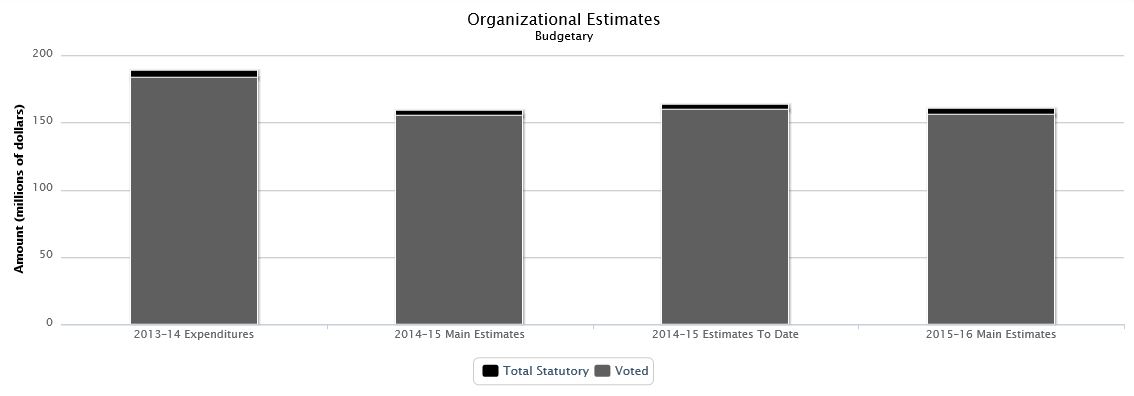
| 2013–14 Expenditures | 2014–15 Main Estimates | 2014–15 Estimates To Date | 2015–16 Main Estimates | ||
|---|---|---|---|---|---|
| Budgetary | |||||
| Voted | |||||
| 1 | Operating expenditures | 40,153,739 | 36,928,959 | 36,928,959 | 36,995,191 |
| 5 | Grants and contributions | 143,006,398 | 117,863,000 | 122,232,026 | 118,733,000 |
| Total voted | 183,160,137 | 154,791,959 | 159,160,985 | 155,728,191 | |
| Total Statutory | 5,168,154 | 4,115,993 | 4,115,993 | 4,185,723 | |
| Total budgetary | 188,328,291 | 158,907,952 | 163,276,978 | 159,913,914 | |
Highlights
WD is estimating budgetary expenditures of $159.9 million in 2015–16. Of this amount, $155.7 million requires approval by Parliament. The remaining $4.2 million represents statutory forecasts that do not require additional approval and are provided for information purposes.
A decrease in net spending of $3.4 million from 2014–15 Estimates to date is due to a decrease in contributions and other transfer payments of $3.5 million and an increase in operating costs of $0.1 million.
There are impacts of yearly adjustments for which authorities are sought throughout a fiscal year and which may vary in amount from year to year. These net adjustments amount to a $3.4 million decrease in 2015–16:
- A $2.5 million decrease in reinvestment of receipts from repayable contributions and funding support to the Rick Hansen Foundation;
- A $1.0 million decrease in transfer from Agriculture and Agri-Food Canada related to the Canadian Beef Centre of Excellence;
- A $0.6 million decrease in funding related to Federal Councils;
- A $0.5 million increase related to the timing of fit-up funding for Workplace 2.0; and
- A $0.2 million increase in funding related to collective bargaining agreements and employee benefits.
Expenditures by Strategic Outcome and Program
| 2013–14 Expenditures | 2014–15 Main Estimates | 2015–16 Main Estimates | |
|---|---|---|---|
| A growing and diversified western Canadian economy. | |||
| Business Development and Innovation | 98,912,661 | 100,598,774 | 100,520,050 |
| Community Economic Growth | 62,155,737 | 34,432,043 | 34,862,792 |
| Policy, Advocacy and Coordination | 9,306,314 | 10,741,002 | 10,145,094 |
| The following program supports all strategic outcomes within this organization. | |||
| Internal Services | 17,953,579 | 13,136,133 | 14,385,978 |
| Total | 188,328,291 | 158,907,952 | 159,913,914 |
Listing of the 2015–16 Transfer Payments
| 2013–14 Expenditures | 2014–15 Main Estimates | 2015–16 Main Estimates | |
|---|---|---|---|
| Grants | |||
| Grants for the Western Diversification Program | 0 | 5,000,000 | 5,000,000 |
| Contributions | |||
| Contributions under the Western Diversification Program | 81,837,602 | 80,509,009 | 81,379,009 |
| Contributions under the Community Futures Program | 29,525,097 | 28,453,991 | 28,453,991 |
| Contributions under the Women's Enterprise Initiative | 5,987,145 | 3,900,000 | 3,900,000 |
Windsor-Detroit Bridge Authority
Raison d'être
The Windsor-Detroit Bridge Authority (WDBA) was created in , pursuant to the International Bridges and Tunnels Act. The WDBA is responsible to carry out the obligations of the Crossing Authority as a party to the Crossing Agreement and to procure, construct, and/or operate the Detroit River International Crossing.
The Minister of Transport is responsible for this organization.
Organizational Estimates
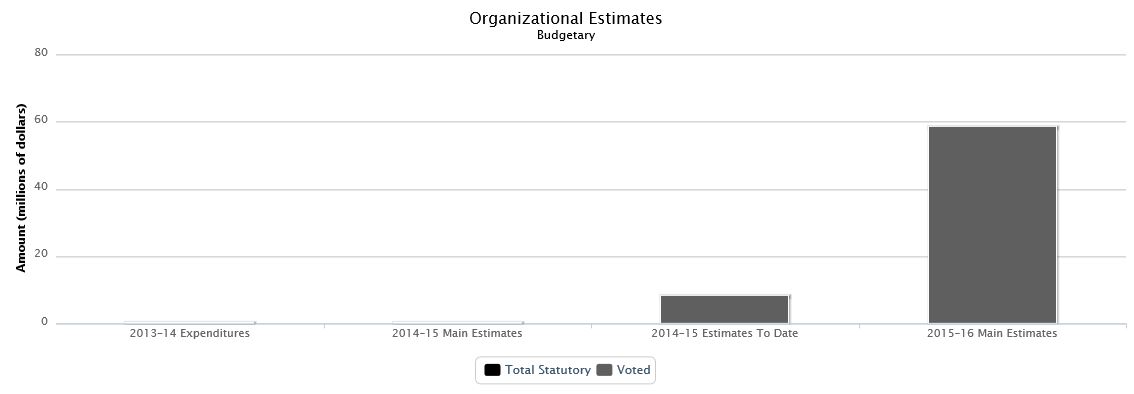
| 2013–14 Expenditures | 2014–15 Main Estimates | 2014–15 Estimates To Date | 2015–16 Main Estimates | ||
|---|---|---|---|---|---|
| Budgetary | |||||
| Voted | |||||
| 1 | Payments to the Windsor-Detroit Bridge Authority | 0 | 0 | 8,064,384 | 58,469,905 |
| Total voted | 0 | 0 | 8,064,384 | 58,469,905 | |
| Total budgetary | 0 | 0 | 8,064,384 | 58,469,905 | |
Highlights
The WDBA is estimating budgetary expenditures of $58.5M for 2015–16, which requires approval by Parliament. The difference between 2014–15 and the 2015–16 Main Estimates is $58.5M because this is the first inclusion in the Main Estimates for the WDBA.
Expenditures by Strategic Outcome and Program
| 2013–14 Expenditures | 2014–15 Main Estimates | 2015–16 Main Estimates | |
|---|---|---|---|
| A safe, secure, and efficient international crossing for commercial and passenger traffic across the Windsor-Detroit Bridge. | |||
| Detroit River International Crossing | 0 | 0 | 58,469,905 |
| Total | 0 | 0 | 58,469,905 |
Items for inclusion in the Proposed Schedules to the Appropriation Bill
| Vote No. | Items | Amount ($) |
|---|---|---|
| ADMINISTRATIVE TRIBUNALS SUPPORT SERVICE OF CANADA | ||
| 1 | Administrative Tribunals Support Service of Canada – Program expenditures and authority to make recoverable expenditures on behalf of the Canada Pension Plan and the Employment Insurance Operating Account | 52,297,037 |
| Total | 52,297,037 | |
| AGRICULTURE AND AGRI-FOOD | ||
| 1 | Agriculture and Agri-Food – Operating expenditures and, pursuant to paragraph 29.1(2)(a) of the Financial Administration Act, authority to expend revenues received from, and to offset expenditures incurred in the fiscal year for, collaborative research agreements and research services, the grazing and breeding activities of the Community Pasture Program, the administration of the AgriStability program, and the provision of internal support services to other organizations; and the payment to each member of the Queen's Privy Council for Canada who is a Minister without Portfolio or a Minister of State who does not preside over a Ministry of State of a salary not to exceed the salary paid to Ministers of State who preside over Ministries of State under the Salaries Act, as adjusted pursuant to the Parliament of Canada Act and pro rata for any period of less than a year | 548,177,880 |
| 5 | Agriculture and Agri-Food – Capital expenditures | 27,872,294 |
| 10 | Agriculture and Agri-Food – The grants listed in the Estimates and contributions | 367,238,619 |
| Total | 943,288,793 | |
| ATLANTIC CANADA OPPORTUNITIES AGENCY | ||
| 1 | Atlantic Canada Opportunities Agency – Operating expenditures and the payment to each member of the Queen's Privy Council for Canada who is a Minister without Portfolio or a Minister of State who does not preside over a Ministry of State of a salary not to exceed the salary paid to Ministers of State who preside over Ministries of State under the Salaries Act, as adjusted pursuant to the Parliament of Canada Act and pro rata for any period of less than a year | 64,399,896 |
| 5 | Atlantic Canada Opportunities Agency – The grants listed in the Estimates and contributions | 225,573,493 |
| Total | 289,973,389 | |
| ATOMIC ENERGY OF CANADA LIMITED | ||
| 1 | Payments to Atomic Energy of Canada Limited for operating and capital expenditures | 102,143,000 |
| Total | 102,143,000 | |
| AUDITOR GENERAL | ||
| 1 | Auditor General – Program expenditures and, pursuant to paragraph 29.1(2)(a) of the Financial Administration Act, authority to expend revenues received to offset related expenditures incurred in the fiscal year arising from audit professional services provided to members of the Canadian Council of Legislative Auditors (CCOLA) and the annual financial and performance audits and of contribution audits for the International Labour Organization (ILO) | 68,269,099 |
| Total | 68,269,099 | |
| CANADA COUNCIL FOR THE ARTS | ||
| 1 | Payments to the Canada Council for the Arts under section 18 of the Canada Council for the Arts Act, to be used for the furtherance of the objects set out in section 8 of that Act | 182,097,387 |
| Total | 182,097,387 | |
| CANADA MORTGAGE AND HOUSING CORPORATION | ||
| 1 | To reimburse Canada Mortgage and Housing Corporation for the amounts of loans forgiven, grants, contributions and expenditures made, and losses, costs and expenses incurred under the provisions of the National Housing Act or in respect of the exercise of powers or the carrying out of duties or functions conferred on the Corporation pursuant to the authority of any Act of Parliament of Canada other than the National Housing Act, in accordance with the Corporation's authority under the Canada Mortgage and Housing Corporation Act | 2,025,629,000 |
| Total | 2,025,629,000 | |
| CANADA POST CORPORATION | ||
| 1 | Payments to the Canada Post Corporation for special purposes | 22,210,000 |
| Total | 22,210,000 | |
| CANADA SCHOOL OF PUBLIC SERVICE | ||
| 1 | Canada School of Public Service – Program expenditures | 53,794,403 |
| Total | 53,794,403 | |
| CANADIAN AIR TRANSPORT SECURITY AUTHORITY | ||
| 1 | Payments to the Canadian Air Transport Security Authority for operating and capital expenditures | 678,420,347 |
| Total | 678,420,347 | |
| CANADIAN BROADCASTING CORPORATION | ||
| 1 | Payments to the Canadian Broadcasting Corporation for operating expenditures | 928,331,798 |
| 5 | Payments to the Canadian Broadcasting Corporation for working capital | 4,000,000 |
| 10 | Payments to the Canadian Broadcasting Corporation for capital expenditures | 105,692,000 |
| Total | 1,038,023,798 | |
| CANADIAN CENTRE FOR OCCUPATIONAL HEALTH AND SAFETY | ||
| 1 | Canadian Centre for Occupational Health and Safety – Program expenditures | 3,969,600 |
| Total | 3,969,600 | |
| CANADIAN COMMERCIAL CORPORATION | ||
| 1 | Payments to the Canadian Commercial Corporation | 8,880,000 |
| Total | 8,880,000 | |
| CANADIAN DAIRY COMMISSION | ||
| 1 | Canadian Dairy Commission – Program expenditures | 3,605,377 |
| Total | 3,605,377 | |
| CANADIAN ENVIRONMENTAL ASSESSMENT AGENCY | ||
| 1 | Canadian Environmental Assessment Agency – Program expenditures, contributions and, pursuant to paragraph 29.1(2)(a) of the Financial Administration Act, authority to expend revenues received during the fiscal year arising from the provision of environmental assessment services including the conduct of panel reviews, comprehensive studies, mediations, training and information publications by the Canadian Environmental Assessment Agency | 15,591,619 |
| Total | 15,591,619 | |
| CANADIAN FOOD INSPECTION AGENCY | ||
| 1 | Canadian Food Inspection Agency – Operating expenditures and contributions | 537,749,431 |
| 5 | Canadian Food Inspection Agency – Capital expenditures | 25,783,194 |
| Total | 563,532,625 | |
| CANADIAN GRAIN COMMISSION | ||
| 1 | Canadian Grain Commission – Program expenditures | 4,883,698 |
| Total | 4,883,698 | |
| CANADIAN HERITAGE | ||
| 1 | Canadian Heritage – Operating expenditures and, pursuant to paragraph 29.1(2)(a) of the Financial Administration Act, authority to expend revenues received during the fiscal year by the Canadian Conservation Institute, the Canadian Heritage Information Network, the Canadian Audio-Visual Certification Office and the Capital Experience Program and from the provision of internal support services to other organizations, and the payment to each member of the Queen's Privy Council for Canada who is a Minister without Portfolio or a Minister of State who does not preside over a Ministry of State of a salary not to exceed the salary paid to Ministers of State who preside over Ministries of State under the Salaries Act, as adjusted pursuant to the Parliament of Canada Act and pro rata for any period of less than a year | 173,741,400 |
| 5 | Canadian Heritage – The grants listed in the Estimates and contributions | 1,056,279,039 |
| Total | 1,230,020,439 | |
| CANADIAN HUMAN RIGHTS COMMISSION | ||
| 1 | Canadian Human Rights Commission – Program expenditures and, pursuant to paragraph 29.1(2)(a) of the Financial Administration Act, authority to expend revenues received in a fiscal year through the provision of internal support services to other organizations to offset associated expenditures incurred in the fiscal year | 19,650,241 |
| Total | 19,650,241 | |
| CANADIAN INSTITUTES OF HEALTH RESEARCH | ||
| 1 | Canadian Institutes of Health Research – Operating expenditures | 47,463,563 |
| 5 | Canadian Institutes of Health Research – The grants listed in the Estimates | 955,287,128 |
| Total | 1,002,750,691 | |
| CANADIAN INTERGOVERNMENTAL CONFERENCE SECRETARIAT | ||
| 1 | Canadian Intergovernmental Conference Secretariat – Program expenditures | 5,549,653 |
| Total | 5,549,653 | |
| CANADIAN MUSEUM FOR HUMAN RIGHTS | ||
| 1 | Payments to the Canadian Museum for Human Rights for operating and capital expenditures | 21,700,000 |
| Total | 21,700,000 | |
| CANADIAN MUSEUM OF HISTORY | ||
| 1 | Payments to the Canadian Museum of History for operating and capital expenditures | 83,369,477 |
| Total | 83,369,477 | |
| CANADIAN MUSEUM OF IMMIGRATION AT PIER 21 | ||
| 1 | Payments to the Canadian Museum of Immigration at Pier 21 for operating and capital expenditures | 7,700,000 |
| Total | 7,700,000 | |
| CANADIAN MUSEUM OF NATURE | ||
| 1 | Payments to the Canadian Museum of Nature for operating and capital expenditures | 26,129,112 |
| Total | 26,129,112 | |
| CANADIAN NORTHERN ECONOMIC DEVELOPMENT AGENCY | ||
| 1 | Canadian Northern Economic Development Agency – Operating expenditures | 14,409,590 |
| 5 | Canadian Northern Economic Development Agency – Contributions | 35,001,622 |
| Total | 49,411,212 | |
| CANADIAN NUCLEAR SAFETY COMMISSION | ||
| 1 | Canadian Nuclear Safety Commission – Program expenditures, the grants listed in the Estimates and contributions | 38,921,080 |
| Total | 38,921,080 | |
| CANADIAN POLAR COMMISSION | ||
| 1 | Canadian Polar Commission – Program expenditures, the grants listed in the Estimates and contributions | 2,434,137 |
| Total | 2,434,137 | |
| CANADIAN RADIO-TELEVISION AND TELECOMMUNICATIONS COMMISSION | ||
| 1 | Canadian Radio-television and Telecommunications Commission – Program expenditures and, pursuant to paragraph 29.1(2)(a) of the Financial Administration Act, authority to expend revenues received during the fiscal year pursuant to the Telecommunications Fees Regulations, 2010, Broadcasting Licence Fee Regulations, 1997, Unsolicited Telecommunications Fees Regulations, and other activities related to the conduct of its operations, up to amounts approved by the Treasury Board | 5,379,872 |
| Total | 5,379,872 | |
| CANADIAN SECURITY INTELLIGENCE SERVICE | ||
| 1 | Canadian Security Intelligence Service – Program expenditures | 488,215,677 |
| Total | 488,215,677 | |
| CANADIAN SPACE AGENCY | ||
| 1 | Canadian Space Agency – Operating expenditures | 169,304,033 |
| 5 | Canadian Space Agency – Capital expenditures | 258,964,761 |
| 10 | Canadian Space Agency – The grants listed in the Estimates and contributions | 45,356,265 |
| Total | 473,625,059 | |
| CANADIAN TOURISM COMMISSION | ||
| 1 | Payments to the Canadian Tourism Commission | 57,975,770 |
| Total | 57,975,770 | |
| CANADIAN TRANSPORTATION ACCIDENT INVESTIGATION AND SAFETY BOARD | ||
| 1 | Canadian Transportation Accident Investigation and Safety Board – Program expenditures | 26,290,301 |
| Total | 26,290,301 | |
| CANADIAN TRANSPORTATION AGENCY | ||
| 1 | Canadian Transportation Agency – Program expenditures | 24,313,366 |
| Total | 24,313,366 | |
| CHIEF ELECTORAL OFFICER | ||
| 1 | Chief Electoral Officer – Program expenditures | 29,204,976 |
| Total | 29,204,976 | |
| CITIZENSHIP AND IMMIGRATION | ||
| 1 | Citizenship and Immigration – Operating expenditures and, pursuant to paragraph 29.1(2)(a) of the Financial Administration Act, authority to expend revenues received in a fiscal year from, and to offset related expenditures incurred in the fiscal year arising from the provision of services related to International Experience Canada, and the payment to each member of the Queen's Privy Council for Canada who is a Minister without Portfolio or a Minister of State who does not preside over a Ministry of State of a salary not to exceed the salary paid to Ministers of State who preside over Ministries of State under the Salaries Act, as adjusted pursuant to the Parliament of Canada Act and pro rata for any period of less than a year | 566,527,428 |
| 5 | Citizenship and Immigration – The grants listed in the Estimates and contributions | 993,529,386 |
| Total | 1,560,056,814 | |
| CIVILIAN REVIEW AND COMPLAINTS COMMISSION FOR THE ROYAL CANADIAN MOUNTED POLICE | ||
| 1 | Civilian Review and Complaints Commission for the Royal Canadian Mounted Police – Program expenditures | 9,032,529 |
| Total | 9,032,529 | |
| COMMISSIONER FOR FEDERAL JUDICIAL AFFAIRS | ||
| 1 | Commissioner for Federal Judicial Affairs – Operating expenditures, remuneration, allowances and expenses for judges, including deputy judges of the Supreme Court of Yukon, the Supreme Court of the Northwest Territories and the Nunavut Court of Justice, not provided for by the Judges Act, and pursuant to paragraph 29.1(2)(a) of the Financial Administration Act, authority to expend revenues received during the year arising from the provision of administrative services and judicial training services | 7,942,728 |
| 5 | Commissioner for Federal Judicial Affairs – Canadian Judicial Council – Operating expenditures | 1,513,611 |
| Total | 9,456,339 | |
| COMMUNICATIONS SECURITY ESTABLISHMENT | ||
| 1 | Communications Security Establishment – Program expenditures and, pursuant to paragraph 29.1(2)(a) of the Financial Administration Act, authority to expend revenues received during the fiscal year arising from the operations of the organization, including the provision of internal support services to other organizations, to offset expenditures incurred in the fiscal year | 503,831,701 |
| Total | 503,831,701 | |
| COPYRIGHT BOARD | ||
| 1 | Copyright Board – Program expenditures | 2,818,917 |
| Total | 2,818,917 | |
| CORRECTIONAL SERVICE OF CANADA | ||
| 1 | Correctional Service of Canada – Operating expenditures, the grants listed in the Estimates, contributions, and (a) authority to pay into the Inmate Welfare Fund revenue derived during the year from projects operated by inmates and financed by that Fund; (b) authority to operate canteens in federal institutions and to deposit revenue from sales into the Inmate Welfare Fund; (c) payments, in accordance with terms and conditions prescribed by the Governor in Council, to or on behalf of discharged inmates who suffer physical disability caused by participation in normal program activity in federal institutions, and to dependants of deceased inmates and ex-inmates whose death resulted from participation in normal program activity in federal institutions; and (d) authority for the Minister of Public Safety and Emergency Preparedness, subject to the approval of the Governor in Council, to enter into an agreement with any province for the confinement in institutions of that province of any persons sentenced or committed to a penitentiary, for compensation for the maintenance of such persons and for payment in respect of the construction and related costs of such institutions; |
1,928,746,713 |
| 5 | Correctional Service of Canada – Capital expenditures, including payments as contributions to (a) aboriginal communities as defined in section 79 of the Corrections and Conditional Release Act in connection with the provision of correctional services pursuant to section 81 of that Act; and (b) non-profit organizations involved in community corrections operations, provinces and municipalities towards construction done by those bodies |
176,944,519 |
| Total | 2,105,691,232 | |
| COURTS ADMINISTRATION SERVICE | ||
| 1 | Courts Administration Service – Program expenditures | 57,320,466 |
| Total | 57,320,466 | |
| ECONOMIC DEVELOPMENT AGENCY OF CANADA FOR THE REGIONS OF QUEBEC | ||
| 1 | Economic Development Agency of Canada for the Regions of Quebec – Operating expenditures and the payment to each member of the Queen's Privy Council for Canada who is a Minister without Portfolio or a Minister of State who does not preside over a Ministry of State of a salary not to exceed the salary paid to Ministers of State who preside over Ministries of State under the Salaries Act, as adjusted pursuant to the Parliament of Canada Act and pro rata for any period of less than a year | 38,266,985 |
| 5 | Economic Development Agency of Canada for the Regions of Quebec – The grants listed in the Estimates and contributions | 217,995,801 |
| Total | 256,262,786 | |
| EMPLOYMENT AND SOCIAL DEVELOPMENT | ||
| 1 | Employment and Social Development – Operating expenditures and (a) authority to make recoverable expenditures on behalf of the Canada Pension Plan and the Employment Insurance Operating Account; (b) pursuant to paragraph 29.1(2)(a) of the Financial Administration Act, authority to expend, to offset related expenditures incurred in the fiscal year, revenues received in the fiscal year arising from (i) the provision of Public Access Programs Sector services, (ii) services to assist provinces in the administration of provincial programs funded under Labour Market Development Agreements, (iii) services offered on behalf of other federal government departments and/or federal government departmental corporations, (iv) the amount charged to any Crown corporation under paragraph 14(b) of the Government Employees Compensation Act in relation to the litigation costs for subrogated claims for Crown corporations, and (v) the portion of the Government Employees Compensation Act departmental or agency subrogated claim settlements related to litigation costs; and (c) the payment to each member of the Queen's Privy Council for Canada who is a Minister without Portfolio or a Minister of State who does not preside over a Ministry of State of a salary not to exceed the salary paid to Ministers of State who preside over Ministries of State under the Salaries Act, as adjusted pursuant to the Parliament of Canada Act and pro rata for any period of less than a year |
561,409,860 |
| 5 | Employment and Social Development – The grants listed in the Estimates and contributions | 1,712,658,484 |
| Total | 2,274,068,344 | |
| ENVIRONMENT | ||
| 1 | Environment – Operating expenditures and, pursuant to paragraph 29.1(2)(a) of the Financial Administration Act, authority to expend revenues received from, and offset related expenditures incurred in the fiscal year for the provision of services or the sale of information products arising from the operations of the department funded from this Vote, including research, analysis and scientific services, hydrometric surveys, regulatory and monitoring services, including oil sands, entry fees and permits, real property services, and authority for the Minister of the Environment to engage consultants as may be required by different Boards at such remuneration as those Boards may determine; and the payment to each member of the Queen's Privy Council for Canada who is a Minister without Portfolio or a Minister of State who does not preside over a Ministry of State of a salary not to exceed the salary paid to Ministers of State who preside over Ministries of State under the Salaries Act, as adjusted pursuant to the Parliament of Canada Act and pro rata for any period of less than a year | 695,731,283 |
| 5 | Environment – Capital expenditures and authority to make payments to provinces or municipalities as contributions towards construction done by those bodies and authority to make recoverable advances not exceeding the amount of the shares of provincial and outside agencies of the cost of joint projects including expenditures on other than federal property | 63,297,504 |
| 10 | Environment – The grants listed in the Estimates and contributions, and contributions to developing countries in accordance with the Multilateral Fund for the Implementation of the Montreal Protocol taking the form of monetary payments or the provision of goods, equipment or services | 114,340,903 |
| Total | 873,369,690 | |
| FEDERAL ECONOMIC DEVELOPMENT AGENCY FOR SOUTHERN ONTARIO | ||
| 1 | Federal Economic Development Agency for Southern Ontario – Operating expenditures | 25,859,077 |
| 5 | Federal Economic Development Agency for Southern Ontario – The grants listed in the Estimates and contributions | 186,239,502 |
| Total | 212,098,579 | |
| FINANCE | ||
| 1 | Finance – Operating expenditures and the payment to each member of the Queen's Privy Council for Canada who is a Minister without Portfolio or a Minister of State who does not preside over a Ministry of State of a salary not to exceed the salary paid to Ministers of State who preside over Ministries of State under the Salaries Act, as adjusted pursuant to the Parliament of Canada Act and pro rata for any period of less than a year and, pursuant to paragraph 29.1(2)(a) of the Financial Administration Act, authority to expend revenues received in a fiscal year to offset expenditures incurred in that fiscal year from the provision of internal services to other organizations | 99,936,668 |
| 5 | Finance – The grants listed in the Estimates and contributions | 3,035,000 |
| 10 | Pursuant to subsection 8(2) of the Bretton Woods and Related Agreements Act, the amount of financial assistance provided by the Minister of Finance by way of direct payments to the International Development Association shall not exceed an amount of $441,610,000 in 2015–16 | 1 |
| Total | 102,971,669 | |
| FINANCIAL TRANSACTIONS AND REPORTS ANALYSIS CENTRE OF CANADA | ||
| 1 | Financial Transactions and Reports Analysis Centre of Canada – Program expenditures and, pursuant to paragraph 29.1(2)(a) of the Financial Administration Act, authority to expend revenues received in a fiscal year through the provision of internal support services to other organizations to offset associated expenditures incurred in the fiscal year for the sharing of information management and information technology processes and systems | 44,954,660 |
| Total | 44,954,660 | |
| FISHERIES AND OCEANS | ||
| 1 | Fisheries and Oceans – Operating expenditures and (a) Canada's share of expenses of the International Fisheries Commissions, authority to provide free accommodation for the International Fisheries Commissions and authority to make recoverable advances in the amounts of the shares of the International Fisheries Commissions of joint cost projects; (b) authority to make recoverable advances for transportation, stevedoring and other shipping services performed on behalf of individuals, outside agencies and other governments in the course of, or arising out of, the exercise of jurisdiction in navigation, including aids to navigation and shipping; (c) pursuant to paragraph 29.1(2)(a) of the Financial Administration Act, authority to expend revenue received during the fiscal year in the course of, or arising from, the activities of the Canadian Coast Guard and for the provision of internal support services to other organizations; and (d) the payment to each member of the Queen's Privy Council for Canada who is a Minister without Portfolio or a Minister of State who does not preside over a Ministry of State of a salary not to exceed the salary paid to Ministers of State who preside over Ministries of State under the Salaries Act, as adjusted pursuant to the Parliament of Canada Act and pro rata for any period of less than a year |
1,181,570,672 |
| 5 | Fisheries and Oceans – Capital expenditures and authority to make payments to provinces, municipalities and local or private authorities as contributions towards construction done by those bodies and authority for the purchase and disposal of commercial fishing vessels | 495,982,360 |
| 10 | Fisheries and Oceans – The grants listed in the Estimates and contributions | 88,932,871 |
| Total | 1,766,485,903 | |
| FOREIGN AFFAIRS, TRADE AND DEVELOPMENT | ||
| 1 | Foreign Affairs, Trade and Development – Operating expenditures, including those related to the appointment of Canada's representatives abroad, to the staff of those officials, and to the assignment of Canadians to the staffs of international organizations and authority to make recoverable advances in amounts not exceeding the amounts of the shares of such organizations; expenditures in respect of the provision of office accommodation for the International Civil Aviation Organization; recoverable expenditures for assistance to and repatriation of distressed Canadian citizens and Canadian residents living abroad, including their dependants; and, pursuant to paragraph 29.1(2)(a) of the Financial Administration Act, authority to expend revenues received in a fiscal year from, and to offset related expenditures incurred in the fiscal year arising from the provision of services related to: training services provided by the Canadian Foreign Service Institute; trade and education fairs, trade missions and other international business development services; investment development services; international telecommunication services; departmental publications; other services provided abroad to other government departments, agencies, Crown corporations and other non-federal organizations; specialized consular services; and the payment to each member of the Queen's Privy Council for Canada who is a Minister without Portfolio or a Minister of State who does not preside over a Ministry of State of a salary not to exceed the salary paid to Ministers of State who preside over Ministries of State under the Salaries Act, as adjusted pursuant to the Parliament of Canada Act and pro rata for any period of less than a year | 1,451,334,915 |
| 5 | Foreign Affairs, Trade and Development – Capital expenditures | 103,546,437 |
| 10 | Foreign Affairs, Trade and Development – The grants listed in the Estimates and contributions including payments for other specified purposes and including the provision of goods and services for: international security assistance, international development assistance, international humanitarian assistance, global peace assistance and promotion of trade and investment | 3,573,409,668 |
| 15 | Payments, in respect of pension, insurance and social security programs or other arrangements for employees locally engaged outside of Canada, or in respect of the administration of such programs or arrangements, including premiums, contributions, benefit payments, fees and other expenditures made in respect of employees locally engaged outside Canada and for such other persons, as Treasury Board determines | 50,779,000 |
| 20 | Pursuant to subsection 12(2) of the International Development (Financial Institutions) Assistance Act, the amount of financial assistance provided by the Minister of Foreign Affairs, in consultation with the Minister of Finance, by way of direct payments for the purpose of contributions to the international financial institutions may not exceed $245,000,000 in the period commencing on and ending on | 1 |
| L25 | Pursuant to subsection 12(2) of the International Development (Financial Institutions) Assistance Act, the amount of financial assistance provided by the Minister of Foreign Affairs, in consultation with the Minister of Finance, for the purchase of shares of international financial institutions, may not exceed an amount of $41,676,625 in United States dollars over a period commencing on and ending on , which amount is estimated in Canadian dollars at $45,146,540 | 1 |
| Total | 5,179,070,022 | |
| GOVERNOR GENERAL | ||
| 1 | Governor General – Program expenditures, the grants listed in the Estimates and expenditures incurred on behalf of former Governors General, including those incurred on behalf of their spouses, during their lifetimes and for a period of six months following their death, in respect of the performance of activities which devolve on them as a result of their having occupied the office of Governor General | 17,165,126 |
| Total | 17,165,126 | |
| HEALTH | ||
| 1 | Health – Operating expenditures and, pursuant to paragraph 29.1(2)(a) of the Financial Administration Act, authority to spend revenues to offset expenditures incurred in the fiscal year arising from the provision of services or the sale of products related to health protection, regulatory activities and medical services, and the provision of internal support services to other organizations, and the payment to each member of the Queen's Privy Council for Canada who is a Minister without Portfolio or a Minister of State who does not preside over a Ministry of State of a salary not to exceed the salary paid to Ministers of State who preside over Ministries of State under the Salaries Act, as adjusted pursuant to the Parliament of Canada Act and pro rata for any period of less than a year | 1,777,987,439 |
| 5 | Health – Capital expenditures | 28,035,364 |
| 10 | Health – The grants listed in the Estimates and contributions, in the form of monetary payments or the provision of goods or services | 1,678,425,178 |
| Total | 3,484,447,981 | |
| HOUSE OF COMMONS | ||
| 1 | House of Commons – Program expenditures, including payments in respect of the cost of operating Members' constituency offices, contributions and authority to expend revenues received during the fiscal year arising from the activities of the House of Commons | 290,860,044 |
| Total | 290,860,044 | |
| IMMIGRATION AND REFUGEE BOARD | ||
| 1 | Immigration and Refugee Board – Program expenditures | 99,542,732 |
| Total | 99,542,732 | |
| INDIAN AFFAIRS AND NORTHERN DEVELOPMENT | ||
| 1 | Indian Affairs and Northern Development – Operating expenditures and (a) pursuant to paragraph 29.1(2)(a) of the Financial Administration Act, authority to expend revenues received in a fiscal year through the provision of internal support services to other organizations to offset associated expenditures incurred in the fiscal year; (b) expenditures on works, buildings and equipment and expenditures and recoverable expenditures in respect of services provided and work performed on other than federal property; (c) authority to provide, in respect of Indian and Inuit economic development activities, for the capacity development for Indian and Inuit and the furnishing of materials and equipment; (d) authority to sell electric power to private consumers in remote locations when alternative local sources of supply are not available, in accordance with terms and conditions approved by the Governor in Council; and (e) the payment to each member of the Queen's Privy Council for Canada who is a Minister without Portfolio or a Minister of State who does not preside over a Ministry of State of a salary not to exceed the salary paid to Ministers of State who preside over Ministries of State under the Salaries Act, as adjusted pursuant to the Parliament of Canada Act and pro rata for any period of less than a year |
1,069,154,628 |
| 5 | Indian Affairs and Northern Development – Capital expenditures and (a) expenditures on buildings, works, land and equipment, the operation, control and ownership of which may be transferred to provincial governments on terms and conditions approved by the Governor in Council, or to Indian bands, groups of Indians or individual Indians at the discretion of the Minister of Aboriginal Affairs and Northern Development, and such expenditures on other than federal property; and (b) authority to make recoverable expenditures in amounts not exceeding the shares of provincial governments of expenditures on roads and related works |
35,946,145 |
| 10 | Indian Affairs and Northern Development – The grants listed in the Estimates and contributions | 6,936,151,589 |
| L15 | Loans to native claimants in accordance with terms and conditions approved by the Governor in Council for the purpose of defraying costs related to research, development and negotiation of claims | 39,903,000 |
| L20 | Loans to First Nations in British Columbia for the purpose of supporting their participation in the British Columbia Treaty Commission process | 30,400,000 |
| Total | 8,111,555,362 | |
| INDIAN RESIDENTIAL SCHOOLS TRUTH AND RECONCILIATION COMMISSION | ||
| 1 | Indian Residential Schools Truth and Reconciliation Commission – Program expenditures | 3,600,757 |
| Total | 3,600,757 | |
| INDUSTRY | ||
| 1 | Industry – Operating expenditures and, pursuant to paragraph 29.1(2)(a) of the Financial Administration Act, authority to expend revenue received during the fiscal year, to offset expenditures incurred in the fiscal year, arising from the provision of internal support services to other organizations, communications research, bankruptcy and corporations and from services and regulatory processes, specifically pre-merger notification filings, advance ruling certificates, advisory opinions and photocopies, provided under the Competition Act, and the payment to each member of the Queen's Privy Council for Canada who is a Minister without Portfolio or a Minister of State who does not preside over a Ministry of State of a salary not to exceed the salary paid to Ministers of State who preside over Ministries of State under the Salaries Act, as adjusted pursuant to the Parliament of Canada Act and pro rata for any period of less than a year | 303,247,705 |
| 5 | Industry – Capital expenditures | 16,528,241 |
| 10 | Industry – The grants listed in the Estimates and contributions | 645,876,909 |
| L15 | Payments pursuant to subsection 14(2) of the Department of Industry Act | 300,000 |
| L20 | Loans pursuant to paragraph 14(1)(a) of the Department of Industry Act | 500,000 |
| Total | 966,452,855 | |
| INTERNATIONAL DEVELOPMENT RESEARCH CENTRE | ||
| 1 | Payments to the International Development Research Centre | 183,478,242 |
| Total | 183,478,242 | |
| INTERNATIONAL JOINT COMMISSION (CANADIAN SECTION) | ||
| 1 | International Joint Commission (Canadian Section) – Program expenditures – Salaries and expenses of the Canadian Section, expenses of studies, surveys and investigations by the Commission under International References and expenses of the Commission under the Canada/United States Great Lakes Water Quality Agreement | 6,172,075 |
| Total | 6,172,075 | |
| JUSTICE | ||
| 1 | Justice – Operating expenditures and, pursuant to paragraph 29.1(2)(a) of the Financial Administration Act, authority to expend revenues received in a fiscal year, and to offset expenditures incurred in the fiscal year, arising from the provision of mandatory legal services to Government departments and agencies and optional services to Crown corporations, non-federal organizations and international organizations provided they are consistent with the Department's mandate, and the provision of internal support services to other organizations, and the payment to each member of the Queen's Privy Council for Canada who is a Minister without Portfolio or a Minister of State who does not preside over a Ministry of State of a salary not to exceed the salary paid to Ministers of State who preside over Ministries of State under the Salaries Act, as adjusted pursuant to the Parliament of Canada Act and pro rata for any period of less than a year | 241,797,227 |
| 5 | Justice – The grants listed in the Estimates and contributions | 354,900,159 |
| Total | 596,697,386 | |
| LIBRARY AND ARCHIVES OF CANADA | ||
| 1 | Library and Archives of Canada – Program expenditures, the grants listed in the Estimates and, pursuant to paragraph 29.1(2)(a) of the Financial Administration Act, authority to expend revenues received to offset related expenditures incurred in the fiscal year arising from access to and reproduction of materials from the collection | 83,183,100 |
| Total | 83,183,100 | |
| LIBRARY OF PARLIAMENT | ||
| 1 | Library of Parliament – Program expenditures, including authority to expend revenues received during the fiscal year arising from the activities of the Library of Parliament | 37,754,035 |
| Total | 37,754,035 | |
| MARINE ATLANTIC INC. | ||
| 1 | Payments to Marine Atlantic Inc. in respect of the costs of the management of the Company, payments for capital purposes and for transportation activities including the following water transportation services pursuant to contracts with Her Majesty: Newfoundland ferries and terminals | 19,384,000 |
| Total | 19,384,000 | |
| MILITARY GRIEVANCES EXTERNAL REVIEW COMMITTEE | ||
| 1 | Military Grievances External Review Committee – Program expenditures | 6,143,503 |
| Total | 6,143,503 | |
| MILITARY POLICE COMPLAINTS COMMISSION | ||
| 1 | Military Police Complaints Commission – Program expenditures | 5,158,208 |
| Total | 5,158,208 | |
| NATIONAL ARTS CENTRE CORPORATION | ||
| 1 | Payments to the National Arts Centre Corporation for operating expenditures | 34,222,719 |
| Total | 34,222,719 | |
| NATIONAL BATTLEFIELDS COMMISSION | ||
| 1 | National Battlefields Commission – Program expenditures | 10,759,494 |
| Total | 10,759,494 | |
| NATIONAL CAPITAL COMMISSION | ||
| 1 | Payments to the National Capital Commission for operating expenditures | 69,056,330 |
| 5 | Payments to the National Capital Commission for capital expenditures | 23,665,000 |
| Total | 92,721,330 | |
| NATIONAL DEFENCE | ||
| 1 | National Defence – Operating expenditures and authority for total commitments, subject to allotment by the Treasury Board, of $27,379,962,074 for the purposes of Votes 1, 5 and 10 of the Department regardless of the year in which the payment of those commitments comes due (of which it is estimated that $9,345,616,973 will come due for payment in future years), authority, subject to the direction of the Treasury Board, to make recoverable expenditures or advances in respect of materials supplied to or services performed on behalf of individuals, corporations, outside agencies, other government departments and agencies and other governments and, pursuant to paragraph 29.1(2)(a) of the Financial Administration Act, authority to expend revenue received during the fiscal year, to offset related expenditures for the purposes of this Vote including the provision of internal support services to other organizations, and authority to make payments, in respect of pension, insurance and social security programs or other arrangements for employees locally engaged outside of Canada, or in respect of the administration of such programs or arrangements, including premiums, contributions, benefits, fees and other expenditures, made in respect of employees locally engaged outside of Canada and for such other persons, as Treasury Board determines, and the payment to each member of the Queen's Privy Council for Canada who is a Minister without Portfolio or a Minister of State who does not preside over a Ministry of State of a salary not to exceed the salary paid to Ministers of State who preside over Ministries of State under the Salaries Act, as adjusted pursuant to the Parliament of Canada Act and pro rata for any period of less than a year | 13,483,693,376 |
| 5 | National Defence – Capital expenditures | 4,020,883,722 |
| 10 | National Defence – The grants listed in the Estimates and contributions, which grants and contributions may include monetary payments or, in lieu of payment made to a recipient, the provision of goods or services or of the use of facilities, and which may also include the contributions that may be approved by the Governor in Council in accordance with section 3 of The Defence Appropriation Act, 1950, for provision or transfer of defence equipment or services or supplies or facilities for defence purposes | 168,742,820 |
| Total | 17,673,319,918 | |
| NATIONAL ENERGY BOARD | ||
| 1 | National Energy Board – Program expenditures and contributions | 68,636,080 |
| Total | 68,636,080 | |
| NATIONAL FILM BOARD | ||
| 1 | National Film Board – Program expenditures | 59,652,377 |
| Total | 59,652,377 | |
| NATIONAL GALLERY OF CANADA | ||
| 1 | Payments to the National Gallery of Canada for operating and capital expenditures | 35,773,542 |
| 5 | Payment to the National Gallery of Canada for the acquisition of objects for the Collection and other costs attributable to this activity | 8,000,000 |
| Total | 43,773,542 | |
| NATIONAL MUSEUM OF SCIENCE AND TECHNOLOGY | ||
| 1 | Payments to the National Museum of Science and Technology for operating and capital expenditures | 29,754,746 |
| Total | 29,754,746 | |
| NATIONAL RESEARCH COUNCIL OF CANADA | ||
| 1 | National Research Council of Canada – Operating expenditures | 350,027,685 |
| 5 | National Research Council of Canada – Capital expenditures | 30,703,000 |
| 10 | National Research Council of Canada – The grants listed in the Estimates and contributions | 255,318,385 |
| Total | 636,049,070 | |
| NATURAL RESOURCES | ||
| 1 | Natural Resources – Operating expenditures and, pursuant to paragraph 29.1(2)(a) of the Financial Administration Act, authority to expend revenues received during the fiscal year from the sale of forestry and information products; licensing, training and certification activities related to the Explosives Act and Explosives Regulations, 2013; from research, consultation, testing, analysis, and administration services as part of the departmental operations; and for the provision of internal support services to other organizations and the payment to each member of the Queen's Privy Council for Canada who is a Minister without Portfolio or a Minister of State who does not preside over a Ministry of State of a salary not to exceed the salary paid to Ministers of State who preside over Ministries of State under the Salaries Act, as adjusted pursuant to the Parliament of Canada Act and pro rata for any period of less than a year | 654,814,321 |
| 5 | Natural Resources – Capital expenditures | 14,700,394 |
| 10 | Natural Resources – The grants listed in the Estimates and contributions | 306,608,750 |
| Total | 976,123,465 | |
| NATURAL SCIENCES AND ENGINEERING RESEARCH COUNCIL | ||
| 1 | Natural Sciences and Engineering Research Council – Operating expenditures | 43,581,132 |
| 5 | Natural Sciences and Engineering Research Council – The grants listed in the Estimates | 1,037,790,619 |
| Total | 1,081,371,751 | |
| NORTHERN PIPELINE AGENCY | ||
| 1 | Northern Pipeline Agency – Program expenditures and contributions | 701,215 |
| Total | 701,215 | |
| OFFICE OF INFRASTRUCTURE OF CANADA | ||
| 1 | Office of Infrastructure of Canada – Operating expenditures | 59,796,691 |
| 5 | Office of Infrastructure of Canada – Capital expenditures | 24,652,150 |
| 10 | Office of Infrastructure of Canada – Contributions | 1,569,894,628 |
| Total | 1,654,343,469 | |
| OFFICE OF THE COMMISSIONER OF LOBBYING | ||
| 1 | Office of the Commissioner of Lobbying – Program expenditures | 4,026,414 |
| Total | 4,026,414 | |
| OFFICE OF THE COMMISSIONER OF OFFICIAL LANGUAGES | ||
| 1 | Office of the Commissioner of Official Languages – Program expenditures | 18,556,100 |
| Total | 18,556,100 | |
| OFFICE OF THE COMMUNICATIONS SECURITY ESTABLISHMENT COMMISSIONER | ||
| 1 | Office of the Communications Security Establishment Commissioner – Program expenditures | 1,850,071 |
| Total | 1,850,071 | |
| OFFICE OF THE CONFLICT OF INTEREST AND ETHICS COMMISSIONER | ||
| 1 | Office of the Conflict of Interest and Ethics Commissioner – Program expenditures | 6,178,280 |
| Total | 6,178,280 | |
| OFFICE OF THE CO-ORDINATOR, STATUS OF WOMEN | ||
| 1 | Office of the Co-ordinator, Status of Women – Operating expenditures and the payment to each member of the Queen's Privy Council for Canada who is a Minister without Portfolio or a Minister of State who does not preside over a Ministry of State of a salary not to exceed the salary paid to Ministers of State who preside over Ministries of State under the Salaries Act, as adjusted pursuant to the Parliament of Canada Act and pro rata for any period of less than a year | 9,364,355 |
| 5 | Office of the Co-ordinator, Status of Women – The grants listed in the Estimates and contributions | 18,950,000 |
| Total | 28,314,355 | |
| OFFICE OF THE CORRECTIONAL INVESTIGATOR | ||
| 1 | Office of the Correctional Investigator – Program expenditures | 4,106,381 |
| Total | 4,106,381 | |
| OFFICE OF THE DIRECTOR OF PUBLIC PROSECUTIONS | ||
| 1 | Office of the Director of Public Prosecutions – Program expenditures and, pursuant to paragraph 29.1(2)(a) of the Financial Administration Act, authority to expend revenues received in a fiscal year, and to offset expenditures incurred in the fiscal year, arising from the provision of prosecution and prosecution-related services and the provision of internal support services to other organizations and optional services to Crown corporations, non-federal organizations and international organizations provided they are consistent with the Office of the Director of Public Prosecution's mandate | 149,298,354 |
| Total | 149,298,354 | |
| OFFICE OF THE PUBLIC SECTOR INTEGRITY COMMISSIONER | ||
| 1 | Office of the Public Sector Integrity Commissioner – Program expenditures and contributions | 4,934,882 |
| Total | 4,934,882 | |
| OFFICE OF THE SUPERINTENDENT OF FINANCIAL INSTITUTIONS | ||
| 1 | Office of the Superintendent of Financial Institutions – Program expenditures | 945,058 |
| Total | 945,058 | |
| OFFICES OF THE INFORMATION AND PRIVACY COMMISSIONERS OF CANADA | ||
| 1 | Offices of the Information and Privacy Commissioners of Canada – Office of the Information Commissioner of Canada – Program expenditures | 9,927,361 |
| 5 | Offices of the Information and Privacy Commissioners of Canada – Office of the Privacy Commissioner of Canada – Program expenditures and contributions | 21,908,457 |
| Total | 31,835,818 | |
| PAROLE BOARD OF CANADA | ||
| 1 | Parole Board of Canada – Program expenditures and, pursuant to paragraph 29.1(2)(a) of the Financial Administration Act, authority to expend revenues received in a fiscal year, and to offset expenditures incurred in the fiscal year arising from the provision of services to process record suspension applications for persons convicted of offences under federal acts and regulations | 40,021,838 |
| Total | 40,021,838 | |
| PATENTED MEDICINE PRICES REVIEW BOARD | ||
| 1 | Patented Medicine Prices Review Board – Program expenditures | 9,947,595 |
| Total | 9,947,595 | |
| PPP CANADA INC. | ||
| 1 | Payments to PPP Canada Inc. for operations and program delivery | 11,800,000 |
| 5 | Payments to PPP Canada Inc. for P3 Canada Fund investments | 219,400,000 |
| Total | 231,200,000 | |
| PRIVY COUNCIL | ||
| 1 | Privy Council – Program expenditures, including operating expenditures of Commissions of inquiry not otherwise provided for and the operation of the Prime Minister's residence; and the payment to each member of the Queen's Privy Council for Canada who is a Minister without Portfolio or a Minister of State who does not preside over a Ministry of State of a salary not to exceed the salary paid to Ministers of State who preside over Ministries of State under the Salaries Act, as adjusted pursuant to the Parliament of Canada Act and pro rata for any period of less than a year and, pursuant to paragraph 29.1(2)(a) of the Financial Administration Act, authority to expend revenues received in a fiscal year through the provision of internal support services to other departments to offset expenditures incurred in the fiscal year | 104,454,216 |
| Total | 104,454,216 | |
| PUBLIC HEALTH AGENCY OF CANADA | ||
| 1 | Public Health Agency of Canada – Operating expenditures and, pursuant to paragraph 29.1(2)(a) of the Financial Administration Act, authority to expend revenues to offset expenditures incurred in the fiscal year arising from inspection services and the provision of internal support services to other organizations | 317,729,513 |
| 5 | Public Health Agency of Canada – Capital expenditures | 5,705,314 |
| 10 | Public Health Agency of Canada – The grants listed in the Estimates and contributions | 199,999,484 |
| Total | 523,434,311 | |
| PUBLIC SAFETY AND EMERGENCY PREPAREDNESS | ||
| 1 | Public Safety and Emergency Preparedness – Operating expenditures and, pursuant to paragraph29.1(2)(a) of the Financial Administration Act, authority to expend revenues received in a fiscal year through the provision of internal support services to other organizations to offset associated expenditures incurred in the fiscal year, and the payment to each member of the Queen's Privy Council for Canada who is a Minister without Portfolio or a Minister of State who does not preside over a Ministry of State of a salary not to exceed the salary paid to Ministers of State who preside over Ministries of State under the Salaries Act, as adjusted pursuant to the Parliament of Canada Act and pro rata for any period of less than a year | 113,188,545 |
| 5 | Public Safety and Emergency Preparedness – The grants listed in the Estimates and contributions | 1,022,476,287 |
| Total | 1,135,664,832 | |
| PUBLIC SERVICE COMMISSION | ||
| 1 | Public Service Commission – Program expenditures and, pursuant to paragraph 29.1(2)(a) of the Financial Administration Act, authority to expend revenues received in a fiscal year to offset expenditures incurred in that fiscal year arising from the provision of staffing, assessment and counselling services and products and the provision of internal support services to other organizations | 71,397,504 |
| Total | 71,397,504 | |
| PUBLIC WORKS AND GOVERNMENT SERVICES | ||
| 1 | Public Works and Government Services – Operating expenditures for the provision of accommodation, common and central services including recoverable expenditures on behalf of the Canada Pension Plan, the Employment Insurance Act and the Seized Property Management Act; authority to expend revenues received during the fiscal year arising from accommodation and central and common services in respect of these services and, pursuant to paragraph 29.1(2)(a) of the Financial Administration Act, internal support services to other organizations; and the payment to each member of the Queen's Privy Council for Canada who is a Minister without Portfolio or a Minister of State who does not preside over a Ministry of State of a salary not to exceed the salary paid to Ministers of State who preside over Ministries of State under the Salaries Act, as adjusted pursuant to the Parliament of Canada Act and pro rata for any period of less than a year |
1,651,054,220 |
| 5 | Public Works and Government Services – Capital expenditures including expenditures on works other than federal property and authority to reimburse tenants of federal property for improvements authorized by the Minister of Public Works and Government Services | 1,099,063,968 |
| Total | 2,750,118,188 | |
| ROYAL CANADIAN MOUNTED POLICE | ||
| 1 | Royal Canadian Mounted Police – Operating expenditures and, pursuant to paragraph29.1(2)(a) of the Financial Administration Act, authority to expend revenues received during a fiscal year to offset associated expenditures, including revenues from the provision of internal support services to other organizations | 1,726,192,674 |
| 5 | Royal Canadian Mounted Police – Capital expenditures | 261,996,018 |
| 10 | Royal Canadian Mounted Police – The grants listed in the Estimates and contributions, provided that the amount listed for any grant may be increased or decreased subject to the approval of the Treasury Board | 180,351,933 |
| Total | 2,168,540,625 | |
| ROYAL CANADIAN MOUNTED POLICE EXTERNAL REVIEW COMMITTEE | ||
| 1 | Royal Canadian Mounted Police External Review Committee – Program expenditures | 848,114 |
| Total | 848,114 | |
| SECURITY INTELLIGENCE REVIEW COMMITTEE | ||
| 1 | Security Intelligence Review Committee – Program expenditures | 2,479,321 |
| Total | 2,479,321 | |
| SENATE ETHICS OFFICER | ||
| 1 | Senate Ethics Officer – Program expenditures | 1,059,500 |
| Total | 1,059,500 | |
| SHARED SERVICES CANADA | ||
| 1 | Shared Services Canada – Operating expenditures and, pursuant to paragraph 29.1(2)(a) of the Financial Administration Act, authority to expend revenues received in the fiscal year to offset expenditures incurred in that fiscal year arising from the provision of information technology services | 1,169,183,901 |
| 5 | Shared Services Canada – Capital expenditures | 203,868,605 |
| Total | 1,373,052,506 | |
| SOCIAL SCIENCES AND HUMANITIES RESEARCH COUNCIL | ||
| 1 | Social Sciences and Humanities Research Council – Operating expenditures | 23,257,304 |
| 5 | Social Sciences and Humanities Research Council – The grants listed in the Estimates | 690,998,526 |
| Total | 714,255,830 | |
| STANDARDS COUNCIL OF CANADA | ||
| 1 | Payments to the Standards Council of Canada pursuant to section 5 of the Standards Council of Canada Act | 9,829,000 |
| Total | 9,829,000 | |
| STATISTICS CANADA | ||
| 1 | Statistics Canada – Program expenditures and, pursuant to paragraph 29.1(2)(a) of the Financial Administration Act, authority to expend revenues received during a fiscal year to offset associated expenditures, including revenues from the provision of internal support services to other organizations | 456,012,343 |
| Total | 456,012,343 | |
| SUPREME COURT OF CANADA | ||
| 1 | Supreme Court of Canada – Program expenditures | 22,304,846 |
| Total | 22,304,846 | |
| TELEFILM CANADA | ||
| 1 | Payments to Telefilm Canada to be used for the purposes set out in the Telefilm Canada Act | 95,453,551 |
| Total | 95,453,551 | |
| THE FEDERAL BRIDGE CORPORATION LIMITED | ||
| 1 | Payments to The Federal Bridge Corporation Limited | 35,281,996 |
| Total | 35,281,996 | |
| THE JACQUES-CARTIER AND CHAMPLAIN BRIDGES INC. | ||
| 1 | Payments to The Jacques-Cartier and Champlain Bridges Inc. to be applied in payment of the excess of the expenditures over the revenues of the Corporation (exclusive of depreciation on capital structures and reserves) in the operation of the Jacques-Cartier, Champlain and Honoré Mercier Bridges, a portion of the Bonaventure Autoroute, the Pont-Champlain Jetty, and Melocheville Tunnel, Montreal | 368,737,000 |
| Total | 368,737,000 | |
| THE SENATE | ||
| 1 | The Senate – Program expenditures, including an allowance in lieu of residence to the Speaker of the Senate, payments in respect of the cost of operating Senators' offices, contributions and authority to expend in the fiscal year revenues received during that fiscal year arising from the activities of the Senate | 57,031,359 |
| Total | 57,031,359 | |
| TRANSPORT | ||
| 1 | Transport – Operating expenditures and (a) authority to make expenditures on other than federal property in the course of or arising out of the exercise of jurisdiction in aeronautics; (b) authority for the payment of commissions for revenue collection pursuant to the Aeronautics Act; (c) pursuant to paragraph 29.1(2)(a) of the Financial Administration Act, authority to expend revenue received during the fiscal year including the provision of internal support services to other organizations; and (d) the payment to each member of the Queen's Privy Council for Canada who is a Minister without Portfolio or a Minister of State who does not preside over a Ministry of State of a salary not to exceed the salary paid to Ministers of State who preside over Ministries of State under the Salaries Act, as adjusted pursuant to the Parliament of Canada Act and pro rata for any period of less than a year |
551,124,773 |
| 5 | Transport – Capital expenditures | 106,911,344 |
| 10 | Transport – The grants listed in the Estimates and contributions | 683,312,718 |
| Total | 1,341,348,835 | |
| TREASURY BOARD SECRETARIAT | ||
| 1 | Treasury Board Secretariat – Program expenditures and the payment to each member of the Queen's Privy Council for Canada who is a Minister without Portfolio or a Minister of State who does not preside over a Ministry of State of a salary not to exceed the salary paid to Ministers of State who preside over Ministries of State under the Salaries Act, as adjusted pursuant to the Parliament of Canada Act and pro rata for any period of less than a year and, pursuant to paragraph 29.1(2)(a) of the Financial Administration Act, authority to expend revenues received in a fiscal year, and to offset expenditures incurred in the fiscal year, arising from the provision of internal support services to other organizations and from activities of the Treasury Board Secretariat | 219,601,334 |
| 5 | Government Contingencies – Subject to the approval of the Treasury Board, to supplement other appropriations and to provide for miscellaneous, urgent or unforeseen expenditures not otherwise provided for, including grants and contributions not listed in the Estimates and the increase of the amount of grants listed in these, where those expenditures are within the legal mandate of a government organization, and authority to reuse any sums allotted and repaid to this appropriation from other appropriations | 750,000,000 |
| 10 | Government-Wide Initiatives – Subject to the approval of the Treasury Board, to supplement other appropriations in support of the implementation of strategic management initiatives in the public service of Canada | 2,090,470 |
| 20 | Public Service Insurance – Payments, in respect of insurance, pension or benefit programs or other arrangements, or in respect of the administration of such programs, or arrangements, including premiums, contributions, benefits, fees and other expenditures, made in respect of the public service or any part thereof and for such other persons, as Treasury Board determines, and authority to expend any revenues or other amounts received in respect of such programs or arrangements to offset any such expenditures in respect of such programs or arrangements and to provide for the return to certain employees of their share of the premium reduction under subsection 96(3) of the Employment Insurance Act | 2,250,070,604 |
| 25 | Operating Budget Carry Forward – Subject to the approval of the Treasury Board, to supplement other appropriations for the operating budget carry forward from the previous fiscal year | 1,600,000,000 |
| 30 | Paylist Requirements – Subject to the approval of the Treasury Board, to supplement other appropriations for requirements related to parental and maternity allowances, entitlements on cessation of service or employment and adjustments made to terms and conditions of service or employment of the federal public administration including members of the Royal Canadian Mounted Police and the Canadian Forces, where these have not been provided from Vote 15, Compensation Adjustments |
1,000,000,000 |
| 33 | Capital Budget Carry Forward – Subject to the approval of the Treasury Board, to supplement other appropriations for purposes of the capital budget carry forward allowance from the previous fiscal year | 600,000,000 |
| Total | 6,421,762,408 | |
| VETERANS AFFAIRS | ||
| 1 | Veterans Affairs – Operating expenditures, upkeep of property, including engineering and other investigatory planning expenses that do not add tangible value to real property, taxes, insurance and maintenance of public utilities; to authorize, subject to the approval of the Governor in Council, necessary remedial work on properties constructed under individual firm price contracts and sold under the Veterans' Land Act (R.S.C.,1970, c.V-4), to correct defects for which neither the Veteran nor the contractor can be held financially responsible, and such other work on other properties as may be required to protect the interest of the Director therein and the payment to each member of the Queen's Privy Council for Canada who is a Minister without Portfolio or a Minister of State who does not preside over a Ministry of State of a salary not to exceed the salary paid to Ministers of State who preside over Ministries of State under the Salaries Act, as adjusted pursuant to the Parliament of Canada Act and pro rata for any period of less than a year | 855,502,774 |
| 5 | Veterans Affairs – The grants listed in the Estimates and contributions, provided that the amount listed for any grant may be increased or decreased subject to the approval of the Treasury Board | 2,639,248,000 |
| Total | 3,494,750,774 | |
| VETERANS REVIEW AND APPEAL BOARD | ||
| 1 | Veterans Review and Appeal Board – Program expenditures | 9,460,756 |
| Total | 9,460,756 | |
| VIA RAIL CANADA INC. | ||
| 1 | Payments to VIA Rail Canada Inc. in respect of the costs of the management of the Company, payments for capital purposes and payments for the provision of rail passenger services in Canada in accordance with contracts entered into pursuant to subparagraph (c)(i) of Transport Vote 52d, Appropriation Act No. 1, 1977 | 330,077,000 |
| Total | 330,077,000 | |
| WESTERN ECONOMIC DIVERSIFICATION | ||
| 1 | Western Economic Diversification – Operating expenditures and the payment to each member of the Queen's Privy Council for Canada who is a Minister without Portfolio or a Minister of State who does not preside over a Ministry of State of a salary not to exceed the salary paid to Ministers of State who preside over Ministries of State under the Salaries Act, as adjusted pursuant to the Parliament of Canada Act and pro rata for any period of less than a year | 36,995,191 |
| 5 | Western Economic Diversification – The grants listed in the Estimates and contributions | 118,733,000 |
| Total | 155,728,191 | |
| WINDSOR-DETROIT BRIDGE AUTHORITY | ||
| 1 | Payments to the Windsor-Detroit Bridge Authority for the discharge of its mandate consistent with its Letters Patent and the Canada-Michigan Crossing Agreement | 58,469,905 |
| Total | 58,469,905 | |
| Total | 83,112,532,525 | |
| Vote No. | Items | Amount ($) |
|---|---|---|
| CANADA BORDER SERVICES AGENCY | ||
| 1 | Canada Border Services Agency – Operating expenditures and, pursuant to paragraph29.1(2)(a) of the Financial Administration Act, authority to expend in the current fiscal year revenues received during the fiscal year related to the border operations of the Canada Border Services Agency: fees for the provision of a service or the use of a facility or for a product, right or privilege; and payments received under contracts entered into by the Agency | 1,411,403,312 |
| 5 | Canada Border Services Agency – Capital expenditures | 180,203,476 |
| Total | 1,591,606,788 | |
| CANADA REVENUE AGENCY | ||
| 1 | Canada Revenue Agency – Operating expenditures, contributions and recoverable expenditures on behalf of the Canada Pension Plan and the Employment Insurance Act | 2,898,927,871 |
| 5 | Canada Revenue Agency – Capital expenditures and recoverable expenditures on behalf of the Canada Pension Plan and the Employment Insurance Act | 80,496,902 |
| Total | 2,979,424,773 | |
| PARKS CANADA AGENCY | ||
| 1 | Parks Canada Agency – Program expenditures, including capital expenditures, the grants listed in the Estimates and contributions, including expenditures on other than federal property, and payments to provinces and municipalities as contributions towards the cost of undertakings carried out by those bodies | 571,135,767 |
| 5 | Payments to the New Parks and Historic Sites Account for the purposes of establishing new national parks, national historic sites and related heritage areas, as set out in section 21 of the Parks Canada Agency Act | 500,000 |
| Total | 571,635,767 | |
| Total | 5,142,667,328 | |